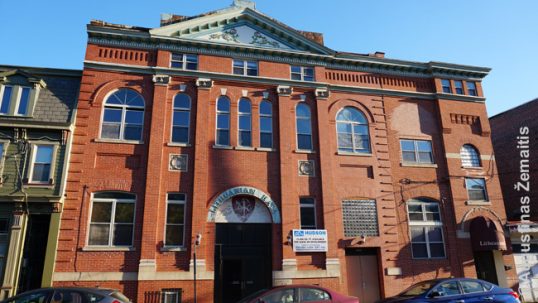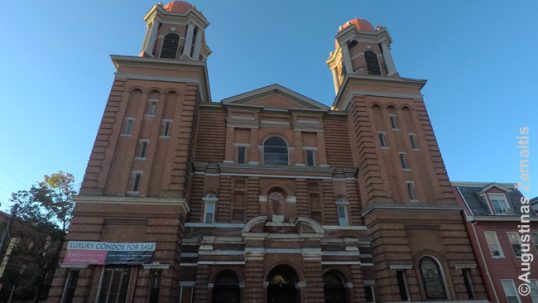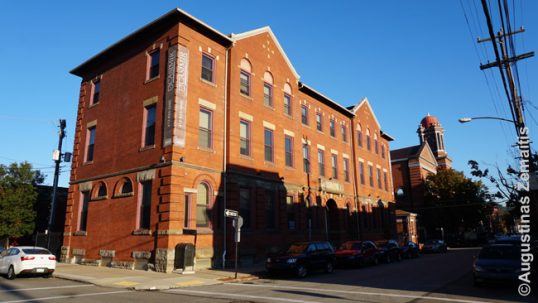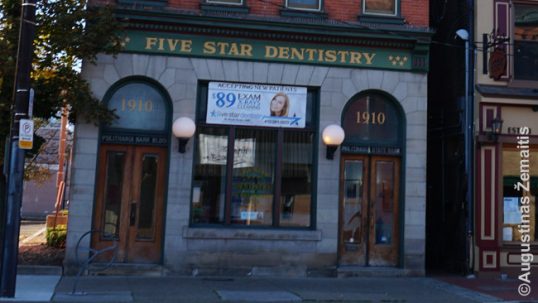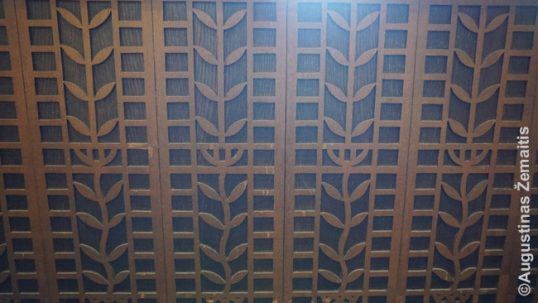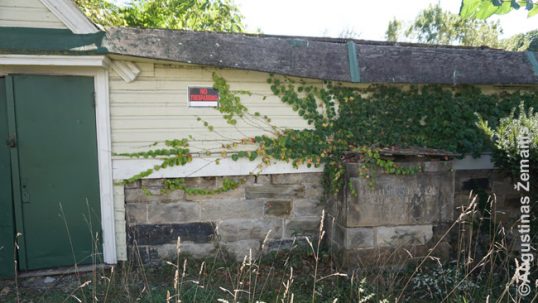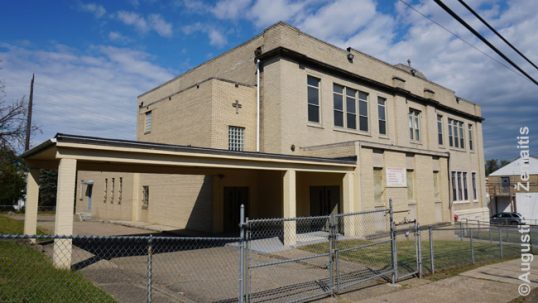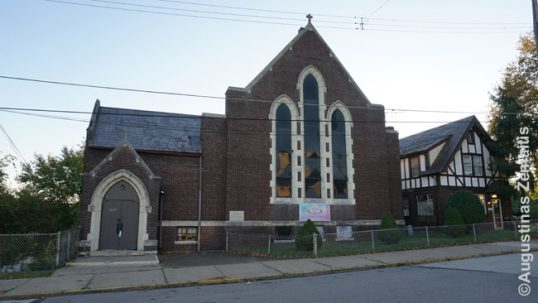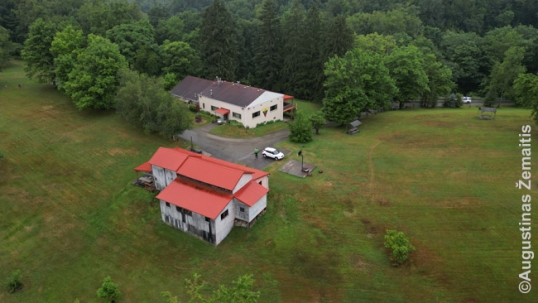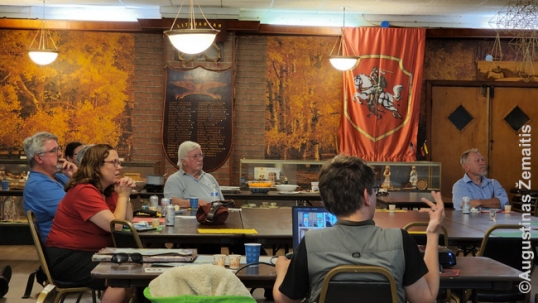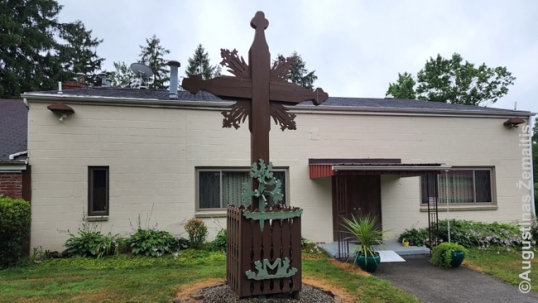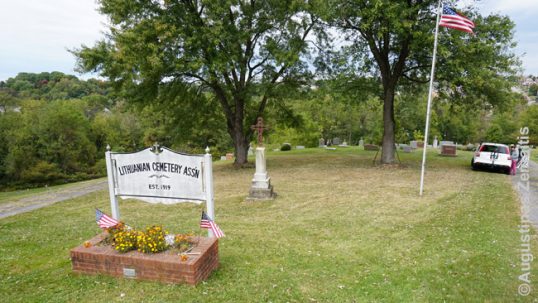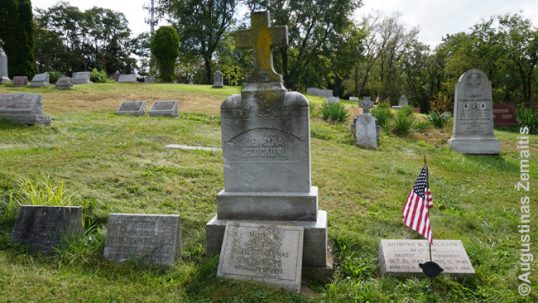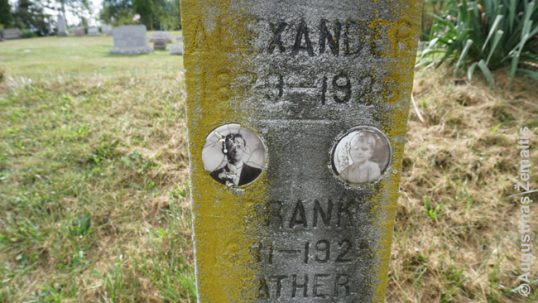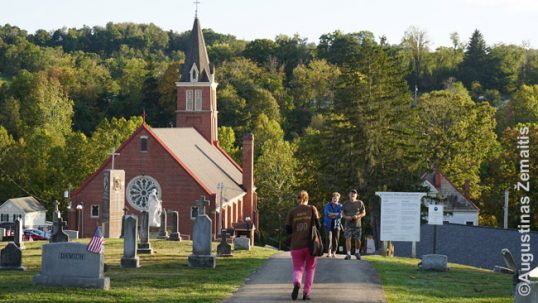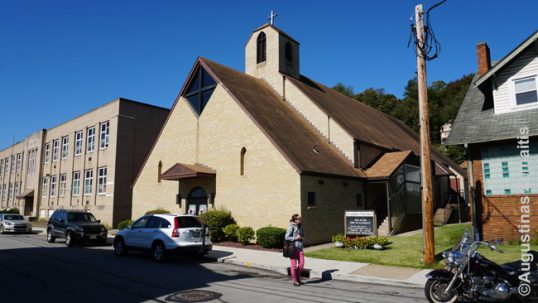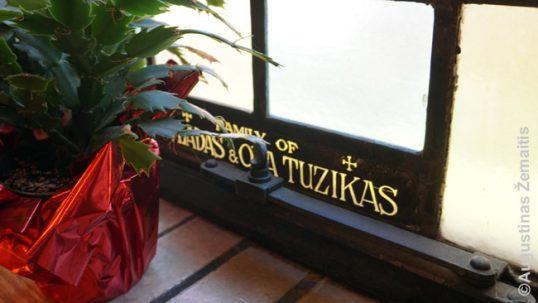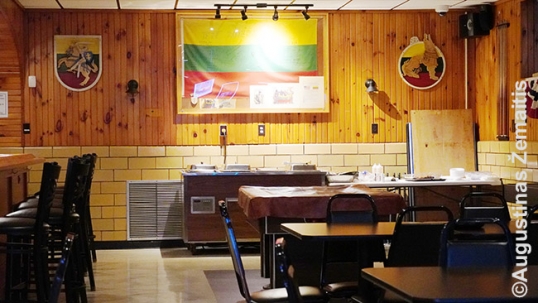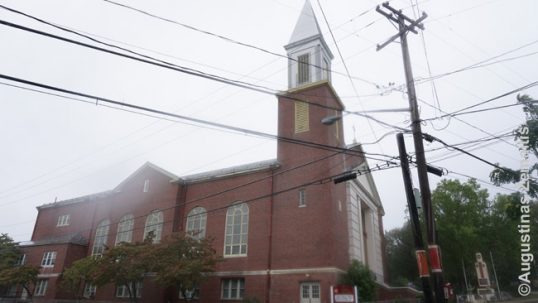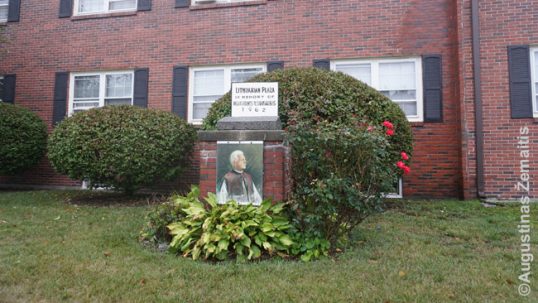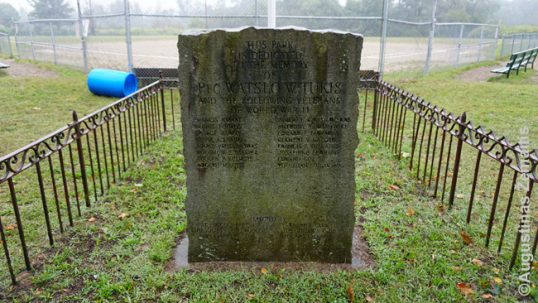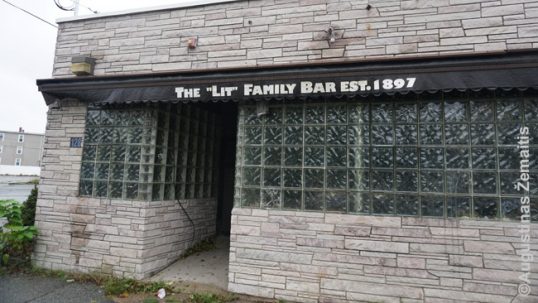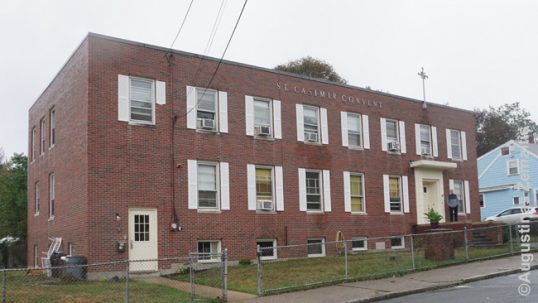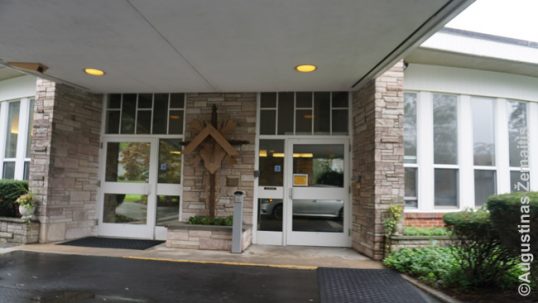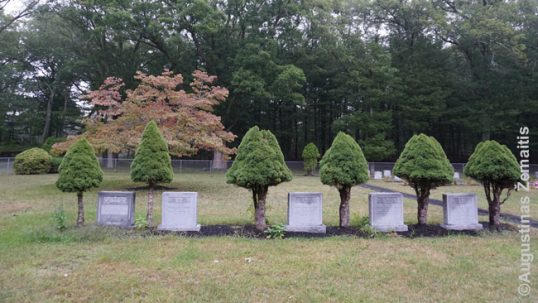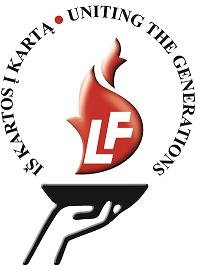United States of America
The USA has been the dreamland for Lithuanians since ~1865. A million of them emigrated there. Although many loved the American freedom and economy, most still remained culturally Lithuanian for generations, putting their hard-earned money into hundreds of lavish patriotically-themed Lithuanian halls, churches, monasteries, schools, parks, cemeteries, and other buildings that became unique "Lithuanias outside Lithuania" in the midst of American industrial cities and mining towns. Many of them are impressive to both Lithuanian and non-Lithuanian alike.
USA Lithuanian heritage by state
Click on the images to see extensive articles on the great Lithuanian heritage in that state.
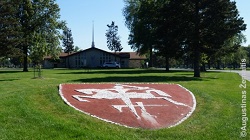 |
||
| |
|
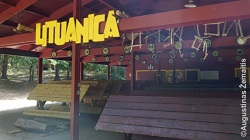 |
| |
|
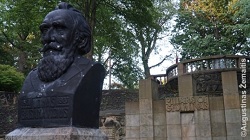 |
| |
|
 |
| |
 |
|
| |
|
|
Other US states with Lithuanian sites: Florida, Iowa, Minnesota, Missouri, Texas, Washington (state).
History of Lithuanian-Americans and their heritage
According to the US census of 2001, there are some 700 000 Lithuanian-Americans. This is the largest Lithuanian community outside Lithuania and the most important one. There is much Lithuanian heritage in the USA, especially in the New England, Mid-Atlantic and the industrial cities of the Midwest.
Lithuanians settled in the USA in three separate eras, so-called "waves". The first wave arrived in the late 19th century (when Lithuania was occupied and discriminated by Russian Empire). Some 350 000 Lithuanian peasants left their agricultural lives for workplaces in Pennsylvanian mines, slaughterhouses of Chicago and factories in other major cities. Speaking little English they formed their own districts and communities, founded Lithuanian newspapers and orchestras, funded extremely lavish churches (for their humble lifestyle) and now lay in cemeteries covered by massive tombstones. The first wave was curbed by the limits on immigration imposed in 1908 by the US government but its legacy continued.

The first wave Lithuanian-Americans campaign for the liberty of Lithuania in the 1910s. Some of them returned after 1918 independence to help their homeland get on its feet.
The second wave came after World War 2. People who managed to escape the Soviet regime were finally able to leave overcrowded refugee camps in Germany in some 1948. The USA welcomed up to 100 000 of them, never having recognized the Soviet occupation of Lithuania. These refugees were primarily intellectuals, artists, and the elite. Feeling to have been forced from their homeland rather than leaving it due to economical reasons they were/are very patriotic, taking part in various Lithuanian groups and social gatherings, Lithuanian churches being among the most important. Even many people born in the USA to such Lithuanian parents are more attached to Lithuania than to their new homeland. The massive second wave of immigrants fought hard to advance the Lithuanian cause and established an entire nation of Lithuania-in-exile, with its government in Washington, DC and all the necessary institutions. Their tireless work contributed to the restoration of Lithuanian independence in 1990. This event came just at the time when time started to take its toll on the second wave Lithuanian-American communities. However many were still in good health in the 1990s and some left their comfortable American lives for restored free Lithuania using their experience and money to help rebuild their homeland after decades of Soviet misrule. Among these returnees was president Valdas Adamkus (1998-2009), two presidential candidates, and multiple businessmen. In a sense, this helped to make Lithuania of the late 1990s more American than European in various ways.
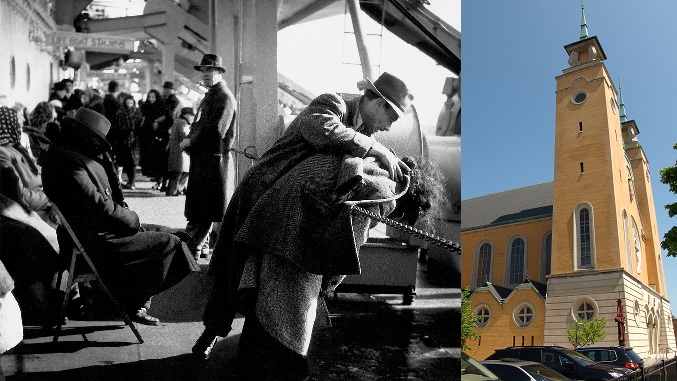
Lithuanians DPs in a ship which moves them from refugee camps in Germany to a new world (left image). They later established cohesive communities, such as the one centered around this new (1950s) Nativity BVM church in Marquette Park, Chicago (right image).
The third wave immigrated after the restoration of independence opened the borders yet again. The reasons for migration were economical as years of Soviet rule left the Lithuanian economy shattered. At one time some half of Lithuanian US tourist visa holders would not return home. After Lithuania joined the European Union in 2004 this migration diminished as more people opted for Western Europe instead. Third-wave immigrants are generally less attached to their native culture than the previous waves. Influenced by long Soviet state atheism they are also less religious. They failed to replenish Lithuanian churches and therefore American dioceses went on to Lithuanian church closure and demolition spree in the 2000s. The number of people that consider Lithuanian culture important also decreases as the older generations pass away. Some of the things you can see today may no longer be there after a couple of years, so be quick.
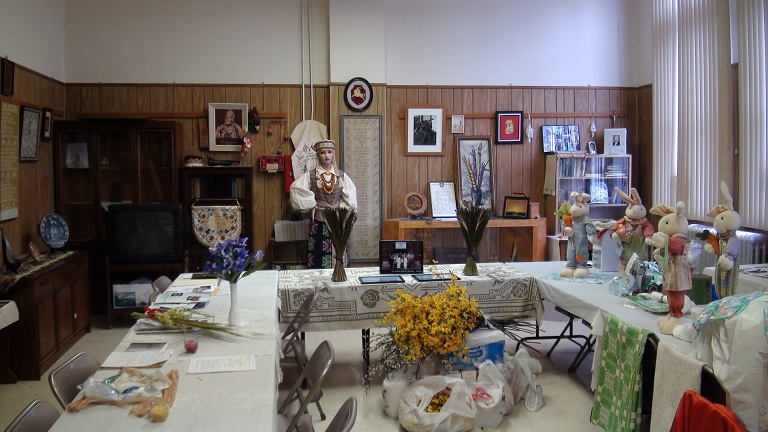
Mini-museum of Lithuania at St. Anthony church in Detroit (closed 2013). Old Lithuanian American parishes, clubs, and other institutions typically include memorabilia such as Lithuanian flags, emblems, anthem texts, ethnic clothes, religious symbols, historical and modern images, names of important people and freedom fighters. ©Augustinas Žemaitis.
Chicago is regarded to be the capital of Lithuanian Americans. There were several Lithuanian neighborhoods and two streets are still named after Lithuania. Lithuanians constructed many churches, the most elaborate being the Holy Cross in the Back of the Yards (1913). There are two extensive Lithuanian cemeteries: the Roman Catholic St. Casimir and the multidenominational Lithuanian National Cemetery. Several monuments and plaques exist, the most famous being the memorial for pilots S. Darius and S. Girėnas, the first Lithuanians to perform a transatlantic flight. The world's oldest Lithuanian language newspaper Draugas is published in Chicago since 1909. There are opportunities for tasting Lithuanian dishes (even though they are less common than in the 1990s or before). You may also visit the Balzekas Museum of Lithuanian culture, the only such institution outside Lithuania.
The rule of the thumb is that in every city that used to be major in early 20th century exist be Lithuanian communities and heritage, primarily churches and cemeteries. This can be said about Cleveland and Detroit near the Great Lakes as well as Boston, Baltimore, New York and Philadelphia on the Eastern coast. Los Angeles is the only city in the west to have a sizeable Lithuanian community (and a church). Ater all the America's West was much less populated at the time of second and especially the first waves of Lithuanian immigration.
Pennsylvania has a large population of Lithuanians in its small Coal Region towns, in some places exceeding 10%. Shenandoah used to be called Vilnius of America. Here you may also find Lithuanian churches and cemeteries (unfortunately many churches, such as the 19th century one in Shenandoah, were condemned to demolition or are no longer used for religious purposes). Lake Kasulaitis in Pennsylvania is a rare Lithuanian toponym on the American continent.
Washington DC has a Lithuanian embassy that served like a shadow government in the years of Soviet occupation.
Illinois
Illinois hosts more Lithuanian-Americans than any other state. It is second only to Pennsylvania in terms of Lithuanian heritage sites.
The key Lithuanian areas of Illinois include:
*The grand historic Lithuanian districts of southern Chicago.
*Some of Chicago's western suburbs.
*Several industrial cities (Rockford, Springfield, Waukegan, Kewanee, East St. Louis).
*A few coal mining towns in central and southern Illinois (Spring Valley area, Westville area, West Frankfort area).
*Furthermore, there is an extensive "Lithuanian Riviera" east of Chicago that continues far beyond Illinois state limits, hugging the shores of Lake Michigan.
Each of these areas has a significantly different Lithuanian vibe, history, as well as heritage sites that one may still visit today.
Here we introduce every area (with links to longer articles about each one of them) and conclude the article with the general Lithuanian history of Illinois.



Cicero St. Anthony Lithuanian church in Chicagoland, one of the big pre-war Lithuanian churches that served as the hubs of Chicagoland's Lithuanian districts
Chicago, its Lithuanian districts and suburbs
Chicago is considered to be not only the „Lithuanian capital of Illinois“ but also the „Lithuanian capital of Americas“ or even the „Lithuanian diaspora capital of the world“, and it has been so since at least 1910s.
The facts are nothing less than stunning: before World War 1, Chicago had more ethnic Lithuanians than any city in Lithuania itself (almost 100 000). Right until the 1980s, there were more Lithuanian-language churches in Chicagoland than in any other city in the world (Lithuania itself included).


Holy Cross Lithuanian church in Chicago (Back of the Yards), built in the 1910s, is the largest Lithuanian church of Chicago
In effect, the Chicago Lithuanian community was way too big to cram itself into a single Lithuanian district. Instead, Chicago's southside became dotted by such Lithuanian districts, each centered around a Lithuanian church but gradually expanded by Lithuanian halls, Lithuanian convents, Lithuanian schools, Lithuanian businesses, and Lithuanian monuments. Chicago has a few Lithuanian architectural masterpieces that have no pars in Lithuania itself, while some of Chicago's Lithuanian churches are among the largest and most opulent Lithuanian churches in the world. Each of them serves not only as a religious hub but also as a secular hub for Lithuanian activities.
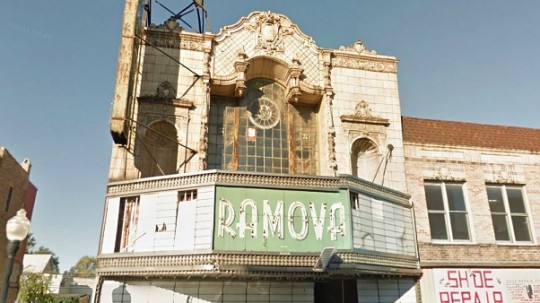

Ramova Lithuanian-owned cinema, named after Lithuanian pagan temple (Bridgeport, Chicago)
There were two key eras of Lithuanian district expansion in Chicago during which most of the city's Lithuanian buildings and monuments were built. The first era covered ~1900s-1920s, propelled by Lithuanians who came to work in Chicago's industry, escaping their poor Russian-ruled country. The second era was ~1950s-1960s when tens of thousands Lithuanian refugees who fled the Soviet Genocide were relocated from the refugee camps in Europe to Chicago, wishing to establish "Little Lithuanias" all over the city.
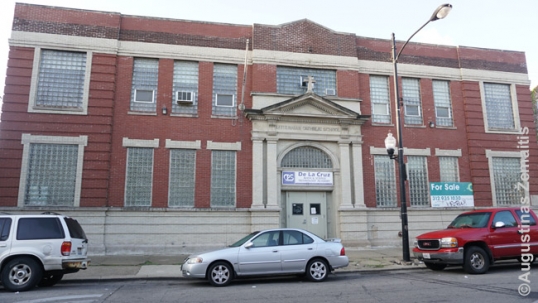


Our Lady of Vilnius church/school in the Heart of Italy district of Chicago. It is an example of a 'temprorary building' that served both as a church and as a school. In many cases, as Lithuanian communities grew larger and more affluent, these were augmented by a separate larger church building, however, not here
Many of Chicago's Lithuanian buildings survive, however, all of the historically Lithuanian districts became Black or Hispanic majority in the 1970s-1990s. Lithuanians moved away to the Chicago suburbs. There is no single Lithuanian suburb, though, as in the era of the automobile (unlike in the early 1900s), Lithuanians could easily live in one part of Chicagoland and go to the activities in another. Some Lithuanians thus still frequent the historic Lithuanian hubs in the inner city for Lithuanian Mass or activities. Others, however, are mostly attached to the new Lithuanian hub, known as Lithuanian World Center, established in 1980s in the Lemont suburb. Lemont thus became the unofficial capital of Chicago's Lithuanian suburbia with many Lithuanian-American organizations headquartered therein. While some Lithuanian public activities remained in Chicago itself, nearly all Lithuanian businesses (e.g. restaurants) moved to the suburbs, especially to the Lemont-Westmont area.


Lithuanian restaurant in Westmont area
Correlating with the general Inner City vs. Suburbs vibe trend in the USA, the Lithuanian buildings of Chicago suburbs are different than those in the historic districts. They are more oriented towards function than grandeur or Lithuanian artworks, and many of them are generic-looking from the outside. That said, the Lemont area has received some impressive Lithuanian monuments.


Symbolic Hill of Crosses built at the Lithuanian World Center in Lemont to imitate the original Hill of Crosses near Šiauliai, Lithuania
In Chicago city itself, Marquette Park is the largest Lithuanian district outside Lithuania to have ever existed (population of 40 000 in the 1960s), as evident in its massive monuments and buildings. Other key Lithuanian hubs include(d) Back of the Yards, Brighton Park, Gage Park, and Cicero, where a lot of heritage still survives. Bridgeport was a massive Lithuanian district that unfortunately had most of the Lithuanian buildings demolished. Lithuanian buildings still survive in Roseland, Pilsen, Chicago Heights, South Chicago, and West Pullman albeit none of these are in Lithuanian operation.



Corronation of Mindaugas mosaic at the Nativity BVM Lithuanian church
Generally, in the historically smaller or older Lithuanian districts, the Lithuanian life died out and the institutions closed soon after the "white flight", while in the larger and newer districts, some buildings are still in Lithuanian use. Typically, the districts with Hispanic majorities fare better than those with African American majorities, because, among other reasons, Hispanics, like Lithuanians, are generally Roman Catholic, and so they joined the Lithuanian churches, helping them survive even after most Lithuanians moved out.
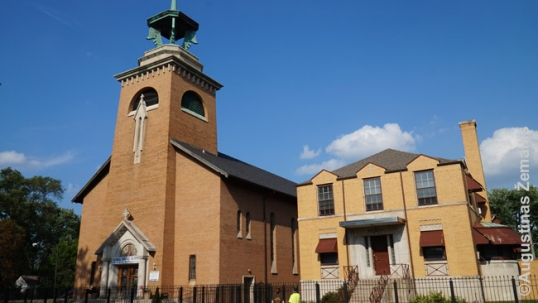


Roseland All Saints Lithuanian church (now non-Catholic, African American)
In addition to local institutions within each single Lithuanian district of Chicago, Lithuanians have established some pan-Chicago Lithuanian institutions. These include two Lithuanian cemeteries notable for their grand Lithuanian tombstones created by famous sculptors, as well as numerous famous burials. These two cemeteries - the Catholic St. Casimir and the religion-neutral Lithuanian National Cemetery - are the largest and most famous Lithuanian cemeteries outside Lithuania and they also serve as repository for Lithuanian memorials. Meanwhile, Lithuania's Jews have created their zones in the Waldheim Jewish cemetery.



Lithuanian coat of arms land art at the St. Casimir Lithuanian cemetery of Chicago
Moreover, Lithuanian museums and archives of Chicago became not only the main hub for Lithuanian-American history research but also for free Lithuanian research altogether in the times while Lithuania was Soviet-occupied (1940-1990). The most famous among museums are the Balzekas Museum and the Lithuanian Art Museum within the Lithuanian World Center.
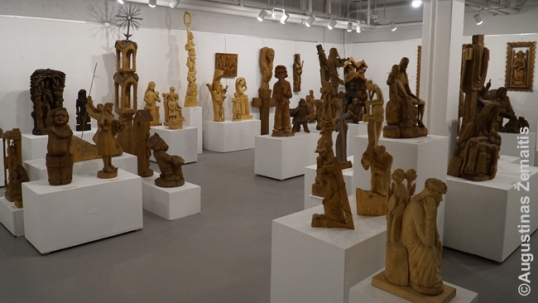


Lithuanian wooden arts at the Lemont museum
Lithuanians of the smaller industrial cities of Illinois
Several smaller industrial cities of Illinois are like mini-Chicagos in terms of their Lithuanian heritage and history. Like in Chicago, the main bulk of Lithuanians immigrated to those cities before World War 1, attracted by industrial jobs.
Unlike Chicago, however, each of these cities had just a single Lithuanian area, centered around a single Lithuanian church and, in many cases, a Lithuanian club and/or a Lithuanian school. Also, the communities there were never large enough to establish their own Lithuanian cemeteries.
Industrial cities of Illinois that became Lithuanian hubs include:
*East St. Louis, with its Modern-Lithuanian-style church that is among the best examples of this style in the world.
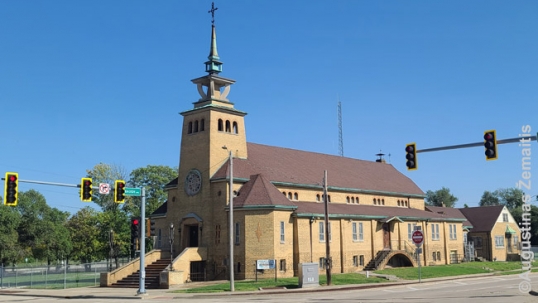

Immaculate Conception Lithuanian church of East St. Louis
*Rockford, with its Lithuanian church, club, park, and exhibits in a local museum.
*Springfield with its Lithuanian church which has been demolished but a memorial plaque now reminds it.
*Waukegan, with its Lithuanian church and club.
*Kewanee, with its Lithuanian church.
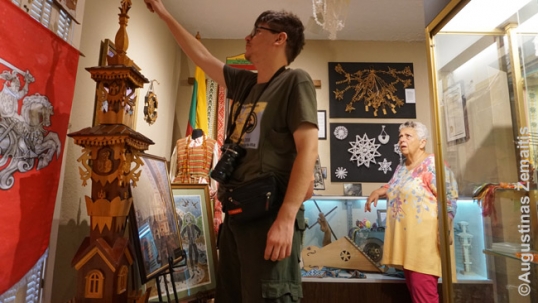

Rockford Ethnic heritage museum Lithuanian room
Each of these cities also had numerous Lithuanian businesses. Unlike Chicago, however, the smaller industrial cities attracted fewer new immigrants after World War 2, and so Lithuanian life declined there faster, with many older Lithuanians eventually assimilating or moving out. As such, all the businesses closed or became non-Lithuanian, and so did most of the churches and other institutions.
Two additional such industrial cities are located in Indiana but very close to Chicago. Their history mimics that of Illinois's industrial cities:
*East Chicago, with its Lithuanian church (demolished).
*Gary, with its Lithuanian church and school.


Lithuanian inscription on the Gary Lithuanian church stained-glass window survives despite church being no longer in Lithuanian use
Lithuanian coal mining towns of Illinois
Illinois's coal mining towns developed in the same era as the industrial cities. However, they were much smaller, having a population numbering in just four or lower five digits.
As pre-WW1 Lithuanians would often migrate to the same areas in their thousands, some of the Illinois coal mining towns possibly even became Lithuanian-plurality or Lithuanian-majority sometime around World War 1 (although the exact Lithuanian percentage in each one of them varies according to different sources).
The most Lithuanian towns included Spring Valley and Westville, where most Lithuanian heritage exists.
Likely a lower percentage of ethnic Lithuanians existed in Oglesby, West Frankfort, Ledford, and Johnston City (or Lithuanians moved out from there earlier, leaving less heritage).
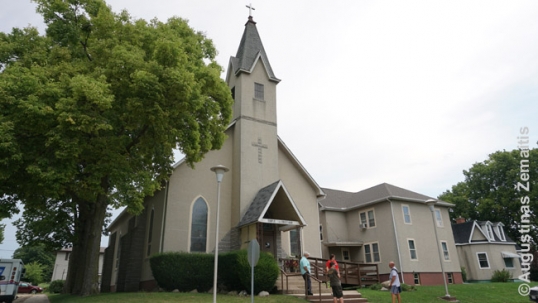

Spring Valley St. Anne Lithuanian church
Given that all of these were small towns with ample land available, Lithuanians were able to establish their own cemeteries in each of them (except for Oglesby). In fact, in Spring Valley and Westville, they established two Lithuanian cemeteries in each town (based on differing religious views). While they built just a single Lithuanian church in Spring Valley and a single one in Oglesby, they actually built two Lithuanian churches (of different denominations) in Westville. In any case, these churches and other Lithuanian buildings were generally more modest than in the main cities of Illinois.
Unlike the Illinois industrial cities and Chicago, the mining towns received nearly no new immigration (Lithuanian or otherwise) after World War 1 and, in fact, younger people have been slowly-but-surely moving out. However, with such strong initial Lithuanian communities percentage-wise there still exist significant numbers of Illinois-mining-town-born people who are 50% to 100% of Lithuanian descent and thus are keen on their heritage (although the Lithuanian language has nearly completely "died out" in the area). Often, they volunteer in taking care of the numerous Lithuanian cemeteries.
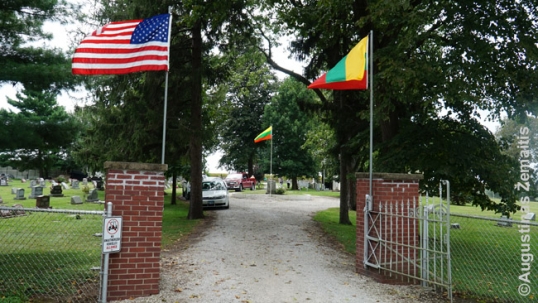

One of the entrances to the Westville Lithuanian cemetery
In addition to all these "typical" Lithuanian coal miner settlements, Illinois also has Collinsville, which is the only town of America to have attracted its Lithuanian population mostly from Lithuania's Lutheran minority rather than Catholic majority. Collinsville thus has a Lithuanian Lutheran church.
Chicagoland's Lithuanian Riviera
While not exactly part of Illinois, northern Indiana and even southwesternmost Michigan effectively became a continuation of Chicago's Lithuanian life. Several lakeshore resorts there became effectively Lithuanian, especially Beverly Shores, IN, and Union Pier, MI.
The primary reason why Lithuanians chose these resorts was their massive sand dunes that reminded Lithuanians of the Lithuanian shores (e.g. Palanga, Neringa).


Lituanica park memorial stone
It all started ~1950s with Chicago Lithuanians sending their housewives and children to spend summers in these Michigan Lake shores (the husband would typically join them in weekends only). Later, many of these families retired there, establishing permanent Lithuanian communities. Even later, as living in distant suburbs became the norm, these retirees were joined by commuters who would commute to Chicago.
Some of these restores effectively became some of the most ethnically Lithuanian towns anywhere in America, with 10%+ Lithuanian population in Beverly Shores, Indiana. Lithuanians lithuanized the landscape by building several monuments in the area. There were many Lithuanian hotels, one of them even owned by the future president of Lithuania Valdas Adamkus, although they closed down over time.
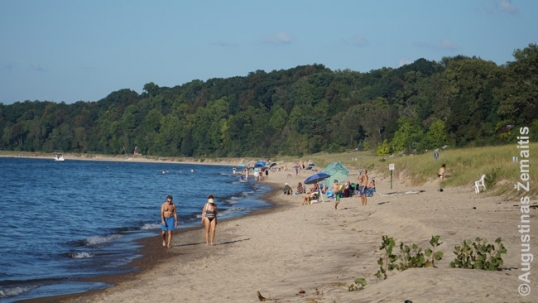

The beach at Union Pier resort
Illinois's Lithuanians also played a vital role in establishing the Lithuanian camps deeper into Michigan. The idea behind these pristine Lithuanian parks was to have an area for Lithuanian children to spend at least a couple of weeks in summer surrounded by other Lithuanian children from all over Midwest (see the articles on Manchester and Custer to learn more about these camps).
Lithuanian history of Illinois
The Lithuanian grandeur of Illinois mostly dates to the late 19th and early 20th century, when developing Illinois industry (primarily the Chicago stockyards) attracted some hundred of thousand Lithuanians from their Russian-occupied agricultural homeland, where the Russian regime was discriminating ethnic Lithuanians.
These so-called First Wave Lithuanian-Americans spoke little English, hindering their ability to integrate. Moreover, the National Revival was going on strong in their own country, so many of these immigrants were also ideologically inclined to "keep the Lithuanian flame going" even after emigration. They put lots of their money and energy into erecting Lithuanian buildings to serve as their community hubs (Lithuanian schools, churches, clubs). The existence of these Lithuanian districts in Illinois helped to perpetuate the Lithuanian language and traditions into the next generations, as Lithuanians were likely to marry other Lithuanians, and even their America-born children were typically surrounded by an entire neighborhood Lithuanian-speaking children; they also attended the Lithuanian parish schools.



Cicero St. Anthony Lithuanian school and church
The numbers of new Lithuanian immigrants to Illinois dried up with the US immigration restrictions, as well as the declaration of Lithuanian independence (1918). Yet, Lithuanian districts of Illinois continued to be expanded by new buildings and institutions, as the previous immigrants were finally achieving their "American Dream" of financial sufficiency, allowing them to spend even more on the Lithuanian causes.
Illinois Lithuanian community was internally divided along the religious/political lines. In addition to the religious Catholic majority, there were leftist, nationalist, and Lutheran minorities-within-minority. In Chicago, each of those groups had its own buildings (often in the same Lithuanian districts) but in the smaller Lithuanian communities of Illinois, the Lithuanian public life often went on around the Lithuanian Catholic church. Also, there were numerous people of Lithuania's ethnic minorities who immigrated (Poles, Jews) - however, typically did not see themselves as Lithuanians at all, integrating into a wider community of their own on ethnicity basis (e.g. Jewish-Americans or Polish-Americans).
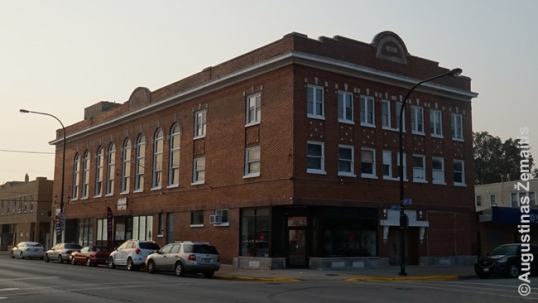


Lithuanian Liberty Hall of Cicero (leftist)
The face of Illinois's Lithuanian districts was transformed once again after 1940s, when Soviet Union occupied Lithuania and began a genocide there. This persecution of an unheard-of scale unleashed the second wave of Lithuanian immigrants to the USA. Most of these refugees were initially supported by their friends and relatives who immigrated decades ago, and so they settled in the same Lithuanian districts. Thus, very large numbers of them settled in Illinois. Chicago became their capital as well, with smaller numbers settling down in the other Illinois industrial cities (but very few moving to the already-economically-unattractive coal mining towns).
These refugees saw themselves as exiles rather than emigrants (as they would have never left Lithuania if not for the Soviet Genocide), and they also considered themselves to be the sole hope for the survival of the Lithuanian language and culture (given that the Soviets were able to easily destroy it back in Lithuania itself). So, this wave of Lithuanians of Illinois was even keener to establish Lithuanian institutions. While the First Wave (pre-WW1) of Lithuanian immigrant was almost entirely blue-collar, the Second (post-WW2 refugee) wave also included many of the top-level famous Lithuanian artists and architects. This allowed a plethora of new Lithuanian buildings, monuments, and other creations in Illinois to reach both the top level of artistic creativity and the top level of Lithuanian ethnic and historical symbolism. In fact, an entirely new unique Modern Lithuanian architectural style was largely created in Illinois, with most of its best examples located within the state (East St. Louis and Marquette Park area of Chicago). Some of the Illinois's Lithuanian artworks are considered to be among the top Lithuanian artistic expressions of the era anywhere in the world.
In the areas where there were fewer these Second Wave Lithuanian immigrants, they simply integrated into the First Wave institutions, replenishing them and re-lithuanizing them but not rebuilding them from scratch.
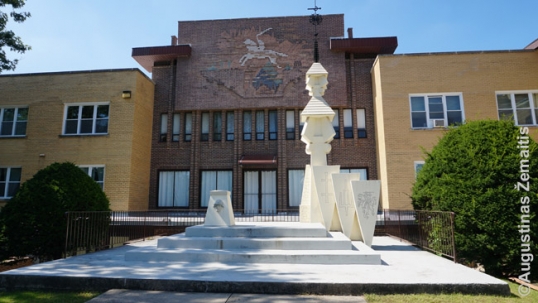


Lithuanian Youth center facade with Vytis and the memorial to those who died for Lithuanian freedom in front. It was built in the Modern Lithuanian style by the post-WW2 refugees
Throughout the Soviet occupation of Lithuania (1940-1990), Chicagoland remained the global capital of "Free Lithuanian thought", hosting diverse institutions ranging from the free world's only Lithuanian opera company to global Lithuanian archives. The Lithuanian geography within Chicagoland changed rapidly, however, in the 1960s-1980s, as the African American Civil Rights movement led to sometimes forceful movement of African Americans from the southeast into the historically Lithuanian districts (while Lithuanians were not the real/primary target, their districts happened to stand in the way between the African-American districts and the affluent "Old White" districts of central and northern Chicago). Increased crime rates made many Lithuanians to move out of their districts into the western suburbs or even northern Indiana. Unlike the former inner-city Lithuanian districts, no suburb ever became Lithuanian-plurality, hastening the assimilation of Lithuanians. To most Lithuanians at the time, any Lithuanian activities became accessible solely through a long drive from home, and there were very few (if any) Lithuanian neighbors, classmates, or workmates, in start contrast to the situation they enjoyed in the inner city Lithuanian districts.
The Lithuanian institutions of the once-smaller Lithuanian districts quickly folded as too few people would have continued coming there. Similar "white flight" happened in the other industrial cities of Illinois as well, most strikingly in East St. Louis. However, it did not take place in the coal mining towns.



Abandoned Lithuanian pub in Marquette Park
After 1990, when Lithuania became independent, Chicago (and to a much lesser extent a few other Illinois cities) received the so-called Third Wave economic migrants from the now-independent but economically-ravaged Lithuania. Like the First Wave, they often spoke no English. However, after some attempts to resettle a few historic Lithuanian districts, they dispersed across the suburbs.
After Lithuania joined the European Union in 2004, Lithuanian emigration reached proportions larger than ever before. However, the EU membership allowed an easy option to legally migrate to the Western Europe which quickly outcompeted the more cumbersome process of emigration to the USA. Therefore, in a matter of a single decade, Western Europe replaced the USA as the prime area of Lithuanian diaspora, while London (UK) area surpassed Chicago area in the number of ethnic Lithuanians.
That said, due to a massive history, grand Lithuanian institutions, artworks, and buildings, as well as generations of Lithuanians willing to "keep the Lithuanian flame going" and invest their hard-earned money and energy into that, Lithuanian culture in Illinois is still arguably much more visible and potent than that in any single European country (besides Lithuania itself and maybe Poland's Punsk area).
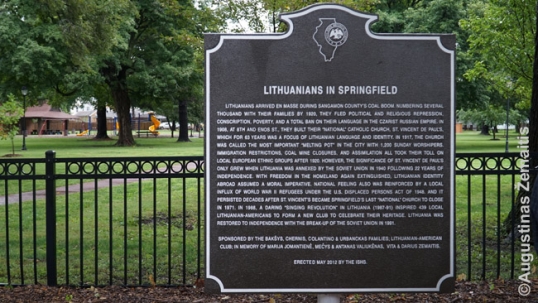

Lithuanians in Springfield commemorative plaque
The map
All the Lithuanian locations, described in this article, are marked on this interactive map, made by the "Destination Lithuanian America" expeditions (click the link):
Chicago, Illinois
Home to some 80 000 Lithuanians, Chicagoland is perhaps the second important center of Lithuanian nation after Lithuania itself and it has been so for well over a century. Between the 1890s and 1930s, there were more Lithuanians in Chicago than in any town or city of their still agricultural former homeland. Chicago Lithuanian numbers increased rapidly from 14 000 in 1900 to 80 000 in 1924.
After earning enough money some Lithuanians went back to Europe yet onthers remained, starting influential families. Elaborate Lithuanian churches were built, followed by schools, monasteries, museums, clubs, and other institutions. The center of Lithuanian settlement gradually moved: from Bridgeport and Back of the Yards (in the 1900s - 1910s) to Marquette Park (in 1950s). After Marquette Park was overtaken by Blacks there is no longer a Lithuanian district in Chicago, but a community center exists in the Lemont suburb.
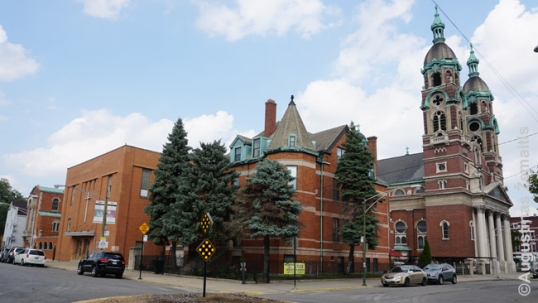

Lithuanian district center with church, school, and monastery at the Back of the Yards district
The top Lithuanian sites to visit in Chicago are:
1.Top Lithuanian churches - Holy Cross (see "Back of the Yards") and Nativity BVM (see "Marquette Park"), followed by St. Anthony (see "Cicero") and Immaculate Conception (see "Brighton Park").
2.Top Lithuanian museums and cultural centers - Lithuanian World Center (see "Lemont"), Balzekas museum (see "West Lawn"), Lithuanian Youth Center (Gage Park).
3.Lithuanian cemeteries - St. Casimir Cemetery and National Cemetery (see "Lithuanian cemeteries").
4.Lithuanian monuments - the Lemont Hill of Crosses (see "Lemont"), Darius and Girėnas monument (see "Marquette Park").
5.Other sites - St. Casimir Sisters convent, Lithuania Plaza street (for both see "Marquette Park").
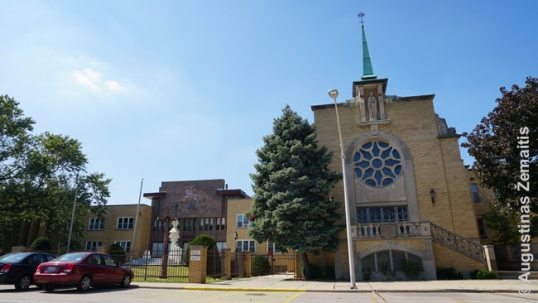

Lithuanian Youth center, housing numerous museums, archives, and memorials
Sadly, Lituanity in Illinois seems to be somewhat on a decline. In the 1990s - 2000s several Lithuanian churches were demolished or no longer celebrate Mass in Lithuanian. The older generation of Lithuanians ("second-wave immigrants") pass away, and the third wave did not replenish Lithuanity as much as expected.
Back of the Yards - stockyards and America's top Lithuanian church
The most impressive of the Chicago's Lithuanian churches is the Baroque revival Holy Cross in Back of the Yards that has been even included in the general books on Chicago architecture.


Holy Cross Lithuanian church in Chicago (Back of the Yards)
Built by the original community of slaughterhouse workers in 1913 the elaborate church once anchored a district full of Lithuanian homes and institutions. With immigrants from Latin America displacing Lithuanians, the parish was abolished in the 1970s and the Lithuanian Mass ceased to be celebrated in ~2005. Plaque "Lietuvių Rymo katalikų bažnyčia" remains near the entrance ("Lithuanian Roman Catholic church" in pre-modern Lithuanian language when "Rome" was still called "Rymas") while the pediment includes the Columns of Gediminas.


Pediment of the Holy Cross Lithuanian church in Chicago (Back of the Yards) with columns of Gediminas (on the right side)
The interior (accessible on Sundays alone) is also miraculously spectacular, dwarfing even many cathedrals in its splendor, as well as most churches in both Chicago and Lithuania itself. It includes paintings of the Hill of Crosses (Šiauliai) and the Gate of Dawn (Vilnius Old Town), as well as Christening of Mindaugas, while the stained-glass windows and artworks are mostly Lithuanian-funded, having the Lithuanian names of sponsors or artists under them.


Holy Cross Lithuanian church in Chicago (Back of the Yards) interior
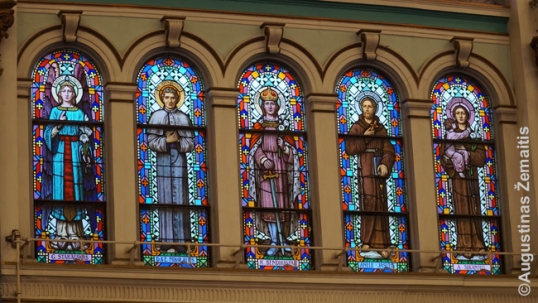

Stained glass windows at the Holy Cross Lithuanian church in Chicago (Back of the Yards)


Hill of Crosses painting at the Holy Cross Lithuanian church in Chicago (Back of the Yards)
While initially the church has been constructed by a Czech architect Joseph Molitor (at the time, there were no Lithuanian architects capable of such a feat) and stained-glass windows created by a non-Lithuanian Arthur Michaudel studio (1943), in the 1950s it has been later greatly Lithuanized by Adolfas Valeška, who is responsible for many of the Lithuanian artworks. Moreover, the floor has been covered in Lithuanian patterns since that renovation.
Next to the church stands a former Lithuanian convent (1954) with a traditional Lithuanian sun-cross and Lithuanian-crated mosaic (author - Valeška, architect - Kova-Kovalskis). On the right of the image, there is the former parochial school.
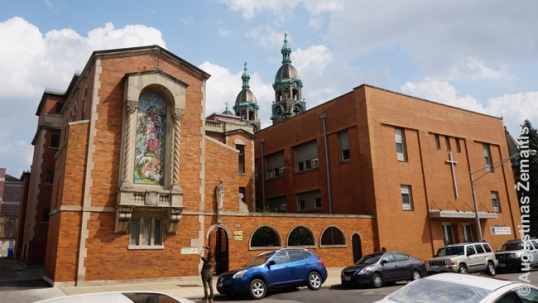

Holy Cross Lithuanian monastery
The life of Lithuanian butchers who built the Back of the Yards is described in the fictionalized account "Jungle" by journalist Upton Sinclair still held to be of great importance to Chicago history. It was in these slaughterhouses where the industrial might of the Chicago was born. For the first time, the animals were slaughtered in a single city only to be sold in faraway places like New York or Boston. Prior to this "to buy meat" meant "to visit a local butcher", something changed for good by the Chicago's businessmen and countless immigrants from thousands of cities and towns around Europe (the number of Lithuanian butchers was only surpassed by Poles).
The famous Chicago Union Stockyards have been closed in 1971 and mostly demolished. A few buildings remain such as the Stockyard gate in W Exchange Ave. Next to the gate, a plaque reminds of the Stockyards history and the "Jungle" novel. It reminds of the Lithuanians as one of the major groups of workers in the yards.


Union Stockyard gate in Chicago
In 2021, a Packinghouse museum has been established in a former slaughterhouse of the Back of the Yards that has been now converted for other uses. This was not part of the Union Stockyards, however, but rather some of the of competing smaller slaughterhouses nearby. Nevertheless, some slaughterhouse decor is visible there and the exposition includes information on Lithuanians as well as the general life in the slaughterhouses.
Bridgeport - the first Lithuanian district of Chicago
Bridgeport was once outflanked by a beautiful massive tower of 1902 Gothic revival St. George Lithuanian church. It was the oldest Lithuanian parish in Chicago (and, in fact, west of the Appalachians). Unfortunately by the bishop's decision the church was demolished in 1990 and replaced by an empty lot, after donating the church's works of art and furniture to a parish in the recently-independent Lithuania. The riches of the fading emigre were thus symbolically repatriated.


Bridgeport St. George Lithuanian church (demolished; left and center), its parish school (top right) and rectory (bottom right).
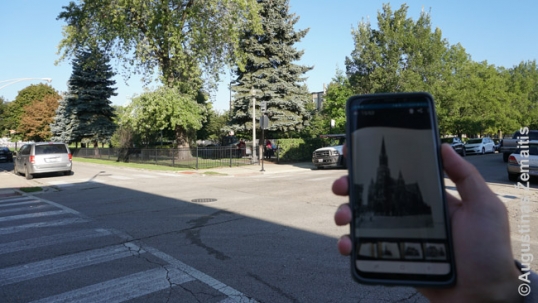

The site of the St. George Lithuanian church in Bridgeport
The nearby former 3-floored St. George parish school (1908), declared by to be the "best Lithuanian school in America" by a 1916 Lithuanian-American almanac, still stands although is a non-Lithuanian Philip Armour school (but the plaque "MOKYKLA ŠV. JURGIO K." (St. George C. school) still remains on top). In 1916, it had 450 pupils and a parish hall with 1500 seats (the parish was among the US's richest Lithuanian parishes).


St. George Lithuanian school at Bridgeport
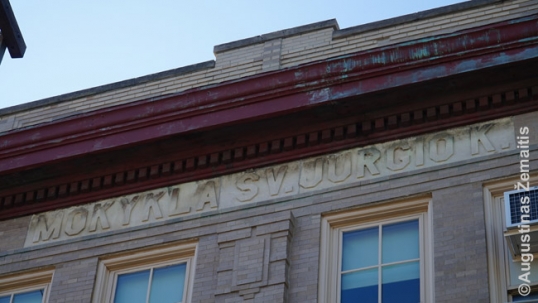

St. George Lithuanian school at Bridgeport
Bridgeport also had a massive Lithuanian Auditorium (3133 So. Halsted Street) with a Vytis on it (built 1925) which once served as the hub of Chicago's Lithuanian activities. However, it has also been demolished in the 1990s as Lithuanians departed the district. 1000-seat Lithuanian theater Milda (est. 1914), once associated with Lithuanian communists, has met the same fate (now replaced by a police station). Another theater "Ramova" (est. 1929) still stands (3518 S. Halsted Street); after being abandoned in 1986, restoration as a restaurant/live music venue/brewery began in 2021. The Lithuanian name (which means 'Pagan temple') proudly hangs over the S Halsted street on a historic large 1944 sign that is a final reminder of the era when most of the people in the area used to speak Lithuanian (the crumbling decor is Spanish-styled, however).


Ramova Cinema in Bridgeport
A street in Bridgeport is still named Lituanica Avenue since the 1930s. Lithuanian pilots Steponas Darius and Stasys Girėnas left for their doomed flight from the St. George church there. They became instant martyrs in 1933 when after flying across the Atlantic ocean their plane "Lituanica" crashed in what is now Poland, only several hundred kilometers from destination Kaunas. S. Darius and S. Girėnas were also worldwide pioneers of airmail and their continuous flight time was the second largest ever at the time (6 411 km).


Lituanica Street address
The western limit of Lithuanian Bridgeport used to be at Morgan St., with Poles living beyond it.
Darius-Girėnas memorial plaques in Chicago airports
Darius and Girėnas who perished while trying to make Lithuania's name famous are still the key figures for the Lithuanian-American community. In 1993 a plaque was unveiled for them in Midway Airport which happens to be at the center of various past and present Lithuanian districts and also the place where they named their plane as "Lituanica". In 2008 this plaque was reinstated after reconstruction through titanious efforts of some Lithuanians. The plaque is in the ticketed-passengers-only area at the beginning of Concourse A, on the left side if walking towards concourse A.
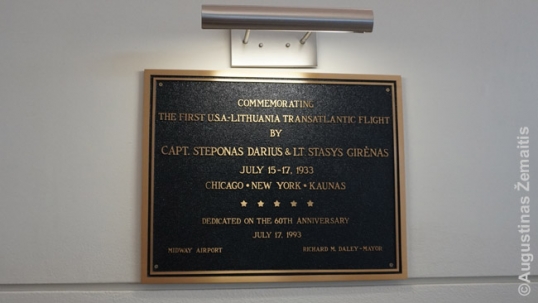

Darius and Girėnas plaque at the Midway airport
In 2013 (75th anniversary of the Darius-Girėnas flight) an additional memorial plaąue for them was unveiled in the Palwakee (now Chicago executive) airport. While Darius and Girėnas have departed from New York, Palwaukee was significant to them as they bought their Lituanica there. Palwaukee airport badge would often appear during the public fundraisers of Darius and Girėnas and it is even depicted on the 10 litas banknote that depicts Darius and Girėnas. The plaque is at the entrance room to the main airport building (with "Signature" words on it).


Darius and Girėnas memorial plaque at the Palwaukee airport
Marquette Park - the largest-ever Lithuanian district outside Lithuania
If somebody mentions "Chicago's Lithuanian district", he usually means Marquette Park. Back in the 1950s-1970s, it was the largest Lithuanian district outside Lithuania and many of today's prominent Lithuanian-Americans spent their childhoods there. At the time, the descendants of the pre-war immigrants who moved there for better-than-in-Bridgeport homes were joined by the "second wave" of refugees fleeing from almost certain deaths in their Soviet-occupied country. Coming from intellectual backgrounds, these refugees created a well-crafted and rich community, centered around Lithuania Plaza street. In its heyday, the Marquette Park area housed 30 000 Lithuanians (out of a total population of 45 000).


Lithuanian Plaza street name
Since those times, a large 1957 Church of the Nativity of the Blessed Virgin Mary (B.V.M.) towers over the district. It combines post-war architectural austerity with pre-war size, both historicist and unique ethnic Lithuanian details. Initially criticized by some, this joint work of architect Jonas Mulokas and interior designer V. K. Jonynas was eventually praised and set the style for later Lithuanian-American churches. Lithuanian Mass is celebrated there. Everything in the church's architecture tells of the longing for their lost homeland.


Nativity BVM Lithuanian church
On the outside, the Lithuanian tricolor is always waving, while the church's sidewalls are adorned by two historical mosaics: "The coronation of King Mindaugas" and "Miracle of St. Casimir at the River Daugava" (authors Adolfas Valeška and Dalia Juknevičiūtė-Mackuvienė). While having religious connotations enough to put them on the church, the deeper meaning of both is symbolic patriotically: Mindaugas was the first Lithuanian king recognized as such by Western powers (as he was the first Christian king), while the St. Casimir's miracle involved him appearing as a young soldier in front of the Lithuanian troops in 1518, showing these troops where to cross Dauguva river without drowning so they could ambush and defeat the Russians. Both themes - continued foreign recognition of Lithuanian statehood and the victory over the (Soviet) Russian occupants - were extremely important to Lithuanian-Americans back in the 1950s.


Nativity BVM Lithuanian church facade mosaic (the miracle of St. Casimir)



Corronation of Mindaugas mosaic at the Nativity BVM Lithuanian church
External bas-reliefs above the entrance of the church represent the sites of Lithuanian Maryan cult locations (Vilnius, Žemaičių Kalavarija, Pažaislis, Šiluva). The pretty stained-glass windows in the apse repeats the theme, with each including an image of Virgin Mary but also images of numerous Lithuania's churches - some of them closed and looted by the Soviet atheist regime at the time. Even secular buildings such as Trakai Castle are included in some windows. Patriotic symbols may also be seen on the St. Casimir stained-glass window on the side of the church (Vytis, Columns of Gediminas). The authors of the stained glass windows were Vytautas Kazimieras Jonynas and Kazys Varnelis.
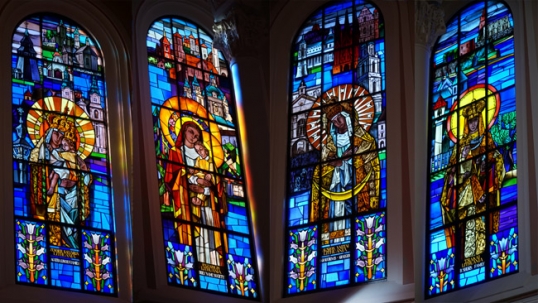

Lithuanian-cities-inspired stained glass windows at the Nativity BVM Lithuanian church of Marquette Park
Also interesting are the two murals on the interior, painted by sister Mercedes Mickevičiūtė and Kazimieras Žoromskis. One of them is dedicated to Our Lady of Šiluva, which is the earliest church-recognized Maryan vision in Europe. The artistic level and importance of the Nativity BVM church could be seen from the fact that three of the Lithuanian-American artists who created its artworks have entire museums back in Lithuania dedicated to their work (Kazimieras Žoromskis, V. K. Jonynas, and Kazys Varnelis).
Among Marquette Park's key Lithuanian symbols is Chicago's largest Darius and Girėnas memorial. The unveiling of this art deco sculpture in 1935 was attended by 60 000 people. The anniversaries of their "glorious but doomed" flight are still celebrated annually there, even if drawing only 100 people. By the way, S. Darius, a lover of sport and an Olympic participant, is also credited for writing one of the first books on basketball in Lithuanian (in 1922), making foundations for this American invention to become Lithuania's national sport.
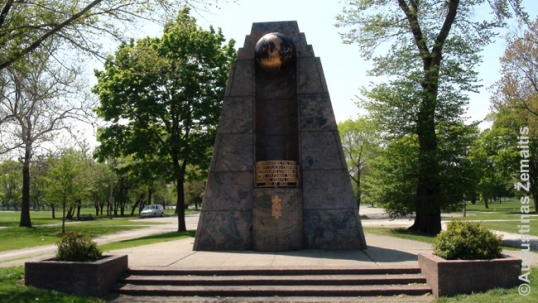

Darius and Girėnas memorial in Marquette Park


Darius and Girėnas memorial in Marquette Park
The Marquette Park district itself, however, is now populated by Blacks who started moving in in the 1960s-1970s, displacing the Lithuanians. For the Blacks, Marquette Park was simple a white district that could be targeted in their civil rights movement as a symbol of segregation in Chicago. As such, hundreds of Blacks came to live in tents in the Marquette Park itself in 1966. The crime rates have risen significantly, the property values declined. A conflict between the "old inhabitants" (Lithuanians and other whites) and the "new arrivals" (Blacks) took place. Both sides were supported by their racial compatriots from elsewhere, who, at times with racist ideas, would descend on the area just to fight what they saw to be a "racial war". Unlike for other whites, however, for Lithuanians, this was a matter of their own survival: it was their only district, and, losing it, they would have lost the only area in the USA where you can still speak Lithuanian as the main language. For Blacks, this was simply a matter of destroying segregation by coming to live at the historically white districts and they did not differentiate among different white ethnicities despite the fact that there have been no known Lithuanian-American slaveowners in the entire US history.
Eventually, Lithuanians have lost, and more and more of them chose to sell their Marquette Park properties at a big loss and retreat to the suburbs, taking part in the "white flight". They would never create another truly Lithuanian district in Chicago again and this likely contributed greatly to the decline of the Lithuanian culture in Chicago. It is difficult to say that Black civil rights activists have won either, however, as their only achievement was moving the "frontline of segregation" westwards, turning Marquette Park from a Lithuanian district into a ghetto. Still, in 2016, a Memorial to Martin Luther King has been built in the north of the park, where just the Black-side of the story is presented through the call to "destroy the ghetto walls". In an attempt to show the multicultural history of the district, the word "Home" is written in different languages on one of the memorial columns, with the Lithuanian word "Namai" written on the top.


Martin Luther King memorial in Marquette Park
Some Marquette Park buildings are now abandoned, but in Lithuanian Plaza Avenue (named so in 1970) you may still see crumbling Lithuania-inspired tricolor and Vytis decor and some Lithuanian names at the now-empty former businesses: "Antano kampas", "Gintaras Club" (the latter of which is sung about in a 1990s song by the famous Lithuanian singer-songwriter Vytautas Kernagis who had a gig there), "Lithuanian Plaza Bakery", "Plaza Pub" (the later two having Lithuanian decor).



Plaza Pub sign
In the 1990s, the Lithuanity of the Marquette Park was temporarily rejuvenated by new immigrants from Lithuania who found it both cheap and appropriate to live in the historic Lithuanian district and had no prejudices about living among Blacks. However, after noticing how unsafe the district is, most of them left once they earned more money and the last remaining Lithuanian restaurants closed in the 2000s-2010s. Even this was already only a shadow of the original community which had many businesses, and cultural institutions in an extensive area between 63rd st., 73rd st., Western Avenue, and California Avenue.
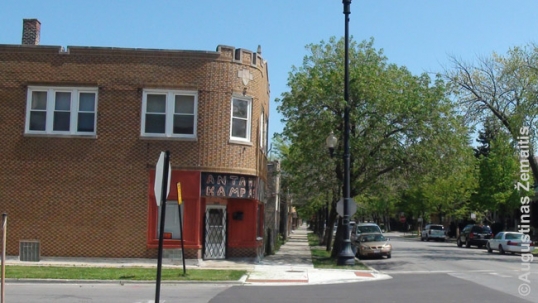

Antano kampas in Lithuanian Plaza that used to be owned by a post-1990 Lithuanian immigrant. Now closed.
Marquette Park district still boasts a majestic – the Sisters of St. Casimir Motherhouse (convent) The construction began in 1909. Over the years, there were more additions, the most recent took place in 1972. The Sisters of St. Casimir maintain a strong relationship with the Sisters of St. Casimir in Lithuania, also founded by Venerable Maria Kaupas in 1920.
Near the entrance of the Motherhouse, on the first floor there is a rather modern Museum – the Legacy Rooms of the Sisters of St. Casimir (est. in 2018) that tells the story of the founding of the Lithuanian-American congregation of the Sisters of St. Casimir and their foundress Venerable Maria Kaupas (1880-1940, an immigrant from Ramygala, Lithuania). The Legacy rooms are open daily, Monday through Friday, 9 a.m. to 5 p.m.
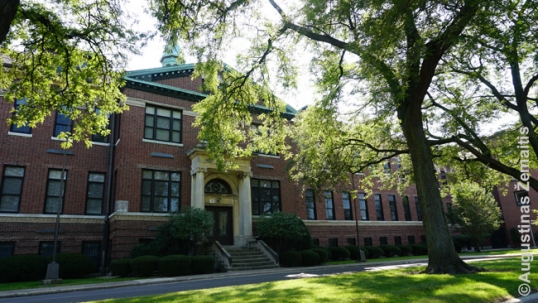

Sisters of St. Casimir Convent


Legacy rooms of the Sisters of St. Casimir Convent
In the first half of the 20th century, the Sisters of St. Casimir staffed many parish schools, hospitals, and senior homes in many parts of the United States (predominantly in Illinois and Pennsylvania).
There were almost 500 Sisters of St. Casimir in the 1950s. Today, there are 49.
As the number of Sisters declined, the Sisters of St. Casimir have entrusted the responsibility of their ministry and charism to dedicated laypersons.
Back in the first half of the 20th century, St. Casimir sisters used to staff the Lithuanian parish schools, hospitals, senior homes all over America. As the welfare state expanded, however, and the American public institutions took over these duties, the secular need for the Sisters declined and so did their congregation, going down from ~600 nuns to just ~50 in 2018, with the youngest one at 65.
The nearby (former) Nativity BVM Catholic grade school (with a surviving Lithuanian cornerstone) was staffed by the Sisters of St. Casimir and Holy Cross Hospital (Lithuanian-language plaque near the emergency entrance with 1928 date), originally established by the Lithuanian Roman Catholic Charities, was from the beginning administered and staffed by the Sisters of St. Casimir. Many Lithuanians were served by the Sisters at the school and hospital.
The Motherhouse (building) was transferred to Catholic Charities of the Archdiocese of Chicago in 2015. The Sisters of St. Casimir maintain their administrative office on the second floor of the St Casimir Center (as it is now called) and several Sisters reside there.


Nativity BVM Lithuanian school


Holy Cross Hospital in Marquette Park
Another impressive sight in this historic Motherhouse is its baroque-style chapel. There are beautiful stained glassed windows in the chapel installed in the 1920s. Mass is celebrated daily in the chapel, and all are welcome to attend. At the entrance of the chapel is the sarcophagus containing the remains of Venerable Maria Kaupas, whose cause for Beatification is currently being reviewed at the Vatican. A monthly Mass praying for her Beatification is held the first Saturday of each month. In 2000, Mother Maria Kaupas was declared Venerable. Hopefully, she may one day be Saint Maria Kaupas.
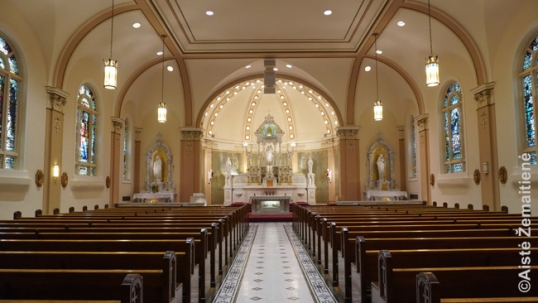

Chapel of the St. Casimir Sisters Convent


Marija Kaupas sarcophagus at the St. Casimir Sisters convent
Outside the Motherhouse, there are several noteworthy statues. There is a large statue of Father Antanas Staniukynas (1865-1918) on Marquette Road side of the building with a Lithuanian inscription: “Jis mirė, bet jo darbai gyvena“ (He died but his work lives on). In 1905, Father Antanas Staniukynas accepted the responsibility of assisting the new Congregation, the Sisters of St Casimir. He was a spiritual director, educator, and solicitor of vocations and funds. On the Washtenaw Avenue side of the Motherhouse, in the garden, there is a statue of St Casimir erected in 1957. A neighboring street is called "Honorary Maria Kaupas road" after Marija Kaupas.
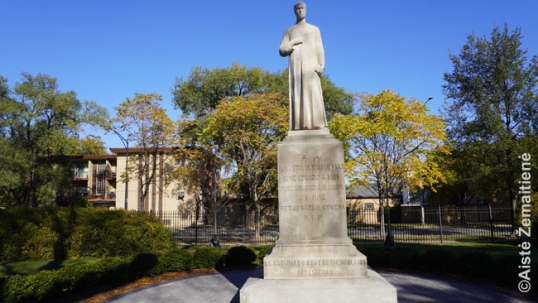

Priest Staniukynas statue near the Sisters of St. Casimir Convent


St. Casimir statue at the Sisters of St. Casimir Convent
Yet another still-surviving (albeit barely) hub of Lithuanity in the Marquette Park district is "Seklyčia" on 71st street. Historically it was the hub of Lithuanian-Americans' effort to help Lithuania. When Lithuania was fighting for its independence ~1990, Lithuanian-Americans informed the American media about that fight from here. Later, as Lithuania was poor, efforts to bring Lithuanian children-in-need for surgeries in America, as well as material support for Lithuanian orphans and elderly partisans were organized from there. There used to be a restaurant here until 2011 and a district security hub until 2018 while today the building is still owned by Lithuanian-American Community but the activities are now low-scale (weekly meetings of elderly Lithuanians of the district, for example). There is no external sign on the building either anymore.
West Lawn Lithuanian institutions - Balzekas Museum, Draugas
West Lawn districts immediately to the West of the Marquette park house two of Chicago's most important Lithuanian institutions. Balzekas Museum of Lithuanian Culture established in 1966 is the largest such institution outside Lithuania. It has been located in its current place (South Pulaski Rd. 6500) since 1986.
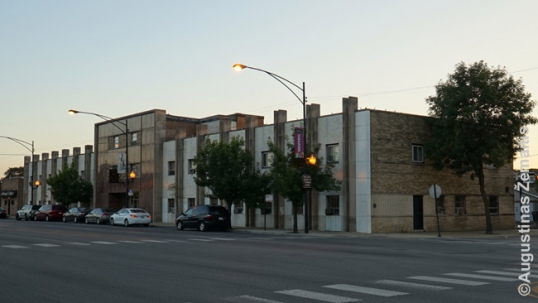

Balzekas Lithuanian museum of Chicago
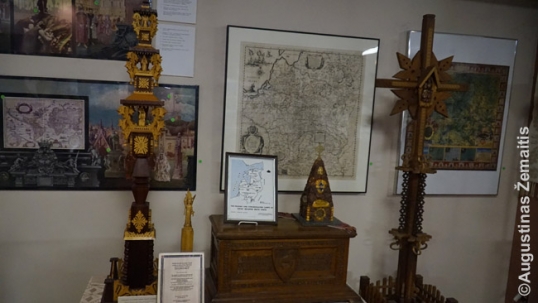

Exhibits of the Balzekas Lithuanian museum of Chicago
The museum has three floors, with a general exhibition of Lithuania available on the first floor, the second floor houses a hall for temporary events, and the third floor hosts temporary exhibits. The first-floor permanent exhibition includes many pieces of the Lithuanian culture and history, as well as of that of Lithuanian-Americans and their strive to get established in the new land as well as help their (former?) homeland both economically and (especially) politically: first, so that Lithuania would become free in 1918 and then recognized by the USA, and then so that its occupation (1940-1990) would end. It is useful to read some basic Lithuanian history (for example, here) before visiting the museum to grasp the meaning of the exhibits, although they are labeled in English.


Exhibits of the Balzekas Lithuanian museum of Chicago
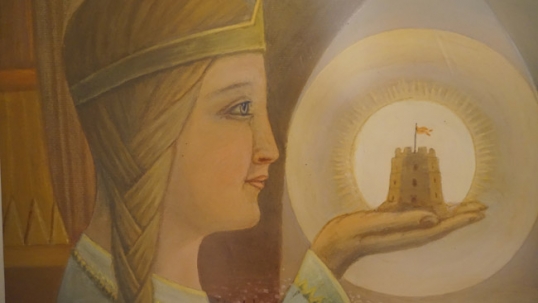

A painting exhibited at Balzekas museum - a woman carrying the Tower of Gediminas of Vilnius
The museum has been established by Stanley Balzekas, a son of Lithuanian immigrants, who wanted it to become a bridge between Lithuanians and Americans, to have more contact with the American community as a whole than many other Lithuanian institutions had. Balzekas being a businessman and avid collector, managed to collect a significant number of items and attract wider attention to his museum, especially in the 1990s when Lithuania was in the world news as a newly-independent country. Balzekas museum also helps foster Lithuanian-American relations through organizing annual tours to Lithuania for Lithuanian descendants. The nearby portion of Pulaski road even received an honorary name of Stanley Balzekas Way in his honor.
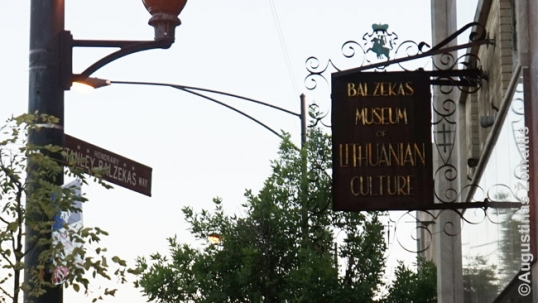

Balzekas Lithuanian museum in Chicago entrance with the plaque of Stanley Balzekas Way
Not too far away from Balzekas Museum, the "Draugas" ("Friend") publishing house building is home to the oldest continuously published Lithuanian language newspaper (first edition in 1909). Aimed at Lithuanian Americans it used to be daily until 2011 and now is issued three times a week with circulation went down to a third of what it was in the 1960s (down from 7000 to 2000), some 60% of the readers located in Chicago but many reading it all over the USA. Now "Draugas" also publishes its own English-language monthly "Draugas News" and also sells Lithuanian books at its publishing house. The publishing house is spacious as it dates to another era when a "small village of people" was needed to publish and print a single edition of the newspaper. With the advent of computers and the outsourcing of printing, an atmosphere of empty-ish 1950s office prevails inside, with the Lithuanian spirit all around.


Draugas publishing house
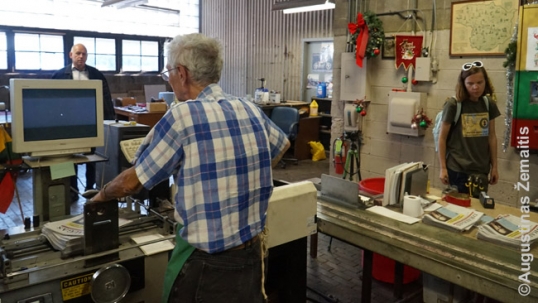

Draugas publishing house (a new edition is sent to the subscribers)
"Draugas" has been established by the Marian Fathers who were based in the Marian Fathers monastery nearby and worked for free for the newspaper. Designed by Jonas Kova-Kovalskis, the monastery follows the "modern Lithuanian" style with a tower that reminds a traditional Lithuanian chapel-post (koplytstulpis). While the Marian Fathers community has been effectively reestablished by a Lithuanian priest Blessed Jurgis Matulaitis, ultimately few Lithuanians joined it in America and now the community is dominated by Polish priests. They no longer use the monastery, renting it to various weekend retreats instead. Lithuanian Marian Fathers now work in Lithuania alone.


Lithuanian Marian Fathers monastery of Chicago
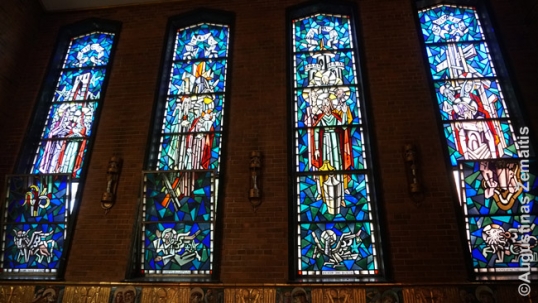

Lithuanian Marian Fathers monastery of Chicago interior
In Burbank suburb not far away from the West Lawn, a new Lithuanian institution has been created in 2018: the Lithuanian-American Hall of Fame, where famous Lithuanian-Americans are being inscribed. It will be a hall used for various Lithuanian events as well as accessible to the public.


Lithuanian-American Hall of Fame
Lithuanian Jesuit Youth center - museums, gallery, and archives
Another massive key Lithuanian hub in Chicago is Lithuanian Jesuit Youth Center (5620 S Claremont Avenue, ~3 km north of the Marquette Park), officially now known as just the Lithuanian Center. This is yet another Cold War-era institution (built 1958) funded by the Lithuanian diaspora desperately trying to help their culture survive for the generations to come (even as a minority). Lithuania-themed activities/education for children and teenagers had been its goal.



Lithuanian Youth center facade with Vytis and the memorial to those who died for Lithuanian freedom in front
The massive building complex uses patriotic architecture with a large modernized Vytis forming its façade. In its yard, stands the Memorial for those who died for Lithuanian freedom that includes all the traditional Lithuanian symbols: the Cross of Vytis, the Columns of Gediminas, and Vytis itself. It has been constructed by the famous architect Jonas Mulokas in 1959 and originally had more inscriptions. Next to it, there is a traditional Lithuanian chapel-post (koplytstulpis) dedicated to Jesuit priest Jonas Raibužis (donated by scouts) and Cross dedicated to Kražiai massacre victims donated by Paskočimas family. Kražiai massacre was an 1893 event when Russian soldiers have murdered Lithuanian civilians who tried to protect their church from destruction. This event attracted worldwide attention to the Russian Orthodox anti-Catholic discrimination in Lithuania. At the time the cross was constructed, the anti-Catholic discrimination by the Russians resurfaced in Lithuania once again, this time in the name of communism. Thus there is an inscription on the cross that in 1976, during an anti-Soviet protest, students read the Chronicles of Catholic Church (an underground newspaper that documented the human rights violations in Lithuania) for 40 hours in a row.


Lithuanian cross dedicated to the victims of Kražiai massacre


Lithuanian girl scouts' chapel-post (koplytstulpis)
While Lithuania was occupied by the Soviet Union and religion was persecuted there, Lithuanian Jesuit province was effectively based here in Chicago and part of the building is Jesuit monastery. Currently, there are no longer any priests or monks living there as the Jesuit activities have been relocated back to Lithuania. Still, the monastery chapel still offers holy mass once a month. The exterior of the monastery chapel includes a bas-relief "Jesuits come to Vilnius in 1569", also the Lithuanian Coat of Arms.
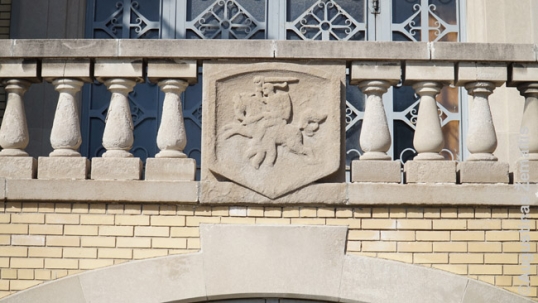

Lithuanian coat of arms on the Lithuanian Jesuit chapel
The Youth Center houses a multitude of other Lithuanian institutions, amalgamated in 1981 to form the Lithuanian Research and Studies Center, which is the largest Lithuanian scholarly organization outside of Lithuania. It includes the World Lithuanian Archives and numerous other related archives (musicology, medicine, photo, audio-visual, fine art), which are the best repository of Lithuanian-American works but also include works by other Lithuanians.
Like many such top-level Lithuanian-American institutions, the Research and Study Center expands its repositories through donations and legacies, often by old Lithuanians who have no Lithuanian-speaking descendants. With many donations, even the quite massive premises of the Youth Center became too small for LRSC, and so the LSRC has acquired a new LRSC building in Lemont in 2018.
The scholarly wing of LRSC (responsible for studies, education, and publishing) consists of the Institute of Lithuanian Studies, Center for the Study of Genocide in Lithuania and Lithuanian Institute of Education.
Furthermore, the Lithuanian Research and Studies Center owns three museums: Ramovėnai Lithuanian Military Museum, Lithuanian Museum and the Lithuanian Museum of Medicine. All may be visited during the workdays although it is better to contact in advance.


Badges of the old Lithuanian-American brotherhoods in the Lithuanian Youth Center museum
Key sections in the museums include:
*Miniature versions of Lithuanian traditional wooden crosses (UNESCO World Heritage).
*Things that belonged to the Lithuanian anti-Soviet partisans (uniforms, flags, etc.) and information related to that war that was the longest guerilla war in 20th century Europe [the Ramovėnai Lithuanian Military Museum].
*Lithuanian postal stamps.
*Historic Lithuanian banknotes.
*Stamps of the post-WW2 Lithuanian refugee organizations in Germany.
*Pendants of the early 20th century Lithuanian organizations.
*Inventory used by the Lithuanian doctors of Chicago in the mid-20th century [the Museum of Medicine].


Traditional Lithuanian metal crosses in the Lithuanian Youth Center museums
There are also two non-LTRSC affiliated institutions in the Youth Center, namely the Lithuanian Saturday school and the Čiurlionis art gallery that offers temporary exhibitions of the works of Lithuanian artists. The Main hall of the Youth center offers Lithuanian events, although they have grown rarer and rarer as the Lithuanians have left the neighborhood.
Lithuanian Lutheran churches of Chicago
While today the Lithuanian nation is predominantly Catholic, prior to World War 2 up to 15% of ethnic Lithuanians were Lutheran (9% in Lithuania itself). These people hailed from Lithuania Minor region of what was then Germany. Tragically, in Lithuania, they were wiped off almost completely by the Soviets in the Genocide of Lithuania Minor (1944-1949).
However, two large groups of Lithuanian Lutherans managed to emigrate, establishing two Lithuanian Lutheran parishes in Chicago. Unlike the Catholic parishes, Lutheran parishes did not hesitate to "migrate" together with their congregations after their districts were hit with white flight, so, both are now located in the suburbs where most Lithuanians live. Both Lutheran church buildings are rather small and function is accentuated over beauty, with many non-religious premised available inside.
Zion Lithuanian Lutheran church is the older one, dating to 1910 when it has been established by Martynas Keturakaitis, a priest from Tauragė. It has its own building in Oak Lawn suburb that includes church hall and Lithuanian kindergarten. The building has been acquired from another Protestant community in 1973 when the parish relocated to this suburb from Chicago. As such, the building itself has no Lithuanian details but the interior has many Lithuanian memorabilia. Also, Lithuanians have extended the building in 1983 in order to have a larger secular hall.


Zion Lithuanian Lutheran church


Zion Lithuanian Lutheran church (priest images)
The initial congregation of the Zion Lutheran church itself has been greatly expanded ~1950 when Chicago's Lutherans wrote over 800 letters of invitation to many Lithuanian Lutheran refugees who were stranded in refugee camps in Europe. However, a rift soon became apparent between the "old Lithuanian-Americans" of the Zion parish and the post-WW2 refugees: for the pre-WW1 Lithuanian-Americans, the USA was already more or less the homeland, and the Zion parish had aligned itself with the US Lutheran church of the Missouri Synod. The post-WW2 immigrants, however, often saw their lives in the USA as a temporary exile and saw the need to safeguard as much of the Lithuanian traditions as possible, as well as separate from the US society more in order to safeguard Lithuanians as a separate group.
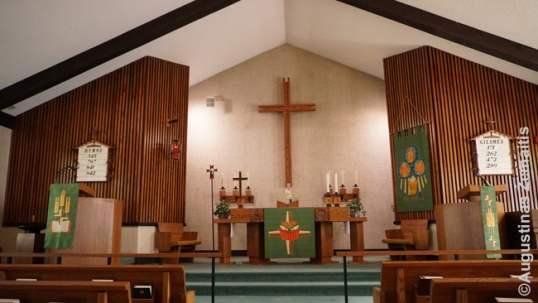

Zion Lithuanian Lutheran church (main hall)
After the calls by post-WW2 refugee priest Trakis to severe the Zion Lutheran church relations with the US Lutheran Church (Missouri Synod) were not recognized by the "old Lithuanian-Americans", Trakis created a separate Lithuanian Lutheran parish known as Tėviškė ("The Homeland"). Initially, this parish has been located in the Lithuanian Lutheran church building near Marquette park that was acquired from Jews in the 1950s and sold to Black-dominated Heart Church Ministries church in the 2000s as the district has changed (nothing reminds the Lutheran church in the building now). Since then, Tėviškė Lutheran church rents its premises in Darien (St. John Lutheran church). However, even though the premises are rented, Lithuanian-inspired welcome signs have been built and some Lithuanian memorabilia is kept inside.
Tėviškė parish continues to be the more "ethnic" one among the two Chicago Lithuanian parishes: for example, Tėviškė has solely Lithuanian services while Zion parish also offers English services and conducts its Bible study in English. For some five decades 1950-2000s, Zion parish also offered German services for the Germanized Lithuanians of Lithuania Minor who spoke better German than Lithuanian, however, as their ranks became scarce, the German service has been canceled by the mid-2000s. When the entire Zion congregation sings hymns together, each person is permitted to choose his own language (English, Lithuanian or German) still. Another difference between the two parishes is the burial places: while Tėviškė members are usually buried in the Lithuanian National Cemetery, Zion members are often buried in the common American cemeteries.
However, both parishes have helped Lithuania after independence, promote Lithuanian activities, and have attracted priests from Lithuania itself after Lithuania became independent and both have aligned with the Lithuanian Lutheran church. That said, Tėviškė parish is aligned only to the Lithuanian Lutheran church whereas Zion church also keeps its alignment to the Missouri Synod while the Lithuanian-Lutheran alignment is mostly a spiritual one.
Pilsen Lithuanian heritage
Back in the 1920s, Chicago had 12 Lithuanian Catholic parishes, each of them centering a Lithuanian community. One of the Chicago districts - Pilsen (north of Bridgeport) - even had two Lithuanian churches at once.
The Romance Revival church of Providence of God (1927) is the closest Lithuanian church to downtown (since the 1960s, the district population was replaced by Hispanics and the events there are now Spanish). It has been founded by St. George parishioners from Bridgeport. The rather grand interior includes authentic stained-glass windows and stations with the cross with Lithuanian inscriptions. The access is limited though as there is no regular mass. On the outside, next to a Lithuanian cornerstone there is another stone commemorating the fact that Providence of God was the sole Lithuanian church in Chicago to have Pope visiting it. This happened in 1979.
Next to the church stands the former Lithuanian school with a cornerstone indicating its original purpose.


Providence of God Lithuanian church (right) and school (left)


Providence of God Lithuanian church


Lithuanian stations of the cross at the Providence of God church
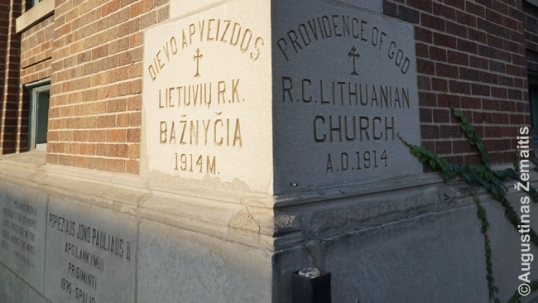

Cornerstone of the Providence of God Lithuanian church
Pilsen's 2nd Lithuanian church was a more modest Our Lady of Vilna church and school (2327 W 23rd Place), now closed. The two-floored residential-like building used to host the church on the main floor and a parish school above it. The building was intended to be primarily a school, with the church temporarily located there before a bigger building is built (which never happened); that is why all the available inscriptions declare its school purpose ("Lithuanian Catholic school" above the entrance, "Lietuviška mokslaini Vilniaus Austros Vartu Š. M. P. Parakvijes", which in old Lithuanian language means "Lithuanian school of Our Lady of Gate of Dawn"). 1906 is inscribed as the date the construction began. After the parish has been closed, the parish name remained only in the relocated St Paul-Our Lady of Vilna school (closed 2013). Chicago Sun-Times reported an interesting story in 2013 of scrapyard workers noticing Lithuanian inscription on a bell and the diocese requiring it. It turns out this bell has disappeared from Our Lady of Vilna site after closure; it will now call the residents of Tinley Park suburb to prayer, thus itself completing a migration that so many did before: from the inner city to suburbs and from ethnic culture to "United American" culture. The inscription on the bell reads (reminding that Lithuania of the 1900s-1918s was still under the rule of Russian Empire and giving reasons why Lithuanians migrated to Chicago so eagerly): "Bell, little bell, sorrowfully ring and proclaim the Miraculous Madonna of the Gate of Dawn in Lithuania, where our enemies suppress us. Our oppressed fellow countrymen are comforted. Call us to prayer, to the Church, in her name, so that we may feel a part of God’s flock. Call us three times daily, without fail, and the deceased lead with your sound. From this day forward, speak to the living, and accompany the dead to the cemetery". Other sources indicate the bell was "held for ransom" and the diocese had to pay for their return. In Tinley Park, the bells are located in St. Julie church where they are visible in an open tower.



Our Lady of Vilnius church/school in the Heart of Italy district of Chicago
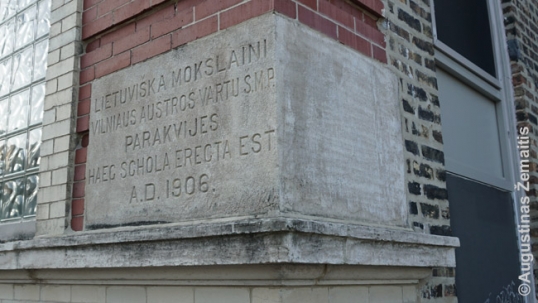

Our Lady of Vilnius church/school in the Heart of Italy district of Chicago (cornerstone)
Brighton Park Lithuanian church, school, monastery and Šauliai house
Brighton Park district west of former stockyards is now also largely Hispanic but its modernist Lithuanian Church of the Immaculate Conception of the Blessed Virgin Mary (built in 1964, 2745 W. 44th St.). It includes numerous Lithuanian details in its interior, among which the most striking are the Our Lady of Šiluva shrine in a side-chapel, Divine Mercy Shrine (based on the painting in Vilnius) in the other side-chapel, and the Our Lady of Šiluva stained-glass-window that is colored in the colors of the Lithuanian flag. The rest of the stained-glass windows also have Lithuanian donors written on them; the windows are not the traditional light European-style but rather they are made of large single-colored chunks of glass. Brighton Park Lithuanian church is the last -to-be-built among the Lithuanian-constructed churches of Chicago and the only one built after the Vatican II council which made the preferred church plans more open.
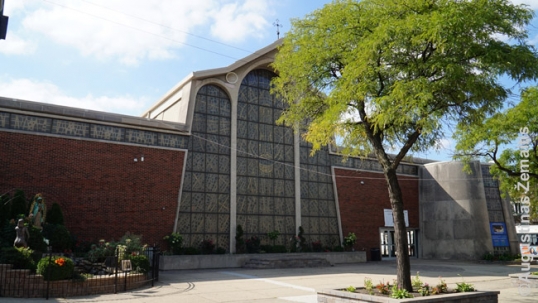

Brighton Park Lithuanian church of Immaculate Conception
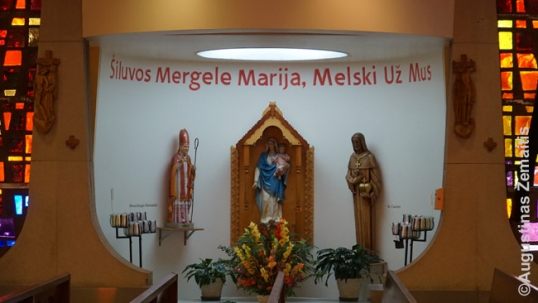

Our Lady of Šiluva side-chapel at the Brighton Park Lithuanian church of Immaculate Conception


Stained glass windows of the Brighton Park Lithuanian church of Immaculate Conception with the Our Lady of Šiluva tricolor window on the right
The parish dates to 1914 but like some other churches, this one was built post-WW2 to accommodate a major influx of Lithuanian refugees. An entire complex of buildings served them, including the Lithuanian school (built 1915, closed 1999) and Lithuanian convent (1925), both of which have their Lithuanian purpose inscribed on their facades (in English and Lithuanian) despite no longer being used for that purpose. Since the 1980s, the parish lost its Lithuanian majority, now being mostly Hispanic. Most of the masses are celebrated in Spanish although some are Lithuanian; Hispanic details (Our Lady of Guadalupe) have also been added to the church.


Brighton Park Lithuanian school cornerstone
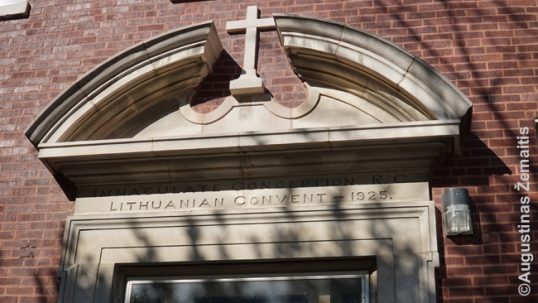

Entrance to the Brighton Park Lithuanian convent
Still, Lithuanian details outnumber them. At the entrance of the church, a traditional Lithuanian cross stands built in 1987 in commemoration of the 600th anniversary of Christianity in Lithuania. It incorporates a Lithuanian coat of arms in its design.
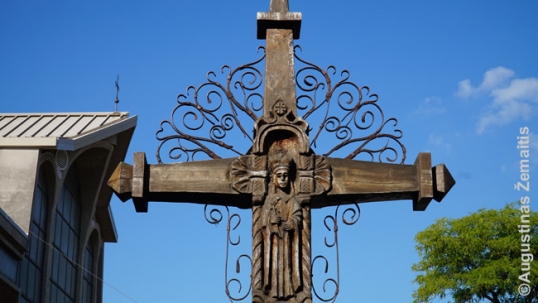

Brighton Park Lithuanian cross
On the W 43rd (near S Western Ave) stands a small building associated with the Lithuanian Rifleman Union (Šaulių sąjunga) known as the Šauliai House, its facade adorned in Lithuanian patriotic symbols since it has been acquired by the organization in 1975. Šauliai, variously translated as "Lithuanian Riflemen" or "Lithuanian National Guard", is a patriotic paramilitary organization that used to be especially important in interwar Lithuania and then banned by Soviets (its members persecuted or killed). Like was the case with many such organizations, the survivors who fled Lithuania continued its existence in the USA. After independence Rifleman Union was reestablished in Lithuania as well but it didn't reach the pre-war glory. In America, Šauliai withered over time as the original refugees died off and their children mostly did not join the organization. After independence, however, some new Šauliai from Lithuanian moved in or new immigrants decided to join the organization. In 2005, Šauliai House was acquired by one such recent immigrant who later joined Šauliai himself. It is now not only used for Šauliai meetings but also as a rental hall. The organization is much different today from what it was: it had some 1000 members once but just some 20 these days.


Šauliai House of Chicago at Brighton Park
Brighton Park also had a Darius-Girėnas American Legion post 271, comprised mostly of ethnic Lithuanians. The post has sold its rather large building (corner of W 44th and S Western Ave) that once hosted many Lithuanian events and now meets at various locations. The post's former building is used as the "Way church".
Cicero Lithuanian heritage
Further west from the downtown Cicero has a massive St. Anthony Lithuanian church. Lithuanian, English and Spanish mass is now offered.



Cicero St. Anthony Lithuanian school and church
The Romanesque Revival church has been constructed in the interwar period and blessed by the Blessed Jurgis Matulaitis, holding the distinction of being a rare (or only) Chicago church dedicated by a person who was given the status of Blessed. The massive interior holds a side-altar dedicated to Matulaitis, a Matulaitis stained-glass window (on the right near the roof). There is also a stained-glass window with Vytis, the coat of arms of Lithuania (left side near the roof) donated by the Knights of Lithuania, a Lithuanian chapel-post and many Lithuanian inscriptions (under each old station of the cross, over the Virgin Mary statue). The cornerstone lists the 1925 date.



Cicero St. Anthony Lithuanian church


Cicero St. Anthony Lithuanian church (interior)


Lithuanian-inscribed station of the cross at the Cicero St. Anthony Lithuanian church
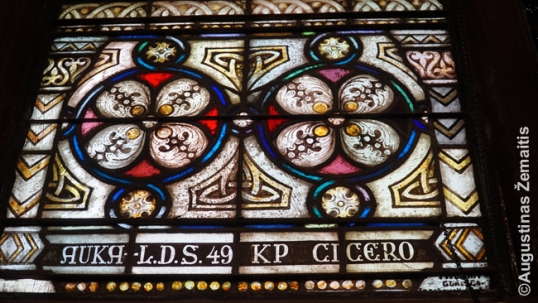

Stained glass windows with the Lithuanian surnames of the donors at the Cicero St. Anthony Lithuanian church
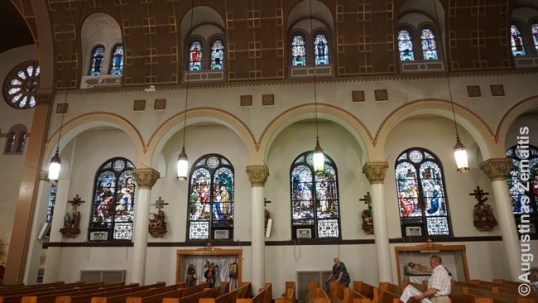

Cicero St. Anthony Lithuanian church (interior)
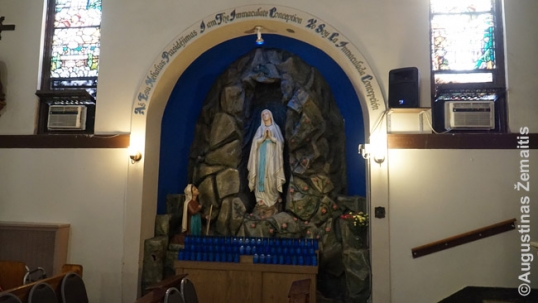

Cicero St. Anthony Lithuanian church (interior)
In front of the church stands a unique plastic chapel-post, donated by Msgr. Albavičius and built by a famous Lithuanian-American architect Jonas Mulokas to commemorate the 50th anniversary of Lithuanian independence in 1698 (which was a sad date, actually, as Lithuania was then under "deep" and seemingly invincible Soviet occupation). Lithuanian chapel-posts are a UNESCO-recognized form of ethnic art, however, they are traditionally wooden. Yet in this case, a former 1950 Lithuanian wooden cross that stood on-site has been destroyed by parasites, prompting the parish to request a "more eternal" plastic sculpture in its place. The church itself has been also expanded during the 50s, adding the front extension in historicist style.


Plastic chapel-post by Jonas Mulokas at the Cicero St. Anthony Lithuanian church with the Mulokas chapel-post
Next to the church stands unusually massive St. Anthony Lithuanian school which has its Lithuanian name chiseled in large letters above the entrance. Both buildings look especially impressive from the intersection of S 49th and 15th streets.


Cicero St. Anthony Lithuanian school
The third building with Lithuania-related inscriptions in the area is the Lithuanian Liberty Hall (Lietuvių laisvės salė, 1921), often associated with communists. Once, Lithuanian communists were quite a significant part of the Cicero Lithuanian community, so much so that they held regular protests against the church construction while it was under construction (something that was later banned by courts). While the "Liberty Hall" has been used into the 1960s after the Soviet occupation showed the "real face of communism" the communist ranks among Lithuanians declined to a small minority, so the Hall was sold and is now partly abandoned.



Lithuanian Liberty Hall of Cicero
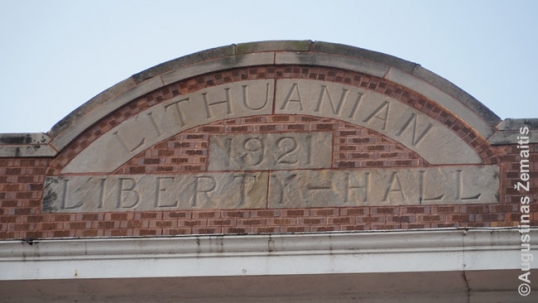

Lithuanian Liberty Hall of Cicero
There is also a building on the 15th street with letters "P. JUKNIS 1912" written near its top, eternalizing its Lithuanian builder. Once, many local buildings had Lithuanian owners, there were as many as 10 Lithuanian pubs alone in the area. Currently, however, Cicero is predominantly Hispanic but it has not gained such a bad reputation as South Chicago so some Lithuanians still live in the district, attending the church.


P. Juknis building
Chicago far southside Lithuanian heritage
The Chicago districts further south have smaller Lithuanian communities and smaller churches than those cathedral-like edifices closer to the downtown - however, some of these churches have interesting architecture and histories. Those areas are currently nearly completely inhabited by Blacks. The small Lithuanian districts there all collapsed very early and very quickly (most churches closed ~1970s-1980s after most Lithuanians left and other institutions, e.g. Lithuanian schools, have been closed even earlier).
The most interesting there is All Saints Lithuanian church in Roseland (0,42% White district today) with a semi-open metal tower that has been inspired by traditional Lithuanian chapel-posts as well as, arguably, art nouveau. It has been designed by a famous Lithuanian interwar modernist architect S. Kudokas who, like many other architects and many additional members of the congregation, fled Lithuania to avoid being murdered by the Soviets. Kudokas was a modernist in Lithuania, responsible for many significant buildings in the interwar Kaunas which now has a UNESCO World Heritage application. After arrival in America, Kudokas criticized his colleague Jonas Mulokas who attempted to create a modern ethnic Lithuanian style in place of international functionalism. In his All Saints church, though, Kudokas himself has emulated Mulokas's style in creating a "non-wooden chapel-post" on the tower. The history of the All Saints church illustrates the history of the entire South Chicago: the parish has constructed this new church in 1960, still expecting a long existence and growth. Then, however, the white flight took place and by 1972 already the Lithuanian parish was closed. It has been sold to the Baptists in 1989 (a more popular faith among Blacks than Catholicism). The Lithuanian details, ethnic art remains, although the Lithuanian name above the door of the church has been covered. The survival of the church still is not easy at it has been robbed numerous times recently.



Roseland All Saints Lithuanian church
South Chicago area is only 1,92% White. Its small single-floored St. Joseph Lithuanian church (8801 S Saginaw) has been closed in 1986, became part of McKinley public school (itself built in 1953 as parish school) that is now closed. A former priest's house stands next, it is older and more interesting; the priest Antanas Petraitis was interested in science and had Illinois's second largest telescope there and also had a small animal sanctuary between the buildings. Some say the church remained so small because of the priest investing much to the science.
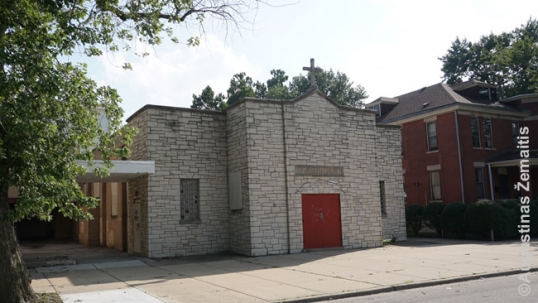

St. Joseph Lithuanian church
St. Casimir Lithuanian church of Chicago Heights (283 E 14th Street) suffered a similar fate (closed 1987). It looks like a century-old residential. Its two floors used to house a school as well as a church. Such practice was very common in Chicago, whereby a parish would have constructed such a "regular building" first that would have included its all activities and, having collected more donations, would have constructed a "true church" nearby, leaving the old building to the likely-now-expanded school. St. Casimir of Chicago Heights, however, never got to build the second building as it withered and died with Lithuanians moving elsewhere. Just like on Holy Cross the former fashion to inscribe institution names on stone led to the survival of its Lithuanian name. Empty lots are now all around the building.
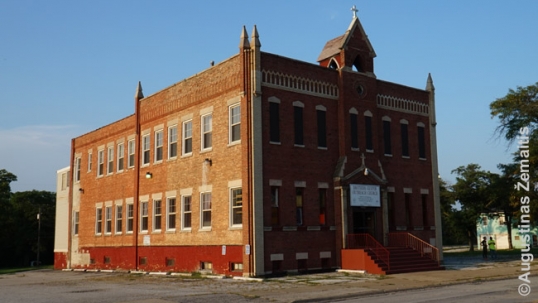

Chicago Heights Lithuanian church


Chicago Heights Lithuanian church cornerstone
The final area's Lithuanian church to remain in Catholic use was St. Peter and Paul church in West Pullman (12433 S Halsted St) but it closed too in 2022. The building is modernist with some gothic inspirations (built 1959). The parish has been established in 1913 and celebrated its centenary in 2013 but it had little to do with Lithuanians by then. Unlike in Roseland (All Saints), the West Pullman church was constructed at the time some parishioners were already non-Lithuanian, so it has few Lithuanian details (the only Lithuanian details that still existed by 2017 were the historical images and newspaper clippings near the entrance that remind of the past Lithuanian priests, the cornerstone that mentions priest Petrauskas and the name of the church's hall that is named after the church's final Lithuanian priest Brinkis). West Pullman is only 0,56% White and the Lithuanian share is now negligible. Pullman was once famous for its world-class factory of railway carriages. Modern Far South Chicago, however, differs from that of 1900-1915 (when most Lithuanian parishes were established) like day and night. The industry collapsed ~1970, the ethnic groups are also all different.


Ss. Peter and Paul Lithuanian church of West Pullman


Ss. Peter and Paul Lithuanian church of West Pullman


Two pastor images at the Ss. Peter and Paul Lithuanian church - the first one of them is Lithuanian, and the second one is African American (after the change in the parish demography)
West Pullman also has the old Ss. Peter and Paul Lithuanian school-church surviving - there, a Lithuanian cornerstone says in the old Lithuanian language that it is a "mokslainė" (today school is called "mokykla"). The church is no longer Catholic.


Old Ss. Peter and Paul Lithuanian church of West Pullman which served as a school
Fpovilo
Lithuanian cemeteries in southern Chicago
Deceased Chicago Lithuanians used to be buried in Lithuanian cemeteries since well before World War 1. There are two cemeteries: the Catholic St. Casimir and the National which originally started as non-Catholic but today includes many Catholics as well. Both cemeteries are notable for great numbers of grand tombstones, hundreds of them crafted in the mid-20th century by a famous tomb creator Ramojus Mozoliauskas. These tombstones are sculpture-like and are often adorned in Lithuanian symbols as Lithuanians felt extremely sad about the loss of their homeland to the Soviets and thus used Lithuanian symbolism lots. There are even direct references to exile. Among the earlier tombstones it is interesting to see many surviving images of the deceased people, dating even to the pre-WW1 era, something that is far rarer in smaller towns, let alone Lithuania itself, where photography was still not that accessible back in those days.



Lithuanian coat of arms land art at the St. Casimir Lithuanian cemetery of Chicago
Both Lithuanian-American cemeteries in Chicago arguably are both prettier and more extensive than any other Lithuanian-American cemeteries and are well worth to walk around even for non-Lithuanians. Both have more famous Lithuanians buried there than are buried in many of the cemeteries in Lithuania itself.
St. Casimir Catholic Cemetery is the larger and older one, established in 1903 at the extreme south of Chicago. So great it is that it has been included in the "199 cemeteries to see before you die" book alongside such world-famous "giants" as Paris's Per-Lachese or Arlington Cemetery.


St. Casimir Lithuanian cemetery of Chicago
The entrance plaque "Lithuanian Cemetery" was removed in 1997. This is not the first such move - in 1965 Cardinal Cody removed the word "Lithuanian" from the cemetery's official name, leading to mass demonstrations of post-war Lithuanian refugees. This is one of many similar episodes in the history of Lithuanian Chicagoans. E.g. in 1972 local Lithuanians chartered a plane to Rome in order to protest in St. Peter square against the presenting of the first Holy Communion to Lithuanian children in the English language.
Latin Americans (today the largest Catholic community of Chicago) now have joined Lithuanians in the St. Casimir Cemetery rows. Yet the massive Lithuanian gravestones, built throughout eight previous decades, far outflank small American plaques. It seems that an entire major city is buried here and everywhere the surnames are Lithuanian, some of them shortened or spelled in English. Also, not far beyond the main entrance, there is a Lithuanian coat of arms land art that still firmly marks the cemetery as Lithuanian. On the northeastern corner of the cemetery, there is also a Memorial for the 12 Lithuanian parishes of Chicago which has established the cemetery (as of 2018, only 6 of their churches are operational as Catholic churches and only 3 still offer Lithuanian mass). The memorial includes traditional Lithuanian roof-horses, sun-cross, and an authentic bell of a Lithuanian church in its design.


Memorial of the 12 Lithuanian parishes that established the St. Casimir Lithuanian cemetery of Chicago
Among the famous Lithuanians interred in the St. Casimir cemetery are:
*Lithuanian general Povilas Plechavičius (1890-1973) who moved to the USA as a refugee in 1949. He is famous for being the leader of the 1926 coup that has established Smetona's regime and later for his successful sabotaging of Nazi German plans by disbanding the Lithuanian soldiers after he learned that Nazi Germany planned to raise a Lithuanian SS division out of them (therefore, thanks to Plechavičius, there was no Lithuanian SS division, while there were Latvian and Estonian SS divisions).


General Povilas Plechavičius grave
*Lithuanian geographer Kazys Pakštas (1893-1960), well-known for his ideas to create a "second Lithuania" by acquiring and colonizing some land in Africa or South America. He expressed these ideas because he saw that Lithuania itself is in constant danger while the Lithuanian emigrants assimilate into foreign cultures; so, he wanted to create a land where Lithuanian culture could exist more safely and not assimilate. In his days (between WW1 and WW2) his ideas were seen as utopian, however, in the same fashion as Nicola Tesla, Pakštas gained much more attention later when his predictions of the occupation of Lithuania and assimilation of the Lithuanian diaspora did indeed come true.
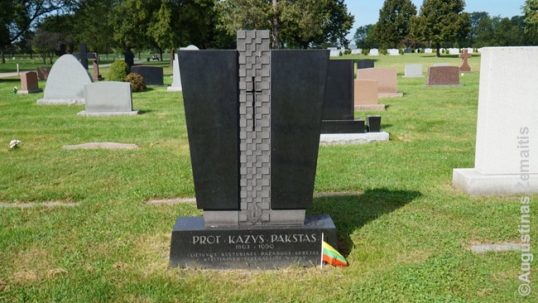

Kazys Pakštas grave
*Lithuanian-American poet Algimantas Mackus (1932-1964), notable for his existentialist poems. He is considered a part of the so-called "landless" generation of authors that began their creations outside Lithuania but still considered Lithuania their sole homeland, which made their works permeated with indescribable longing for something lost.
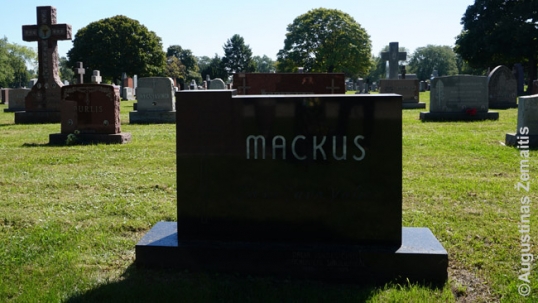

Poet Algimantas Mackus grave in the St. Casimir Lithuanian cemetery of Chicago
*Chicago-born Lithuanian archbishop Paul Marcinkus (1922-2006), who essentially served as a bodyguard for popes and saved the lives of two popes. He also served as the head of the Vatican bank, although his tenure there was marred in scandals. Even then he is said to have secretly come to his childhood Lithuanian church of St. Anthony in Cicero to hold mass there. Unlike many other graves in the cemetery, Marcinkus's grave is rather modest.
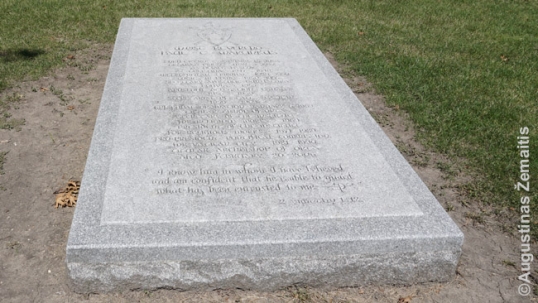

Archibishop Paul Marcinkus grave
*Antanas Vanagaitis (1890-1949), a Lithuanian musician who, after emigrating to the USA soon after World War 1, established a Lithuanian radio in Chicago and also created numerous famous Lithuanian songs.


Antanas Vanagaitis grave at St. Casimir Lithuanian cemetery of Chicago
Moreover, St. Casimir cemetery also became a major zone for important non-grave Lithuanian memorials. The most famous is the first-in-the-world memorial for Romas Kalanta that was built in 1979, the same decade as the young Kaunas guy self-immolated against the Soviet regime. The author was Ramojus Mozoliauskas and the donors were Riflemen (Šauliai) Union. The memorial is dedicated (in Lithuanian) to "Romas Kalanta and everyone who has died for Lithuanian freedom fighting the red tyrant" (i.e. the Soviet Union).


Romas Kalanta memorial at the St. Casimir Lithuanian cemetery of Chicago
In 1984, a memorial to Lithuania's sole saint (and patron saint) St. Casimir has been constructed, commemorating 500 years since his birth. The memorial has images of Vilnius, at the time beyond the Iron Curtain for the Lithuanian-Americans.
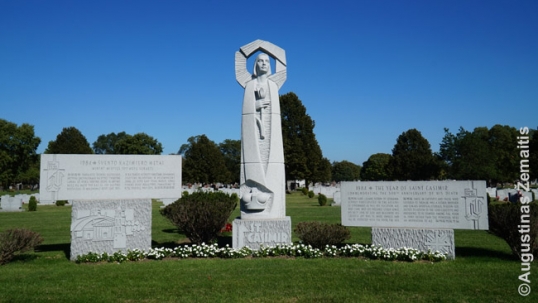

St. Casimir statue at the St. Casimir Lithuanian cemetery of Chicago
The cemetery also has a small memorial to Our Lady of Šiluva, Europe's first church-recognized Maryan vision (which happened in Lithuania).
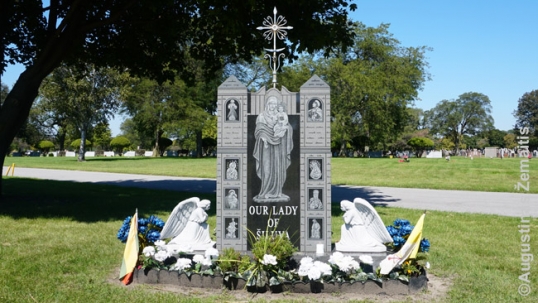

Our Lady of Šiluva monument in the St. Casimir Lithuanian cemetery of Chicago
On the north side of the cemetery, there are large burial plots and memorials for particular people and organizations. There is a field where Lithuanian priests of Chicago are buried, next to the burial area for St. Casimir sisters and Lithuanian Jesuit fathers, all of them having neat memorials. Next to them stands a Memorial for the Darius-Girėnas post of the American Legion, which is a unique ethnically-based Lithuanian post in what is an American veteran organization. The memorial incorporates pieces of artillery. Another Lithuanian American Legion post named after Don Varnas has built a smaller memorial nearby, while the impressive obelisk-like "gravestone" of priest Mykolas Krupavičius now also serves just as monument as Krupavičius himself has been reinterred in Lithuania after independence.


Lithuanian priests memorial at the end of a long field in the St. Casimir Lithuanian cemetery of Chicago wher ethe Lithuanian priests are buried


Jesuit Fathers memorial at the St. Casimir Lithuanian cemetery of Chicago
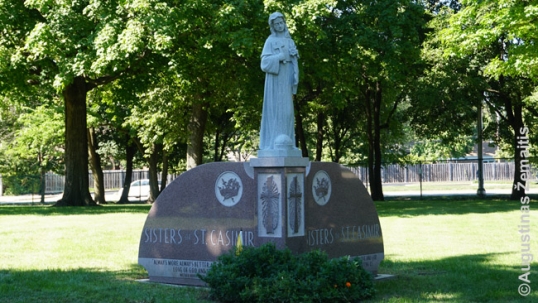

St. Casimir Sisters memorial and burial site
Another Lithuanian cemetery is next to a small forest outside the official borders of Chicago. This is the multi-denominational Lithuanian National Cemetery and the word "Lithuanian" remains in the official name. It was established in 1911 when a local priest refused to bury Lithuanians who did not actively participate in Lithuanian Catholic communities in the St. Casimir Cemetery.


Art-deco-styled office of the Lithuanian National Cemetery of Chicago
The Lithuanian National Cemetery is located at a rather secluded spot and has many trees, making it double as a nice Lithuanian park. Many of the gravestones there are especially ethnic in design as they have been constructed by those who fled the Soviet occupation and were especially patriotic. The cemetery is open every day from 8 AM to 5-6 PM.


An old grave with image of the deceased in the Lithuanian National Cemetery of Chicago


Grave images at the Lithuanian National Cemetery of Chicago
The National Cemetery starts with a pretty entrance square, surrounded by the cemetery gate, art-deco-styled cemetery office (some urns are kept inside the office) that had been built in 1938 and designed by a Lithuanian-American architect Žaldokas, as well as the memorial to the founders of the cemetery (14 Lithuanian non-Catholic organizations), erected in 1982. All the cemetery directors are listed on this memorial as well.


Monument to the founders of the Lithuanian National Cemetery of Chicago
There are some 13500 burials in the National Cemetery. Among those buried here are:
*The 1925-1926 President of Lithuania Kazys Grinius (actually, he was never interred under the monument built for him and his urn was repatriated to Lithuania in 1994)
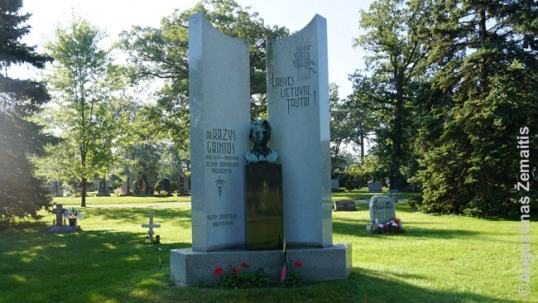

President of Lithuania Kazys Grinius monument
*Dr. Jonas Šliūpas, most famous in the USA as he agitated Lithuanians to separate from the Roman Catholic church, the idea that formed part of the drive to create ethnically-based cemeteries. He did, in fact, came back to Lithuania after the 1918 independence and served as a mayor of Palanga there; he died in Europe, but his body was still brought back to the USA where most of his major life works took place.


Jonas Šliūpas grave at the Lithuanian National Cemetery of Chicago
*Marius Katiliškis, a famous Lithuanian writer.
*Kazys Bobelis, a Lithuanian-American who returned to Lithuania after 1990 to become a popular politician and a presidential candidate there.
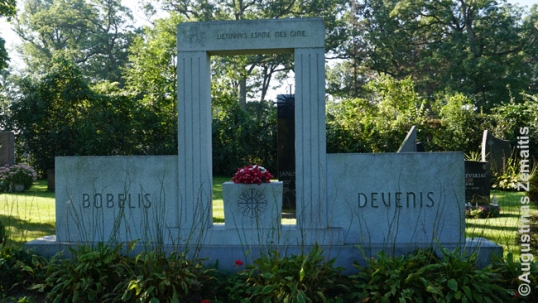

Politician Kazys Bobelis grave
*Jonas Budrys, a leader of the Klaipėda Revolt that attached Klaipėda to Lithuania in 1923.
*Adomas Varnas, the painter who designed the original (1922) Lithuanian Litas banknotes.
An interesting grave is that of Karolis Požėla where this Lithuanian boxing coach is buried with his most famous pupil, Maurice Tillet (French Angel) who was not a Lithuanian himself. The epitaph is "Friends whom even death couldn't part".


Maurice Tillet and Karolis Požėla mutual grave at the Lithuanian National Cemetery of Chicago
Additionally, the cemetery became a popular place to build general memorials for various Lithuanian groups.
On the rightwards path going from the entrance, you can see Darius-Girėnas post of American Legion monument that includes several pieces of artillery and is a focal point in Memorial day celebrations. The memorial looks quite similar to the St. Casimir cemetery one.


American Legion Darius and Girėnas post memorial in the Lithuanian National Cemetery of Chicago
Further on, there is a traditional wooden cross dedicated to 300000+ people expelled from Lithuania by the Soviet occupational regime in 1940-1941 and 1944-1953, commissioned by the Pakalka family in 1994. It is also notable for having attracted priests to bless it and the surrounding ground, this way effectively ending the belief held by some Catholics that National Cemetery is only for the non-believers. So-much-so that the Lithuanian Catholic organization Knights of Lithuania, as well as Lithuanian scouts (2018, author Vilnius Buntinas) have also erected their memorials in this cemetery rather than St. Casimir's. They were followed by the patriotic Šauliai in 2019.
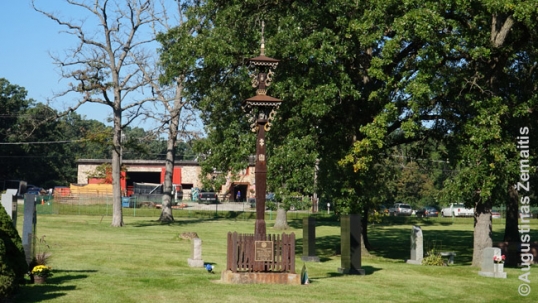

Memorial to the exiled Lithuanians in the Lithuanian National Cemetery of Chicago
Additional memorials in the cemetery are dedicated to the Lithuanian Freemasons (with the leaders of the 1951 "Lithuanian Craftsman Club" listed on its back) and the author of Lithuanian National anthem Vincas Kudirka (1961).


Lithuanian freemasons memorial


Vincas Kudirka Memorial at the Lithuanian National Cemetery of Chicago
Initially, the cemetery has been used by various non-Catholic groups, including leftists, National Catholics, Lutherans (especially the Tėviškė parish). Later on, the Catholics have gradually joined them and, with delituanization of the St. Casimir Cemetery, this became the sole truly Lithuanian cemetery in the Chicagoland (the administration is Lithuanian as well).
Among the early burials, the most controversial are the six gravestones with communist symbols as Lithuanian communists have also used the cemetery. Later on, as the Soviet occupation of Lithuania proved disastrous and Chicago became overflooded with new refugees from Lithuania who left everything to avoid living under communist rule, the communist symbols were banned in the cemetery. Ironically, ~1990 as Lithuania was approaching independence, the cemetery was vandalized with Swasticas, equalizing Lithuanians buried there with Nazis.


A Soviet-symbols-clad memorial in the Lithuanian National Cemetery of Chicago
As times went on, the numbers of annual burials in the cemetery have decreased as significant numbers of the descendants of Lithuanians are of mixed ancestry and no longer seek to be buried in Lithuanian cemetery. Because of this, the cemetery has sold off much of its additional space for residential developments and survives on the money received in this sale. A part of the cemetery has been also defined as a park area meant for green burials.
The infamous Chicago legend of Ressurection Mary (about a ghost girl that appears to drivers) is also related to the Lithuanian cemeteries. One of the possible girls whose ghost supposedly haunts Chicago is Ona Norkus, buried in the St. Casimir Cemetery. However, when a film was made about the legend, the crew picked the Lithuanian National Cemetery for filming, presumably because of its rather secluded and wooded location.
Lemont and the current heart of Chicago Lithuanian community
In the deep southwest of Chicagoland lies the modern heart of the Chicago Lithuanian community. After the disintegration of Marquette Park, there is no longer any district where Lithuanians would make more than a few percent of the population. But in the automobile-loving USA driving 10 or 20 km is no obstacle.
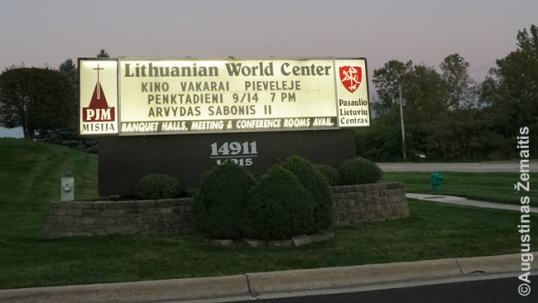

Main sign of the Lithuanian World Center
In 1987 the "Lithuanian World Center" was opened in Lemont suburb. Various events such as concerts and Chicago Lithuanian Basketball League matches are held there (basketball is Lithuania's national sport and the Chicago League was established in 2003; its ~15 teams play using the FIBA rather than NBA rules) while the America's largest Lithuanian-language school operates every Friday evening and Saturday, attracting some 700 kids. The center is usually open to everybody as there are many Lithuanian activities and possibilities inside with over 40 Lithuanian organizations and businesses having their hubs in its 14 000 square meter of space. Around the center, you'll rarely hear the English language but people in the center can speak it.
As the World Center has been bought from non-Lithuanians (originally it served as a priest seminary), it is rather functional in style lacks any Lithuanian architectural details. However, that is more than compensated by the increasingly lithuanized interiors and Lithuanian activities.


Main ballroom of the Lithuanian World Center
At the heart of the World Center is Blessed Jurgis Matulaitis Catholic church which effectively serves as the US newest Lithuanian ethnic parish. Unlike most ethnic parishes, it has limited Lithuanian details due to its non-Lithuanian history, but Lithuanians tried to change that over time, installing a Jurgis Matulaitis statue, Lithuanian carved wooden door, a memorial to the suffering of Lithuania, etc.


Lithuanian World Center chapel


Jurgis Matulaitis at the Lithuanian World Center chapel
Among other key institutions, there are the numerous Lithuanian museums (open on weekends only or by appointment). The most impressive among them is the Museum of traditional folk art that has the best collection of Lithuanian folk art in America. In fact, it would be great even by Lithuanian standards, as it was collected by cheaply buying (or receiving as gifts) that art from woodcarvers in Lithuania back in the early 1990s, when such art was not yet valued in Lithuania itself. There is a hall of wooden sculptures, some of which have political commentary (like a sculpture of Hitler and Stalin torturing Lithuania), while others are more traditional holy figures or devils. There is a corridor of wooden representations of the leaders of Grand Duchy of Lithuania. There are quality examples of Lithuanian folk costumes, verbos (that replace palms in the Vilnius region Palm Sunday) and looms used to weave textile.



Lithuanian wooden arts at the Lemont museum


Lithuanian wooden arts at the Lemont museum


Lithuanian wooden arts at the Lemont museum
Near the entrance to the museum you can find Siela gallery which is used for temporary exhibits from Lithuanian artists, while one hall is dedicated to a more permanent collection of non-folk art. Audience events also take place there.
Additionally, the surroundings of the World Center received numerous Lithuanian monuments. The most impressive collection of them is the Lemont Hill of Crosses inspired by the famous Hill of Crosses near Šiauliai, Lithuania. Currently, it has some 80 crosses, most of them of the traditional Lithuanian wooden form that is considered immaterial UNESCO world heritage. Like in the real Hill of Crosses, some of the crosses are erected by common people who do that in memory of their relatives, sometimes victims of the Soviet Genocide. Some of the crosses have been erected by organizations, such as the Lithuanian scouts. Some of the crosses have been moved into the Hill of Crosses from various private yards of Lithuanian-Americans: for the refugee generation, it was common to erect such reminders of the homeland on their yard, however, their kids often want to redecorate the yard or, more likely, simply sell the house, so, they may donate the crosses to the Lithuanian World Center. Yet other crosses (or other memorials) have been built to commemorate particular events, for example, the battle of Žalgiris or the Christianization of Lithuania. Many crosses also have patriotic symbols on them, while one memorial built in 1998 has a poem "Not our land" on it about longing for the lost homeland. During the Lithuanian day of the dead (Vėlinės) Lithuanian immigrants whose family graves are far away light candles on the Hill of Crosses in their memory. The Hill of Crosses was founded by Antanas Poskočimas (1905-2000), a Lithuanian traditional folk artist who lived in Lemont.
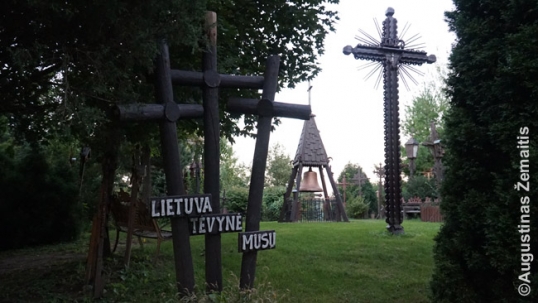

Lemont Hill of Crosses entrance with the first three words of the Lithuanian National Anthem (Lithuania, our homeland) inscribed


Lemont Hill of Crosses
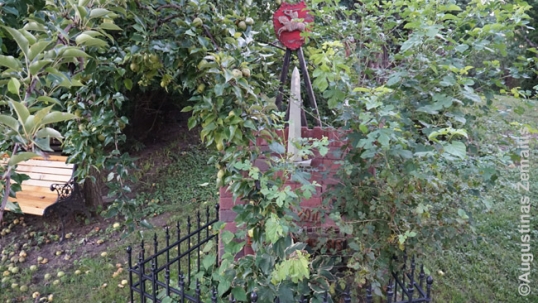

Battle of Žalgiris (Grunewald) memorial at the Lemont Hill of Crosses
At the center of the Hill of Crosses a 1917 bell is erected. The bell is from the Gary Lithuanian church in Indiana that has been closed. It is used as a symbol of the closed Lithuanian-American churches. At the entrance of the Hill, there are three crosses with words "Lietuva, Tėvyne mūsų" (Lithuania, our Fatherland), which are also the first three words of the Lithuanian national anthem.


Vėlinės Vigil at the Gary bell in Lemont Hill of Crosses
On the bottom of the Hill of Crosses stands the Memorial for Lithuanian partisans and people expelled to Siberia styled as a weeping mother of a victim of the Soviet regime and a bunch of fallen leaves. Built by one of the most productive Lithuanian-American sculptors Ramojus Mozoliauskas, it commemorates some 30 000 anti-Soviet guerillas who fell in the last-ditch attempt to restore free Lithuania (1944-1953) and up to 400 000 people expelled by the Soviets to Siberia, many of them to meet their deaths there. It was that Soviet genocide that caused so many Lithuanians to leave Lithuania as refugees in 1944 before the Soviet re-occupation; ultimately, most of those refugees ended up in the USA and it was them who eventually were the driving force behind the creation of the Lithuanian World Center in Lemont.
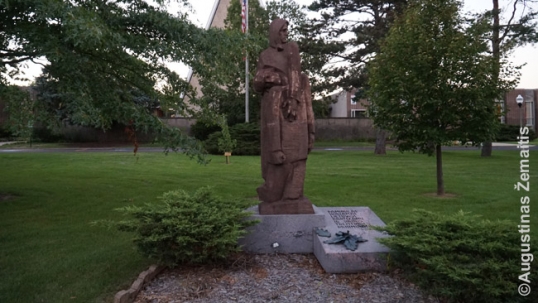

Mother of a partisan memorial next to the Lithuanian World Center in Lemont
In 2019, another memorial has been built nearby, dedicated to one of the most famous Lithuanian anti-Soviet partisans Adolfas Ramanauskas-Vanagas. He is notable as he was a US citizen, having been born in a Lithuanian emigrant family in New Britain, Connecticut before his parents brought him back to Lithuania. The initial Lithuanian idea was to build this memorial in a park in New Britain but the plan was thwarted by anti-Lithuanian lobbying (this was part of a general “fight for the memory about occupations of Lithuania”. Russia and some other powers seek to diminish or smear the memory of the Lithuanian fight for freedom from the Soviet Union in order to paint the Soviet occupation of Lithuania as “benevolent” or at least “not any eviler than independent Lithuania or America”, while Lithuanians seek to disseminate the truth about the Soviet occupation/genocides and respect those who fought that).
At the entrance of the Lithuanian World Center itself, there is a composition of three Lithuanian chapel-posts (koplytstulpiai).
While the Lithuanian World Center is the most famous Lithuanian site in Lemont by far, it was actually not the first one. Lithuanians were buying real estate in Lemont sometime before that already, and so did the Ateitininkai Lithuanian Christian organization. The Ateitininkai Home feels more like a palace of a large landowner in suburban England. In fact, it was built in 1952 as a palace of a millionaire Schmidt who made his fortune through war industry; according to Ateitininkai members, even the US president Dwight Eisenhower was a guest at the palace back then; the palace then had a bar and even a bowling alley in the basement. The palace was acquired by Ateitininkai in 1978, under the initiative of 10 Lithuanian doctors who all immigrated to the USA as refugees in the 1950s.
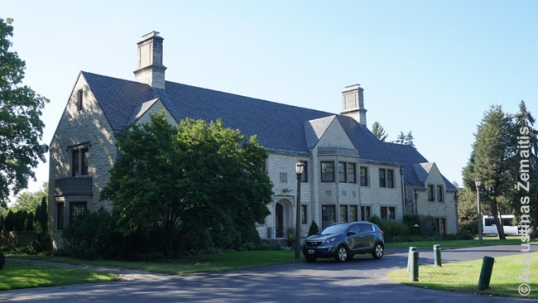

Ateitininkai Home
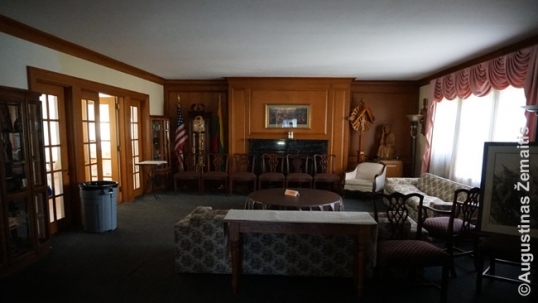

Serene hall of the Ateitininkai Home
Ateitininkai is a Lithuanian Christian organization, one of many Lithuanian organizations that were destroyed by the Soviet regime only to be reborn in the USA. Ateitininkai Home is used for various organizational activities, meetings of Ateitinkai kids, as well as rentals for weddings which helps sustain the palace. Given the patriotic and religious nature of the organization, it has collected Lithuanian and Christian artifacts in its halls over time. Two large traditional Lithuanian chapel-posts and one cross have been erected in front of the palace, most are relocated from other places where they were in danger of destruction. One of them, a metal chapel-post (koplytstulpis) has been relocated from a now-closed Lithuanian Farmstead in Marquette Park (originally designed by famous architects Mulokas and made by A. Janonis in 1973). Another chapel-post, originally created for a private home of Dr. Adomavičius in 1966 and relocated after that home was sold, has been dedicated to the Lithuanian anti-Soviet partisan Juozas Lukša-Daumantas and repaired by a "Godmaker" A. Poskočimas. Yet another cross is a donation of Antanas Poskočimas (1983) and renovated by Dainius Kopūstas (2014); it represents a traditional Lithuanian roadside cross.
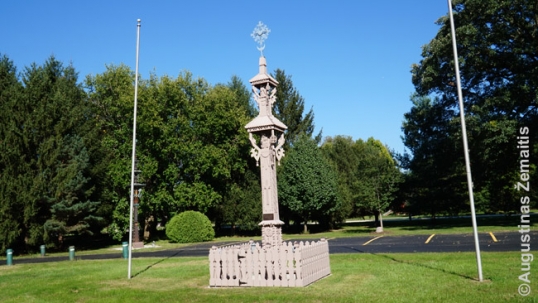

A chapel-post (koplytstulpis) dedicated to Juozas Lukša-Daumantas at Ateitininkai Home
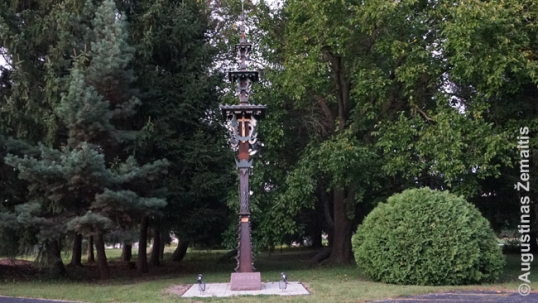

Jonas Mulokas chapel-post at Ateitininkai Home
The alley leading to Ateitininkai home has a Lithuanian sign "A. Pargausko alėja".
As a hub of Lithuanian activities in Chicago, Lemont continues to attract new Lithuanian institutions. As Lithuanian Research Center sought to relocate its arhcives from the Lithuanian Youth Center into new premises, it decided to acquire a former kindergarten in Lemont, which now acts as its main repository.
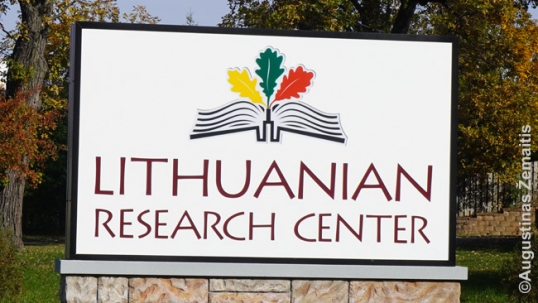

Lithuanain Research Cenetr plaque
Famous Lithuanian burials outside Chicago Lithuanian cemeteries
Most famous Lithuanians were buried in the Lithuanian cemeteries - however, not every one of them. Interesting Lithuanian graves elsewhere include that of a science fiction writer Algis Budrys (Algirdas Budrys, incorrectly spelled as Algidras Budrys on the grave plaque) in the Maryhill Polish cemetery. He wrote in English, so he is among the Lithuanians that are more famous in the USA than Lithuania itself.


Algirdas Budrys grave in Chicago (inscribed with a mistake)
Then there is a mysterious 19th-century grave of Dzialinskis-Kenkelis in the Oakwoods cemetery that claims that the person who is buried there was the Great Bannerbearer of Lithuania. He is also called to be Djialinski of Szodeiken, while his wife supposedly was Isabelle Djialinska, Countess of Szodeiken, and also a princess of Czartoryski family.


Dzialinskis-Kenkelis grave
The grave has long been a mystery to local Lithuanians. As Lithuania did no longer exist at the time Dzialinskis-Kenkelis was born, it is unclear whether the "titles" written are meant to be the titles somebody from his family had before the collapse of the Grand Duchy of Lithuania (1795), or were they titles he held during the anti-Russian uprising in 1863. Given the lack of information about this person in Lithuania itself, it is very possible he actually just impersonated to be somebody of importance when in the United States - something allowed by the vast distances, limited communications at the time and thus an inability of any American to check his stories. In any case, the grave is interesting and its existence was even romanticized during the Soviet occupation of Lithuania as the grave provided a kind of a link between the Lithuanian-Americans and the glorious pre-modern Lithuanian history.
St. Boniface cemetery in the area has a grave of Juozas Juškevičius (Juszkiewicz), believed to have been the first Lithuanian priest in Chicago (1803-1879). With few Lithuanians, he served Polish parishes at the time but was beaten by Polish parishioners. A plaque for him has been built in 2011.
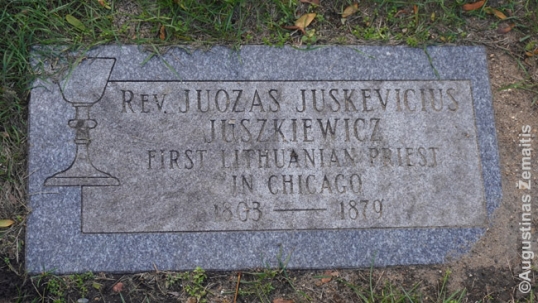

Priest Juškevičius grave
Lithuanian restaurants in Chicago
Chicago is the only city in the USA where Lithuanian food is easy to find - although you still need to know where to search it.
Most Lithuanian restaurants are located around Westmont suburb which is easily accessible to Lithuanians living in the surrounding suburbs.
Those restaurants are Ruta, Smilga and Grand Duke's. All are rather similar in appearance and fares but "Grand Duke's" is open the longest into the evening. Every one of them includes "Lithuanian combo" which is a sampler menu of Lithuanian food that should feed two people. The Combo certainly includes Cepelinai and may also include some of the following: Kugelis, Potato pancakes, Virtiniai, Sausage with sauerkraut, soup. Typically, the combo includes 4 to 5 dishes.


Lithuanian Combo of Chicago
Historically, there were many Lithuanian restaurants located in Chicago's southside but as Lithuanians moved to the suburbs they folded or moved away as well. The originally Lithuanian Racine Bakery near Cicero is now also non-Lithuanian-owned. It is more of a shop/deli than a restaurant though, having just a single seat for inside dining.
Most Lithuanian restaurants also serve as shops of Lithuanian products (Grand Duke's has a separate shop "Old Vilnius" on the opposite side of the road). Palos Hills also has a "dedicated" Lithuanian Plaza shop.
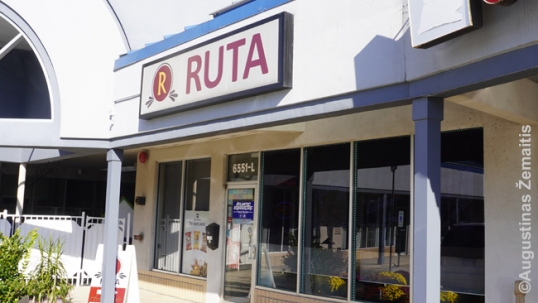

Ruta (litterally meaning "Rue") Lithuanian restaurant in Chicago
In Bridgeport, the "first Lithuanian district of Chicago", there is a surviving Bernice's Tavern Lithuanian-owned bar (the longest-Lithuanian-owned bar or restaurant in Chicago). It has Lithuanian beer and some Lithuanian memorabilia.
Lithuanian-related sites in northern Chicago
While most immigrants from Lithuania have settled in the less fancy southern Chicago, northern Chicago once also had a Lithuanian church, dedicated to St. Michael (since demolished with nothing Lithuanian remaining in the surrounding district).
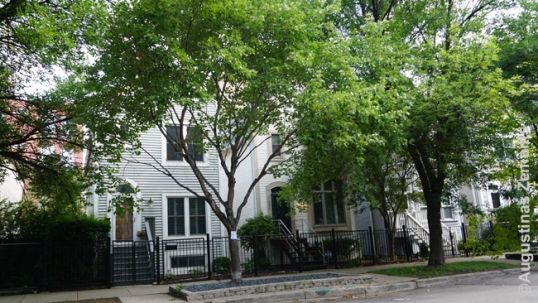

The site of St. Michael Lithuanian church in North Chicago
Additionally, St. John Cantius Polish church, one of the most famous Chicago churches, includes the Lithuanian coat of arms on its façade and stained-glass window above the entrance. That symbol, which merges Lithuanian and Polish coats of arms, was actually the coat of arms of the 1863 January Uprising against the Russian Empire that controlled both Poland and Lithuania at the time; while the uprising was Polish-dominated, the Poles sought to enlist more Lithuanians for the cause as well (the uprising sought to restore a united Poland-Lithuania and was the last such massive joint effort before the Lithuanian National Revival effectively divorced the two nations). It seems at the time St. John Cantius church was built, the echoes of that failed uprising still vertebrated in the Polish-American communities. This was already, however, a time when both nations were heading their own separate ways, and initially content with being part of joint American parishes with the Poles, Lithuanians were establishing their own in Chicago and all over America by the 1890s.


Coat of arms of the 1863 uprising in the St. John Cantius church of Chicago
The area also has Telshe yeshiva - a Jewish religious school named after the Lithuanian town of Telšiai. The history of the name is such: the yeshiva was established by the identically named Telshe yeshiva of Cleveland, which was in turn established by the teachers of the original Telšiai yeshiva after it was closed down by the Soviet occupational force.


Telshe Yeshiva of Chicago
Many of Chicago Jews are buried in Waldheim Cemetery, which can be seen as a collection of some 280 separate cemeteries, many of them with their own fences and gates. These cemeteries were established by different Jewish organizations and many of these organizations, in turn, were established by Jews who immigrated from the same region. As such, there are separate cemeteries for Lithuanian Jews as well, e.g. Wilner (those from Vilnius), Kovner (from Kaunas), and such.
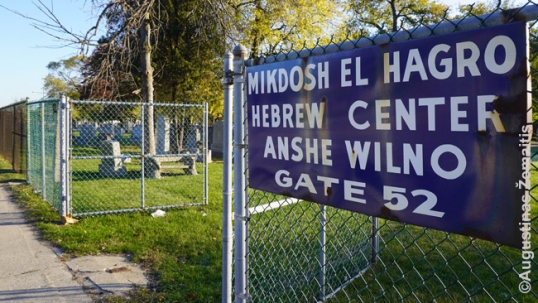

Anshe Wilno (people of Vilnius) section of Waldheim Jewish cemetery (gate 52)
A larger Lithuanian community exists in the suburb of Waukegan. As the suburb is far from Chicago's center, it is described in a separate article.
The map
All the Lithuanian locations, described in this article, are marked on this interactive map, made by the "Destination Lithuanian America" expedition (click the link):
Pennsylvania
Pennsylvania is the home to the world's oldest Lithuanian overseas community, started in ~1865 by coal miners. 82 000-strong it is also the second largest in the USA. Back in 1930 three Pennsylvanian cities were among the US top ten by the total number (rather than percentage) of ethnic Lithuanians: Philadelphia (3rd), Pittsburg (8th) and Scranton (10th).


Lithuanian national musical instrument Kanklės detail at the Lithuanian Music Hall in Philadelphia.
Lithuanian heritage in Pennsylvanian Coal Region
The strongest presence of Lithuanian heritage is in the parts of eastern Pennsylvania known as the Coal Region. Coal, the oil of 19th century, was discovered there in the 1860s. People from poor European regions were recruited for hard and dangerous work (10 hours a day, 6 days a week, 25 ct wage per hour) living in the newly erected towns. Lithuania was at the time occupied and heavily persecuted by the Russian Empire, giving rise to emigrants known as "grynoriai" ("Free Air Men") for whom the conditions in Pennsylvanian mines were far better than persecution back in their agricultural homeland, where the Lithuanian language had been banned and serfdom abolished only recently (1861).



Memorial plaque for Little Lithuania in the Southern Coal Regi
The Coal Region ran out of coal but the towns remained, in many of them Lithuanian populations still in their hundreds. There are lavish Lithuanian churches built of the hard-earned money by the early settlers and large Lithuanian cemeteries with their typical massive tombstones. More than 40 churches were built there. However, Lithuanian mass is no longer celebrated and Lithuanian dedications (Our Lady of Šiluva, Our Lady of Vilnius, St. Casimir, St. George) are largely removed where they existed, especially during the church closure spree of ~2008. After all, the Coal Region Lithuanian communities, unlike those in major cities, were not replenished by new immigrants and English language became dominant in the communities over some 4-5 generations. However, Lithuanian inscriptions, Lithuanian history-inspired church interiors and exteriors still remain where the churches are still used for religious purposes. It should be noted that Lithuanian church attendances were growing until at least 1980, contrary to regional trends.



'Shrine of Lithuanian history' in a Lithuanian-American church. From left to right: American, Lithuanian, and Vatican flags; the Soviet Genocide painting; the Mary painting in a folk-craft frame; the TV tower painting; the cross with images of those killed in January 13, 1991.
The Coal Region of Pennsylvania consists of two large areas.
The Southern Coal Region is centered around Shenandoah, a town that used to be known as "Vilnius of America" in the early 20th century. The area is important not only to the Lithuanian-American history but to Lithuanian history as a whole: in Shenandoah, the world's first Lithuanian novel was printed ("Algimantas" by V. Pietaris in 1904 when Lithuanian language was still banned back home), Lithuanian miner orchestra and other cultural institutions, newspapers, existed. Shenandoah had Lithuanian mayors for 42 years and it has 6 Lithuanian cemeteries. In general, Southern Coal Region consists of many small crumbling ex-mining towns, each of them having some 500-5000 people and a regular grid of streets. 15 of those towns had Lithuanian churches (despite them being just a few kilometers from each other) and many had Lithuanian cemeteries and massive schools. Some still exist, some are destroyed or abandoned. Lithuanian Days, the oldest annual ethnic festival in the USA, takes place in the area since 1914. The 20 miles wide area surrounding Shenandoah hosts many Lithuanian villages. In Seltzer (pop. 307) Lithuanians make 27,46%, in New Philadelphia (pop. 1616) - 16,97%, in Cumbola (pop. 382) - 15,06%. Lithuanian populations surpass 9% in the area's towns of Minersville (pop. 4686), Mahanoy City (pop. 5725), Barnesville (pop. 2076), Frackville (pop. 8631). All these locations are in top 20 US locations by the share of Lithuanians. Among these 20 as much as 16 locations are in Pennsylvania, 15 in the Coal Region. Much of the area is with Schuylkill county which, with 5% of its population Lithuanian, is the most Lithuanian county in the USA.


1950s postcard of Shenandoah churches (Lithuanian St. George church on the right).
The Northern Coal Region is much urbaner than the Southern Coal Region: essentially, it is one large conurbation of over half a million people, covering the cities of Scranton, Wilkes-Barre, Pittston and more. These cities each have 1%-4% of their population of Lithuanian ancestry (Pittston has the most with 4,15% Lithuanians, making it the largest share of Lithuanians in a US city of comparable size). There were 14 Lithuanian churches in the area, as well as numerous large cemeteries and impressive monuments. The Northern Coal Region Lithuanian buildings are generally bigger than the southern Coal Region ones, as they served larger urban communities rather than smaller rural ones. There are also 4 surviving-and-open Lithuanian clubs, each some 100 years old (however, these clubs, while celebrating their Lithuanian past, now tend to accept all patrons). The most unique Lithuanian site in the area is the Lithuanian national Catholic church that is independent of the Vatican. The area also has Lake Kasulaitis, which is a Lithuanian-named lake that is the furthest away from Lithuania.
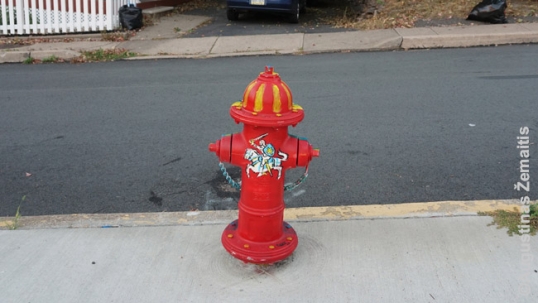

A fire-hydrant colored in Lithuanian colors near the Pittston Lithuanian club
Kasulaitis is also among a minority of surnames among those of Lithuanian Pennsylvanians which are still written as they are written in Lithuania. By the time immigration to Pennsylvania took place, there was no standardized Lithuanian orthography yet and the immigration service transcribed the surnames using various orthographies, including English, Polish or created ad hoc; they either added or removed word endings at will. Therefore in the Shenandoah Lithuanian cemetery, you may see surnames such as Bakszis and Bakszys (the modern Lithuanian spelling is Bakšys), Kutchinskas and Kutchinsky (modern Lithuanian: Kučinskas), Abrachinsky and Abraczinsai (modern Lithuanian: Abračinskas).



The grave of Publisher Bočkauskas family in Mahanoy City Lithuanian cemetery
All over the Coal Region, there are possibilities to descend into the mines Lithuanians worked at and visit museums that present authentic and quite sad life as it was.
A distant Lithuanian outpost away from everything else in Pennsylvania is another coal town of DuBois, that has Lithuanian church and cemetery.


DuBois Lithuanian church.
Lithuanian heritage in the major Pennsylvanian cities
Much larger and more lively Lithuanian community exists in the state capital of Philadelphia. There, three large Lithuanian churches operate, St. Andrew and St. Casimir churches having especially Lithuanian interiors and St. Andrew still hosting a Lithuanian school. Given that many Lithuanian churches elsewhere are closed, Philadelphia is arguably the best city in Pennsylvania or the entire USA to see the Lithuanian communities and heritage as it once was. There is also a historic Lithuanian Music Hall (older than the Republic of Lithuania itself) and other Lithuanian sites. Unlike the Coal Region where most Lithuanians are 3rd-5th generation descendants of immigrants, Philadelphia also has many post-WW2 refugees and numerous recent immigrants.
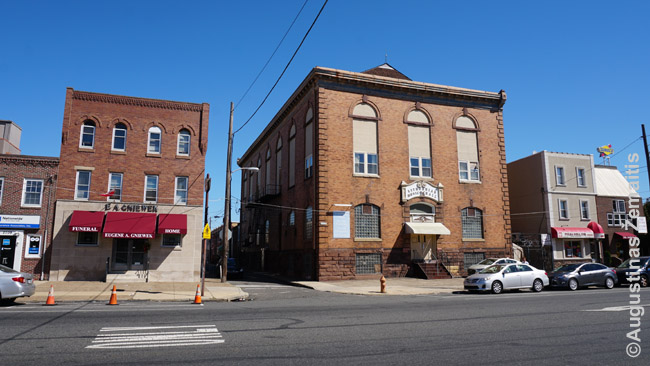

Lithuanian music hall in Philadelphia.
Yet another major Lithuanian area in Pennsylvania is located in Pittsburgh, where the Coal Region coal used to be turned into steel. Pittsburg has Lithuanian communities, cemeteries, and churches (most are closed now, though, as Pittsburg Lithuanian community also is among the old ones and the lack of Lithuanian domination in any town or region meant that it has assimilated into other communities). The most famous Lithuanian site in Pittsburgh is the Lithuanian National Classroom, an entire room of Pittsburgh university funded by Lithuania that doubles as a museum of the Lithuanian nation. It is a popular tourist site among Lithuanians and Americans alike.


Lithuanian classroom in the Pittsburgh Cathedral of Learning
There were also Lithuanian communities and churches in Easton and Reading, although both are now closed. There is a surviving Lithuanian club in Osceola Mills.


Pennsylvania map with the Lithuanian "colonies" marked. The Coal Region is marked in red, while the major concentrations of Lithuanians are written in green. ©Augustinas Žemaitis.
The map
All the Lithuanian locations, described in this article, are marked on this interactive map, made by the "Destination Lithuanian America" expeditions (click the link):
Interactive map of Pennsylvania Lithuanian sites
Shenandoah and southern Coal Region, Pennsylvania
The Southern Coal region of Pennsylvania is known as "Little Lithuania". The percentage of ethnic Lithuanians in its towns is larger than in any other area of the USA. Moreover, this region has also been important for the cultural history of the entire Lithuanian nation. Almost every town here has (or had) a Lithuanian church, cemetery, or club(s).



Memorial plaque for Little Lithuania in Shenandoah
The Lithuanian churches impress with their lavishness (knowing that everything was created by the donations of poor coal miners). Local Lithuanian cemeteries are rich in old gravestones and monuments with Old Lithuanian inscriptions telling the life stories of these immigrants. The region even has locations that are important to the history of Lithuania, not just Lithuanian-Americans, such as the site where the world's first Lithuanian-language novel was published. It also has numerous buildings with Lithuanian symbols in the facades. Lithuanian Days, the America's oldest continuous ethnic festival, is held in the area every year since 1914.


Mt. Carmel Lithuanian school facade with Vytis
Southern Coal Region countryside has numerous closed derelict closed coal (anthracite) mines which lured all those Lithuanians in during the 1860s-1910s era. The local towns are notable for their straight streets and high density of buildings. They were built that way to use up less of the valuable mining land. Nowadays, however, the population density is much lower and many buildings are derelict.


Hazleton Lithuanian church
Currently, the local Schuylkill county is the most Lithuanian one in the entire USA, with Lithuanians making 5% of local population. The locations with the most Lithuanian heritage are Shenandoah itself, Shenandoah Heights, Frackville, Mahanoy City, Mount Carmel, and Tamaqua.


Coal breaker under demolition near Shenandoah. It was among the last surviving such massive buildings that once employed many Lithuaians
Shenandoah - Vilnius of America
The heart of the Pennsylvania's Lithuanian region is Shenandoah (pop. 5500) that used to be nicknamed "Vilnius of America". Even today it is ~14% Lithuanian. The heart of Lituanity here used to be a twin-towered St. George church that had the longest Lithuanian history among the churches of the entire continent (built in 1891). It was full of Lithuanian art paid for by meager coal miner salaries. It was well on the way to be officially recognized as a heritage, yet after a controversial process and many protests, the diocese decided to tear St. George's down, despite the fact that it was the only church in the town built on solid ground. Lithuanians who collected money to list the church as heritage decided to spend it on a commemorative plaque for the Shenandoah's "Little Lithuania" (this plaque is located at the very center of the town, on the corner of Main and Centre streets).


Shenandoah St. George Lithuanian church site and the church's image
Shenandoah's nickname "Vilnius of America" is not an overstatement as the town had Lithuanian mayors for 42 years. More than that: the first Lithuanian-language novel in the world "Algimantas" has been published in Shenandoah in 1904 (its publishing house „Dirva“ stood at 15 W Oak St, whether the same building still stands is unclear). The reason for this (as well as Lithuanian migration to Coal Region in general) was that Lithuanians back home were discriminated under the Russian Imperial rule with their language banned between years 1865 and 1904.
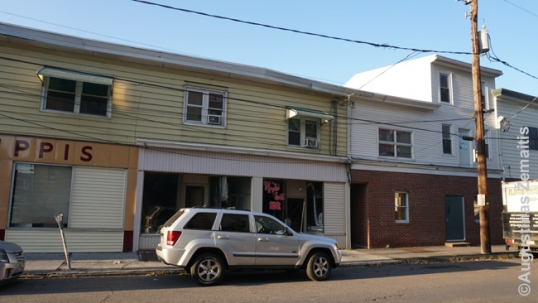

The location where the first Lithuanian novel was published
Back then, Shenandoah was a much larger town than it is today, with a population of 20 000 (40 000 according to other sources), a quarter of them Lithuanians. "Ripley's Believe it or Not" claimed Shenandoah to be the world's most densely populated locality.
The decline that happened in Shenandoah since then has been common in all the towns of the Southern Coal Region: they lost at least half of population since 1930 while some even lost three-quarters. Arguably, this helped to save the Lithuanian culture - there have been comparatively few new migrants until 2000s (Blacks, Latin Americans), therefore the old communities continue to dominate culturally. When there are so many Lithuanians, the probability of having a Lithuanian husband or wife is also not that small so there are 100% Lithuanians up to 3rd, 4th and further generations of immigrants.
The no-new-immigrants situation began to change ~2000s-2010s, however, as New York City area logistics centers were developed nearby, attracting Hispanic immigrants but the Lithuanian component is still strong.
Still, what exists today is far under what existed in 1898 when Shenandoah Lithuanians owned 59 Taverns, 17 shops, 5 meat markets, 8 stonemasons, 3 barber shops, 4 tailors, 1 blacksmith, 5 mortuaries, 5 stables and 2 publishers! Likely, Shenandoah had more Lithuanian businesses than any city within Lithuania itself, where businesses were generally dominated by the ethnic minorities (Jews, Germans, Russians, and Poles) at the time.
Among the still-existing Lithuanian-owned businesses is the Lucky's Kielbasy shop ("Lucky's" refers to the Lithuanian surname of the owners "Lukashunas"), which still offers some Lithuanian food, as well as Vernalis (Varnelis) restaurant. In general, the areas Lithuanian cuisine has somewhat drifted away from the original Lithuanian cuisine. Some dish names are partly anglicized, while the main alcoholic beverage is a typically self-produced "Boilo", the closest counterpart back in Lithuania being krupnikas, however, krupnikas is quite a niche product there, whereas Boilo is seen as the most Lithuanian drink in the Pennsylvania Coal Region.
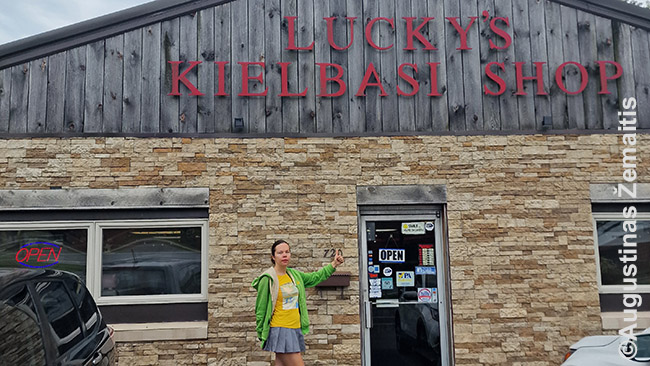

Lucky's Kielbasy deli
Shenandoah Heights Lithuanian cemeteries
The Lithuanian glory of the era may be glimpsed in six Lithuanian cemeteries of Shenandoah, located in the nearby Shenandoah Heights. This is the largest number of Lithuanian cemeteries at a single location anywhere in America. St. George Lithuanian cemetery is the oldest one, with burials dating to 1892-1934. The entrance has a Lithuanian inscription, while one of the graves not far from the entrance belongs to Rev. Andrius Strupinskas who is often claimed to be the America's first Lithuanian priest (his grave is marked by a small new plaque to be easily discovered).
In this cemetery, like in most of the Coal Region Lithuanian cemeteries, it is often better not to search for particular graves but rather wander looking at the old gravestones, reading their inscriptions, many of them in pre-modern Lithuanian language, and see the multitude of surnames: authentic Lithuanian, anglicized Lithuanian, polonized Lithuanian... After all, many of the immigrants were illiterate and their surnames would be written down by the migration officers as they heard them. Thus "Antanas Jonauskas" became "Anthony Yanousky", "Adomas Sinkevičius" - "Adam Sincavage", etc.
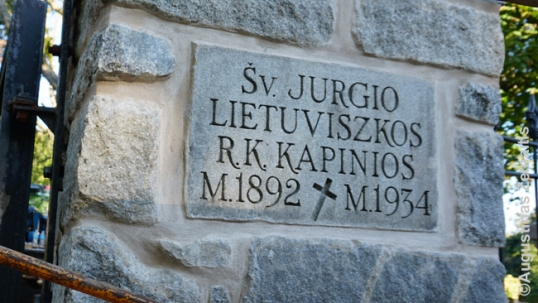

St. George Lithuanian cemetery entrance in Shenandoah
Our Lady of Calvary Lithuanian cemetery was born in 1911 out of the conflict between the priest and parishioners in the interwar St. George parish. The parishioners established their own cemetery and, having taken control of the church, even rang the bells for the funeral processions going there (the priest refused to participate in such funerals). [note: another source suggested that the Our Lady of Calvary Cemetery was established as independent in 1937 and consecrated in 1980, and the 1911 conflict happened at one of the other Shenandoah Lithuanian cemeteries]
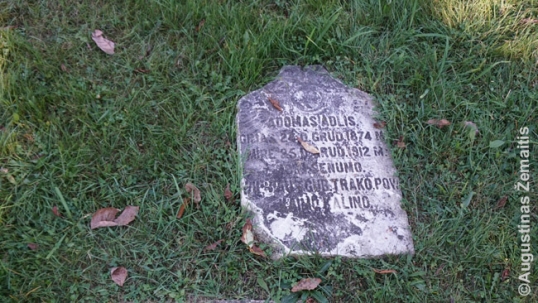

An old grave in Our Lady of Calvary Lithuanian cemetery
Conflicts like that were especially common in the early Lithuanian-American churches (~1880s-1930s), as Lithuanians who donated money for their construction did not trust that priests (some of whom weren‘t very priestlike) would take a good care of it (they feared, for example, that the Lithuanian mass would be cancelled in favor of Polish or English). Thus, they requested that the property would remain legally theirs. The Roman Catholic Church, however, required the buildings be transferred to the church.
Among the key reasons for such battles was the fact that in the 19th century, Lithuanians (and thus Lithuanian-Americans) were divided between the very religious ones and those who regarded the Lithuanian identity to be more important than Catholic identity. In the Coal Region, however, both groups went to churches, as the Lithuanian churches were both religious and secular institutions where Lithuanians would meet (also engaging in folk dances after the mass, etc.). For that second group, the secular activities mattered far more than the religious ones; these „secular Catholics“ of Shenandoah even criticised priests for too long religious ceremonies. The priests regarded these people as lost souls, and this second group was prominent among the activists for the secular-rule of the churches.
Eventually, the Roman Catholic Church got hold of the St George‘s church after numerous court battles, and the Our Lady of Calvary also became officially Catholic. Today, however, it seems that the secular activists of ~1900 have been right, as the church has been demolished and its stones may still be found at the western end of the Our Lady of Calvary Cemetery. Initially, the diocese promised that it would build a symbolic belfry for Lithuanians out of these stones, but has reneged on its promises since.


Church materials at a Shenandoah Lithuanian cemetery
There are three more Lithuanian Catholic cemeteries in Shenandoah. In Our Lady of Lourdes Lithuanian cemetery, the most impressive memorial is that for Aleksandras and Viktorija Semenis, in the form of a Lourdes grotto with Lithuanian inscriptions. The interwar Our Lady of Fatima Lithuanian cemetery boasts a Lourdes-inspired grave of priest Rev. Mssgr. Joseph Anthony Karalius, who served as Shenandoah‘s Lithuanian pastor for 41 years and is credited for achieving the final victory against the secular activists in a battle for the church property, as well as supporting anti-Soviet religious activities in Lithuania.


Semenis family Lourdes in Shenandoah


Priest Karalius Lourdes in Shenandoah
Shenandoah Our Lady of Dawn Lithuanian cemetery is usually misnamed in English: the correct translation would be „Our Lady of the Gate of Dawn“, referring to the miraculous painting of Virgin Mary in the Gate of Dawn in Vilnius, Lithuania. In this cemetery, the entrance gate with Lithuanian inscriptions and bas-reliefs is the most impressive.
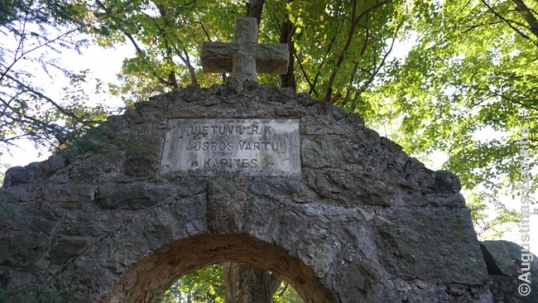

Entrance to the Our Lady of Dawn cemetery
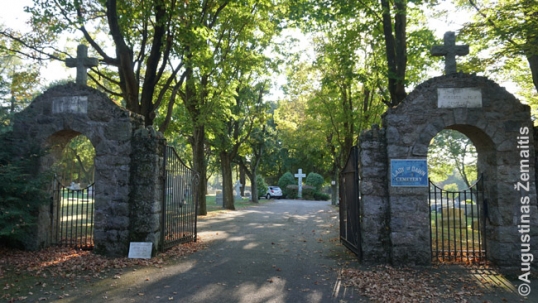

Our Lady of Dawn Lithuanian cemetery in Shenandoah


Lithuanian bas-relief in the Shenandoah Our Lady of Dawn cemetery
Moreover, Shenandoah Heights has a small and old Liberty Cemetery of the Supreme Lodge of Lithuanians in America (est. 1900) which served the similarly named local organization; it has ~50 of its members buried here. The organization was related to Jonas Šliūpas, a leftist so critical of the church that his followers typically established alternative institutions to the Catholic institutions altogether. As such organizations died off (with post-WW2 Lithuanians turning against leftism due to the Soviet Genocide in Lithuania), the cemetery became mostly abandoned.
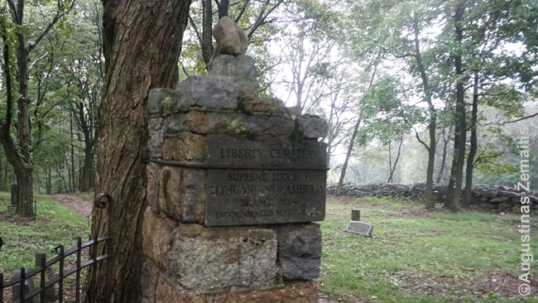

Shenandoah Lithuanian Liberty cemetery entrance
The southern side of Shenandoah Heights offers a great view of the Shenandoah town. Once, this view was dominated by the twin towers of the massive St. George Lithuanian church. The church is well-remembered as a key landmark of Shenandoah and even some advertising billboards ask the passers-by to remember it.
Shenandoah is also to receive a Lithuanian Museum, to be relocated from Frackville.
Lithuanian towns that surround Shenandoah
Merely a few miles separate Shenandoah from some other "Lithuanian" neighboring villages and towns. However, Lithuanians started moving in here at the time when the world could have only dreamt about automobiles and the intertown distances were still too big to travel on foot. Therefore, every town had its own Lithuanian church commissioned. All of them are small, usually with a single tower.
When there were so many Lithuanians, the ethnic traditions were easier to safeguard and even ~1970s the attendances of Lithuanian churches were increasing (those of other ethnic parishes were already declining). Even at ~1985 some Lithuanian parishes constructed new church buildings (therefore, although all the parishes had been established over a century ago, some church buildings are relatively new).
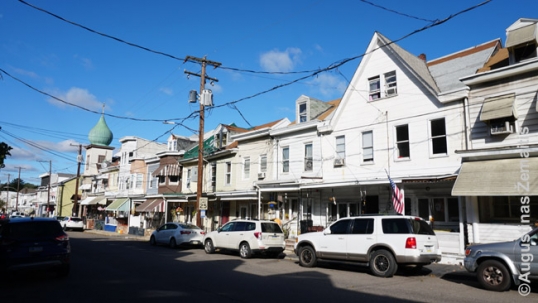

A street in Mahanoy city, a typical town of Shenandoah coal region
However, ~2008 the dioceses decided to abolish all the ethnic parishes and close their churches down. After all, Lithuanian masses had been abolished quite long ago in all of them: 3 or more generations have passed since the coal miner immigrants, thus the bishop thought there is no reason to keep multiple operating churches in small-and-diminishing towns/villages. However, the churches with their old Lithuanian inscriptions, paintings, decor are also important culturally and historically. Therefore, their communities defended them at all costs. Even though the Lithuanian language had been largely forgotten, other Lithuanian traditions (crafts, dances, food) are cherished.
In many of the area's towns you may see the images and names of the local war veterans posted on poles. By looking at these names you may easily discern the percentage of Lithuanians in the area, as nearly everybody whose surname ends in "-as" or "-is" is a Lithuanian. Those who have surnames ending in "-auski" are also Lithuanians, while those with "-owski", "-awicz", "-avich", "-avage" and similar-sounding surnames may be either Poles and Lithuanians.
Frackville Lithuanian district, museum and cemetery
One of the cities that cherishes the Lithuanian heritage the most is Frackville (pop. 4000 today, 8000 in 1930). It has an entire district of Lithuanian institutions around the Annunciation BVM Lithuanian church in Frackville. „Apreiškimo Panales Švenč Banyčia 1934“ inscription still adorns the cornerstone, although the church is now irregularly used. The interior includes stained-glass Windows with Lithuanian inscriptions, Our Lady of Vilnius painting, while the tower is crowned by a Lithuanian sun-cross. As the church is no longer officially a Lithuanian parish, some other Lithuanian details were removed (a recurring story in the Southern Coal region).


Frackville Lithuanian church
The nearby Lithuanian Museum and Cultural Center has been closed down in 2022, to be relocated to Shenandoah (see above). Established in 1982, it offered artifacts of the 19th-century Lithuanian immigrants, the once-cherished Lithuanian memorabilia which the Lithuanian-Americans were able to somehow acquire from the far-away and later Soviet-occupied Lithuania. This includes various manifestations of Lithuanian folk arts and crafts: kanklės traditional musical instruments, traditionally painted easter eggs (margučiai), straw ornaments, traditional crosses. Some of them have actually been created by local Coal Region Lithuanians, many of whom have actually never even visited Lithuania but still cherish the traditions passed on by their forefathers who may have immigranted ~1900. The museum also hosted exhibits explaining the Lithuanian-American life of the Coal Region (e.g. the symbols of once-numerous fraternity organizations). If you visited with somebody who knows the exhibits well, they could have told you many more stories, e.g. the exhibited funeral photos used to be sent through the Iron Curtain in order to inform on who is dead and who is alive at the time in the family without triggering censorship.


Frackville Lithuanian museum sign
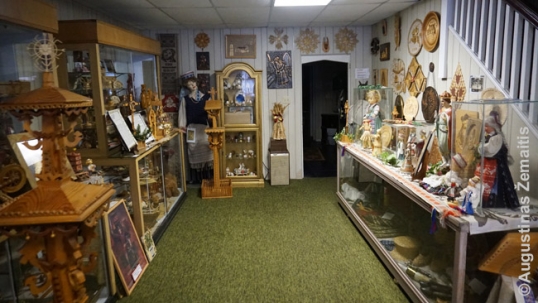

Inside the Frackville Lithuanian museum


Fraternity symbol in Frackville museum
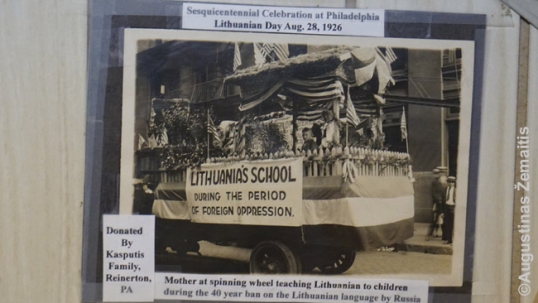

A Lithuanian rally in the 1920s as it appears in a Frackville Lithuanian museum image
Yet another Lithuanian building there is the Annunciation BVM parish hall (1957) that used to host Lithuanian Days in the 2010s, since moved elsewhere.
Away from its Lithuanian district, west of the town, Frackville hosts a large Frackville Lithuanian cemetery where not only Frackville Lithuanians but also Lithuanians from some other Lithuanian parishes used to be buried. Nominally, it consists of several cemeteries.
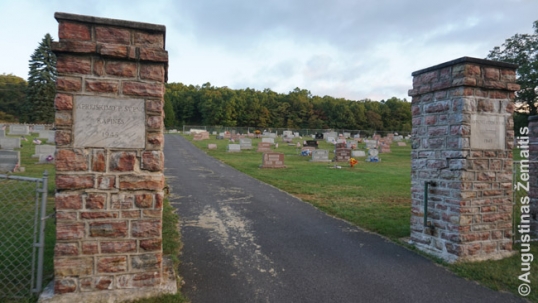

Entrance to the Frackville Lithuanian cemetery
Mahanoy City: Lithuanian church and cemeteries
In the same way as Shenandoah is important to Lithuanian literature, Mahanoy City (pop. 4 000 today, 16 000 in 1910) should be known to every fan of Lithuanian musical history. The coal miners of years-gone-by have established the world's first Lithuanian wind instrument orchestra ("Mainerių orkestra").
The town has a St. Joseph Lithuanian church, the area‘s oldest Lithuanian church (erected 1888-1893). Unlike in the other towns, where Lithuanian churches closed and Lithuanians were told to go to some once-non-Lithuanian parish, in Mahanoy City, all the parishes have been consolidated into the Lithuanian church in 2008. Therefore, it is the Lithuanian church that continues to be open, albeit now renamed after Mother Theresa of Calcutta, who visited it in 1995. Such parish consolidations, however, often mean that the one remaining church is renovated, thus losing some of its original ethnic details. For example, all the saints of the closed Mahanoy City churches have been painted over the altar, and new murals have been created all over the church. One Lithuanian thing remaining in the church is its stained-glass Windows. However, these are not authentic 19th-century stained-glass Windows. Most of these were replaced by new ones in the mid-20th century – while the surnames of the donors are still Lithuanian, the inscriptions themselves are not as, by this time, the Coal Region Lithuanian community increasingly spoke English as its first language. Only near the chorus do the original windows with Lithuanian inscriptions survive. On the outside, additional wall has been built parallel to the church where stained glass windows from the closed non-Lithuanian churches of Mahanoy City have been put on.


Mahanoy City Lithuanian church
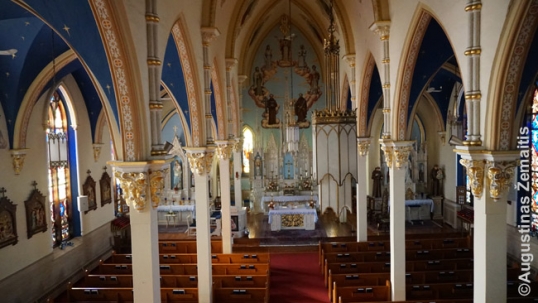

The interior of the Mahanoy City Lithuanian church
Mahanoy City used to have numerous Lithuanian buildings buildings, however, most have been demolished in the 2010s-2020s.
Mahanoy City has been famous once as the location where the world‘s-highest-circulation Lithuanian newspaper „Saulė“ was published. Its massive three-floored wooden publishing house (1916) stood derelict until 2021, when it was demolished (the newspaper had its final issue in 1959 as the Lithuanian language use declined in the area; it had been established in 1888).
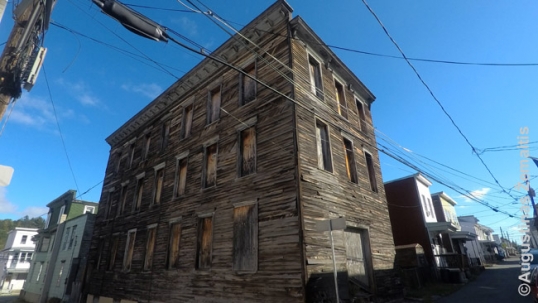

Saulė Lithuanian newspaper publishing house in 2017 (now demolished)


The facade of Saulė publishing house in 2017 (now demolished)
Lithuanians also had a Lithuanian bank in Mahanoy City, unfortunately, the building has been demolished in 2023. Interestingly, the bank has been established by a Lithuanian priest (Simonas Pautienius) as, at the time, ethnic minority banking was considered to be a social service more than a business, as the American banks often refused to lend to the immigrants. As the time passed and such discrimination ceased, the bank lost its raison-detre and merged into another bank in the 1940s, with building eventually becoming disused. The inscription on the building top said „1903-1923“. The bank is claimed to have been the first Lithuanian bank in the USA.
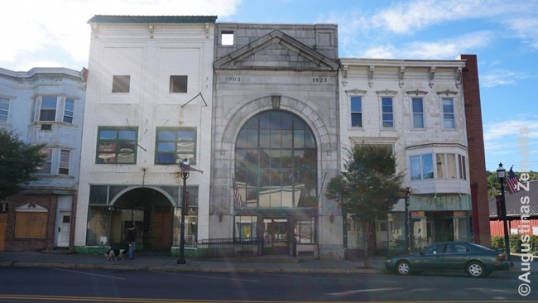

Mahanoy Lithuanian bank (the one with arched window)


The interior of Mahanoy Lithuanian bank
Mahanoy City had even more Lithuanian buildings: the Lithuanian school has been demolished in 2010 (closed down in 1972) to be turned into a newly-amalgamated parish's parking lot, while the Lithuanian convent still stands, however, there are no Lithuanian details survive there.
Outside of the town limits to the south, amidst the other cemeteries, stands the St. Joseph Lithuanian cemetery. The most important grave there is that of the Bočkauskas family, the publishers of „Saulė“. Interestingly, on some of this family's gravesypmes the surnames are written in Polonized (Bockowski) and some in prie-modern Lithuanian orthography (Boczkauskas), likely showing the rift that existed between those Lithuanian-Americans who emphasized their Lithuanian identity and those who preferred Polish as the „elite language“.



The grave of Publisher Bočkauskas family in Mahanoy City
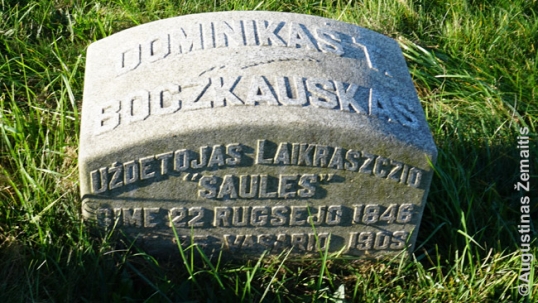

Saulė publisher grave in Mahanoy City
North of Mahanoy City stands another, far sadder-looking Old Lithuanian Cemetery. It is entirely abandoned, overgrown with trees, many of its gravestones overturned. That cemetery was established by the Mahanoy City St. Joseph parish in 1922, as the Lithuanian inscription on the gate says ("1922 m."). However, then it turned out that the ground is unsuitable for burials due to ground water. A new cemetery was thus opened (see above) and the people were encouraged to rebury their relatives there. However, this cost money, and thus some Lithuanians remained buried in the old cemetery which is now not being taken care of.


Abandoned Old Lithuanian Cemetery of Mahanoy City
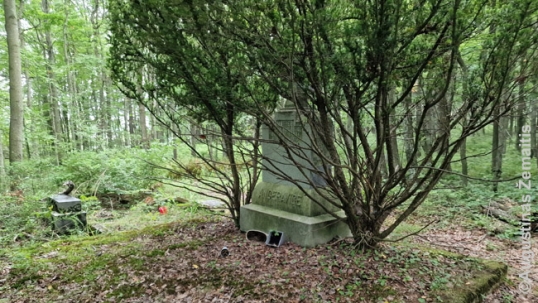

Abandoned Old Lithuanian Cemetery of Mahanoy City
Maizeville and Girardville: Lithuanian churches and a street
Maizeville village had the USA's sole Our Lady of Šiluva church (14 North Nice Street), named after the oldest church-recognized Marian vision in Europe that took place near the village of Šiluva in Lithuania. It has been constructed in 1967 after the old one burned down. The old church used to be been named St. Louis - however, the parish, even though already dominated by American-born Lithuanians, decided to adopt a more Lithuanian name for its new building. On the inside, they have commissioned many Lithuanian details and impressive stained-glass windows which were condemned for removal as the church had been closed.
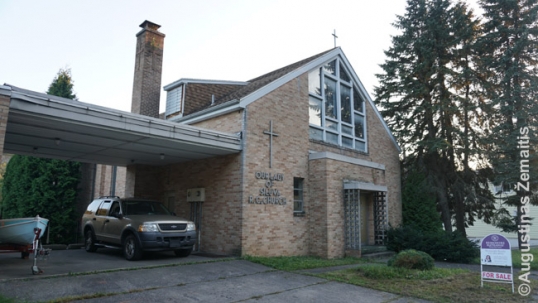

Maizeville Our Lady of Šiluva Lithuanian church
Maizeville and the nearby Gilberton lost extremely many people even by Coal Region standards: in 1910 they had a population of 5500 yet only 750 live there today. Maizeville still has an Our Lady of Siluva Boulevard (actually a small side-road that once served as a highway on-ramp; after the highway closed, the name of the nearby church was given to it). Unfortunately, there is no street sign and the name thus appears on the maps alone.
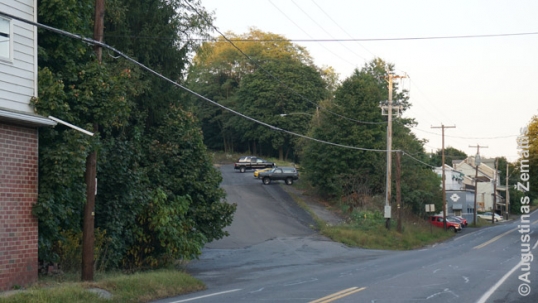

Maizeville Our Lady of Šiluva boulevard
Girardville's (pop. 1500 today, 5000 in 1930) Lithuanian hub used to be its St. Vincent de Paul church. The city‘s first Lithuanian mass has been celebrated in an opera theater at 27 E. Main St. (as the town turned into a village, it became a cinema, roller skating hall and finally has been demolished). The current brick English gothic revival church has been built in 1926, its lavish interior simplified in 1978. It includes Lithuanian stained-glass windows. Although no Lithuanian mass has been held for a long time, the parish celebrated its Lithuanian minority heritage until its closure. The beautiful stained-glass windows remain, including one with a Lithuanian flag and the Cross of Vytis symbol. There are many Lithuanian surnames written under various works of art as those of their donors. The official website of the former parish declares that "our roots will always be in Lithuania". While the parishes were consolidated, the church was allowed to stay open initially but ~2020s it saw little use.
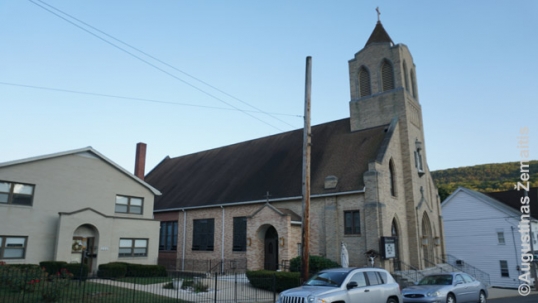

Girardville Lithuanian church


A stained-glass window at the Girardville Lithuanian church
Further south: Lithuanian heritage at 209 road
209 road ~15 miles south of Shenandoah has much of Lithuanian heritage in the towns along it.
Tamaqua town has the second still-open Lithuanian church of the region (St. Peter and Paul, 307 Pine St.), which is also an impressive example of Lithuanian modern art as its interior has been crafted by a famous Lithuanian-American sculptor-architect V.K. Jonynas (1976) in his unique style. The tower is crowned by a Lithuanian sun-cross. The Lithuanian flag, however, has been moved out while the wooden external cross was removed and replaced by a simple non-Lithuanian-styled one: Allentown diocese has been especially tough on the ethnicity of the churches so, while such things as Lithuanian crosses remained in the ex-Lithuanian churches elsewhere, they were almost invariably removed in the Southern Coal Region (except for the details too expensive to replace, such as the stained glass Windows). ~2018, a massive renovation in the Tamaqua church has also removed large swatches of original style that once formed the church as a single whole. Stations of the cross were replaced by the ones moved from another closed church, the altar side has been remodeled, the tower shortened (due to water leakage), and the front sculptures removed. The details that were removed still exist in the parish, albeit in other places (e.g. in the sacristy). Before the current Tamaqua church was built, Lithuanians used a building behind it as a church, as well as a school. That building still stands (constructed in 1927). While the remodeling removed some of the original character, they ensured that this church continues as the main church of Tamaqua, thus, it has not been closed (albeit renamed from St. Peter and Paul to St. John XXIII).


Tamaqua Lithuanian church
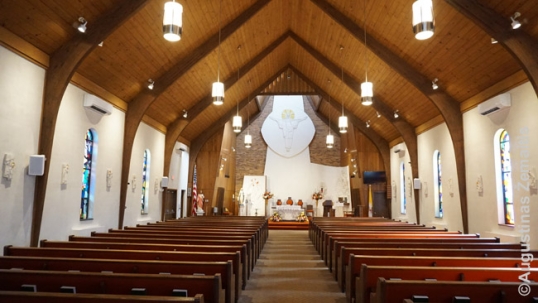

The interior of Tamaqua Lithuanian church
Tamaqua is one of the larger towns in the area with 7000 inhabitants (13 000 back in the "golden days"). It had 106 Lithuanian families in 1906 and 235 Lithuanian families in 1917; given the size of the families back then this may have made up 5-10% of population. Those families now lay at Owl Creek Road, where there is St. Peter and Paul Lithuanian cemetery (1929). The most impressive there is a derelict freestanding gate without any fence remaining. Two Lithuanian tricolor motifs are still visible on the gate, as are the words „Lithuanian cemetery“.
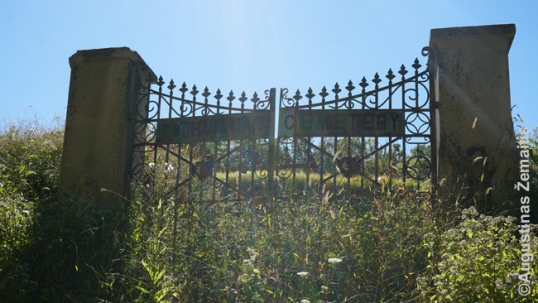

Tamaqua Lithuanian cemetery gate
The same cemetery was also jointly used by a parish ~5 miles east in Coaldale based in a white St. John the Baptist church. This church has been closed while the town itself lost nearly three-quarters of its population decreasing from 7000 to 2000 people. A Lithuanian inscription „Šv. Jono Lietuvių R. K. bažnyčia“ still remains on its cornerstone. It bears the date of 1914 05 10. After closure, this church was bought by a local person who was attached to it as he married his Lithuanian wife there and baptized their children there. Living in the rectory, he left the church mostly as it was. The diocese itself, however, after selling the church, tried to remove stained-glass-windows and the cornerstone but the parishioners and the new owner fought against this. Still, the diocese has removed the Lithuanian names of the church donors from the stained-glass windows.


Coaldale St. John Lithuanian church
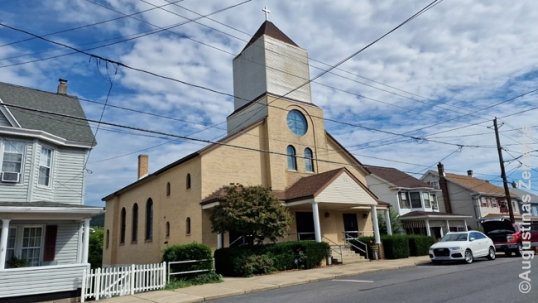

Coaldale St. John the Baptist Lithuanian church
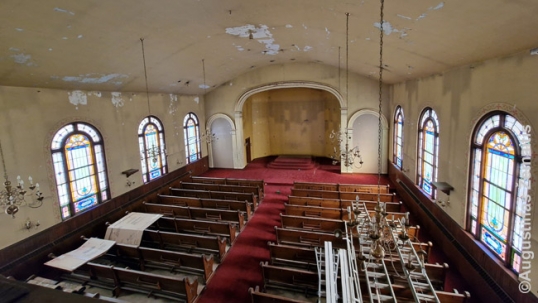

Coaldale St. John the Baptist Lithuanian church interior
Shenandoah is the most Lithuanian US town among those above 5000 inhabitants but if you count all the villages with population above 1000, New Philadelphia, that title belongs to New Philadelphia. ~25% people there are Lithuanians (more than of any other single ancestry). In 1910, when the village was double in size, there was a confrontation between two ethnicities: Lithuanians and Irish. Both established their own church and both remained open nearly until these days. Unfortunately, in 2008 the Lithuanian Sacred Heart church was closed (its building constructed in 1984). Now it serves as a church-owned café open weekly; the café still offers a Lithuanian kugelis, although all the Lithuanian symbols (such as Rūpintojėlis) have been removed by the diocese.


The former New Philadelphia Lithuanian chruch
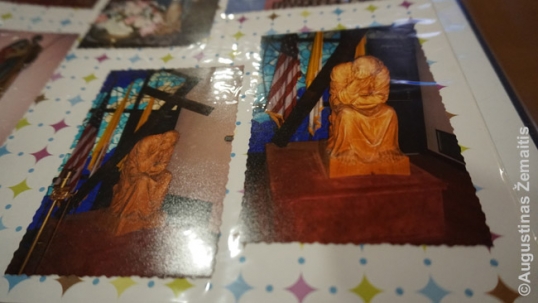

Rūpintojėlis that was thrown away by the Allentown diocese
To better understand just how massive Lithuanian community of New Philadelphia was, you may see its Lithuanian school (abandoned, no Lithuanian details, built in 1926) and equally massive (for such a village) Sacred Heart Lithuanian cemetery.


New Philadelphia Lithuanian school


New Philadelphia Lithuanian cemetery
The village of Middleport still had so many patriotically-minded Lithuanians in 1948 (some 50 years after the Lithuanian mass-migration into the region) that they built an entirely new church there (not simply replacing an older one). However, a new Lithuanian parish was not created there, so priests from New Philadelphia used to come to celebrate the mass. The church is now closed and it has no Lithuanian details.


Middleport Lithuanian church
Minersville (pop. 4000 today, 9000 in 1930) Lithuanian parish of St. Francis of Assisi (1950) has been also condemned but its people achieved an impressive victory in Vatican. After their complaint, Vatican recognized that bishop illegally closed down their church. Unfortunately, the bishop refused to concede and decided to reopen the church merely symbolically (for a single holy mass celebration annually). Then, in the 2020s, it was decided to close the church down completely citing "little use of the building" as a reason. With the old Lithuanian parish community already disintegrated, this decision was left unchallenged.
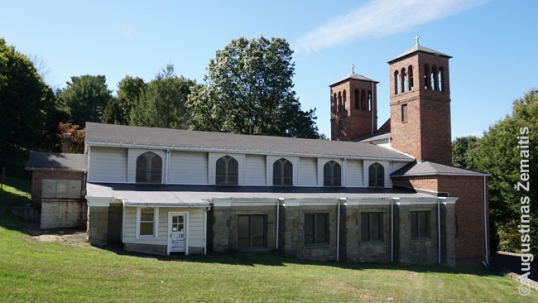

Minersville Lithuanian church
On the hill above the church, there is the former Lithuanian school (open as a non-Lithuanian school without surviving Lithuanian details).
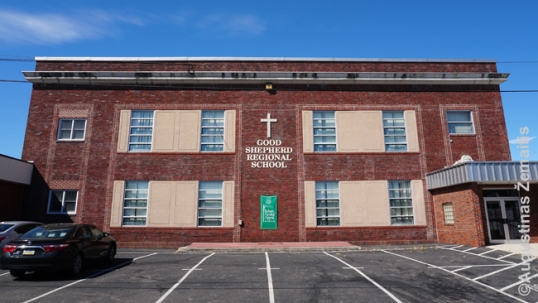

Minersville Lithuanian school
Minersville also has two Lithuanian cemeteries. The larger one by far is the Catholic Lithuanian Cemetery with a World War 2 memorial. There is also an eerily abandoned Lithuanian Liberty Cemetery by the hillside.
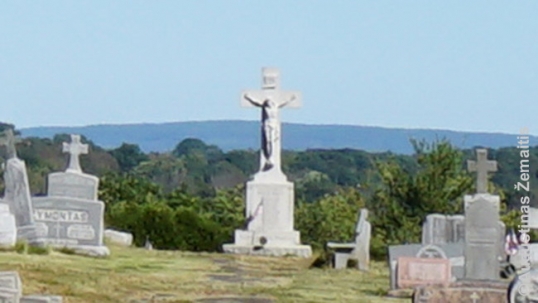

Minersville Lithuanian cemetery and World War 2 memorial


Lithuanian Liberty Cemetery of Minersville
St. Clair town (pop. 3000 today, 7000 in 1930) also saw its St. Casimir Lithuanian church (441 South Nicholas St., constructed in 1917) closed down during the campaign against the ethnic churches ~2010. The building is abandoned, with even the mass plaque with its final priest‘s name (Jankaitis) still adorning the wall.


Saint Clair Lithuanian church


St. Clair church information with a priest's surname
St. Casimir Lithuanian cemetery (est. 1929) remains near St. Clair, and the St. Casimir statue is its prime sight. Another Lithuanian cemetery (non-religious) is known as Sons of Lithuania cemetery and is located west of town together with St. Mary's Byzantine cemetery (without a visible separation).


St. Casimir in the St. Clair Lithuanian cemetery
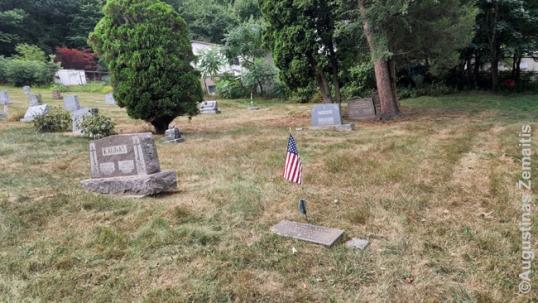

Sons of Lithuania cemetery in St. Clair
The areas south of Shenandoah also host the Pennsylvania Lithuanian Days. This is the longest-continuously-running annual ethnic festival in the USA, taking place every year since 1914. In 1922-1984, and since 2021, they take place in Lakewood Park. Currently, the timing is the closest weekend to the day of Virgin Mary Assumption in August. Previously, there used to be one Lithuanian day and it used to take place even if it did not fall out on Sunday. Lithuanians would take a holiday that day and descend on the Lakewood Park and the coal mine owners knew its better not to dispute this by requiring Lithuanians to work. It is said some 13 trains would go to Lakewood Park that day. It was also common to raise Lithuanian flags that day - a tradition that still survives to some extent and you can still see Lithuanian tricolors if you drive around the region in mid-August. The Lithuanian Days include Lithuanian music, fair, dances, and history-related activities.
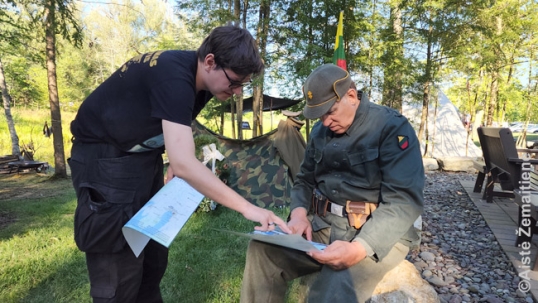

In a Lithuanian partisan camp during the Lithuanain Days
Lithuanian heritage west of Shenandoah
Mt. Carmel township (pop. 6 000 today, 18 000 back in 1930) was the hub of Lithuanian activities in the western Southern Coal Region. It still has a Lithuanian Social Club (309 S. Oak St.), established in 1926, with a door painted in Lithuanian tricolor. The club moved to this building in 1932. The club is among the most inclined to keep the Lithuanian heritage among the Lithuanian clubs of Pennsylvania's coal region, thanks to the young enthusiasts of Lithuanian heritage. Today, only a minority of its ~400 members are Lithuanians but, nevertheless, the club keeps the Lithuanian traditions and has many Lithuanian memorabilia inside. The club, open every day, also helping lonely people to socialize.
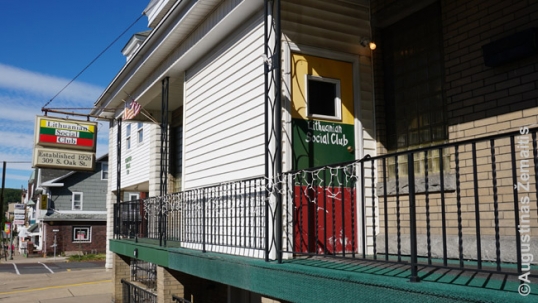

Mount Carmel Lithuanian club
Mt. Carmel also has a massive Holy Cross Lithuanian cemetery (south of town, Cemetery road). It was named after a Lithuanian church, closed in 1992 and now used as a warehouse, partly derelict, with many of its windows broken. The church is among the oldest in the area, its construction having begun in 1892 according to the Lithuanian cornerstone („St. Krizaus liet. bazniczia 1892“).


Mount Carmel Lithuanian church


Mount Carmel Lithuanian cemetery
The most important building in Mt. Carmel is, arguably, the
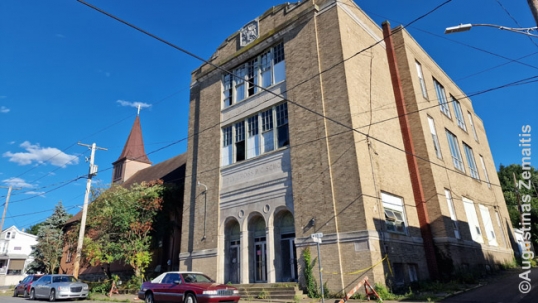

Mount Carmel Lithuanian church
Marija Kaupas, a Lithuanian nun, used to work in Mt. Carmel (she is on the route of canonization and a street has been named in her honor in Chicago). A center of voluntarism used by the Bucknell college has been named Mother Maria Kaupas Center for Volunteerism (est. 2015). Students live there temporarily, performing good deeds.


Maria Kaupas centre for volunteerism site
Shamokin town has been famous for America's first Lithuanian publishing house (which published Lithuanian-English dictionary by Markas Tvarauskas). It also had a Lithuanian St. Michael Archangel church (Cherry St.) that was closed in 1995 and demolished in 2015, although its basement stilll remains. Shamokin‘s Lithuanian club in nearby Coal Township was closed down for good during the COVID pandemic (~2020) and never reopened. The only Lithuanian institution that still remains is thus the Shamokin's Lithuanian cemetery (all of the town's cemeteries are located in a single area in the southeast next to coal mining remains, but the Lithuanian cemetery is separated from the others by the grove).


Shamokin old Lithuanian church, partly demolished (since 2015) on the left. Only the basment remains.


Shamokin Lithuanian club


Shamokin St. Michael Lithuanian cemetery
An interesting location on the way from Shenandoah to Mount Carmel and Shamokin is Centralia, a town that was demolished due to mine fires under it that sometimes led to smoke above ground.


Abandoned village of Centralia
While the town of Ashland has no Lithuanian clubs or churches, it has many people of Lithuania heritage. It also houses an original coal mine where one may descend to as well as an Anthracite museum that presents mining mostly from technological (rather than cultural) standpoint. There are no direct mentions of Lithuanians but the life these Lithuanians endured is represented.


Going inside the Ashland mine
Lithuanian heritage east of Shenandoah
The area's largest town east of Shenandoah is Hazleton (pop. 17 000 today, 38 000 back in 1940). Its brownish Sts. Peter and Paul's Lithuanian church (constuction began on 1911) used to be an extensive multiple-building complex. Unfortunately, it all has been sold in 2010 by the diocese and now serves as a Spanish Pentecostal church. Lithuanian-language cornerstone remains, however. Hazleton Lithuanian cemetery is at the Cemetery road / E Broad corner, offering numerous old inscriptions. The Hazleton Lithuanian parish was established in 1896 and is one of the oldest in America.


Cornerstone of the Hazleton Lithuanian church


Hazleton Lithuanian cemetery
McAdoo (pop. 2000 today, 5000 back in 1930) had a wooden St. Casimir Lithuanian church near the Cleveland and Adams street corner (it has been transformed into a residential house). It is interesting that this church has been born out of anti-Roman-Catholic sentiment as its builders planned to stay independent of Vatican. However after the works had begun in 1928 they disagreed among themselves and were short on money, therefore, they went back to Roman Catholicism. The completed church then served as Roman Catholic, although the congregation was never big enough to support a separate parish.


McAdoo Lithuanian church, now a detached home
The hard labor conditions in the mines led Lithuanians to protest but back then the worker's rights weren't that much protected. This had some tragic outcomes: a few Lithuanians have been killed by police in 1897 when they stroke and illegally marched in Lattimer town. 19 workers died that day and they are commemorated by a plaque in Harwood which declares that the victims were "Poles, Lithuanians, and Slovaks". A bigger memorial stands at the site of the massacre; a victim list there has a single obviously Lithuanian surname (Tomashontas) but more people may have been Lithuanians as in that era Lithuanian language was not standardized yet and surnames changed after migration. Lattimer massacre became well known in the USA and it caused the trade union ranks to swell. In spite of this, many Lithuanians who disliked the local conditions left the Pennsylvanian coal region for surrounding states, e.g. Upstate New York.
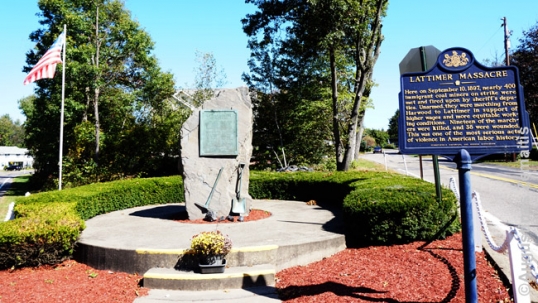

Memorial at the location of Lattimer Massacre
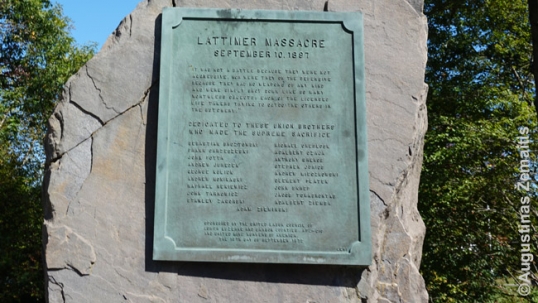

Lattimer Massacre site memorial list of victims


The start place plaque of the Lattimer march, with Lithuanian explicitly mentioned
A nice place to see a Pennsylvania Coal Region town that still looks much like the early Lithuanian migrants found them in the 19th century is the Eckley‘s Miners Village with its rows of wooden homes. It may be visited as a museum and the introductory film describes Lithuanians among its historic ethnicities. The entire town is being slowly converted into a museum as the vacated homes are not filled with new tenants.
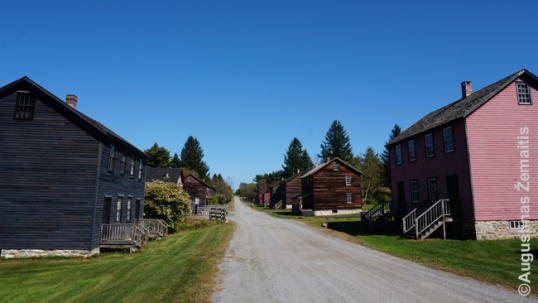

Eckley‘s Miners Village street
The map
All the Lithuanian locations, described in this article, are marked on this interactive map, made by the "Destination - America" expedition (click the link):
Interactive map of Pennsylvania Southern Coal Region Lithuanian sites
Philadelphia, Pennsylvania
Philadelphia is among the "most Lithuanian" cities in the USA and has the fourth largest total number of ethnic Lithuanians after Chicago, New York, and Los Angeles (~6000)
It has 3 great Lithuanian churches, pre-war art nouveau Lithuanian halls, a synagogue named after Vilnius, and an abandoned Lithuanian cemetery in its suburbs.
Lithuanian Music Hall in Philadelphia
The prettiest and the last one surviving among Philadelphia's Lithuanian clubs is its especially old (erected 1908) Lithuanian Music Hall, also known as Lietuvių namai ("Lithuanian House") in Lithuanian language and "Big Lit" in English (2715 E. Allegheny Ave). It is a separate red brick building inspired by art nouveau.


Lithuanian Music Hall in Philadelphia.
Inside, there are three halls, of which the upper floor one is the most impressive. It is named after M.K. Čiurlionis, Lithuania's most famous painter. Previously, it had full arched windows, but those have been partly bricked up during the war shortage times.
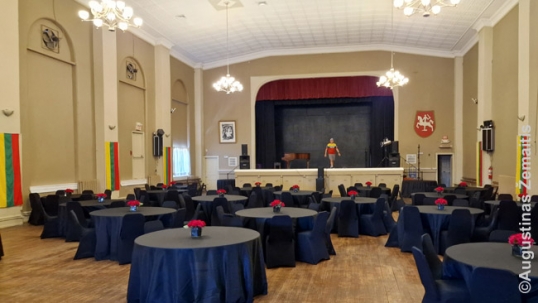

The upper hall of the Lithuanian Music Hall
In the basement, the Hall has an exhibition of Lithuanian arts, both folk and professional, and documents and maps related to the history of Lithuania and Philadelphia Lithuanians. This is the Surdėnas Lithuanian cultural center, established in 1980 and renovated ~2021. There is also a Lithuanian book library. You may also see the authentic heating system from the pre-WW1 era in that room.
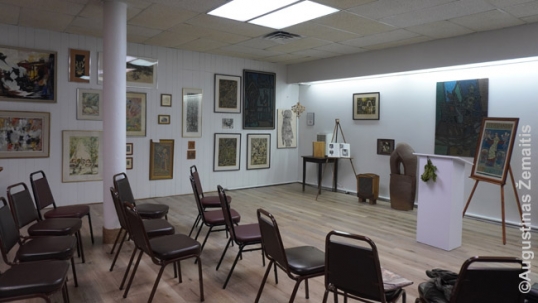

The basement museum of Lithuanian Music Hall
The hall hosts many Lithuanian activities and an annual fair. To this day, it also hosts Lithuanian concerts of the musicians arriving from Lithuania.


Musicla instrument detail at the Lithuanian Music Hall.
The surrounding district is mostly Polish (it is still strong on that identity). Poles too, however, come at the Music Hall's fair and other events.
In 2017, the Lithuanian Music Hall was in peril. There were plans by its mostly elderly owners to sell the building. However, seeing this, some new Lithuanian immigrants joined the organization and took over the management of the building, thus saving it as a Lithuanian cultural hub. The building was renovated.
Lithuanian National Hall in Philadelphia
The second Lithuanian Club of Philadelphia, known as the Lithuanian National Hall, used to be located close to 2nd Avenue. Its building still stands and the name is still chiseled in stones but it has been remodeled into apartments (the Lithuanian Club closed in 1984). In a way it's going back to the roots as when the Hall was completed in 1900 it also included apartments. Afterward, the expanding Club needs and rental halls had pushed the residential use out.


Lithuanian National Hall in Philadelphia.
St. Andrew: the grandest of Philadelphia's Lithuanian churches
Philadelphia still has all three of its Lithuanian churches open.
Towered neo-romanesque St. Andrew Church (1913 Wallace St.) still hosts Sunday mass in Lithuanian. The building has been acquired from Protestants in 1942 after the Great Depression and War shattered hopes of the parish to erect its own new building.


St. Andrew Lithuanian church in Philadelphia.
St. Andrew has a grand interior, the most impressive among Philadelphia's Lithuanian churches.


St. Andrew Lithuanian church in Philadelphia (interior).
Despite the non-Lithuanian origins of the building, St. Andrew's church has many Lithuanian details, ranging from a freestanding wayside cross outside to a true "Shrine of Lithuanian history" inside.
On that shrine, one may see a railroad going towards a cross, which is a symbol of the Soviet Genocide (1940-1953) when hundreds of thousands of Lithuanians, some third of them children and babies, were forced into cattle carriages and moved to the ice-cold Siberia where many of them died due to cold, hunger, forced labor, and other reasons.
There is also a cross with images of the victims of the January 13, 1991 massacre, a final Soviet bid to stop Lithuanian independence. Lithuanian civilians were stopping the tanks with their bodies then and many died. Vilnius TV Tower, one of the key locations Soviets attempted to take over, is also painted there. There is also the Our Lady of Vilnius in a folk-craft-inspired wooden frame and a Lithuanian flag.
Soviet Genocide is an important topic here, as much of the congregation has originated in the refugees who fled Lithuania before the Soviet re-occupation in 1944. These refugees always saw themselves as exiled people, as staying in Lithuania would have meant death to nearly all of them (or another exile to Siberia, a much worse location).



St. Andrew 'Shrine of Lithuanian history'. From left to right: American, Lithuanian, and Vatican flags; the Soviet Genocide painting; the Mary painting in a folk-craft frame; the TV tower painting; the cross with images of those killed in January 13, 1991.
The church also has Lithuanian religious images. Over the altar, Lithuanians Mečislovas Reinys (a Lithuanian priest killed for refusing to collaborate with the Soviets) and Marija Kaupaitė (the venerable founder of a Lithuanian-American nun order) are painted. Near the altar, Jurgis Matulaitis, a beatified Lithuanian has his image in a large folk-art frame. Outside, there is a Lithuanian wooden cross.


St. Andrew Lithuanian church in Philadelphia Mečislovas Reinys and Marija Kaupaitė over the altar, with a traditional Lithuanian sun-cross in between.
There are still some curious details left from the Episcopal era, such as numbered pews (in the Episcopal church, they used to be rented to families but in the Lithuanian church, anybody is free to sit anywhere). Before using this church, the Episcopals had a small church nearby. Today, it is also owned by the Lithuanian parish and used as a parish hall, as well as Vincas Krėvė Saturday school where Philadelphia Lithuanian kids learn the Lithuanian language and culture.
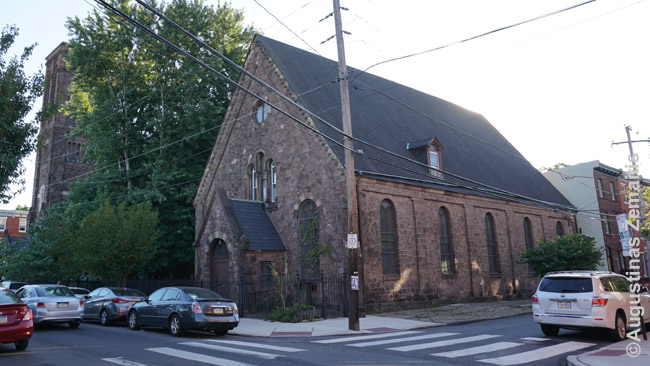

Exterior of the former Episcopal church (now St. Andrew parish hall and Vincas Krėvė school).
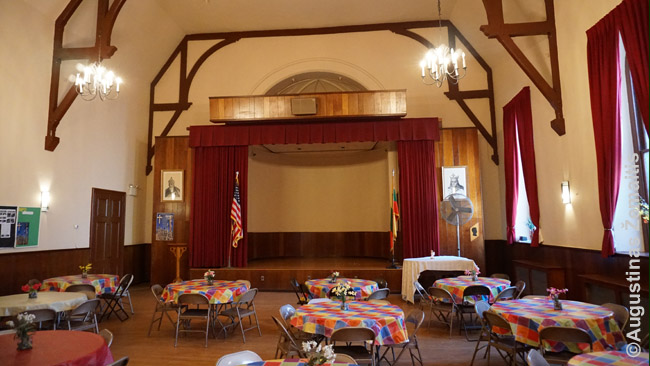

St. Andrew Lithuanian church in Philadelphia parish hall.
There were Lithuanian details even in the rectory of St. Andrew's, however, it has been sold ~2022.
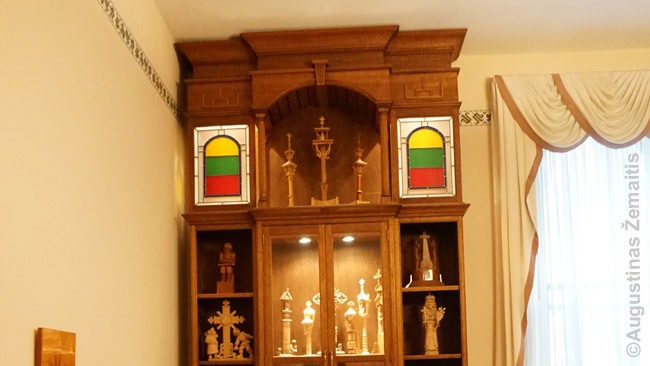

Lithuanian details at the sacristy of St. Andrew.
St. Casimir: the most Lithuanian church in Philadelphia
While St. Andrew Lithuanian church has many Lithuanian details, it couldn't compare with St. Casimir Lithuanian church of Southern Philadelphia (324 Wharton Street).


St. Casimir Lithuanian church in Philadelphia. A Lithuanian tricolor is waving nearby.
There, the Lithuanian details are nearly countless. At the entrance, a Lithuanian quote "Izenk geras, iseik gerensis" ("Enter a good person, leave a better one") greets the people. Inside, the stations of the cross are all done on Lithuanian designs, there are paintings like the opening of St. Casimir's grave in Vilnius Cathedral, there are stained glass windows of Marija Kaupas and much more.


St. Casimir Lithuanian church in Philadelphia stations of the cross, with Lithuanain inscriptions and Lithuanian traditional ornamentation. A Lithuanian tricolor is waving nearby.
In fact, nearly everything here has a relation to both religion and Lithuania. For example, among the images of the saints, blessed people, and the venerable, many are either from Lithuania or Lithuanian-Americans. The Lithuanian atmosphere was supported by priest Petras Burkauskas, a long-term Lithuanian priest in the church (1996-2021).


Altar of the St. Casimir Lithuanian church in Philadelphia. The slogoan on tops, surrounded by two Lithuanian flags, declares: 'St. Casimir. Wonderful on earth, more wonderful in heaven.'
Outside, there is a traditional Lithuanian chapel-post and the inscription at its bottom even describes it as having both Christian and Pagan motifs. This is a fact, as the Lithuanian folk motifs (such as the sun often found on the traditional crosses) are undoubtedly pagan-inspired even though undeniably Christian today. Yet, few churches dare to recognize this. However, Lithuanian-American churches are built on two pillars, religious and ethnicity, and that ethnic pillar includes the non-Christian Lithuanian history as well.


St. Casimir Lithuanian church in Philadelphia entrance. A Lithuanian tricolor is waving nearby.
St. Andrew is also the sole place among Philadelphia Lithuanian buildings where a Lithuanian tricolor is permanently waving.
St. Casimir is the oldest Lithuanian church (parish established in 1893) but the current building was erected after a fire in 1930. In 2007 its 100-year old school has been closed while in 2011 the parish has been amalgamated with St. Andrew but the church remaine dopen.
St. George: the church of blue-collar Lithuanians
St. George Lithuanian church (3580 Salmon Street) has two floors, the first of them built for a school and still used as such. Non-Lithuanian kids predominate now, but the entrance still has Vytis (the Lithuanian Coat of Arms) on it and there are other Lithuanian details inside. Stations of the cross have Lithuanian inscriptions, there is a medal to the Lithuanian king Jogaila and much more.


St. George Lithuanian church in Philadelphia.
The St. George church building was erected in 1920, with the school being preferred to a tower. The former church building stands nearby, now serving as a parish hall.
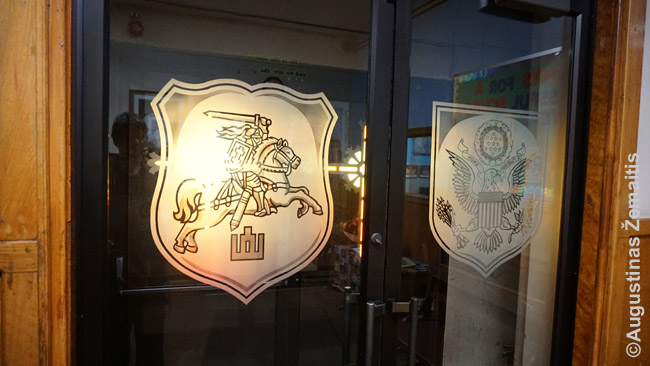

St. George Lithuanian church in Philadelphia. Entrance with the Lithuanian Coat of Arms.
Traditionally, St. George church used to be frequented by the blue-collar Lithuanian workers (in contrast to St. Andrew, which was a domain of intellectuals, especially the Soviet-Genocide-refugees). Therefore, it is the most modest among the three Philadelphia Lithuanian churches. Still, it has nice Lithuanian-donated stained glass windows with donors' names under them.
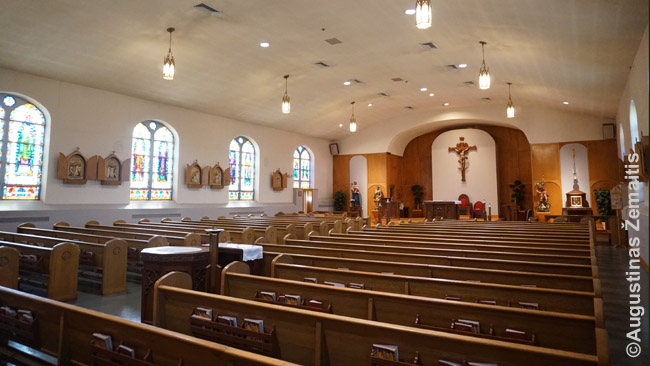

St. George Lithuanian church in Philadelphia interior.


The bottom of St. George Lithuanian church in Philadelphia stained glass windows with Lithuanian donors marked.
Vilna Congregation (Vilnius synagogue) in Philadelphia
A rather unique Lithuania-related site is the Vilna Congregation, named after Vilnius, the capital of Lithuania (Vilna being its old Russian name). This is a synagogue located in a house once owned by Shapiro, a Jewish person from Vilnius. He promised God that should his business succeed, he'd donate his home for the religion (and this is what happened). He cquired the building in 1915 and registered it as synagogue in 1922. The inscription chiselled in stone above the entrance reads (in Hebrew script) - "The Avraham Aba Bar Shapira and Men of Vilna Synagogue established in the year 5665".


Vilna Congregation synagogue in Philadelphia (exterior).
Eventually, the original "Men of Vilnius" who worshipped there have left the area and the synagogue is now kept by the Chabad Lubavitch movement. While it has few worshippers, the rabbis seek to keep it open.


Vilna Congregation synagogue in Philadelphia.
The word "Vilna" is still visible on numerous locations inside. The synagogue, however, has collected donor plaques from the area's other synagogues, so, not every plaque is originating at Vilna Synagogue. There is also the establishment charter on the second floor, as well as newspaper clippings about the synagogue's history and the images of the synagogue founders who came from Vilnius.


Vilna Congregation synagogue in Philadelphia plaque with 'Vilna' name mentioned.
The synagogue is usually closed outside of prayer times.
Lithuanian Republican Citizens' Club
Port Richmond neighborhood that is the home for St. George Lithuanian church as well as the Lithuanian Music Hall also has a third Lithuanian-originated institution known as Lithuanian Republican Citizens' Club. While it still operates, it now operates more as a private bar without ethnic activities. As of 2022, it has ~60-70 members of whom only one is a true Lithuanian. An abbreviation "L.R.B.C." is remaining on the sign outside (it means Lithuanian Republican Beneficial Club).


Lithuanian Republican Club
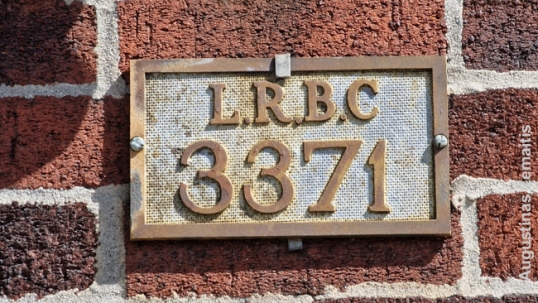

Lithuanian Republican Club abreviation
Bensalem abandoned Lithuanian cemetery (National Catholics)
The saddest Lithuanian site in Philadelphia is the abandoned Lithuanian cemetery at Bensalem suburb (est. 1926). Once owned by the unique and independent Lithuanian National Catholic church, the cemetery became abandoned after most Lithuanians returned from that church to the Vatican-led Roman Catholic church.


Bensalem Lithuanian cemetery entrance.
Currently, the cemetery is so overgrown that it requires a painful push through spiky plants to access some of the graves (what you see near the road is just part of the cemetery; the other parts are deeper into the forest). Still, that makes the cemetery unique and interesting to those who like such abandoned sites.
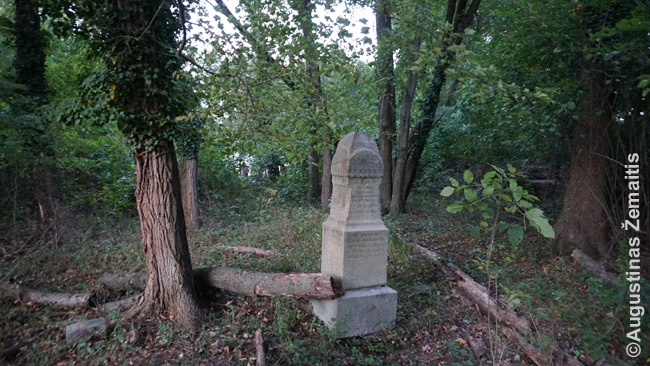

A grave deep inside the Bensalem Lithuanian cemetery.
The Lithuanian National Catholic parish existed in years 1926-1957 and had some 400 members at the start. Their St. Mary church was located at 331 Reed Street which is now an empty lot.
Lithuanian churches of Chester (PA) and Camden (NJ)
In addition to the Philadelphia's three Lithuanian churches in the city-proper, there were two more Lithuanian churches in the Philadelphia suburbs of Chester and Camden (NJ). Both of these buildings have been demolished, however. Chester church has been closed in 1972.
Villa Joseph Marie High School
Villa Joseph Marie high school was established in 1932 as a Catholic school for mainly Lithuanian girls by the Sisters of St. Casimir, a Lithuanian female monastic order of USA. It originally used the historic Maria Hall but got a new building in 1957. A nursing home used to stand on the grounds back then as well, now its former premises have been assumed by the school.
Lithuanian memorabilia near Philadelphia's Independence Hall
Philadelphia is the birthplace of US independence and, as such, it has inspired independence movements elsewhere in the world, especially so during the ~1850-1950 century when the global empires were slowly disintegrating. During World War 1, the opportunity to declare independence reached Lithuania and Central Europe. Thus, in 1918, delegates of various Central European nations, among them Lithaunians, met in Philadelphia to sign their declaration of common aims. This declaration is now exhibited in the museum of Philadelphia's Independence Hall.
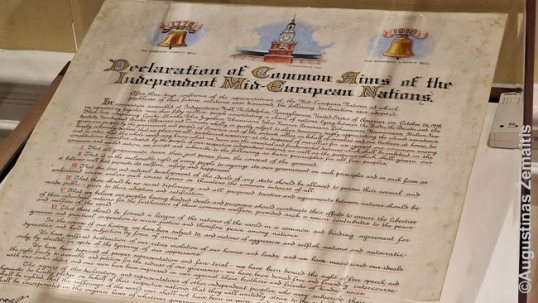

Declaration of Common Aims
Recommended literature: "Where Have All the Lithuanians Gone? A Study of St. Casimir’s Lithuanian Parish in South Philadelphia"
The map
All the Lithuanian locations, described in this article, are marked on this interactive map, made by the "Destination - America" expedition (click the link):
Interactive map of Philadelphia Lithuanian sites
Destination America expedition diary
|
Philadelphia may be the Lithuanian America as it once was. All three of its Lithuanian churches are open, two of them decorated elaborately with many Lithuanian details by their long-term priest Petras Barkauskas.
There is a Philadelphia Lithuanian school with its own premises, there is yet another Lithuanian priest Joseph Anderlonis (who guided us around), and the Lithuanian St. George Lithuanian parish still has its own parish school open. There is also the Philadelphia Lithuanian Music Hall, a great art nouveau-styled edifice with a lyre above its entrance. It is older than the Republic of Lithuania itself. And there is even a synagogue named after Vilnius – in a house donated by a Jewish man who made a promise to God to do that if his business succeed. The rabbi we met considered the synagogue’s survival quite miraculous on itself since it is so small and easily convertible back into a house; however, a cooperation of different groups of Jews made it possible. However, dangers are looming on top of the Philadelphia Lithuanian sites, as there are talks to sell the Lithuanian Music Hall, cutting its 110-year-old Lithuanian history for good. It would be a pity to lose yet another key Lithuanian-American site, especially since the Hall could be easily saved if there would be more cooperation among different groups of Lithuanian forces in America: if the “old Lithuanian-Americans” who are currently the ones caring for the Hall would be joined by the Lithuanian embassy and consulates, the “new Lithuanian-Americans”, the descendants of the “old Lithuanian-Americans”, the Lithuanian-Americans from outside Philadelphia, the non-Lithuanian Americans who are into heritage protection, and more. It depends on all of us to prevent Philadelphia from becoming yet another once-very-Lithuanian American city where barely anything Lithuanian remains! Augustinas Žemaitis, 2017 10 02. |


Tikslas - Amerika vadovas Augustinas Žemaitis su Filadelfijos lietuviais Šv. Andriejaus parapijos salėje
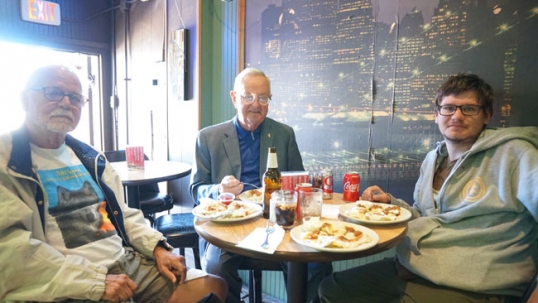

Tikslas - Amerika projekto vadovas Augustinas Žemaitis su Filadelfijos lietuvių muzikos salės atstovais
Michigan
Michigan has the 9th largest Lithuanian community in the USA (30 000). However, arguably, it has the most diverse Lithuanian history and heritage among American states. This is because Michigan has been home to very different Lithuanian-American communities and institutions, all that reflected in amazing Lithuanian sites that still exist all over Michigan.
In this article, we‘ll give a short introduction to each of those Lithuanian areas of Michigan and the stories behind them, as well as links to articles with extensive information. In the second part, we describe the history of Lithuanians in Michigan.
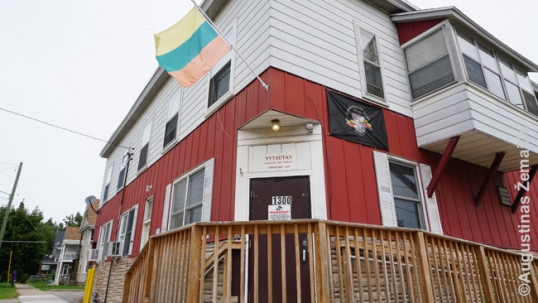

Vytautas Kareivis Aid Society building in Grand Rapids, operating since 1910
Lithuanian areas of Michigan
1. Detroit. By the number of Lithuanian churches erected, the Detroit conurbation falls into all of America‘s top five, with five churches, each of them surrounded by other Lithuanian buildings and memorials. Lithuanians were attracted there mostly by the automobile industry ~ the 1920s-1930s. Sadly, later history has not been kind to Detroit as the city has lost its industry and population. The controversial highway-building campaign led to the demolition of two Lithuanian churches. Racial riots and white flight led to the migration of nearly all Detroit Lithuanians to the suburbs ~1960s-1980s and Lithuanian churches and clubs of the inner city closed down ~1990s-2010s as the generation that still sometimes visited the places of their youth began dying out. A unique new suburban Lithuanian hub developed in Southfield though, combining a new church and secular institutions. Lithuanians also gifted a Lithuanian Room to Wayne State University. A few of the old inner city Lithuanian buildings have been restored albeit they no longer belong to Lithuanians.
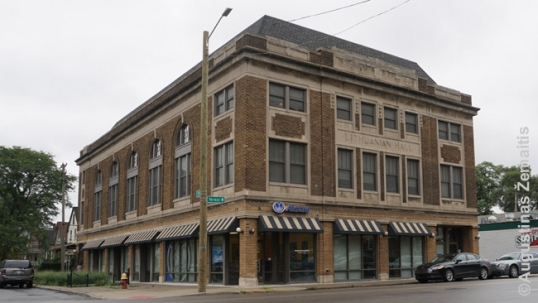


Detroit Lithuanian Hall (well-preserved although no longer Lithuanian-owned)
2. Grand Rapids. While Detroit is among America‘s worst stories of urban decay, Grand Rapids‘ Lithuanian district is among the least affected by it. That neighborhood underwent a slow assimilation (with the Lithuanian language being gradually replaced by English) but no hard hits of white flight. The original Lithuanian church, school, three clubs, and two cemeteries are thus all in operation, offering arguably the best surviving example of the First Wave Lithuanian-American district anywhere in the USA. In Grand Rapids, one may still get inside numerous century-old Lithuanian organizations rather than simply admire the remains of their magnificent buildings at best. Inside, you may still find many descendants of the original ~1920s Grand Rapids Lithuanians, even if these descendants now speak English and are often of only partial Lithuanian descent. By the sheer number of Lithuanians, Grand Rapids within the city limits is now #1 in Michigan (1000 in Grand Rapids vs. 400 in inner city Detroit).
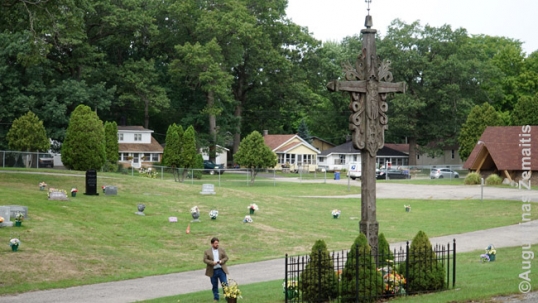

Lithuanian cross in Grand Rapids Lithuanian cemetery
3. Lithuanian camps. Arguably the most impressive Lithuanian heritage sites in Michigan. Originally built ~1950s as places for Lithuanian-American children to spend summers together in a Lithuanian atmosphere, they developed far beyond this original mission. Adults now come there to enjoy the „Lithuanian nature amidst America“, while generations of Lithuanian-American artists have transformed these areas by erecting various highly symbolic Lithuanian monuments and memorials. Camps „Dainava“ and „Pilėnai“ are located near Manchester and camp Rakas near Custer.
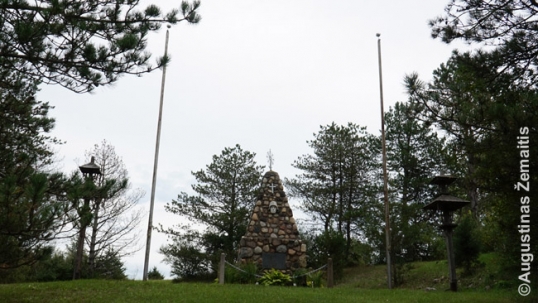

Monument for those who died for Lithuanian freedom at Pilėnai Camp
4. Custer. Lithuanian-Americans invested their wealth into land here to build a kind of „New Lithuania“. While they have not built separate Lithuanian churches or clubs, there were so many of them, that the generic institutions and buildings often have a Lithuanian flavor (e.g. local Catholic church was built by a Lithuanian architect and incorporates Lithuanian details). Lithuanian surnames are still quite common in the area, there are a few Lithuanian street names and memorials, while descendants of settlers still manufacture the Andrulis cheese.
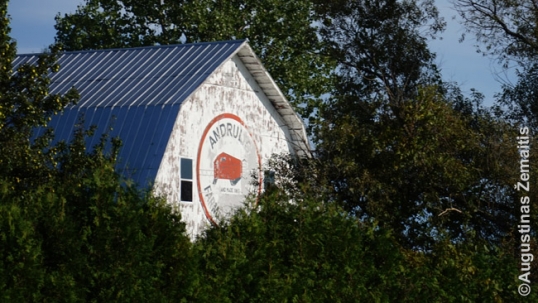

Andrulis cheese factory in Custer area
5. Union Pier. This Lake Michigan resort has more to do with the Chicago Lithuanian community than that of Michigan as it is located on the state border with Indiana. In the 1960s-1980s, Union Pier (together with a few other nearby resorts in Indiana) became the „Lithuanian Riviera“ or the summer capital of Lithuanian America, as Chicago‘s Lithuanians would send their wives and children to spend their summers here, sometimes visiting themselves. There were as many as seven Lithuanian hotels at one time, however, as plane travel rendered tropical Florida or Hawaii easily accessible, the popularity of „Lithuanian Riviera“ plummeted, and the Lithuanian resorts closed down one by one. Closer to Chicago, in Indiana, more of the „Lithuanian Riviera“ spirit remained as the Lithuanian holidaymakers were replaced by Lithuanian retirees and commuters.
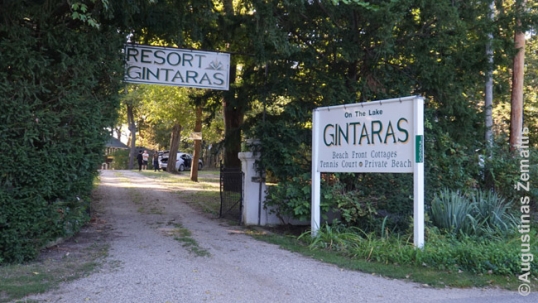

Gintaras Resort on the Lake, the last one of Lithuanian resorts (sold to non-Lithuanians ~2019)
6. Smaller cities. Several smaller cities of Michigan had Lithuanian populations, including Muskegon which still has a Lithuanian club, and Albion where a plaque commemorates Lithuanians. Nowadays, there are Lithuanian communities in many areas of Michigan, however, as these are quite new, there are no historic heritage sites.
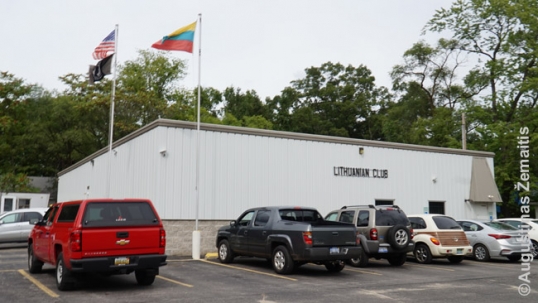

Muskegon Lithuanian club
History of Lithuanians in Michigan
Like elsewhere in America, Lithuanians came to Michigan in three waves.
The largest among them - the First Wave (1869-1914) - however, reached Michigan with a delay. That‘s because at the time these hundreds of thousands of Lithuanians were pouring into the USA, Michigan was still sparsely populated and offered few economic opportunities. So, instead of migrating to Michigan directly, First Wave Lithuanian-Americans typically settled down in Pennsylvania mining villages or the industrial cities of the East Coast, as well as Illinois.
Between 1899 and 1914, for example, only 3427 Lithuanians settled in Michigan, while Pennsylvania received 70019, Illinois - 47339, and New York – 37912. At the time, Grand Rapids was the main hub that attracted Lithuanians to Michigan.
As the roaring 20s were coming, though, the word was spreading about the massive new industrial achievements of Michigan, especially the automobile industry of Detroit. Attracted by higher salaries, Lithuanian-Americans would leave East Coast and Illinois mines and factories for Michigan in their thousands. During 1930, 4879 Lithuanians lived in Detroit alone.
Like in the East Coast, these Lithuanians stayed together, settling in the same districts, and erecting Lithuanian churches and clubs all over Detroit, as well as in a few other Michigan cities.



St. Anthony Lithuanian church. The building to the left is Lithuanian Hall. ©Augustinas Žemaitis.
Far from every seasoned Lithuanian-American of the 1920s-1930s dreamt only of bigger salaries in a more modern factory, however. After spending a decade or more in the US industry and earning enough, some of them hoped to finally realize the dream they had back in Lithuania: buy enough land to make a living as farmers. Michigan attracted these Lithuanians as well, as they have teamed up to buy farmland in the Custer area, effectively establishing America‘s only Lithuanian plurality or even Lithuanian-majority countryside area.


Lithuanian Quilt on a barn symbolises Lithuanian heritage of Custer
The Second Wave of Lithuanian-Americans arguably reinvigorated Michigan's Lithuanian life more than that of any other state. The Second Wave consisted of refugees who were forced to leave Lithuania in 1944 by the Soviet occupation and genocide there. Seeing themselves as exiles and wishing to perpetuate the Lithuanian culture in America even more than the First Wave, the Second Wave Lithuanians effectively established a „shadow Lithuanian state“ that united various Lithuanian institutions all over the USA. In addition to the „old local Lithuanian life“ of the Lithuanian parishes and districts, the Second Wave would establish pan-American Lithuanian hubs that would serve Lithuanians from far beyond and Michigan came to house numerous such hubs.
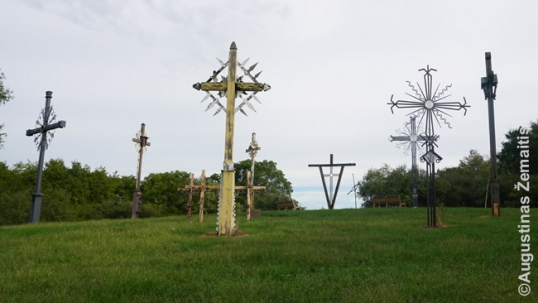

Hill of Corsses of Dainava Camp
In order to pass the Lithuanian language and culture to their children, they established a new type of Lithuanian-American institution, the Lithuanian camp, where Lithuanians (especially the kids) would spend parts of their summers in a Lithuanian atmosphere. The strategic position of Michigan countryside at the center of the Great Lakes area‘s major Lithuanian communities (Chicago, Cleveland, Detroit, Toronto) meant that Michigan was chosen as the place for a whopping three out of five Lithuanian camps in the USA.
The incoming of the Second Wave Lithuanian-Americans almost coincided with the decline of Detroit which was epitomized in its racial riots and white flight. All the Detroit‘s Lithuanian districts suffered greatly, and the inner city Lithuanian churches and clubs closed down (some were demolished to make way for highways that crisscrossed Detroit). However, the energy and patriotism of the Second Wave allowed to the 1972 construction of a new Lithuanian religious and cultural hub in Detroit suburbs, which became one of the last Lithuanian churches to be built in the Americas. In this church, religious space is actually smaller than the secular/ethnic space, accentuating the position of a Lithuanian-American church as a cultural hub that serves far beyond faith.
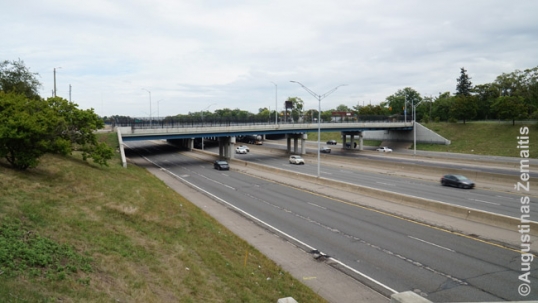


The site of the first Divine Providence Lithuanian church
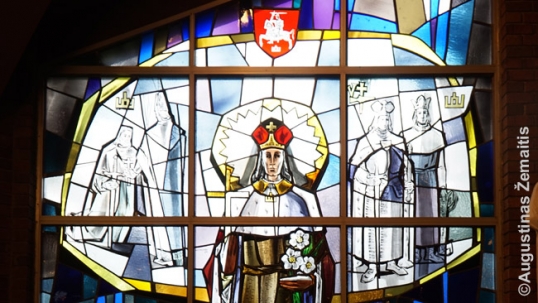


Stained glass window by V.K. Jonynas in the Divine Providence Lithuanian church, erected in 1972
By contrast, in Grand Rapids, the population shift was not as major, allowing the „Old Lithuanian district“ there to survive with many Lithuanian institutions intact, and showing how even in the same state Lithuanian history could develop in different directions.
Meanwhile, on the westernmost tip of Michigan, a Lithuanian resort has been developing in Union Pier ~1960s-1980s. There, Chicago Lithuanians would come to spend their summers or summer weekends and numerous Lithuanian beachside hotels sprung up. Some Lithuanians have settled in the area for good.



Divine Providence Lithuanian church of Southfield near Detroit
After the 1990 independence, the new „Third Wave“ of economic migrants began immigrating, and the Detroit area attracted many of them as well. They joined Michigan‘s largest Lithuanian communities and reinvigorated the key Lithuanian heritage sites: the Detroit area‘s Lithuanian church and the Lithuanian camps. Smaller communities (Custer, Muskegon, Union Pier) received few-if-any new immigrants, however, and Lithuanians who live there are typically descendants of the First Wave or the Second Wave.
Detroit, Michigan
Like other industrial cities of the USA, Detroit attracted a Lithuanian community well before World War II and even World War I. Detroit Lithuanians worked at the automobile factories of what was the world automobile manufacturing capital. It still is the home to Ford, General Motors, and Chrysler. During the 1930 census, 4879 Lithuanians lived in Detroit.
The old Lithuanian district of Detroit
For most of the 20th century, Lithuanian life in Detroit centered in the area southwest of downtown, today's Mexicantown, around the key institutions of St. Anthony Roman Catholic Church and the Lithuanian Hall.
St. Anthony Roman Catholic Lithuanian Church was built in 1920 in Southwest Detroit at 1750 25th Street. The massive brick building had two floors. The main church was on the second floor, while the first (ground) floor once housed a Lithuanian school. Later it was turned into a meeting hall, a small Lithuanian museum and a chapel where ordinary Sunday Mass was held. The diminishing parish no longer needed a main upper church; the elderly found it hard to climb the stairs. The church was closed in 2013 and now serves as a cultural center for modern day immigrants.



St. Anthony Lithuanian church. The building to the left is Lithuanian Hall. ©Augustinas Žemaitis.
A nicely renovated building on the opposite side of W Vernor Highway still bears the words Lithuanian Hall on its facade and there are some Lithuanian memorabilia surviving inside. Also surviving are the architectural elements such as the former ticket booth that would have sold to sell tickets for the events in the hall above, the stage and more. Redeveloped by the same non-profit real estate developer as St. Anthony church, the hall was transformed into its offices but the heritage was conserved well.



Detroit Lithuanian Hall
Originally the hall had been built in 1921 by the leftist Lithuanians who did not attend the church (while for the religious, the church doubled as a secular club and activity hub, the non-religious needed their separate institution for that). At least some of the members were communists, and the new owners discovered Lithuanian communist materials during renovation.


Main Hall now serves as an open office space. On one of the walls there is Lithuanian memorabilia.
It can only be assumed that, back then, Vernor Highway served as a frontline between the two opposing groups of Lithuanians: the religious majority and the anti-religious minority. With the popularity of leftist beliefs declining among Lithuanians, the Lithuanian Hall closed and was later used for community celebrations (holidays, weddings) by the parish.


St. Anthony Lithuanian Chruch (left) and the Lithuanian Hall (right)
Next to the Hall, there is Val Bauza Funeral Home, also an institution in the area.
However, like all over Detroit, some buildings are now abandoned or burned down. Detroit population more than halved after the 1967 racial riots and the city is now 85% Black (African-American). Most Whites, including Lithuanians, moved to the suburbs. The area around St. Anthony church is now, however, dominated by Hispanics and is known as Mexicantown. It is claimed by Lithuanians to be safer than the average Detroit area. While most Lithuanians moved to the suburbs, Mexicantown still has the largest percentage of Lithuanians in the Detroit city. Currently, it is the Hispanic population that the former St. Anthony church is serving the most, as the first floor is now taken by a charitable institution that teaches the recent immigrants English for free. At one point, merely some 30% of the district's buildings were being used, while now this percentage rose to 80% thanks to redevelopment by the same non-profit.
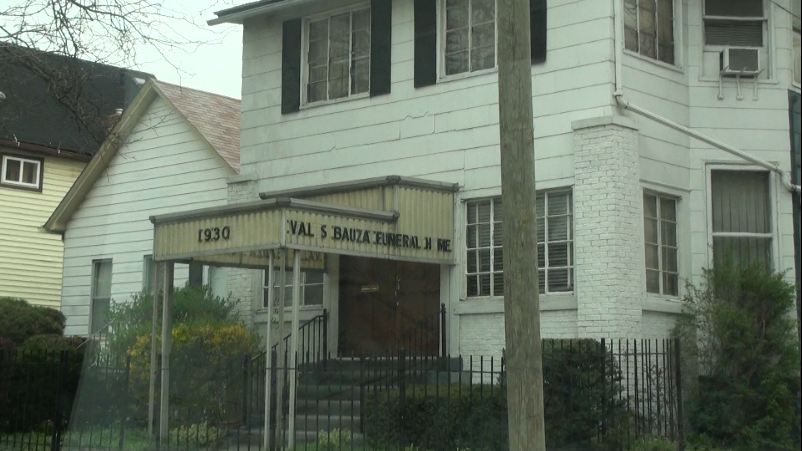

Val Bauza (Lithuanian name) Funeral Home. The house was constructed in 1930 when the city and the Lithuanian district were still thriving. ©Augustinas Žemaitis.
St. Anthony parish was at its peak immediately after World War 2 when a large number of the Lithuanian intellectual elite emigrated to the USA fearing Soviet persecutions. In these days, the church was too small for the congregation and many people had to participate in the Mass from outside the building. In some 1985, the church was damaged by fire but repaired afterward. Until 2009, the daily mass was still celebrated, twice daily on Sundays. However, in 2009, the priest retired and only a single weekly Lithuanian Sunday mass remained. There was no mass in any other language, therefore the building became scarcely used. In 2011, the bishop of Detroit decided to abolish the parish, which was done in 2013 as the parish was officially merged into the Divine Providence Lithuanian parish (see below).


St. Anthony Lithuanian Church main hall (2nd floor) interior as it looked before closure (2012). Currently, it is similar, but the religious and Lithuanian items, as well as pews, have been removed, and the premises are used for exercise classes and are available for rent for special events. ©Augustinas Žemaitis.
West of St. Anthony church, Detroit also had St. Peter Lithuanian church. The building, opened in 1921 and closed in 1995, has no Lithuanian details, although a publically-funded community center (All Saints Neighborhood Center) operating there since 1997, put up some historical plaques in the first room beyond the entrance. The church is wooden although during its late Lithuanian era its facade used to be covered in bricks. However, the original exterior has been restored now. In fact, the modest building was initially planned to be temporary but the parish never grew enough to build its own "permanent" and larger building. Like St. Anthony's, the church has a basement (dug by parishioner's hands) where Lithuanian used to meet after the mass. Church statues and furniture have been donated to Lithuania. So was a large Lithuanian style wayside cross that used to stand in front of the church.


St. Peter Lithuanian Church of Detroit
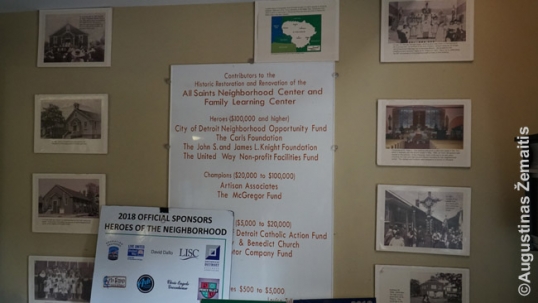

Lithuanian memorabilia in the foyer of the St. Peter Lithuanian Church
In this same area Darius and Girėnas Club was located. Operated mostly by the DPs (Lithuanians who fled the Soviet Genocide), it was established in 1962 and closed in 1996 as the white flight has emptied Lithuanian neighborhoods. Unlike the Lithuanian Hall near St, Anthony church, however, nothing visibly Lithuanian remained on this building as it had not been built by Lithuanians. Instead, Lithuanians acquired a 1914 Czech building, hence it is usually known as the "Bohemian National Home", and this name is on the facade bas-relief. After Lithuanians sold the building, it was used as a concert hall in an increasingly dilapidated district, with many surrounding homes blighted. Eventually, it was abandoned, by bought for redevelopment in 2010s.


Bohemian National Home (Darius and Girėnas Club)
Southfield Divine Providence Lithuanian complex
The current Detroit's Lithuanian church is Divine Providence located in the suburb of Southfield (255335 West 9 Mile Road). In fact, it is not simply a church but rather a complex of buildings, including a large events hall, a Lithuanian cultural center, a social hall, a small parish museum, a Lithuanian Saturday school, and several monuments. Many Lithuanian organizations use this venue for their activities, among them a folk dance group, a sports club, boy and girl scouts, Daughters of Lithuania, etc.



Divine Providence Lithuanian Church of Southfield
The complex was designed and built in 1972 by Lithuanian-Canadian architect Alfredas Kulpa-Kulpavičius. Initial designs were even more elaborate but the diocese-imposed costs-cap required the Lithuanian community to prioritize function over details. Therefore, the church lacks the "ethnic grandeur" of most other big-city post-WW2 Lithuanian churches but it still has many Lithuanian details inside. Among those are stained glass windows by the famous designer Vytautas K. Jonynas and wooden relief pieces by Jurgis Daugvila. Among the stained-glass windows, the most impressive is the one with St. Casimir and Vytis, while the wooden carvings depict the Hill of Crosses of Šiauliai and Blessed Jurgis Matulaitis.


Divine Providence Church interior


Woodcarving inside the Divine Providence Church



Stained glass window by V.K. Jonynas with patriotic motives, such as Lithuanian coat of arms
The complex of buildings is located in a spacious wooded area. Three Lithuanian monuments are close to the church: Jurgis Jurgutis memorial (who was the first honorary consul of Lithuania in Michigan), a traditional cross with a metal sun and the oldest one - statue of Jesus that had been relocated from the previous locations of the parish.
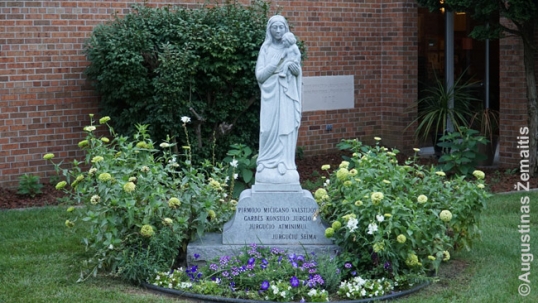

Sculpture dedicated to the consul of Lithuania Jurgutis


Lithuanian cross at the Divine Providence Church
Although the church and the other buildings of the complex have been built in 1972, the parish is much older than that. Unlike St. Anthony, the Divine Providence church has moved together with its community (two times). Its roots are in the St. George church within Detroit City limits (constructed in 1908).


The site of the St. George Lithuanian Church, one time at the northeast corner of Westminster and Cardoni Streets.
In 1949, a new Divine Providence church was constructed further from the center and Lithuanians moved there. During the 1960s highway construction program, plans caused both churches to be demolished to make way for more convenient city commutes.



The site of the first Divine Providence Lithuanian Church, at one time located on Schaefer Road near Grand River Avenue.
At the time, the bishop of Detroit did not want the continued existence of the ethnically Lithuanian parish, seeing ethnic parishes as slowly disintegrating (a fate then already suffered by numerous Polish parishes of Detroit). After lengthy discussions with Detroit Lithuanians, however, the bishop conceded that Divine Providence Parish would retain its ethnic status, with the stipulation that its membership would consist of Lithuanians only and its financial support would depend entirely on its parishioners. Lithuanians thus collected the necessary funds to build and support a new Divine Providence Church in Southfield.
Lithuanians who moved into suburbs and ceased visiting the city typically would also leave the then-remaining Detroit Lithuanian parishes (St. Anthony and St. Peter) and join the Southfield one. That's why the "urban parishes" had few parishioners and eventually closed, with only the Divine Providence parish retaining younger members and recent immigrants who invariably settled in the suburbs.
After St. Anthony Church was closed, many artifacts were salvaged and moved into the Divine Providence church.
Not far from the Divine Providence Lithuanian church there is the Holy Sepulcher cemetery where many Lithuanians are buried, some under rather elaborately patriotic tombstones.
Unfortunately, the idea to create a Lithuanian section in the cemetery failed to materialize, as a result, the Lithuanian graves are spread over several sections.
Other Lithuanian sites in Detroit
An interesting Lithuanian memento may be found in the eerily empty streets of downtown Detroit. On a building on the corner of Grand River Avenue and Times Square corner (Parker-Webb Building) hangs a memorial plaque with a sole Lithuanian inscription „Čia gimė Fluxus įkūrėjas Jurgis Mačiūnas“. The English translation is not provided (it would be „The founder of Fluxus George Mačiūnas was born here“). In reality, Jurgis Mačiūnas was born in Kaunas, Lithuania (1931) and emigrated to the USA in 1948. The plaque was installed by Gilbert Silverman, an avid collector of Mačiūnas works. He used to have his premises in the building. At one point, he decided to create a memorial plaque and gift it to Kaunas city where Mačiūnas was born; however, Kaunas never installed the plaque and, ultimately, it was sent back to Silverman by Mačiūnas's relatives. Then, Silverman installed it on the building he had premises at. Interestingly, this made the plaque kind of a Fluxus artwork on itself - a false memorial plaque for oneself in some random city is definitely consistent with Mačiūnas's style.


False Jurgis Mačiūnas memorial plaque
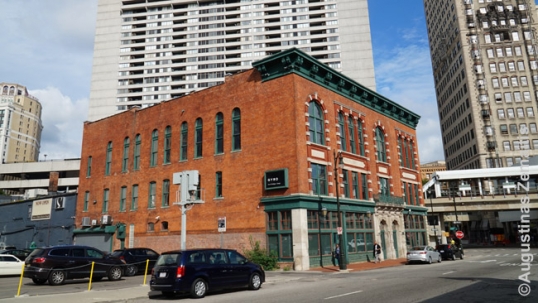

Parker-Webb building on which the Mačiūnas plaque is located
Wayne State University Detroit campus has a Lithuanian Room in its Ethnic Heritage building, the Manoogian Hall. The room is actually a classroom, room number 288, located on the second floor. It was established in 1978, an important year, marking the 60th anniversary of Lithuania's independence declaration in 1918. All of its walls are covered with murals symbolizing the essence of Lithuania. They include the major buildings (both extant and demolished), patriotic symbols, historical images (e.g. Battle of Žalgiris), ethereal famous creations of Lithuanian artist M. K. Čiurlionis, all grouped into three coherent scenes. The explanations of each detail in each mural are available in English. In addition to the murals, there are other objects of Lithuanian ethnic art.
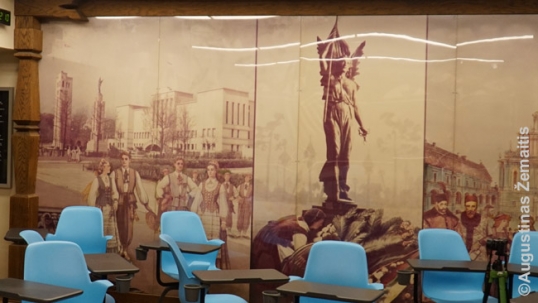

Fragments of the murals of the Wayne State University Lithuanian Room. On the left, one may see Lithuanians in national folk costumes in front of the Kaunas Vienybės Square. In the center, there is a close-up of the Liberty statue there and people laying flowers under it. On the right, there is Vilnius University and people of old era in front.
The room, however, has not been renovated for a long time, leaving parts of its details damaged and the informational plaque that explains all the details still declaring that Lithuania is under Soviet occupation. The building and the room may be accessed by everyone when there are no lectures inside. The designers of the room were the famous Lithuanian architect Jonas Mulokas, as well as his son, architect Rimas Mulokas, while Vytautas Augustinas created the murals.


Fragments of the Detroit Lithuanian room murals. Vilnius University on the left, while famous fortifications of Lithuania (Trakai Castle, now-demolished Vilnius fortifications) and the Battle of Žalgiris soldiers are on the right
While Hamtramck is traditionally considered a Polish neighborhood, like many Polish-American neighborhoods, it once also had a Lithuanian community. One building there (12000 Joseph Campau Avenue) still has a Lithuanian surname Smailis inscribed on it ("SMAILIS BLDG 1924"). Its original owner Juozas Smailis was a Lithuanian-American pharmacist and an important member of many Lithuanian societies in America. For his work in promoting Lithuanian culture abroad, he was even awarded the Order of Gediminas by the Republic of Lithuania.


SMAILIS BLDG 1924 plaque (Google Street View)
The elaborate Renaissance revival St. Francis of Assisi is a Polish church - however, its facade has a bas-relief with a Lithuanian coat of arms (Vytis). This is because the church was constructed in 1903-1905. At the time, both Poland and Lithuania were ruled by foreign powers (especially the Russian Empire) and the idea that the independent Poland and Lithuania should form once again a united Commonwealth (as they did before 1795) was not yet dead.
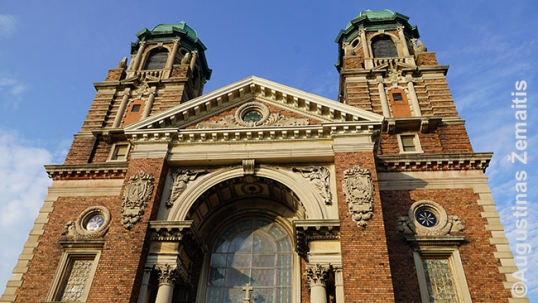

St. Francis of Assisi Polish church
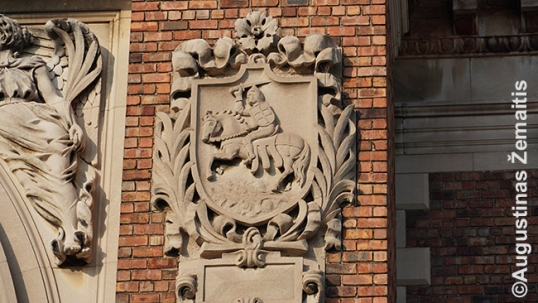

Vytis on the facade of St. Francis of Assisi
Another common institution of Lithuanians and Poles before the final divorce of two nations was the Orchard Lake Seminary. While today this 1910 complex consists of Polish schools and museums, until some 1910s the unique seminary was aimed at training priests for a wider array of ethnic minority Catholic churches, including Slovak and Lithuanian. Lithuanians left the seminary during or before the bitter Polish-Lithuanian conflict over Vilnius region in the 1920s-1930s. While some Lithuanian priests would still be educated there afterwards, there were no Lithuanian programs any more and no Lithuanian signs remain within the complex.
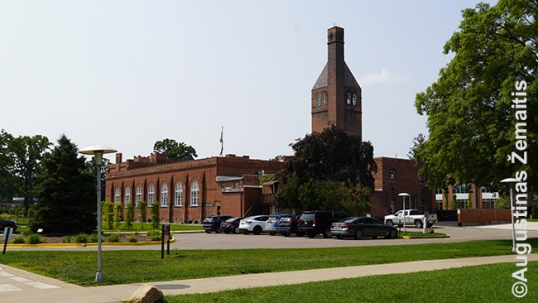

Orchard Lake Schools
In the University of Detroit Mercy Calihan Hall, Lithuanian-American Vince Banonis is listed in the University of Detroit sports hall of fame with his biography, image, and ball appearing there.


Part of Vince Banonis exhibit in the University of Detroit Mercy
The map
All the Lithuanian locations, described in this article, are marked on this interactive map, made by the "Destination Lithuanian America" expedition (click the link):
New York City, New York
New York (pop 8,5 mln., 14 mln. with suburbs) is undeniably one of the centers of the world.
By the time it received its first 100-floor building in 1931 the tallest "skyscraper" of Lithuania stood at 8 floors. New York must have truly impressed the contemporary immigrants from agricultural Lithuania.
New York was the "entry gate" for the hundreds of thousands Lithuanians who immigrated to America before World War 1, some 15000 settling in NYC for good and others just passing by. Being the world's largest city in the era of 1930-1950 when the Lithuanian Soviet Genocide refugees immigrated, New York attracted a fair share of them as well. Unlike some other once-industrial US cities, New York continued to be important and its Lithuanian community constantly renews itself.
Among the New York Lithuanian sites are numerous memorials and memorial plaques, some of them symbolically created in key locations to mark the importance of Lithuanian-Americans. There were 5 Lithuanian churches, 2 of which survive and are very impressively decorated. Several key Lithuanian organization HQs are located in New York.


Altar of the New York Transfiguration Lithuanian church. Lithuanian symboils such as th eflag, the sun-crosses and more are well visible
New York also played an important role in lives of numerous famous Lithuanians, giving birth to sites related to them. This includes the Transatlantic pilots Darius and Girėnas (who took off from New York for their famous flight), the writer Antanas Škėma (who wrote a semi-autobiographical work about a Lithuanian emigrant in New York that is now considered among the best Lithuanian books ever) and modern artists Jonas Mekas and Jurgis Mačiūnas (who developed their Fluxus art movement in New York).


Jogaila (Jagiello) statue in the New York Central Park
Queens and its modern-ethnic church
Even before World War 1, Lithuanians had their churches in New York. The most unique among the New York‘s Lithuanian churches is Transfiguration church (64-14 Clinton Avenue). Although originally constructed 1908, it was twice rebuilt (once after a fire and, after WW2, due to expanding Lithuanian community). The current building dates to 1962. It is an attempt to create a modern-yet-ethnic Lithuanian style, something impossible in Soviet-occupied Lithuania at the time and only existing in the USA. It is sometimes considered a magnum opus of architect Jonas Mulokas and interior designer V. K. Jonynas who also collaborated on multiple Lithuanian American churches in the 1950s Illinois. For this church, Mulokas received a prize from the American Architects Union, while the "New York Times" (1962 12 02) recognized it among the New York's best architectural works of the year.


New York Transfiguration Lithuanian church
While the building uses modern materials (brick, metal, and glass instead of wood), as well as modern designs (e.g. the statue over the entrance), it has countless Lithuanian symbols in nearly everything. Firstly, the form of the church itself reminds the traditional Lithuanian barn and so does its rooftop. The church belfry is similar to Lithuanian traditional wooden chapel-posts in its form. It is crowned by a Lithuanian sun-cross which also incorporates a moon (a merging of Lithuanian Christian and pre-Christian beliefs). Nearly all the crosses inside the building are also such sun-crosses (including a massive one over the altar). Over the church entrance, Lithuanian words „Mano namai – maldos namai“ greets the visitors („My house – Prayer house“) and the Lithuanian flag is perennially waving together with the US one. A traditional chapel-post stands in the churchyard; it is dedicated to Lithuanians who died for faith and freedom)


Pews adorned in crosses of Vytis at the Transfiguration Lithuanian church


Lithuanian-carved confession rooms at the Transfiguration church. V. K. Jonynas style
Inside the church, Lithuanian ornaments are visible even on the lights, while every pew has a Cross of Vytis on its side. Of course, there are images of Lithuania-related saints and religious traditions, such as St. Casimir. There is also a Lithuanian flag. A memorial plaque to the long-term pastor Frank Bulovas is immediately beyond the entrance. By the way, a street near the church (Perry Av) has an honorary name of Monsignor Frank Bulovas Avenue.
The church is open every day for mass.
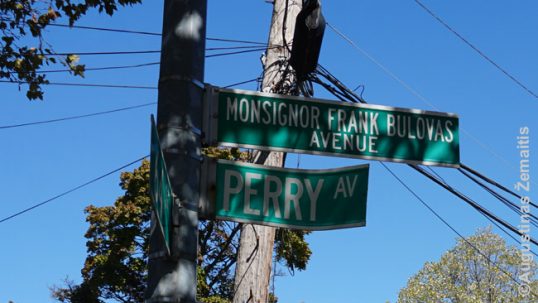

Monsignor Frank Bulovas Avenue sign
The building near the church houses the Lithuanian-American religious charity organization Lithuanian-Catholic religious aid. It distributes money donated by (mostly) Lithuanian-Americans to support Lithuanian religious activities; while Lithuania was occupied by the Soviet Union, LCRA was instrumental in supporting the "Chronicle of Catholic Church", which was not a chronicle per-se but rather an independent clandestine form of media that documented human rights abuses suffered by Lithuanians during the occupation.
Brooklyn‘s Williamsburg, the former Lithuanian district
Williamsburg in Brooklyn was a Lithuanian district in the early 20th century. While most Lithuanian institutions there have since closed down, two church buildings and a Lithuania square remain.
Brooklyn Annunciation Lithuanian Roman Catholic church is the hub of the district. It is a century older than the Queens church (built 1863, 259 N. 5th Street, architect Francis Himpler). It has been constructed by Germans and acquired by a Lithuanian parish in 1914. The interior has been partly redecorated the Lithuanian way: Blessed Jurgis Matulaitis and Gate of Dawn altars created (moved in from the other closed Lithuanian churches, as Annunciation remained the liveliest Lithuanian church in New York). There is also a mural of Our Lady of Vilnius, surrounded by Lithuanian ethnic strip and coats of arms of Lithuania and Vilnius (located at the left side of the altar; created ~1972 in place of a former nun balcony), and St. Casimir praying to its image (right side, 1929). Lithuanians have also added the top part of the altar and the stained-glass windows around the altar (1929 renovation). These meticulous details, together with the older impressive German details (stained-glass windows of 1870, 1860s nave-side frescos by the Munich court painter Esthel, etc.), attract many architecture-loving visitors to the church and it regularly participates in the „Open House New York“ events.


New York Annunciation Lithuanian church exterior


Annunciation Lithuanian church in Williamsburg interior


Our Lady of Vilnius with the coats of arms of Lithuania (left) and Vilnius (right), as she appears at the Annunciation Lithuanian church of New York


The Lithuanian altars of Jurgis Matulaitis (left) and Our Lady of Vilnius (right) at the Annunciation Lithuanian church in Williamsburg, New York
The mass is held in Lithuanian and Spanish (as the neighborhood has a large Hispanic population).
Outside of the church, a Lithuanian sun-cross and a Lithuanian chapel-post were erected. The chapel-post has a Lithuanian inscription „Šv. Marija, saugok Lietuvą ir jos vaikus“ („Holy Mary, save Lithuania and its children“) and a Rūpintojėlis (traditional Lithuanian sad Jesus) figure on top. Such Lithuanian Christian carvings (with some pagan details) are UNESCO immaterial World heritage. A plaque exlplains this artistic tradition in English.
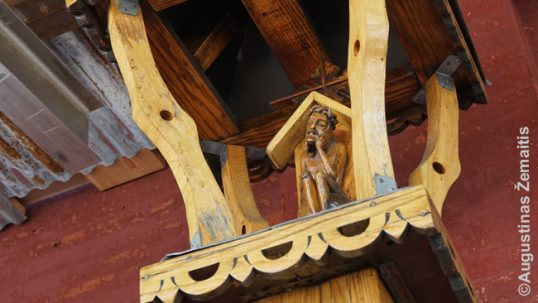

Rūpintojėlis at the chapel-post near the Annunciation church


Lithuanian sun-cross at the Annunciation church
Previously, a convent of Lithuanian nuns was located near the church (until being sold in 1975), however, it has closed, just like the Lithuanian school where the nuns taught at (1972). The square in front of the church is, however, still named after a Lithuanian nun Nicodema.


A small memorial for Nicodema at the Nicodema plaza
The number of parishioners declined from ~4000 families to ~1000 families in 1990 and ~250 families today.
Brooklyn also had a St Mary of the Angels Lithuanian church (corner of 4th S St. and Roebling St.), closed 1981, now El Puente Academy devoid of any Lithuanian marks inside or outside. A simple neoclassical edifice it was famous for the stained glass windows by sculptor V. K. Jonynas it had, most of which were then moved to Our Lady of Vilnius church in Manhattan (see below).


St. Mary of the Angels ex-Lithuanian church
In between of both churches is perhaps the last surviving Lithuanian sign in the area, „Bar Vasikauskas“ (the bar itself is long closed, however).
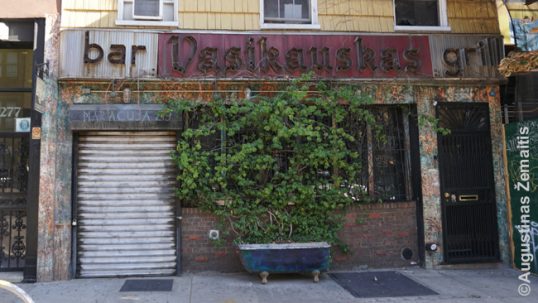

Abandoned bar Vasikauskas sign
Another key Lithuanian feature of Williamsburg, between the 2nd street, Hewes Street, and Union Avenue, is the Lituanica square, also known as Lithuania square, a small patch of land with a monument and flagpole (1957). It is dedicated to pilots Steponas Darius and Stasys Girėnas who became the first Lithuanians to cross the Atlantic by air and the pioneers of Transatlantic air mail. Sadly their 1933 flight which departed from New York Floyd Bennett Field (in Brooklyn southwest of Williamsburg) ended up in a tragedy near their destination in Kaunas, making them martyrs of both Lithuania and Lithuanian-American community. The monument includes a plaque with Darius and Girėnas faces, their Lithuanian quote „Šį savo skridimą skiriame ir aukojame tau, jaunoji Lietuva“ („We dedicate and sacrifice this our flight to thee, young Lithuania“). The monument has been funded by New York Lithuanians. The building next to the plaza that has LACC letters inscribed on its corner also used to belong to Lithuanians (the letters meaning Lithuanian-American Citizens Club).
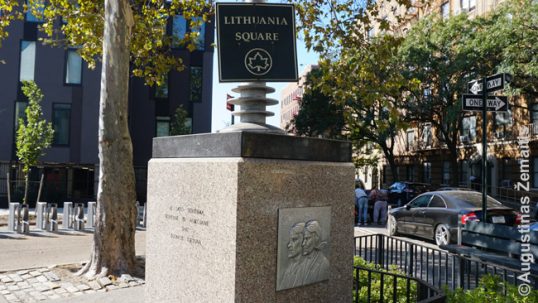

Lithuania Square main monument in Brooklyn


Cornerstone of the Lithuanian-American Citizens Club
Lithuania, independent by then, sought to build a symbolic wing in that airport in 2013 (70th anniversary) but the airport administration denied this. Only a memorial post reminds of Darius and Girėnas there, located in the green line of Flatbush Ave, erected by New York Lithuanian artists Laura Zaveckaitė and Julius Ludavičius in 2013. The airport itself is no longer used (as it became far too small for the New York City). However, currently, it is more like a park where everyone can walk or drive the former runways, see the crumbling hangars and the terminal building, all of which were some of the last ground-level sites seen by Darius and Girėnas.
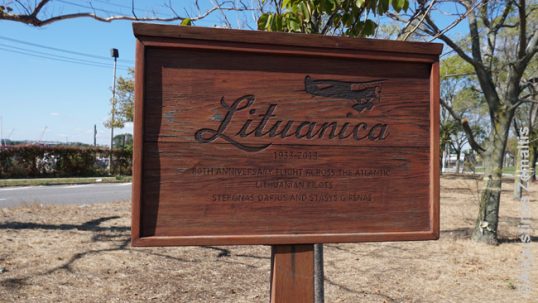

Lituanica memorial post by Ludavičius and Zaveckaitė near the Floyd-Bennet airfield
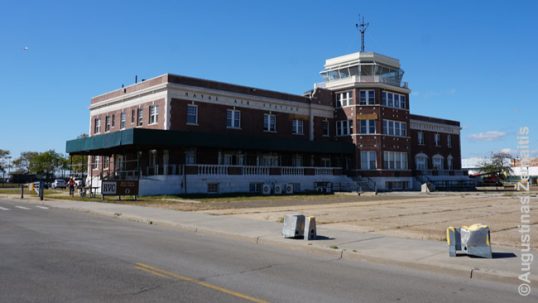

Floyd Bennet airfield terminal


The runway at Floyd-Bennet airport
Another Lithuanian location in Brooklyn outside Williamsburg was the Cultural Heart (Kultūros židinys), a building constructed in 1974 to be a heart of New York Lithuanian activities. It was constructed within the Lithuanian Franciscan monastery. There, the monks together with lay Lithuanians cooperated in furthering both religious and secular Lithuanian goals and countering the Soviet propaganda. However, after 1990 independence, Lithuanian Franciscan leadership was able to relocate back to Lithuania and it decided to raise money by selling the expensive Brooklyn monastery, including the Lithuanian Cultural Heart. This led to an expensive court battle between the monks and the Lithuanians who had donated for the Cultural Heart expecting it to serve the Lithuanian cause for far longer than ~20 years it did. Eventually, an agreement was reached that the monastery and the Heart would be sold, however, a part of the proceeds would go to Lithuanian-American secular activities. In any case, nothing reminds the Lithuanian past of the former Franciscan monastery and the Cultural Heart today. It is a non-Lithuanian monastery now.
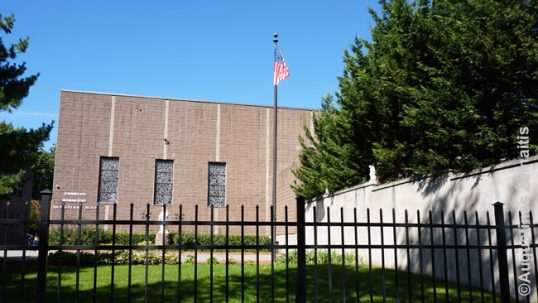

The former Lithuanian Cultural Heart in Brooklyn
The dead Franciscans of the monastery, however, remained in Brooklyn and a had a nice Lithuanian Franciscan monument constructed for them in the Middle Village St. John Cemetery. On one side, all the Lithuanian Franciscan brothers are listed and both Lithuanian and English names of the order presented. On the other side, a short history of how Franciscans went first to Lithuania and then to Lithuanian-Americans. The memorial is covered by a sun-shaped symbol and ethnic patterns.


Lithuanian Franciscan Memorial of New York
The demolished Lithuanian churches of New York
Unfortunately, some of the key Lithuanian locations in New York did not survive.
The most "infamous" Lithuanian church in New York is the gothic revival Our Lady of Vilnius (1910). This only Lithuanian church in Manhattan but it has been closed in 2007. The diocese plans to demolish it and sell the expensive land, triggering the largest Lithuanian-American protests since Lithuania became indpendent. The campaign included mass prayers, vigils, demonstrations attempting to save this "shard of Lithuania", among the last Our Lady of Vilnius churches of Lithuania. Even the Lithuanian president Valdas Adamkus, himself a former Lithuanian-American, protested to the Pope against the church closure. However, all these were unsuccessful and the church was demolished.


Our Lady of Vilnius church squeezed between massive skyscrapers. It no longer exists. Google Street View.
At about the same time, New York's fifth Lithuanian church, the Renaissance Revival St. George's, has been destroyed and replaced by apartment blocks without much attention, likely because of its less glamorous Brooklyn location. Google Street View of 2007 has the only online image of it.
Lithuanian institutional HQs in Manhattan
New York is also the home to a major Lithuanian secular institution. The Lithuanian Alliance of America HQ (307 W. 30th Street) is its small but well-located heart. Now surrounded by skyscrapers, the historic 19th-century four-floored building recently had its exterior renovated to its former glory. It was also listed in National Register of Historic Places, becoming one of very few Lithuanian buildings to become federally recognized heritage. A plaque now commemorates this inscription.


Lithuanian Alliance of America HQ building
The Lithuanian Alliance was the largest pre-war Lithuanian-American organization. It was founded in 1886 by the Lithuanian-American nationalists and leftists who dissented against the central role the Catholic church and its parishes played in many Lithuanian-American activities. Lithuanian Alliance has also served as a life insurance company for Lithuanians. Its membership has declined over the time since World War 2, however, as the new generations of Lithuanians were less likely to join. It went down from 11948 in 1955 to just 2446 in 2007 and merely several hundred today. The Alliance has abandoned its no-longer-lucrative insurance business to become a non-profit. The insurance business, once the major one, was severely hit by the Roosevelt's New Deal which made it mandatory for the employers to insure the employees (immigrants thus no longer needed the ethnic incurances, although these survived many decades afterwards due to people being used to them).
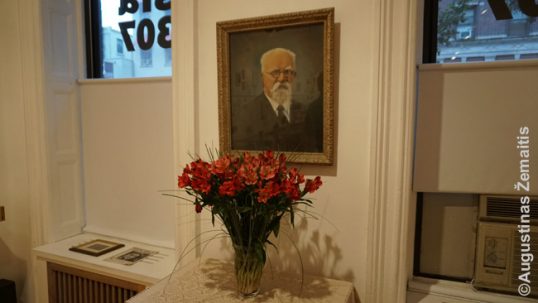

An image of Jonas Šliūpas at the Lithuanian Alliance HQ
In its basement, the Alliance HQ has a massive archive documenting as the former insurance business made it collect more information on its members than usual. Possibly useful for genealogy research, the archive is not fully digitized so far. The second floor has offices with some authentic interwar furniture (you may be allowed to visit if asked during working hours) and "Tautos fondas" Lithuanian charitable foundation, while the top floors have apartments that are rented out making the main profit for the Alliance today. The building also has a small yard which became a hub for New York Lithuanian festivities such as Joninės (midsummer festival) or the July 6th National Day.
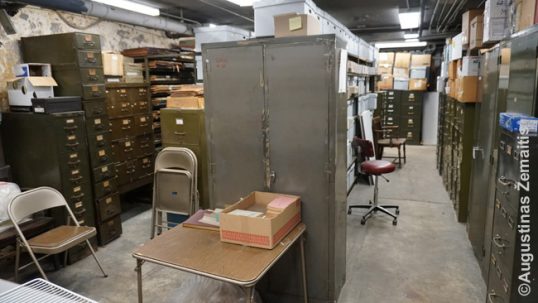

Lithuanian Alliance archives
Lithuanian Alliance publishes the oldest Lithuanian newspaper ("Tėvynė", since 1896), albeit currently the publishing dates are scarce and the printing is done outside the building. Sla 307 gallery is located on the ground floor of the building, celebrating Lithuanian art. It has regular working hours but you need to ring a bell.
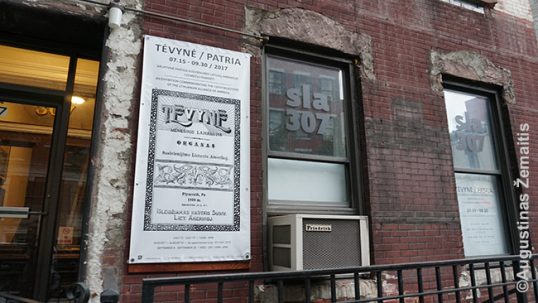

Ground floor of the Lithuanian Alliance in America with SLA307 gallery name
New York is also a political center. It is the location of United Nations HQ and thus the Lithuanian representative office to the UN (the Lithuanian flag, together with all the world's flags, regularly waves near the UN HQ). It also has a consulate-general. Both of those work on rental premises, however, and have no permanent Lithuanian details.


Lithuanian consulate interior
Manhattan Lithuanian memorials
In addition to the Brooklyn memorials for pilots Darius and Girėnas, there are many Lithuanian memorials in the key sites of Manhattan as well.
On a building next to the New York stock market in Broad Street (Manhattan), there was a commemorative plaque for the first famous Lithuanian-American Aleksandras Karolis Kuršius (better known in Latin as Alexander Carolus Cursius-Curtius). This nobleman established the NYC's first Latin school on the location (at the time New York was still a Dutch colony known as New Amsterdam). The plaque for him was created in 1976 for the US 200th anniversary and has been a part of a Lithuanian American struggle to widen the knowledge of the name "Lithuania" and its Soviet occupation. Sadly, the plaque has been removed in 2018.


New York City Stock Exchange where the Cursius plaque was located


Cursius memorial plaque as pictured by the Destination Lithuanian America mission of 2017
Before the massive immigration from Eastern Europe began in the late 19th century such isolated noblemen were the only Lithuanians to set foot on New York shore. One of them - Tadeusz Kosciuszko (Lithuanian: Tadas Kosciuška) - fought for US freedom before unsuccessfully attempting to defend his homeland Poland-Lithuania (united at the time) from European great powers. A commemorative plaque for him has been jointly funded by Lithuanian and Polish Americans in 1997. There are other sites named after him in New York, however, the other sites have no relation to Lithuanians.


Kosciuszko plaque in New York
Another Lithuania-related memorial plaque is on the floor of the New York Library at 476 5th Ave. It cites Martin Radtke, an immigrant from Lithuania, who had a few opportunities for formal education and so educated himself in the library, amassing a fortune he then bequeathed to the library. There is next to none information available about him online, however, save for the plaque. "Radtke" surname was, however, somewhat common among Lithuania's Germans, so it is likely Martin Radtke hailed from that community. It is possible that "Radtke" is a Germanized version of a Lithuanian surname Ratkevičius (Germanization of Lithuanian surnames was common in the German-ruled parts of Lithuania).


The grand interior of New York libarary at the place where Radtke's plaque is


Martin Radtke memorial plaque in the New York library
The first leader of both Poland and Lithuania, ethnic Lithuanian King Jogaila lived at the time America was not even discovered by the Europeans (1348-1434). However, New York Central Park includes a massive Jogaila statue, created by S. Ostrowski. It is one of the most impressive Lithuania-related sites in New York. Symbolically, it is a copy of a sculpture in Warsaw (Poland) that had been destroyed to make WW1 bullets. The Central Park sculpture was made to decorate Polish pavilion in 1939 New York Expo but while that Expo was still ongoing Poland itself was invaded and occupied by Soviet Russians and Nazi Germans. The property of Polish pavilion has then been transferred to the Polish museum but a joint request of New York mayor and Polish consul made it a gift to New York City. As the sculpture has been built by Poles the Polonized version of king's name is used (Jagiello) and the word "Poland" inscribed. However, the description of the king includes Lithuania, and the coat of Jogaila is covered in both Polish and Lithuanian coats of arms.
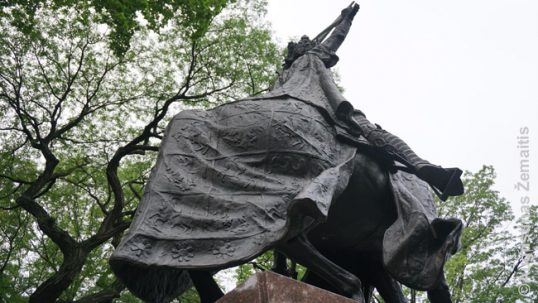

Close-up of Jogaila with Vytis visible
Anatanas Škėma and Lithuanian artists related sites
New York lacks a Lithuanian cemetery, however, the massive private Cypress Hills cemetery includes many Lithuanian graves, such as that of painter Adomas Galdikas. Arguably the most famous among those graves is the Grave of Antanas Škėma, one of the most famous Lithuanian writers. His semi-autobiographical existentialist magnum opus "White Shroud" described the toil and thoughts of an underemployed Lithuanian Soviet-Genocide-refugee in New York, who had to work in an elevator of a prestigious hotel despite being qualified to a white-collar work.


Antanas Škėma grave
Antanas Škėma is claimed to have worked in the elevator himself at the Roosevelt Hotel in central Manhattan. Sadly, the hotel was closed for good during the COVID pandemic.
It is often claimed that Antanas Škėma would be considered among the world's top 20th century writers had he written his work in English, as he effectively debuted existentialism. However, with his work in Lithuanian and accessible only to Lithuanian-Americans (having been effectively banned in the Soviet-held Lithuania), he had very limited readers. He was discovered in Lithuania after 1990 independence (and added to school literature programs there) but is yet-to-be-discovered in America (even many Lithuanian-Americans of today do not know him). Only in 2010s was his "White Shroud" translated into English for the first time.
Other famous Lithuanian-American artists who developed their careers in New York are the FLUXUS artists Jonas Mekas and Jurgis (George) Mačiūnas. Anthology Film Archives is a cinema established by Jonas Mekas which doubles as a repository for independent films.


Anthology film archives, established by a Lithuanian Jonas Mekas
There is also a Commemorative plaque of Jurgis Mačiūnas on the building in SoHo where he had his artist's community in 1967-1969 (16-18 Greene Street). At that time, this was a cheap district for cheap space yet today (thanks to the artist-led gentrification) it is among the more expensive places in Manhattan and any artist community here would now be unlikely.
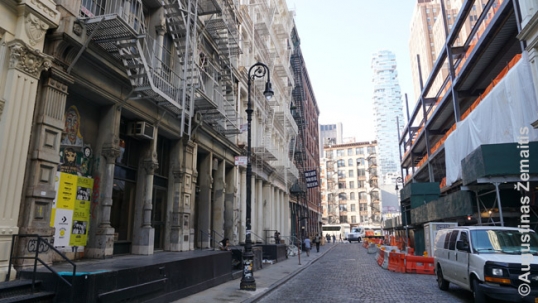

The building where Fluxhouse existed (on the left)


Fluxhouse memorial plaque
Ellis Island and immigrant memory sites
Not just for the Lithuanians, but for most immigrant ethnicities Ellis Island is important as a point through where 12 million immigrants came to the USA in the late 19th and early 20th centuries, among them hundreds of thousands of Lithuanians. The massive halls of the facility now host the US largest museum of immigration.
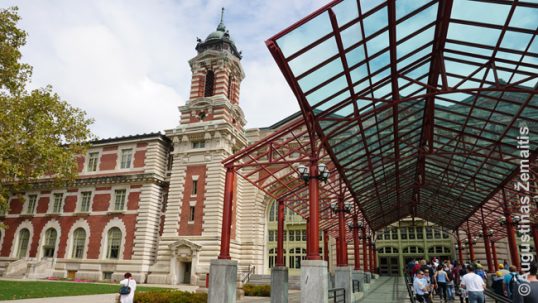

Ellis Island museum of immigration


Main hall of the Ellis Island immigration facility, passed by most Lithuanian-American pre-war migrants
Still, Lithuanians were among the smaller immigrant groups (compared to the Poles, Italians, Germans, Jews...), so, relatively little is available particularly on them in the Ellis Island. But the place is great for learning the experience many Lithuanian migrants had, epitomised in a local quote from an immigrant from Lithuania that basically says that emigration was similar to death in that you wouldn't ever see even your parents anymore.


A quote of a (most likely) Jewess from Lithuania at the Ellis Island museum
A rather new attraction in Ellis Island is the now-abandoned Ellis Island hospital which may be visited on tours. There, those who could be cured would be allowed to immigrate but those who couldn‘t be deported. At the time, health was almost the only one criteria which decided who would be allowed to immigrate to the USA, and the experience of Ellis Island hospital was universal for immigrants of all ethnicities, Lithuanians included. As the deportation of the unhealthy often meant separating families, Ellis Island was also known as the Island of Tears.


Images of immigrants as an art project at the abandoned Ellis Island hospital


Washing room of the Ellis Island hospital
Visiting Ellis Island is possible using the Liberty Island ferries everyday. The visit is easily combinable with the visit to Liberty Island.
In Ellis Island, one may understand the initial moments of how immigrants saw New York skyline and America, and how their first days there went by. On the other hand, in Manhattan's Tenement Museum it is possible to see how those lives continued in America, at least for the minority of the immigrants who stayed in New York City. The museum is established in an authentic 19th-century tenement block. The building has survived unmodified because it had been abandoned before World War 2. It has been reopened now as a museum with authentic public areas and restored apartments. Each of the newly-restored apartments is dedicated to some family that lived in the building and aims to recreate a particular moment of history. One of the restored apartments is dedicated to Rogarshevskys, a Jewish family that had immigrated from Lithuania. Lithuania is mentioned although not accentuated in the exhibit. However, the experience of immigrants of many Eastern European ethnicities at the time was essentially similar, as people were fleeing poverty and persecutions back home and moved to rather uniform tenement blocks of New York. From today's standpoint, life in these tenements may not seem to have been especially affluent either. However, compared to their homelands at the time, the tenement is somewhat elaborate, includes artistic interiors and nice finishing touches. The museum could be visited only with tours; each tour includes two apartments and lasts ~1 hour.


Tenement museum in New York
New York consists of five massive boroughs. Queens has ~6000 Lithuanians, Manhattan ~5000, Brooklyn ~3000, Bronx ~500, Staten Island ~750.
Lithuanian sites in Long Island
Since at least the early 20th century, Long Island has been the abode of the New York's rich. Some of them have hired Lithuanians as servants, giving the beginnings for Long Island's Lithuanian community, centered at Great Neck. The community would swell as people would tell their friends about job opportunities in the mansions. As the time went on, this community was joined by Soviet Genocide refugees (1940s), in many cases relatives of the earlier migrants. There were also Lithuanians who moved in from New York City and post-1990 immigrants.
That said, the Long Island Lithuanian community was never large or cohesive enough to build any buildings (churches or clubs) on its own. Instead, they relied on events in open spaces and multiethnic churches. The new immigrants typically merely replaced the older ones who moved out or assimilated rather than expanding the community.
Lithuanian heritage sites are therefore limited in Long Island but they include Wesey Ct street (actually named after a Lithuanian with a surname Vasiliauskas, who Americanized it to Wesey; the street was layed in his grounds) and the grave of tennis player Vitas Gerulaitis, the most famous Lithuanian who lived in Long Island.


Grave of Vitas Gerulaitis
The map
All the Lithuanian locations, described in this article, are marked on this interactive map, made by the "Destination - America" expedition (click the link):
Upstate New York
Many associates "New York" with the city but unlike the small neighboring states the State of New York is truly expansive (larger than the entire New England save for Maine) and merely a half of its population live in the NYC. The state's remaining part is nicknamed Upstate New York. It consists of smaller cities where the population has halved since the 1960s (total regional population remained the same).
Seven of these cities have old Lithuanian communities with old churches and cemeteries. Unfortunately, the recent years have been sad to them: local dioceses have closed all the Lithuanian parishes that survived a century or more. Not only the Lithuanian mass would be canceled but the buildings themselves were sold to other religions in many cases, destroying or damaging the Lithuanian-inspired interiors. Some exterior Lithuanian details often remain though.
The cemeteries, where they exist, still survive, offering a glimpse to Lithuanian surnames and their anglicizations.


Amsterdam St. Casimir Lithuanian chruch.
Mohawk Valley Lithuanian heritage
Mohawk Valley, a conurbation around the New York state capital Albany, had 3 Lithuanian churches, a chapel and 2 cemeteries.
With some 2,5% of its population of Lithuanian heritage, Amsterdam is the most Lithuanian city in the New York state. It has a large Lithuanian cemetery (Cemetery Rd.), unique for having many of its gravestones inscribed with two surnames: one original Lithuanian and the other one Americanized (i.e. the one immigrants were made to take by the immigration authorities who misheard the surname).


Amsterdam cemetery in New York. This grave has both the Lithuanian (Balčys) and Anglicized (Baltch) surnames marked, and the Lithuanian sun-cross as an ethnic symbol that unites Christian and Pagan beliefs.
At the heart of the cemetery stands St. Anne chapel commissioned by a Lithuanian Kiškis for his beloved wife and built by a famous Lithuanian-American author V. K. Jonynas in 1971. It now serves as a location for the funerary rites with are banned at the graveside in the diocese (previously it also served for the storage of the dead bodies through the winter). The exterior has Lithuanian inscriptions and the Lithuanian sun-cross, a traditional Lithuanian ethnic symbol, as well as bas-reliefs of St. Anne and St. Casimir (with the Lithuanian names of these saints written, Ona and Kazimieras).


St. Anne chapel in the Amsterdam Lithuanian cemetery of New York. The facade incorporates the Lithuanian sun-cross.
The cemetery also has a memorial for local Lithuanians who died in America's wars (6 in WW1, 17 in WW2 and 3 in Vietnam, according to the inscribed surnames).


A memorial for the Lithuanians who died in America‘s wars at the Amsterdam Lithuanain cemetery.
Amsterdam St. Casimir church has been sold to Buddhists after its closure; they established the Five Buddhas Temple there. The community leader Lucas Wang (a.k.a. Holy Master Ziguang Shang Shi) claimed that he received a revelation to purchase the church. United into the World Peace and Health Organization the local Buddhists plan a massive expansion that will even include theme park - but the fate of Lithuanian details of the St. Casimir church is likely sealed. Amsterdam Buddhists typically don't allow outsiders inside, although some sources claim the stained glass windows remain there. The most striking reminder of Lituanity is the St. Casimir statue with Lithuanian inscription on the tower.


St. Casimir statue still remaining on the Amsterdam Lithuanian church facade, with a Lithuanian inscription.
Previously the church area hosted other Lithuanian institutions such as Pakėnas laundry, Piliponis grocery. Today their owners are probably resting in the St. Casimir Lithuanian Cemetery.
The Lithuanian memorabilia from the church (once collected by the priests who visited Lithuania) had been relocated to Walter Elwood museum of Amsterdam history, where many artifacts are presented in a former factory (one in which many Lithuanians surely worked as well).
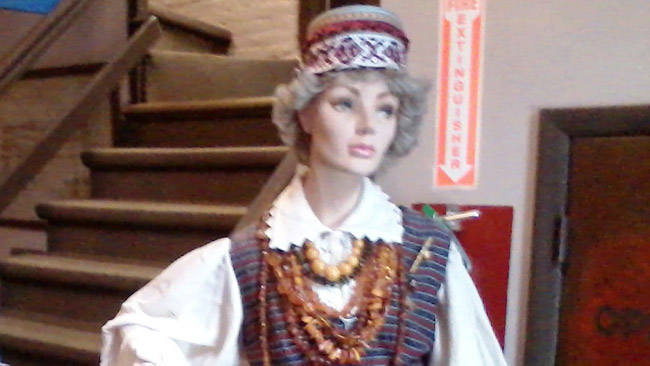

A Lithuanian exhibit in the Walter Elwood museum.
The Lithuanian church building with a dome survives in Schenectady, another Mohawk Valley city (Holy Cross church, 19 N. College Street). It doesn't look like a church as it was built to be a synagogue in 1891; in 1920, however, Jews sold it to Lithuanians as they built a bigger synagogue. Currently, nothing reminds of the buildings many-decades-long Lithuanian history after it was transformed into a stained-glass workshop. A large Lithuanian wooden wayside cross that used to stand outside has been removed or destroyed.


The former Lithuanian church at Schenectady.
Schenectady also has a rather small Holy Cross Lithuanian cemetery (est. 1930). As the parish also had, in later stages, many Italians as its members, the cemetery also has Italian graves. Throughout its history, however, the parish remained mainly Lithuanian and was not rededicated to any other ethnic group.
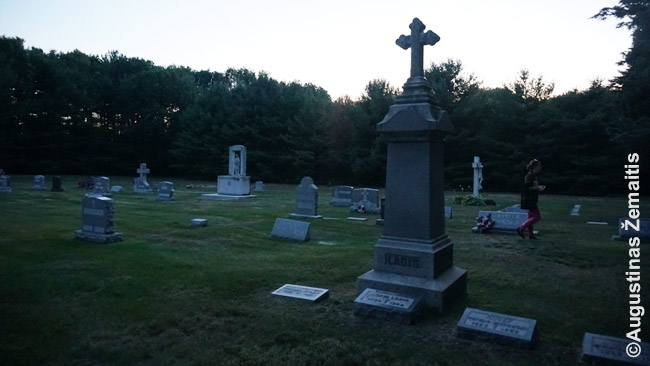

Lithuanian cemetery at Schenectady.
Schenectady is a suburb of the state capital of Albany. Albany itself had a Lithuanian church of St. George once (corner of Thornton and Livingston streets). Built in 1917, it has been closed in 1986. Today the building is used as a community center/soup kitchen dedicated to Sister Maureen Joyce. Blessed Mary statue from the original church, as well as a plaque reminding of Lithuanian history, remains (immediately beyond the entrance) but the interior was destroyed. According to priest Valkavičius who documented Lithuanian churches, the interior used to be shown to architecture students in how to create a grandeur with little available as the church had a pretty tin ceiling. All that was destroyed when transforming into the soup kitchen, however, due to fire prevention requirements (sprinkler installation). Stations of the Cross have been moved to the Lithuanian camp Neringa chapel in Brattleboro. That said, the Albany church was never especially rich in decor, as it was basically just a basement with a wooden belfry: the community never did build a full church which was planned on top of the current church. Therefore, the church never even had stained glass windows.
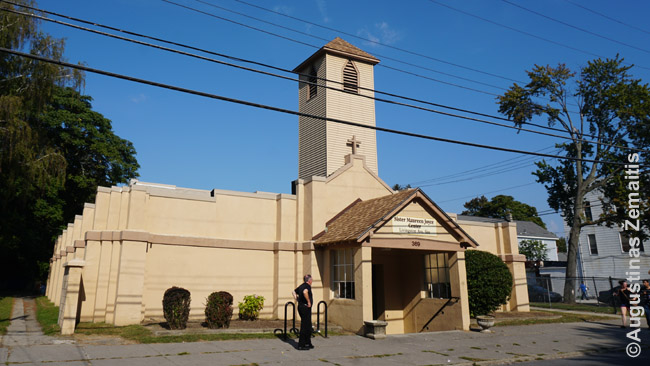

Albany St. George Lithuanian church.
Rochester Lithuanian heritage
Rochester is arguably the liveliest Lithuanian community in Upstate New York and is only second to Mohawk Valley in Lithuanian heritage. Rochester attracted most of its ~400 Lithuanians ~1900 as they have been fleeing hard labor in Pennsylvania mines.
The historic hub of the Rochester Lithuanian community was the St. George Lithuanian church. Like many Lithuanian-American churches, it began as a community praying at other churches, until it has acquired land and built a multi-purpose building.
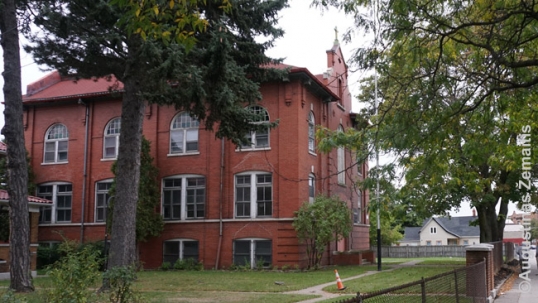

The initial St. George Lithuanian church, later St. George Hall
That building, known as the St. George Hall (erected 1910), is a 3-floored edifice that used to contain church hall, Lithuanian school, an events hall and, since 1976, a Lithuanian Ethnic Museum. The Lithuanian Hall was sold in the 2000s to a Puerto Rican community. Nothing Lithuanian remains at the outside but the event hall still has a Lithuanian coat of arms (as of 2019).
In the late 1920s, Lithuanians planned to expand their church but opted to build a new one nearby, thereby leaving the old building just for the school and events.


Rochester St. George Lithuanian church
The St. George Lithuanian church of Rochester has been built in 1934. It has been sold to Puerto Ricans in the 2000s, together with the Hall and other buildings on the lot. It now serves as a Hispanic independent non-denomination Christian church, however, the stained-glass windows with Lithuanian inscriptions remain inside. Some of the Lithuanian details have been removed by Lithuanians themselves, including the entrance stone and the murals of Our Lady of Šiluva and Our Lady of Vilnius that used to be above the altar. Many of such items, as well as the items from the Lithuanian museum, have been sent to Lithuania according to the local community, although it is unclear where they are now.


Original stained glass window depicting the Vilnius Three Crosses monument
The former Lithuanian lot also has a rectory (without any Lithuanian details) and it had a wooden Franciscan monastery which has been demolished.
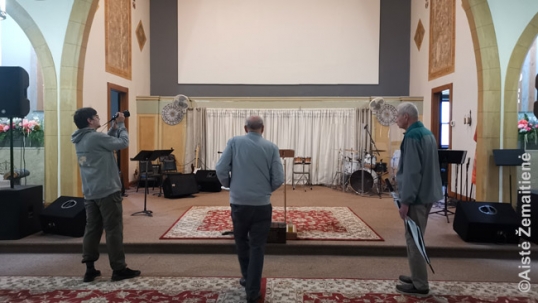

The murals around the altar (over the side-doors) were removed by Lithuanians before the transfer of the building. The walls are thus now empty. The murals used to depict Our Lady of Vilnius (Gate of Dawn) and Our Lady of Šiluva, two major images of Maryan devotion in Lithuania
As the 20th century progressed, the district where the Lithuanian complex was located gradually became ghettoized. The Lithuanians generally moved out in some 1950s-1960s but they continued to come for the Mass and the events. There were proposals to move the church in some 1970s but they did not come through as the priests changed. As the district deteriorated further and the number of Lithuanians declined through intermarriage, it became harder and harder to keep the church going. The financial crisis of 2008-2009 proved to be the final hit, as donations dwindled. Unlike in many other places, however, it was not the diocese that closed the Lithuanian church but rather the parish itself. Officially, the parish remained, however, it now uses another church of Our Lady of Lourdes for its masses.


Lithuanian cross at Our Lady of Lourdes parish, moved from the old St. George church
Such an arrangement allowed to move some of the Lithuanian character from St. George Lithuanian church to the Our Lady of Lourdes Church. In Our Lady of Lourdes, there is a traditional Lithuanian cross at the entrance (moved from St. George and dedicated now to St. George church), as well as some of the articles from St. George Hall Lithuanian museum, as well as a small Lithuanian library and school. There are now „shrines“ to Our Lady of Vilnius as well as a symbolic Lithuanian memorabilia shelf there.
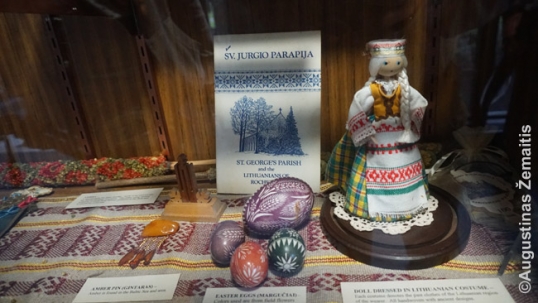

One of the Lithuanian memorabilia shelves at the Our Lady of Lourdes parish
The memorial to Lithuanian war veterans that used to stand in front of the St. George Hall has been relocated to Holy Sepulcher cemetery near the US veteran graves. The memorial was constructed in 1952 by the Gudinas post of the American Legion. While the American Legion is a US veteran organization, this particular Rochester post was named after a Lithuanian war veteran Jonas Gudinas and consisted of ethnic Lithuanian US veterans. Jonas Gudynas was born in Raguva, Lithuania, in 1891, immigrated to Rochester in 1910, joined the American army in 1918 and was killed in France the same year, less than a month before World War 1 ended.


American Legion Gudinas post memorial
Rochester also had a Lithuanian Gediminas club that was associated with the leftists. The building, located on the corner of Joseph and Clifford streets and acquired by the club in 1912, has been demolished as the club was closed down sometime in the 1960s. Near the Gediminas club, the racial riots (Black uprising) of the 1960s took place, one of the events that brought down the district.
In order to perpetuate Lituanity after all the Lithuanian buildings were closed, ~100 Rochester Lithuanians have established a Lithuanian Heritage Society. In 2010 the city established sister ties with Alytus, Lithuania.
Niagara Falls Lithuanian church
Merely 2 km from the world-famous Niagara Falls one may see a century-old Lithuanian coat of arms proudly chiseled on a pediment of a rather grand neo-classical building (1910 Falls Street).
The building used to be St. George's Lithuanian church. Some 100 years ago, the Niagara Falls were used to power industry and many Lithuanians immigrated to staff it. They have built this church as their community hub in 1928. The church reminds of a Greco-Roman temple on the outside. There are Lithuanian details both inside and out. Outside, in addition to the pediment Coat of Arms, there is a small monument dedicated to Rev. Francis J. Aukstakalnis, the Lithuanian priest who served there. Inside, there are 14 stained-glass-windows mostly with Lithuanian inscriptions.


Niagara Falls St. George Lithuanian church
Unfortunately, ~2010 a parish reform in Niagara Falls left 9 Catholic churches open out of the previous 21 (in 1960 the city had a population of 102 394, 2010 census counted merely 50 193). Niagara Falls St. George Lithuanian church has been among those closed. Its congregation peaked in 1971 and then began declining as the entire town became poor and unsafe. Ultimately, the building has been sold to the Independent Anglican Church (Canada Synod). This small Christian community left the St. George dedication untouched and even invited the Lithuanians to continue using the premises. No interior details have been destroyed; on the contrary, the new owners felt sad that Roman Catholics removed some pieces upon closure.


Pediment with Lithuanian coat of arms at the Niagara Falls Lithuanian church
The new owners Independent Anglican church (Canada Synod) have formally elevated the church‘s status to that of the cathedral: the church is actually now the main bishop‘s (Primate's) seat of the entire denomination that consists of more than 10 parishes, some of them as far away as Mozambique.
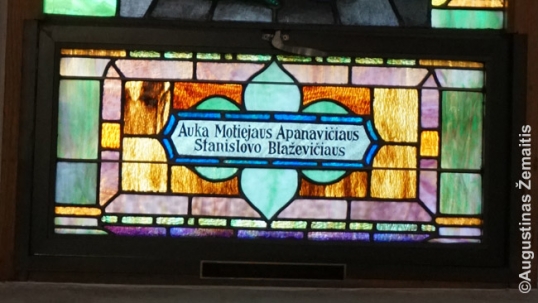

Lithuanian donor names on the stained-glass window of Niagara Falls Lithuanian church
St. George Lithuanian church is, however, located in what is considered a bad district where crime and urban blight is rampant. As such, the church has few faithful attending its Mass while its primary mission now is charity for the inhabitants of the area. Many lots are now empty in the surroundings with their buildings destroyed yet the St. George Lithuanian church continues to have use and purpose.
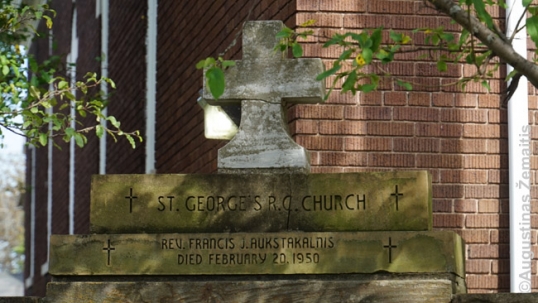

Memorial to the former priest outside of the church
Utica Lithuanian church and cemetery
Utica city of New York state has both Lithuanian church and a Lithuanian cemetery (one of merely three Lithuanian cemeteries in the entire state of New York).
Utica St. George Lithuanian church is a small building dating to 1967 when it replaced an older church. It is one of the smallest Lithuanian churches in America. It has been closed in 2007 and stands empty.


Utica St. George Lithuanian church
St. George Lithuanian cemetery is where the members of the Lithuanian parish used to be buried and one may see many Lithuanian graves there, although nearly no Lithuanian inscriptions or those mentioning Lithuania as the cemetery was established after the Lithuanian-Americans who came before World War 1 (the bulk of Utica community) were somewhat assimilated.


A grave inscribed with 'Born in Lithuania'. Given the later date for establishment of the cemetery such inscritions are rare.
The gate has an English-only inscription and is dedicated to Balutis family. There are many Lithuanian surnames.
The cemetery is located along the same road as many other ethnic and minority cemeteries of Utica.


St. George Lithuanian cemetery in Utica
Binghamton Lithuanian heritage
Lithuanians (~500) also live in Binghamton. This community's history is similar to its many "siblings" in Upstate New York. It began before World War 1 and the highest point of Lituanity was in the 1930s. This golden era is still reminded by a dusty inscription "Lithuanian Natl. Assc. Inc." on a ~1917 building at 315 Clinton Street. While the building has few surviving Lithuanian details, it is otherwise very authentic; so authentic, in fact, that it is one of the very few Lithuanian buildings to be inscribed into the USA's National Register of Historic Places. What served Lithuanians as offices and event hall, now serves the local Tri-City Opera which has acquired the building in 1964 and used it as its base since.
City landmarks list also lists "Sokolvonia" building (~1939) as Lithuanian although a likely Slavic name may indicate a mistake.
Subsequently, the membership of many Lithuanian organizations grew older, the usage of Lithuanian language grew limited to ethnic events. However, many still guarded cherished folk customs and amber jewelry as something that reminded them of their homeland. The arrival of refugees after the occupation of Lithuania (~1950) triggered a limited rebirth of Binghamton Lituanity. However, the DPs left the Upstate New York for work-laden major cities once they could.
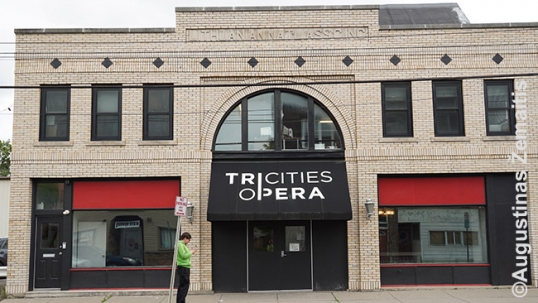

Binghamton Lithuanian Association building


Remaining Lithuanian inscription on the Lithuanian club.
Like elsewhere, the church life survived the longest in Binghamton. The modern facade of St. Joseph Lithuanian church (1 Judson Ave, built in 1949-1950) still has a Lithuanian inscription over its doors. However, the building has been sold to Grace Tabernacle church in 2008. Multiple ethnic parishes have been consolidated into a single Holy Trinity parish in the former St. Ann Church. Some things of St. Joseph have been moved in there: electric organ, carillon, the Last Supper. The sources claim that the Lithuanian church had an especially ethnic interior - priest Valkavičius, who wrote about the Lithuanian-American parishes, even suggested tourists to stop and look at it.


Binghamton Lithuanian church.
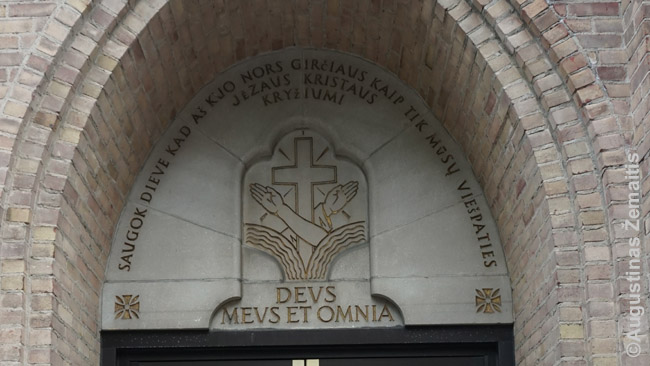

Binghamton Lithuanian church entrance with the Lithuanian text ‚Guard me, oh God, from bragging in anything but in cross of our Lord Jesus Christ‘.
In addition to the "New Church", there is also the Old Lithuanian church on the other side of the street (built in 1916), which later served as a parish hall. Its cornerstone still boasts a Lithuanian inscription reminding of its church origins.
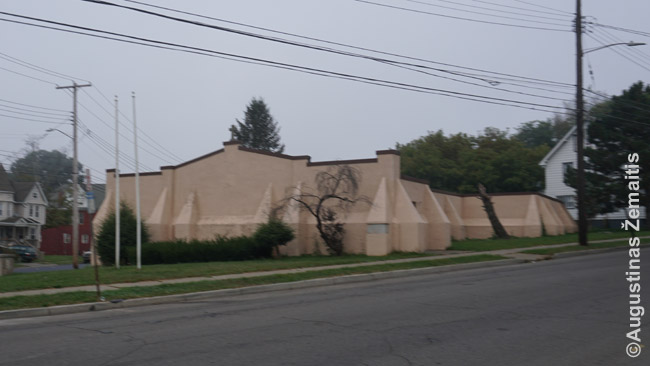

The old Lithuanian ‚basement church‘ in Bingamton.
The map
All the Lithuanian locations, described in this article, are marked on this interactive map, made by the "Destination - America" expedition (click the link):
Interactive map of New York Lithuanian sites
Interactive map of Mohawk Valley Lithuanian sites
New Jersey
New Jersey is part of the New York City conurbation. It is separated from New York proper by merely a river that is crossed by bridges and tunnels. As such, the New Jersey and NYC Lithuanian communities are closely related. New Jersey Lithuanian sites may easily be visited when visiting New York City.
Elizabeth Lithuanian church, hall, and monuments
One of the hearts of the New Jersey Lithuanian community is Elizabeth city near Jersey City with its old and massive Lithuanian St. Peter and Paul church (211 Ripley Pl., built in 1910).


Elizabeth Lithuanian church and rectory
The church houses an Our Lady of Šiluva altar (near its side wall) dedicated to the earliest church-recognized Marian vision in Europe (which took place in Šiluva, Lithuania). It is full of ethnic woodcarving motifs and it has a rock from the holy site of Šiluva. Moreover, Our Lady of Vilnius is included in the main altar (at the top of the altar; it is a copy of the Virgin Mary painting in Vilnius). The church decorations are also especially Lithuanian with Lithuanian inscriptions available on the stained glass windows (with sponsor names) and on the stations of the cross (with explanations of the New Testament events depicted there). Much of the artwork inside has been created by Lithuanians. Near the entrance, there is a gallery of church-history-related artifacts and Lithuania-related images (e.g. painting of a traditional wooden cross or a picture of the cross erected by church members at the Hill of Crosses in Šiauliai).


Elizabeth Lithuanian church interior, looking from the choir
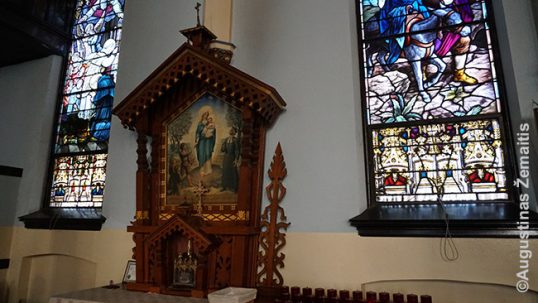

Our Lady of Šiluva altar at the Elizabeth Lithuanian church, full of Lithuanian traditional woodcarving motifs


Lithuanian stations of the cross in the Elizabeth church
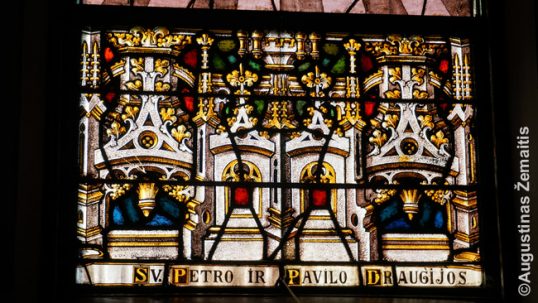

The bottom of the stained glass windows of the Elizabeth church
Outside of the church stands a traditional Lithuanian sun-cross, while the plaque with the church name also features Lithuanian designs (Coat of arms and Columns of Gediminas).


Elizabeth Lithuanian cross
The church's peculiar towers look "too short" because their steeples were removed in 1981 due to them having been damaged by the planes taking off from the nearby Newark airport.
Since 2006, the Elizabeth Lithuanian church shares its priest with the Polish St. Adalbert parish (but both churches are open). One of the church's famous priests (in fact, its founder) Mssgr. Kemėžis has a street named after him nearby. On the street sign, however, his name is written with a typo as "Kemensis".


Kemėžis Pl. plaque with a typo
Since 1974, Lithuanian bakery (131 Inslee Place) offers Lithuanian bread among other eastern European flavors. As numerous vans parked outside suggest, the bread of the bakery is rather popular. Bakery's front facade is covered by wood to remind of European traditional architecture. The bakery is not owned by Lithuanians, however, and never was, as the owner family is of Polish heritage.
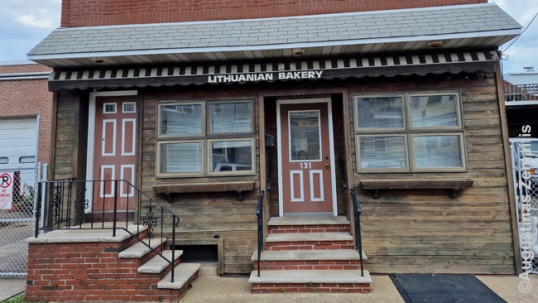

Lithuanian Bakery of Elizabeth


Lithuanian bread at the Lithuanian Bakery
Elizabeth also has Lithuanian Liberty Hall. The impressive castle-like building was built in 1924. It served as a hub for various Lithuanian organizations (dances, sports, a bank, etc.) and became especialy popular after Lithuanian refugees arived after World War 2. The Lithuanian Liberty Hall has been sold in the 1980 and now it serves as a Pentecostal church. The inscription "Lithuanian Liberty Hall" remains. The interior lacks anything Lithuanian although some of the details date to the Lithuanian era.
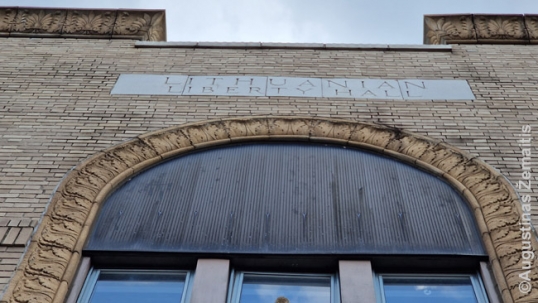

Lithuanian Liberty Hall of Elizabeth
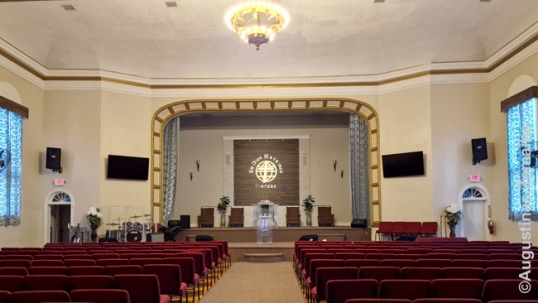

Lithuanian Liberty Hall interior
Newark Lithuanian church and cross
While Elizabeth Lithuanian church is today the grandest in all of the New Jersey, this wasn't always the case. Newark's Romance Revival Holy Trinity Lithuanian church may have surpassed it in grandeur. Unfortunately, it has caught fire in 1981 and, while the damaged did not destroy it, the diocese refused to permit repairs. The parish was thus relocated to a rather simple two-floored edifice it has previously built as a parish hall in 1963.


Newark Holy Trinity Lithuanian church entance and traditional cross
The church is still open, however, the mass is now Portuguese-only as the Portuguese-speaking community has gradually displaced the Lithuanian one. Still, there are many Lithuanian details left, including Vytis on the door glass, Lithuanian folk-art wooden frame than encloses the church's mass schedule and a Lithuanian sun-cross that stands near the entrance since 1962 (relocated from the old church). At its center is Rūpintojėlis, the traditional Lithuanian image of a sad Jesus. The church is closed except for the daily Mass.
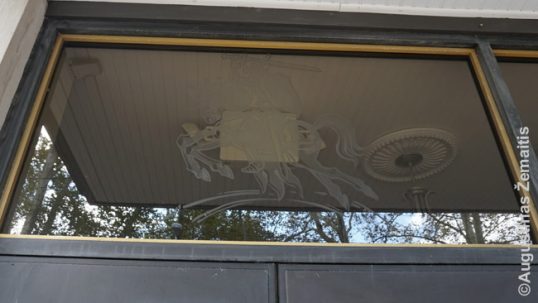

Vytis on the Holy Trinity Newark Lithuanian church entrance


Now-demolished old Newark Lithuanian church
Inside, interestingly, when the old church burned down, it was not the main hall of the parish hall that was turned into a church, but rather the basement hall. The main parish hall above still serves as such. The basement hall is now a de facto church. Its entrance door has a stained glass window with Lithuanian and English name "Holy Trinity". Various religious statues and items have been moved there from the old church, an entire room is dedicated to them; at least one cross has a Lithuanian inscription but, otherwise, little Lithuanian history remains in what is a rather international-style room.
Bayonne Lithuanian church
Elsewhere in New Jersey too, Lithuanian parishes indicate Lithuanian presence. The trend was the same: the Lithuanian parishes established in Jersey suburbs ~1910 with the first Lithuanian migrant wave, however, the current churches constructed in 1950s-1970s modern or semi-modern style as the small communities became rich enough and post-WW2 refugees needed to be accommodated. In ~2000s Lithuanian language, services were abandoned as new generations replaced their parents and grandparents who spoke Lithuanian well.
A small towerless St. Michael Lithuanian church stands in the southern suburb of Bayonne since 1977. Its address is 15 E Twenty-Third St but the nearby Church St. is also known as Matulis Way after the church's priest who passed away in 2000. Bayonne has ~400 Lithuanians (~0,6%). St. Michael church was, however, formally partially transferred to Syriac Catholics in the 2010s. Despite the transfer, the interior for a while remained all-Lithuanian and was nearly always open (unlike all the other Lithuanian churches of New Jersey, which are unlocked only for the mass) ~2017. Even the Lithuanian flag remained beside the altar. Also, the old stations of the cross, most likely relocated from the previous church, are adorned in the old Lithuanian-language inscriptions. The stained glass windows, usually among the most impressive parts of the Lithuanian-American churches, here are rather modest, however. A complex "time-sharing" system between Roman and Syriac Catholics is apparently in place, as posted near the entrance. Later, however, the "Saint Michael the Archangel Lithuanian Roman Catholic Church" sign was covered and it is unclear how much remains in the interior today.
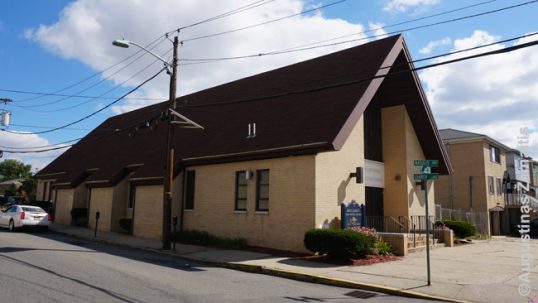

Bayonne Lithuanian church
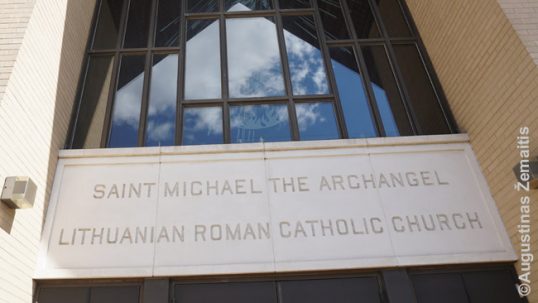

Entrance to the Bayonne Lithuanian church with its Lithuanian dedication


The interior of Bayonne Lithuanian church (Lithuanian flag on the right)


Old Lithuanian station of the cross at the Bayonne Lithuanian church
Like many of the New Jersey Lithuanian parishes, Bayonne one was not simply a church but an entire Lithuanian complex. In 1982, a parish hall was constructed nearby (St. Michael Madonna Hall and Center) where secular and other events would have been taking place.
Kearny Lithuanian church, crosses, and club
Another area that has been popular among Lithuanian immigrants was the Kearny suburb. In 1915 when a Lithuanian parish has been established in nearby Harrison, there lived 400 Lithuanians in Kearny and 700 in Harrison (~450 and ~150 today). ~1955 a new larger towered church of Our Lady of Sorrows has been constructed in Kearny (136 Davis Ave). On the parish's 85th anniversary Reverend Pocus wrote, "Second- and third- generation families may never fully appreciate the fervent longings of their forebears for the sights and sounds of their homeland. But certainly, our older parishioners can recall the poverty of our people, their loneliness in a strange land, their youth and energy, and feeling of unity which they felt with their fellow Lithuanians".
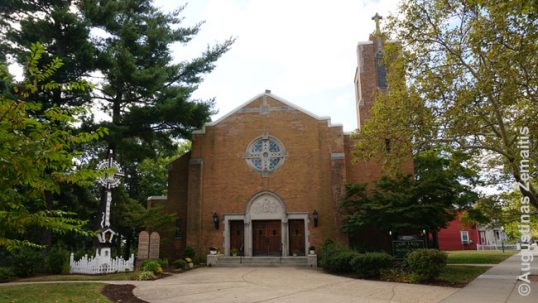

Kearny Lithuanian church
The Kearny Lithuanian church is still officially Lithuanian and has a plaque commemorating that. It also has another Lithuanian traditional sun-cross (1962) near its entrance, donated by the Knights of Lithuania organization. The interior includes a Lithuanian flag and Lithuanian stained-glass windows, including that of Our Lady of Vilna and Our Lady of Šiluva. The stations of the cross are with Lithuanian inscriptions, while each of the pews have been donated by a Lithunian family whose names are written on them.
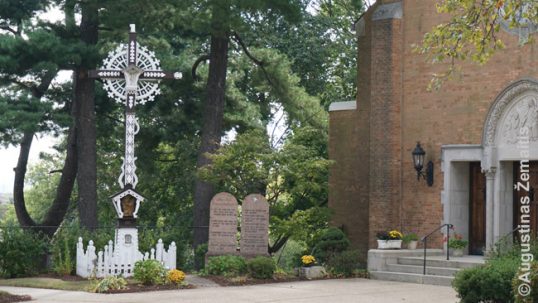

Kearny Lithuanian church entrance and the traditional Lithuanian cross


Our Lady of Vilna stained glass window
Another traditional Lithuanian sun-cross stands at Kearny Riverwalk, not far away from a few other ethnic memorials. It has been constructed in 1996. The plaque in the back lists people in whose memory the cross was constructed (mostly relatives of he donors). Both sun-crosses have been constructed by the local chapter (Council 90) of the Knights of Lithuania Catholic organization.


Lithuanian cross at Kearny Riverwalk
Morever, Kearny had a Lithuanian Catholic Community Center. Marked with Vytis, it served as a community hub and also as a bar. The building has been constructed in 1929. It was originally established as Lithuanian-American Citizens Club, and renamed as Lithuanian Catholic Community Center in 1953 (the final plaque has only "Lithuanian Community Center" listed. It never reopened after the COVID pandemic restrictions closed it down in 2020, however.
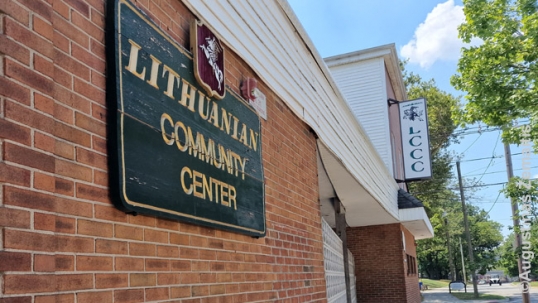

Lithuanain Catholic Community Center in 2022, relatively soon after closure
Schuyler Savings and Loan Association (now Schuyler Savings Bank) is a Lithuanian bank. Until some 1990s almost its entire board was Lithuanian. With Lithuanians moving out of these parts of Kearny, however, the bank changed as well. However, plaques at the Kearny RIverwalk cross still show Schuyler Savings as a major benefactor. It is named Schuyler after its street.
At one time, the whole district surrounding the Kearny church was Lithuanian.
By the way, the old Lithuanian church in Harrison still survives as well. After the parish had moved to Kearny, that building was sold to non-Catholics, so, no Lithuanian details remain on that modest building.
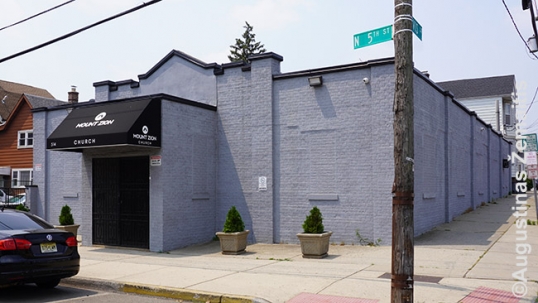

Former Lithuanian church in Harrison
Paterson Lithuanian church
After World War 2 (1962) the Paterson Lithuanian parish also constructed its modest St. Casimir church (147 Montgomery St; closed 2014, sold to non-denominational Christians).
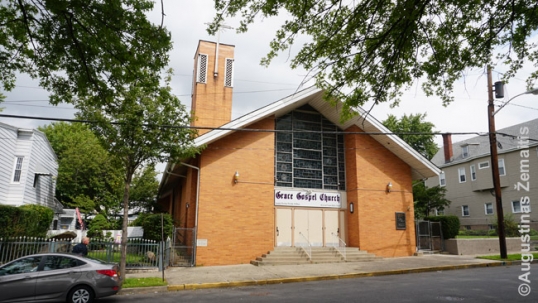

Paterson St. Casimir Lithuanian church
Jersey City Lithuanian church site and Blozis Hall
Jersey City had a Lithuanian church as well, which the New Jersey Lithuanian parish that was the closest to the New York City. St. Ann Lithuanian church, which stood on Grand Street and Manning, however, was demolished in the 1980s after a fire. It was a squarish small wooden building squeezed between other buildings. It was opened in 1913, after the newly-established St. Ann Lithuanian parish acquired a former protestant church that had been converted into a cinema. Those buildings that surounded it do not survive anymore either, as the entire neighborhood, including the street grid, was rebuilt, making it difficult to even discern the exact site the church stood at.
Jersey City also has a high school gymnasium and a 1939 art deco apartment building named after Al Blozis (591 Montgomery Street). That building is called Al Blozis Hall. Al Blozis, 1919-1945, was born to Lithuanian parents in New Jersey and died in World War 2 serving the US army. His endevors inspired a comic "Human Howitzer".
For the First Wave Lithuanian immigrants to the USA (i.e. those who came before World War 1), Jersey City was the gate to continental America. Immigrants would have been processed at Ellis Island nearby (read more about it in our article on New York City), then purchase tickets and board trains at the Central Railroad of New Jersey Terminal that would take them to their new homes throughout the United States. This railroad station is now abandoned but it can be visited (near where tourist boats depart New Jersey for Liberty Statue).


Abandoned railroad station near Ellis Island
Recommended literature: Barbara Krasner "Kearny's Immigrant Heritage" pg. 67-76.
The map
All the Lithuanian locations, described in this article, are marked on this interactive map, made by the "Destination - America" expedition (click the link):
Connecticut
Connecticut is a small state and although the number of Lithuanians is only ~33 000, this means almost 1% of the entire population (the largest share among US states). Most of them are descendants of Lithuanians who immigrated before World War 1 to work at the then-burgeoning Connecticut factories.
Lithuanian churches built in the 1900s-1920s still tower among historic townhouses. These churches are massive; built in various revival styles, they look as if teleported from a Lithuanian countryside. The size makes you think they have been constructed for an entire town of tens of thousands rather than a single minority. They are surrounded by equally old parish houses and Lithuanian schools. Interestingly, these were established at roughly the same time as the first official Lithuanian schools in Lithuania itself where Lithuanian language has been banned by the ruling Russian Empire until 1904 (something that surely played a role in increasing emigration to the USA and Connecticut in particular).


Waterbury Lithuanian school entrance adorned by Vytis
In addition to the churches, there are Lithuanian monuments in Connecticut, especially the massive traditional Lithuanian sun-crosses that combine Christian and pre-Christian messages. There are also old clubhouses and a single Lithuanian cemetery. The cemetery is located in Waterbury, where there is an entire district of Lithuanian buildings. More early-20th-century Lithuanian heritage exists in Hartford, New Britain, Ansonia, Bridgeport, and New Haven.
After World War 2, Connecticut received a massive center of worldwide Lithuanity in its Putnam village. There, a Lithuanian female convent, a large Lithuanian-American art museum, Lithuanian-American library, and Lithuanian-American sculptures attract many Lithuanians and non-Lithuanians alike.


Lithuania-themed stained glass windows at the Putnam convent
However, in general, after the massive pre-WW1 "First wave of immigration", Lithuanians ceased to migrate into Connecticut in large numbers. Small cities famous for their Autumn leaves were not as attractive as Chicago or New York. Perhaps this has saved the old churches: they haven't been rebuilt into modern-yet-less-appealing ones, still engulfing the visitor with a nearly century-old splendor of stained glass windows. Unfortunately, a major church-closing spree ~2020 led to a quick closure of many Lithuanian churches, although buildings do survive.
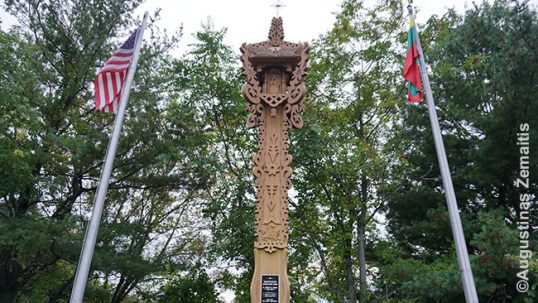

A massive Lithuanian chapel-post in New Britain, the city where the famous anti-Soviet partisan A. Ramanauskas-Vanagas hailed from. Destroyed ~2023 after the diocese closed down and sold the nearby Lithuanian church
Putnam area - Lithuania outside Lithuania
Putnam town may have merely 9000 inhabitants and relatively few Lithuanians, yet it had become one of the most important Lithuanian-American centers.
The Lithuanian sites in Putnam grew around the Lithuanian female convent of Immaculate conception. Originally established in 1936, it gained importance after the Soviets occupied Lithuania in 1940 and banned the monastic life there. At that time, the convent effectively became independent and sought to promote Lithuanian cause in addition to the religious cause. Lithuanian-Americans thus rallied around the convent, using their donations and labor to help it become a vast Lithuanian space. Among those working here were some of the most famous Lithuanian-American artists, therefore, Putnam area became a true haven of top Lithuanian-American art.
The convent is centered around a chapel (1954) created by a famous Lithuanian painter Kazys Varnelis. Its stained-glass windows are especially Lithuanian in design, showing Lithuanian ethnic symbols and Lithuanian locations strong in Maryan veneration (the churches and the coats of arms of these locations are depicted, among other symbols). The altar of the chapel is of the unique Varnelis's style. Near the entrance stands the statue of Our Lady of Šiluva (representing the earliest popular Maryan vision in Lithuania and Europe). It was created by a famous Lithuanian-American sculptor Vytautas Kašuba (the mosaic behind the sculpture was created by his wife Aleksandra Kašubienė).


Putnam convent chapel interior
The massive convent building adjoining the chapel once was full of Lithuanian nuns. However, after the independence of Lithuania opened up monastic life there again, the Putnam convent did not attract new nuns and thus more and more of the rooms were used for other purposes, such as recollections of lay people. In any case, the key Lithuanian parts of the convent remained, including the Lithuanian museum and Lithuanian library, as well as Lithuanian artworks exhibited in the corridors.
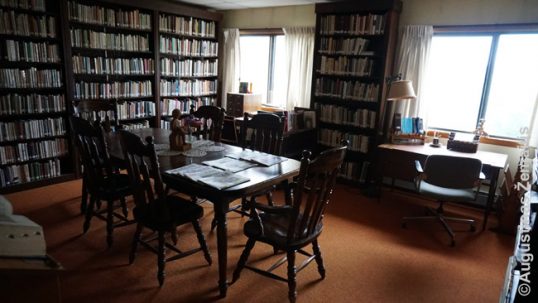

Putnam convent Lithuanian library
The Lithuanian museum excels in concise-yet-beautiful English introduction to the most famous and unique elements of Lithuanian Catholic history and culture: the Šiluva Maryan vision, the blessed Jurgis Matulaitis, UNESCO-recognized Lithuanian wooden crosses, rūpintojėlis (traditional Lithuanian sculptures of worried Christ), the Divine Mercy image that originates in Lithuania, etc. The museum's collection goes beyond the faith, however.
Among the exhibits in the museum is the famous "Siberian book of prayers", published by the convent's nuns in 1959. This book by Adelė Dirsytė was written after her exile to cold and dreary Siberia by the Soviet occupational regime for her disapproval of communism. She wrote her hopes and prayers onto a manuscript in 1953 but only by 1959 could it go beyond the Iron Curtain (the author deceased in 1955 unable to withstand the harsh conditions after being moved to a gulag). The Putnam Lithuanian nuns were instrumental in publishing this prayer book, which has been a major global success. It had been translated into many languages (even Chinese) and had a massive circulation (450 000 Dutch books alone), as well as many issues (5 times issued in Germany), helping the world to learn about both the tragedy and determination of the Lithuanian nation. This is likely the most widely published Lithuanian book.
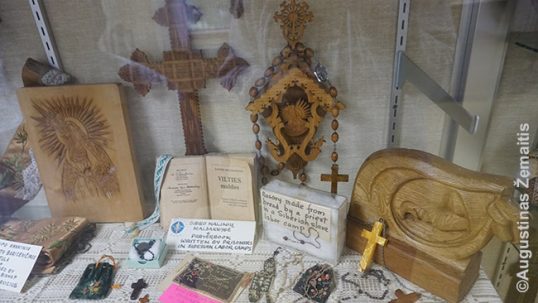

The Siberian book of prayers and other things of the Soviet-expelled Lithuanians in the convent museum. All the translations of the book are also available.
In addition to the Lithuanian-American artworks, the monastery (and its museum) has even more traditional ethnic artworks form Lithuania. During the Soviet occupation of Lithuania, many Lithuanian-Americans felt it as a part of their mission to save such works by bringing them into the USA. For example, in the entry hall of the monastery stands a traditional Lithuanian wooden wayside cross smuggled from the Soviet-occupied Lithuania where such crosses were often destroyed by the atheist regime.
In addition to the buildings, the convent has rather massive grounds. In the forest near the grounds stands what is one of the most interesting and unique Lithuanian sites in the USA: Mindaugas castle built in a forest by a Lithuanian priest Stasys Yla who escaped into the USA after being a prisoner of the Nazi Stutthof concentration camp.


Mindaugas Castle in Putnam
Stasys Yla chosen the site after discovering a peculiar stone in the forest and built his castle around that stone. In its form, the castle is meant to remind the crown of King Mindaugas (the only Christian king of Lithuania, who lived in the 13th century). The castle interior was decorated by Lithuanian-American artists such as Aleksandra Kašubienė in mosaics and stained glass windows: those also remind of the King Mindaugas, his wife, and his sons.
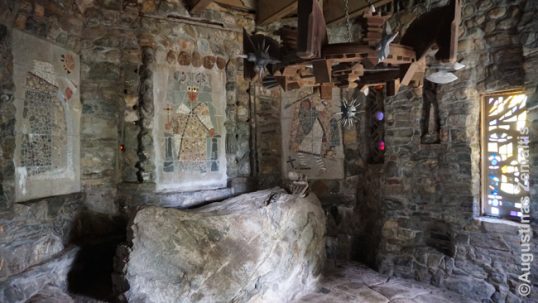

The interior of the Mindaugas castle in Putnam with a mosaic of Mindaugas (left) and the stone aroudn which the building was constructed (center)
While the castle was built by priest Yla as a hobby and is not a chapel, currently it is sometimes used for prayer and is especially loved by the youth, for whom the rather mystical nature of the castle-within-a-forest may appeal more than regular chapels or churches.
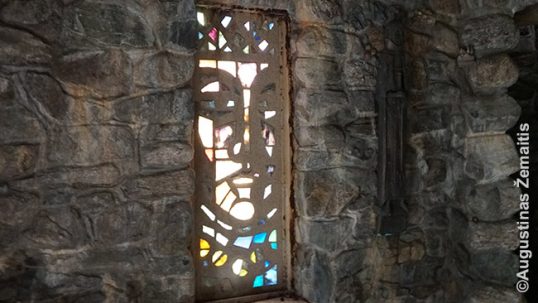

One of the mystical stained glass windows within the Mindaugas castle of Putnam
The keys to the castle interior are held by the nuns of the convent. The convent itself is generally always open and may be visited. The convent grounds are not fenced and can be visited even without meeting the nuns.
Between the convent and Mindaugas Castle lies the small Gate of Heaven cemetery. Only the nuns, their relatives and the sponsors of the convent are buried there. However, such sponsors includes many famous interwar Lithuanian figures, such as Magdalena Avietėnaitė, who had an almost unprecedented diplomatic career for a woman anywhere in the world at that time (famously, she was not given a higher diplomatic rank solely because the prime minister believed that "the Western world would not understand Lithuania if it would appoint a woman to such a rank"). Juozas Brazaitis (Ambrazevičius), the prime minister of the anti-Soviet 1941 June revolt, also used to be buried there (however, he has since been reburied in Lithuania). Of course, Stasys Yla's grave is also in Putnam.
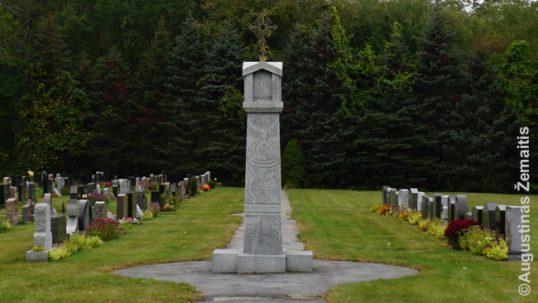

Gate of Heaven Cemetery in Putnam
The center of the Gate of Heaven Cemetery is marked by a stone monument with such Lithuanian phrases as "Don't forget us, oh the Highest one, and don't forget our dear Fatherland" ("Neapleisk, aukščiausias, mūsų ir brangios Tėvynės") by the famous Lithuanian poet Maironis. The fatherland mentioned here is, of course, Lithuania rather than the USA.
Also at the cemetery stands a large Lithuanian sun-cross that was originally located in New Haven near its now-closed Lithuanian church (see below). As one of the most well-surviving Lithuanian religious institutions, Putnam monastery collects Lithuanian monuments from the Lithuanian institutions that are closed down (especially the churches).
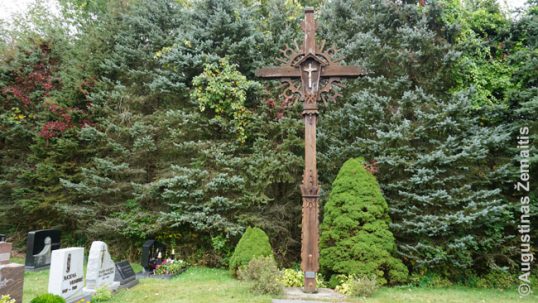

The Lithuanian sun-cross relocated to Putnam from New Haven
On the other side of the Mary Crest Dr from the convent stands yet another one of the America's top Lithuanian sites - the Lithuanian-American Cultural Archive (Museum). The archive is open to the public as a museum which has a great and diverse collection of Lithuanian-American art, including paintings, sculptures, and crafts. Famous Lithuanian-American artists such as Vytautas Kašuba, Kazys Varnelis, Kazimieras Žoromskis, and Vytautas Kasiulis are represented (the latter two are famous enough to each have a museum dedicated to him in Vilnius, the capital of Lithuania). Most of the art dates to the 1940-1990 era. Some of the art is dedicated to the Soviet occupation of Lithuania and its horrors. The other art tries to convey the beauty of Lithuania that was inaccessible to the artists or depicts the scenes of Lithuanian Medieval history that served as an inspiration to them. Yet other art is not related directly to Lithuania but was still created by the top Lithuanian-American artists.
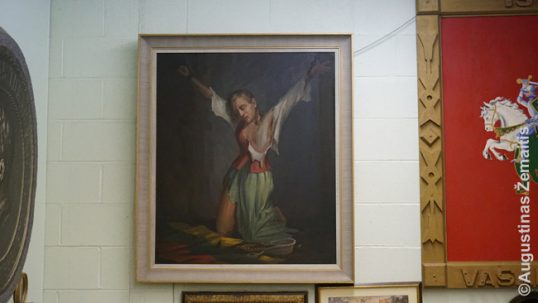

Crucified Lithuania, one of the Lithuanian artworks at the Lithuanian-American Cultural Archive
The Lithuanian-American Cultural Archive is open by appointment. The building also includes a massive Lithuanian library. Even if you don't want to read these books, ask to access it, as some of the better artworks are on the walls of the library rather than in the museum.
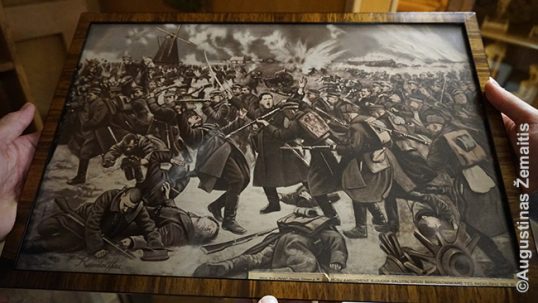

Lithuanian routing out the Bermontians in the wars of independence (ALKA collection)
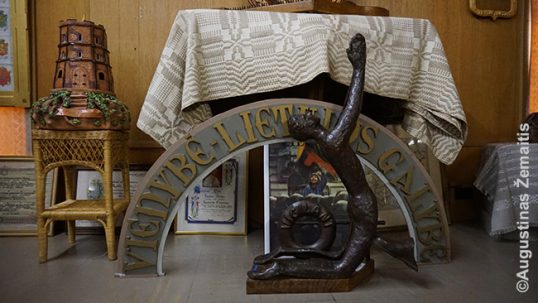

Sculpture of S. Kudirka. A topic in numerous ALKA paintings, he was the Lithuanian sailor of the Soviet navy who defected to the USA yet was given back to the Soviets, drawing many Lithuanian-American protests.


A historical painting by Kazimieras Žoromskis
The Lithuanian-American Cultural Archive collection was largely amassed through donations and, currently, through legacies, as the descendants of Lithuanian-Americans who no longer speak Lithuanian and have little knowledge in Lithuanian art tend to donate all their dead parent's or grandparent's Lithuanian properties to a key Lithuanian institution, such as the Lithuanian-American Cultural Archive. The Archive reviews these donations and, if it already has similar books, re-donates them to those who ask (e.g. libraries in Lithuania). Artworks, on the other hand, are not re-donated, forever staying in what turned to be one of the key Lithuanian museums in the Americas.


Miniatures of traditional Lithuanian woodcarved crosses and chapel-posts in ALKA. Many Lithuanian-Americans have such crosses at home as symbols of Lituanity.
The Archive was created by Monsignor Francis Juras, who used to be pastor of the Lithuanian parish in Lawrence, MA. He transferred ownership of ALKA to the Lithuanian Catholic Academy of Science. The institution is housed in a rather simple house that has been decorated with Lithuanian symbols. The wooden carvings have been brought in from a closed Lithuanian National Club in Boston; there are also the Columns of Gediminas and a chapel-post.


The exterior of ALKA
The nuns still care for the Jurgis Matulaitis Home for senior citizens somewhat away from the monastery. Initially started as an assisted living facility for Lithuanian-American seniors in 1968, the Home now has clients of all ethnicities. However, the interior is still pretty much Lithuanian with Lithuanian artworks on the walls. The Matulaitis Home's chapel was created by V. K. Jonynas, a famous Lithuanian-American church interior designer. However, it lacks visibly Lithuanian details. Jurgis Matulaitis himself was a Lithuanian archbishop who attained the blessed status (one of just several Lithuanians to do so). His name and image are popular in Lithuanian-American religious institutions.


Matulaitis Home entrance with Lithuanian sun-cross on the top of the name
Jurgis Matulaitis is also famous as the effective re-founder of the order of the Maryan priests (at one time, he was the only surviving member of this ancient order, yet the order came to flourish again due to his work and now has many members in America and beyond). Maryan priests had their own convent near Putnam in Thomson, which has also served as the Marianapolis gymnasium for Lithuanian-Americans. Lithuanians from all over America would study in this boarding school, which had massive grounds and many buildings, such atmosphere helping them to retain their Lithuanian language and culture. The school is still open, albeit transferred to lay people in the 2000s and now accepting students of all nationalities (as the school is prestigious, there are many students sent in by rich Asian families).
The school's Lithuanian history is still visible, however. In the Marianapolis school ground stands the Grave of priest Jonas Navickas, instrumental for the school's history; it is one of the largest grave memorials for a Lithuanian in America.
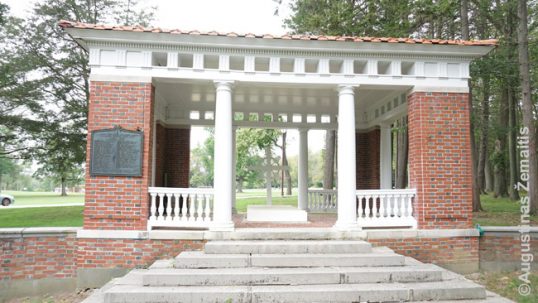

Priest Jonas Navickas grave
In the massive Marianapolis school chapel there are Lithuanian exhibits, Our Lady of Vilnius painting and, the most strikingly, a large painting of Jurgis Matulaitis over the altar. This is actually the same painting that hanged in Rome during his beatification ceremony.


Marianapolis school chapel with a massive painting of Jurgis Matulaitis
Maryan priests were actually those who helped the Lithuanian nuns to settle in Putnam, and some of the older buildings of the school grounds were used as the nuns' first convent before the current land was acquired.
Waterbury Lithuanian district
The city with most Lithuanians in Connecticut is Waterbury (2 500 out of 100 000). It has an entire Lithuanian district with a large red St. Joseph church, where a traditional wooden "chapel-post" stands in front (a form of ethnic art). The interior has stained-glass windows (with Lithuanian-inscriptions) that are among the most impressive among the East Coast Lithuanian churches. Originally, the interior of the church was even more opulent but it was simplified by overpainting much in white after the Vatican II church reforms. Moreover, originally, two Baroque Revival Towers were planned for the Waterbury Lithuanian church which would have made it definitely the most impressive Lithuanian church in Connecticut. However, the community chose to build a massive Lithuanian school instead of the towers. The cornerstone of the church has a Lithuanian inscription "Szvento Juozupo lietuviszka bažnyczia" - this inscription still used the old semi-Polonized Orthography for the Lithuanian language with "sz" for a modern Lithuanian "š" and "cz" for "č".
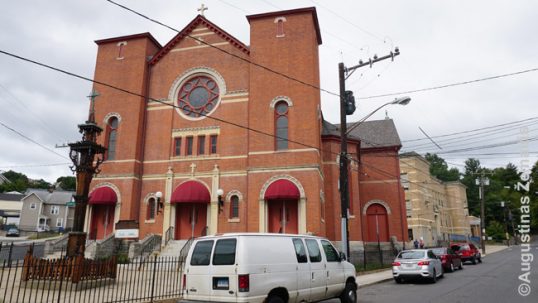

Waterbury Lithuanian church


An example of the stained glass windows with Lithuanian inscriptions


A close-up of Waterbury Lithuanian church stained glass window with Lithuanian inscriptions. Every Connecticut church has such elaborate Lithuanian stained glass windows.
Two rooms at the sides of the church work as improvized Lithuanian museum, showing Lithuanian memorabilia and the parish history. The original Lithuanian museum used to be at the Parish house, however, it was closed down by the parish's non-Lithuanian priest in 2017 and sold. The parish house, which once housed the masses in winter, is now largely devoid of Lithuanian atmosphere. As not all of the museum's exhibits fit into the two small rooms, many are crumbling in the church basement.


The Lithuanian parish house of Waterbury
The first Lithuanian mass has been celebrated in Waterbury in 1894 (also the first in Connecticut) in a house not far from the church. The church was built in 1904-1905, the oldest Lithuanian church in Connecticut. Next to the church an elaborate Lithuanian school building (1925) stands, now closed, but still adorned by Vytis in front, as well as Lithuanian inscriptions "For God and country" (architects Adam O'Connel, W. Show).
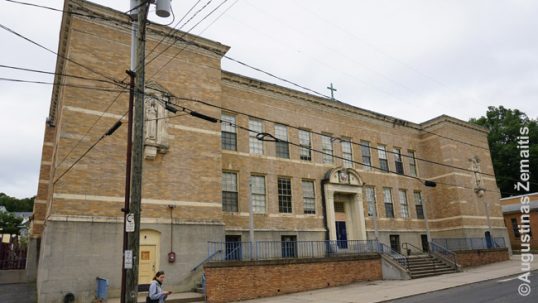

Waterbury Lithuanian school
The nearby Green Street once had 3 Lithuanian clubs popularly named after the street number of their houses: one leftist (103), one nationalist (48), and one Catholic (Knights of Lithuania). All three are closed by now, with the Knights of Lithuania club surviving the longest and getting closed only ~2020 as the parish sold their building.
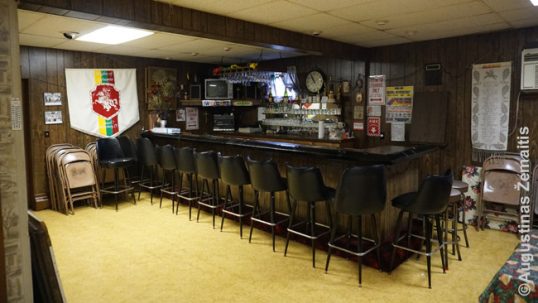

The interior of Lithuanian Catholic Knights club in Waterbury before its closure
The leftist club closed the first (as the Soviet persecutions in Lithuania made the socialism less popular), only the Lithuanian word "VENTA" above the building entrance still reminding of its previous location (ironically, now the building houses a Pentecostal church).
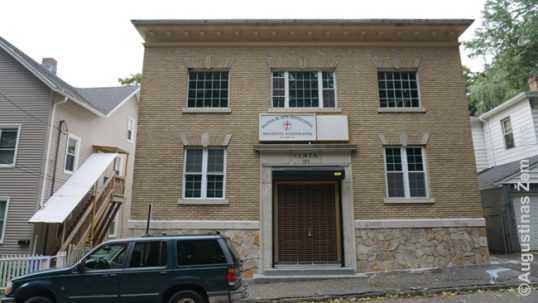

The former leftist Lithuanian club "Venta" of Waterbury
The nationalist club burned down in the 2000s, however, advertisements on its former lot still offer to rent the garages to help it rebuild.
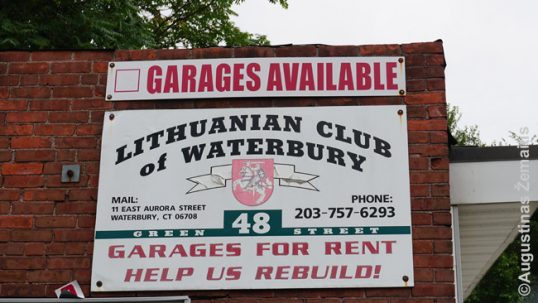

The site of the burned-down Lithuanian club in Waterbury
The slow demise of Waterbury Lithuanian district began in 1955, when a massive flood hit, killing 29 locals. A memorial for victims of the Waterbury flood was erected in the district in 2012. The memorial lists 29 names of the victims with the majority of the surnames being Lithuanian. However, even more victims could have been Lithuanians, as many Lithuanians at the time used anglicized surnames after emigration.
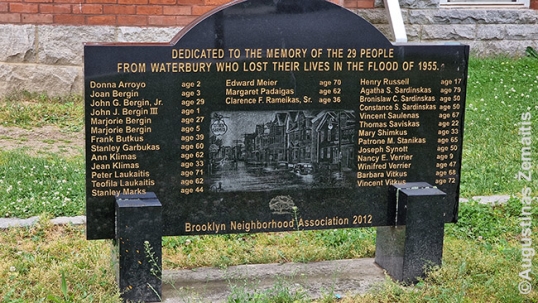

Waterbury Lithuanian district flood memorial
Since 1955, Lithuanians gradually moved out of the district to the suburbs. While some of them still returned to the Lithuanian institutions such as the church or the club, it was a far cry from the lively Lithuanian district it once was, while the raised-in-suburbs younger generation rarely returned at all. The district also became unsafe. ~2020, most of the Lithuanian buildings of the district were sold to non-Lithuanians, although at the same time a group of active Lithuanians began attempts to revitalise the district by adorning its streets with Lithuanian flags and celebrating the traditional Lithuanian festival of Joninės (midsummer) here annually. These attempts coincide with the general US trend of downtown gentrification.


Lithuanian flag in the Waterbury Lithuanian district
Beyond the Lithuanian district, Waterbury has a Lithuanian cemetery (est. 1902), the only one in Connecticut. Established by the atheists (there is even a gravestone with hammer and sickle), it was later blessed and used by the Catholics as well. The later graves often have Lithuanian ethnic symbols, such as Vytis, and many Lithuanians who fled the Soviet occupation of Lithuania are also buried there. The inscription at the entrance declares it to be (in archaic Lithuanian) "A free graveyard of the unified Lithuanian societies" ("Lietuviu suvienitu draugiyu laisvas kapinynas").
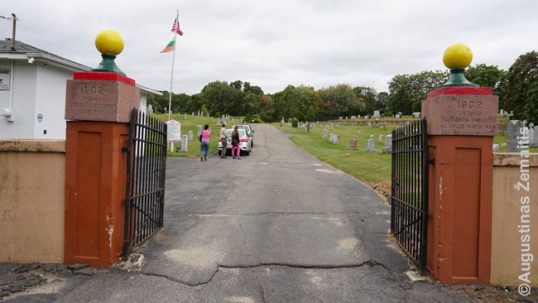

The Lithuanian entrance to the Waterbury Lithuanian cemetery
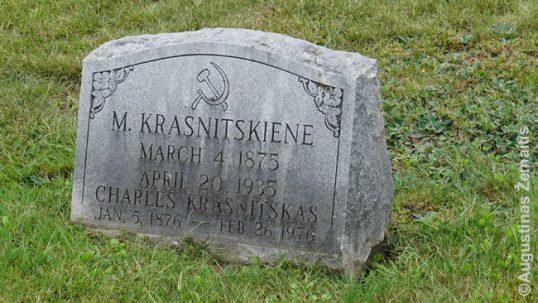

A grave with hammer and sickle in the Waterbury Lithuanian cemetery (on a pre-WW2 1935 grave)


A Waterbury Lithuanian cemetery grave with ethnic symbols
The cemetery administration building now serves as the clubhouse of the burned-down Lithuanian national club. The cemetery entrance gate is painted in the Lithuanian flag colors and a Lithuanian flag (together with the US one) is perennially waving above the cemetery.
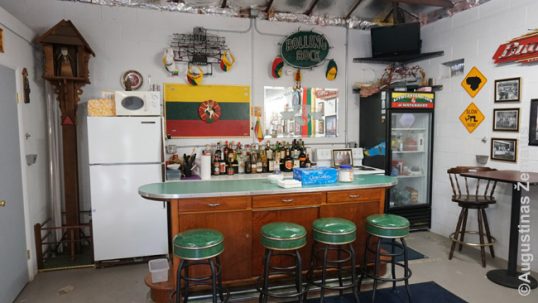

Interior of the Waterbury Lithuanian cemetery club at the cemetery
Away from the center, Waterbury has Brooklyn Bakery in one of its shopping malls. While the bakery is no longer Lithuanian-owned, it was once located in the Lithuanian district and it still has the historic photos of Lithuanians working at its former place inside, as well as an original table.


An image of Lithuanian workers of the Brooklyn Bakery before WW2
At its peak, Waterbury area had some 10 000 Lithuanians, 6 000 of them members of the Lithuanian parish.
Hartford Lithuanian church and monuments
Lituanity still exists in the state capital Hartford (pop. 124 000). Red gothic revival Holy Trinity Lithuanian church slightly reminds in its form the old French cathedrals. A nearby old house is a parish home; both US and Lithuanian flags are waving in front of it. The land has been purchased in 1900, the church constructed 1915-1928; parish school was open until 1964.


Hartford Lithuanian church and parish house with a Lithuanian flag
The church is two-floored, with the lower floor used as a parish hall for more secular matters. It also hosts lots of Lithuanian memorabilia.
The main hall has stained-glass windows with Lithuanian names on them and many plaques, commemorating Lithuanians, including the former priest Albin Gurklis, the Hartford Lithuanians who served the US armed forces, and more.
The church is the closest church to the Connecticut state capitol. The church history may be read by using the specially designed QR codes.
Historically, a Lithuanian district stood nearby, however, much of it homes were demolished during an urban renewal campaign ~1960s, replaced by parking lots serving the city downtown. The remainder, Lithuanian church including, was inscribed into NRHP as a historic district.
Outside of the church, a wooden traditional Lithuanian cross stands. It incorporates the image of Our Lady of Šiluva (a Maryan vision in Lithuania) in its design, with the word "Šiluva" inscribed.


Hartford Lithuanian hall on the ground floor / basement of the church, an example of the Lithuanian ethnic halls which every Lithuanian-American church has. It is as large in area as the church ("religious hall") itself that is above it.
An even bigger Lithuanian traditional artwork of the UNESCO-inscribed Lithuanian cross-crafting art used to be located at the Hartford cathedral itself - a Lithuanian chapel-post. It has been constructed as part of a campaign by the Lithuanian priest John Rikteraitis to build numerous such Lithuanian shrines in Connecticut, mostly in front of the Lithuanian churches. Sadly, that shrine was demolished ~2020.
Another former Lithuanian hub in hartford was the Lithuanian Citizens Club located in a historic building of Hartford Lyceum. That massive building was owned by Lithuanians ~1940-1981. Now it serves as a conference center.
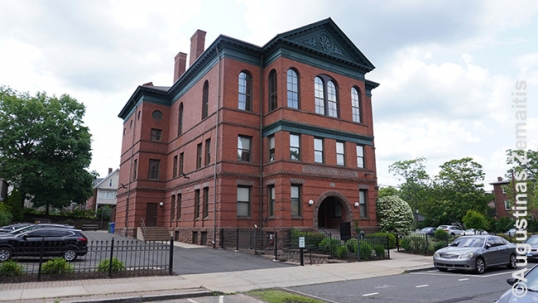

Hartford Lyceum (foirmerly Lithuanian Citizens Club)
New Britain Lithuanian sites
Romance revival New Britain St. Andrew Lithuanian church (396 Church Street) dates to 1911. The interior of the church was especially pretty, as it was constructed to be a visual church that could show often illiterate Lithuanians of the early 20th century the stories of the Bible. Unfortunately, the church was closed in the early 2020s, and the interior gutted.


New Britain Lithuanian church
The church closure also led to the demolition of Connecticut's primary Lithuanian memorial that used to stand on the church grounds on the opposite side of the road. That was a Lithuanian traditional wooden chapel-post (1995) surrounded by Lithuanian and US flags. It was arguably the prettiest of the Rikteraitis's commissioned Lithuanian shrines. It incorporated not only religious but also Lithuanian ethnic motifs, including the coat of arms, the Cross of Vytis and the ethnic patterns which are created of wood. Inside the "chapel" at the top is Rūpintojėlis, a traditional Lithuanian design of a sad Jesus. The chapel-post had been erected for the 100 anniversary of the church and was designed by Gertrūda and Joseph Ambrozaitis.
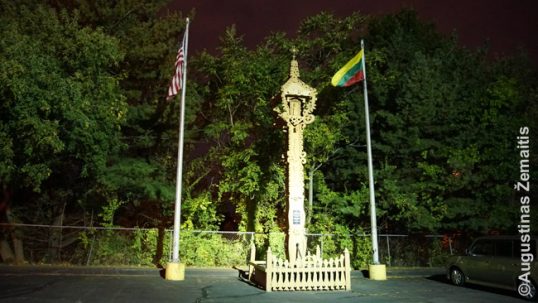

Lithuanian chapel-post at New Britain
The New Britain church is especially famous for having been a location where a leader of Lithuanian anti-Soviet partisans Adolfas Ramanauskas "Vanagas" was baptized. His parents, like many Lithuanian-Americans who escaped the Russian Imperial regime that occupied Lithuania in 1795-1915, chose to return after Lithuania became independent in 1918, with Vanagas still being a toddler. As fate decided, however, Vanagas was to suffer an even more terrible Soviet Russian occupation and was killed by the Soviets (who have also punctured his eye and cut his testicles in torture long before the actual execution).
Adolfas Ramanauskas-Vanagas was born on 173 Pleasant St (the current house with the address is in the yard). In 2021, a commemorative plaque for him has been unveiled in the New Britain St. Andrew Lithuanian church but it was removed soon afterward after the church closed.


The house where Adolfas Ramanauskas-Vanagas was born
Next to the main Lithuanian church of New Britain stands the smaller previous church, more akin to a turn-of-the-20th-century single-floor home. It served as a John Rikteraitis friendship center for more secular Lithuanian events after the parish had been relocated. It was by the diocese sold together with the church and nothing Lithuanian remains inside.


The former Lithuanian church of New Britain (now the Rikteraitis hall)
New Britain also had a Lithuanian Hall. Its massive 1912 building still survives in all its glory, with the inscription "Lithuanian hall" high on its facade and another one near its entrance. The Hall was closed and sold in 2003. The building was acquired by a car repair store owner mostly to use its parking lot to store cars. As such, the building remains disused and the authentic interior still survives.


New Britain Lithuanian Hall
Ansonia Lithuanian church and monument
White towers of the St. Anthony church of Ansonia (199 North Main Street) were started in 1912 without a bishop permit (the bishop sought to unify Lithuanians into a non-Lithuanian parish). In 1915 permit has been granted by Vatican itself where the Lithuanians appealed; the church opened the same year. This shows just how much Lithuanians of the era wanted their own parishes which were important for their self-expression and preservation of culture. Unfortunately, the church was closed in 2015, becoming an Abundant Life church.


Ansonia St. Anthony Lithuanian church
A Lithuanian monument adorned by the columns of Gediminas still stands in the yard of the former Ansonia Lithuanian church. Originally, this was one of the Connecticut's massive chapel posts, designed by Kęstutis Švelnys. However, its top part has been destroyed by termites. The remainder, surrounded by a fence with Lithuanian ethnic motifs, is still impressive enough and bears a dedication to the founders of the St. Anthony Parish, workers and benefactors and the persecuted church (in the Soviet-occupied Lithuania), the nation of Lithuania, the USA and more. That is, it lists everything that was important to the Lithuanian-Americans of the 1970s who were a strong and still largely-Lithuanian-speaking community.


Ansonia Lithuanian monument
New Haven Lithuanian church
New Haven St. Casimir church has been closed in 2005 and transformed into apartments. Quality reconstruction preserved the front facade (even the crosses) but the massive gable has been transformed by adding rooms on the sides. Nothing visibly Lithuanian remains there.
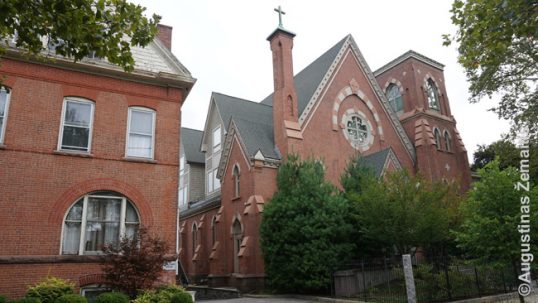

New Haven Lithuanian church
In the Northford suburb of New Haven there is an entire district with Lithuanian-named streets. It was developed by Lithuanian-American businessman who paved these streets and thus had a possibility to officially name them. The streets in question are Palanga Dr, Nida Dr (both famous Lithuanian resorts), Venta Dr (a Lithuanian river), and Ruta Dr (Rūta being both a Lithuanian female name and a Lithuanian word meaning "rue").


Venta Dr and Nida Dr in New Haven suburbs
Bridgeport Lithuanian church
Bridgeport St. George church is still operating and, in fact, open most of the time, making it one of the easiest Lithuanian churches to visit without a prior arrangement (also, it is the Connecticut Lithuanian church closest to New York). Inside, one could see more Lithuanian details than in many churches of Lithuania, including Lithuanian inscriptions about its benefactors incorporated into the stained glass windows, a Lithuanian chapel-post, Lithuanian words on the century-old altar cross ("Misijos atmintis 1913" - "Memory of a mission 1913"), Our Lady of Vilnius painting. All this despite the fact that the church is now mostly Hispanic.


Bridgeport St. George Lithuanian church
The St. George church of Bridgeport had its basement constructed in 1912. As was common with the Lithuanian-American churches, the construction continued above the basement and once the top of the church was built (cornerstone with both Lithuanian and English inscriptions dedicated in 1923) the basement was turned into a large hall for more secular affairs of the community.


Bridgeport Lithuanian church interior. Lithuanian flag on the right.
Before that, there had been a wooden Lithuanian chapel in Bridgeport since 1907. In a typical history of the era, the boundaries between Lithuanian and Polish communities were not clearly defined, and there used to be a Polish mass held for Polish-speaking Lithuanians, which the Polish priest from the Bridgeport's Polish parish asked to stop, claiming that all Polish-speakers are Poles and should come to his parish instead. The bishop supported the Polish priest establishing a linguistic boundary between, that is, Lithuanian-speaking and Polish-speaking parishes with not Polish mass allowed in Lithuanian parish and no Lithuanian mass in the Polish parish.
Map of Connecticut Lithuanian sites
All the Lithuanian locations, described in this article, are marked on this interactive map, made by the "Destination - America" expedition (click the link):
Map of Connecticut Lithuanian sites
Massachusetts
Massachusetts Lithuanian community is among the oldest and the fourth largest in the USA (~51 000 people, 0,8% of total). Only Illinois and Pennsylvania has more Lithuanian sites.
The heart of the community is in South Boston where Lithuanian St. Peter church and a large Lithuanian club are located. Boston is also famous for having been the location where largest ever Lithuanian encyclopedia has been published.
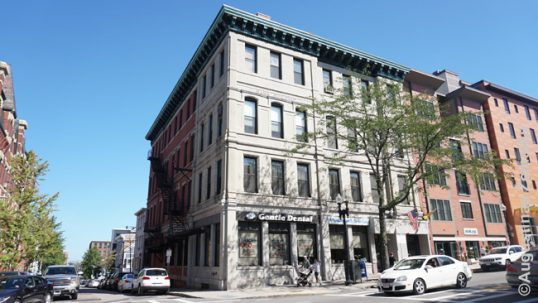


Boston Lithuanian club. US and Lithuanian flags wave at the entrance
In turn of the 20th century, Massachusetts Lithuanian communities also began in what were then industrial towns: Brockton and Worcester.
Lithuanian Village was one of the hearts of Brockton and famous for its celebrations eagerly followed by non-Lithuanians as well. It has impressive 4 memorials for perished Lithuanians, 3 of them for Lithuanians who died for Lithuania's freedom.
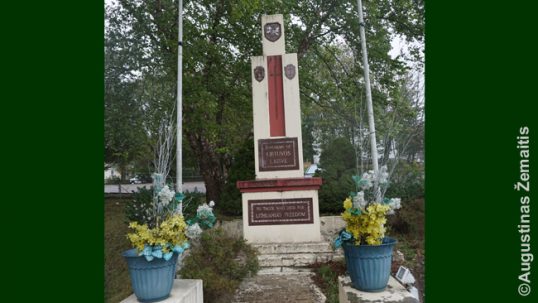

Memorial for those who died for Lithuanian freedom near the Brockton Lithuanian church
Worcester was the smallest US city outside Pennsylvania to have more than a single Lithuanian church, both of them especially impressive. It also hosts Maironis Club that has pretty Lithuanian art in its interior.



Our Lady of Vilna Lithuanian church in Worcester.
Merrimack river valley and its long-gone textile industry made another Lithuanian heartland in towns of Lowell, Lawrence, and Haverhill, each of them having at least one Lithuanian church, club and cemetery.



Entrance arch of the Lithuanian national cemetery in the Merrimack Valley
Beautiful Lithuanian church exists in Athol which, together with Gardner, formed yet another Lithuanian "colony" as they were called in the early 1900s. There are several Lithuanian clubs tehre too and everything, including the church, still operates.


Bible scenes with Lithuanian explanations in the Athol church
There are less Lithuanian institutions left in these towns today, however, as the community has not been replenished by new immigrants in 1950s and 1990s as was the case with Boston. Most Lithuanian churches have been closed in late the 2000s and sold to other denominations. They still stand however as do various monuments related to Lithuania. Some locations have names relating to Lithuania.
The town of Stockbridge in the West of Massachusetts has few Lithuanians but it is the place of the National Shrine of Divine Mercy constructed in 1960 in support of the Divine Mercy worship which began in Vilnius.
Springfield, Massachusetts is the birthplace of Lithuania's national sport (basketball); the Basketball Hall of Fame there lists Arvydas Sabonis and Šarūnas Marčiulionis among the top players. Westfield, a suburb of Springfield, also has a former Lithuanian church.
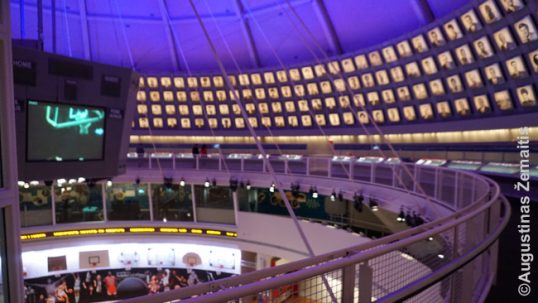

The interior of Naismith Basketball Hall of Fame with the faces of all the inductees
Literature: Images of America: South Norwood, 2004, Norwood Historical Society, pg. 20-25
The map
All the Lithuanian locations, described in this article, are marked on this interactive map, made by the "Destination Lithuanian America 2017" expedition (click the link):
Interactive map of Massachussetts Lithuanian sites
Boston, Massachusetts
Boston was one of the first American great cities and the heartland of US independence war.
While some Lithuanians, deeply pro-freedom, also joined the fight for the US cause in Boston, the extensive Boston Lithuanian community and its heritage dates to the late 19th century when the city was 5th largest in the USA. Its numbers mushroomed in some 1904. There were so many Lithuanians that a demonstration at Boston Commons urging the USA to recognize newly independent Lithuania attracted 5 000 in the year 1919. Lithuanians then have established three churches and a massive club. Much of the Lithuanian community was concentrated in South Boston, where the Lithuanian settlement area was about 1 mile in diameter, requiring a 30 minutes walk from one side to another.
After the Soviet occupation of Lithuania halted free Lithuanian cultural life in Lithuania, Boston became important for Lithuanians worldwide as Boston was the site where the world‘s first Lithuanian-language encyclopedia was published. Many of its publishers were recent refugees who escaped Lithuania in 1944. With Boston remaining an important and rich city, the community was once again replenished by Lithuanian post-independence economic migrants, helping retain the Lithuanian institutions.
Lithuanian club in South Boston
In South Boston, traditionally the heartland of Lithuanian community, there is a massive four-floored Boston Lithuanian Citizen's Club (368 West Broadway). It has been acquired in 1949 from a bank, and much of the building interior remains authentic (stair balustrades, etc.).



Boston Lithuanian club. US and Lithuanian flags wave at the entrance
In its basement is the only Lithuanian restaurant/bar in New England („Lithuanian Kitchen“), open in weekends only (you need to ring a bell, but everyone is welcome). The walls have memorabilia of Boston Lithuanian sportsmen.
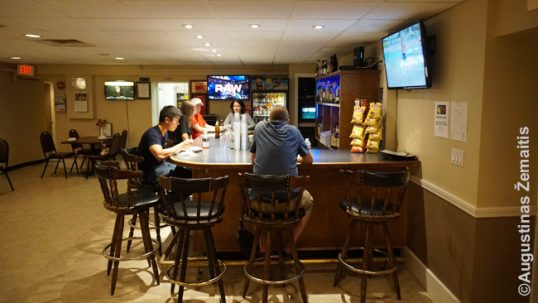

Inside the Boston Lithuanian restaurant
The upper floors house a Lithuanian credit union (that offers credits, credit cards and more to people of Lithuanian heritage) and a auditorium where Lithuanian band gigs take place. Additional hall is located on the 4th floor, opened in 2020. Some of the premises are rented out, helping to pay for the club‘s existence.


Inside the Lithuanian Credit Union
In general, the club and the Lithuanian institutions there are increasingly run by new (post-1990) immigrants to the USA who in Boston seem to get well with the previous generations. Every institution, however, has many Lithuanian details in its interior (images, artworks), some of which date to much older times (e.g. a 1968 plaque listing Lithuanians who donated for elevator renovation at the ground floor).
Where the World's first Lithuanian encyclopedia was published
South Boston also once housed the Publishing house of the Lithuanian Encyclopedia, still commonly referred to in Lithuanian as the „Boston encyclopedia“. Nothing Lithuanian remains in any of the multiple places of publication, however. The most impressive and historically important among those is a building right across the street from the Lithuanian club where the first five volumes had been published in 1953-1955. Owned by a Lithuanian businesswoman Ivaškienė, this building continued to be a hub for Lithuanian activities afterwards as well.


The building where the first volumes of Boston's Lithuanian encyclopedia was published
The encyclopedia has been published in 1953-1966. This 37 volume work is still the largest encyclopedia ever published in the Lithuanian language. At the time Lithuania had been occupied by the Soviet Union, there was no state funding for the work and many sources were very hard to access, making the job undertaken by some 200 Lithuanian-American authors even more tremendous. The authors wished that their encyclopedia would be used in Lithuania even after its liberation. Indeed, that's what happenend: only in 2015, 25 years after independence, did free Lithuania completed publishing its new encyclopedia.
In 1970-1978 the same Boston authors translated the Lithuania-related articles to create 6 volume English "Encyclopedia Lituanica", still the most comprehensive English work on Lithuania.
South Boston Lithuanian church
The last remaining open Lithuanian church in Boston is also located in South Boston, 75 Flaherty Way. Built in 1901, it is dedicated to St. Peter. The parish was established in 1896 through a hard struggle as the Irish community then dominated South Boston and Irish bishop Williams opposed the move.
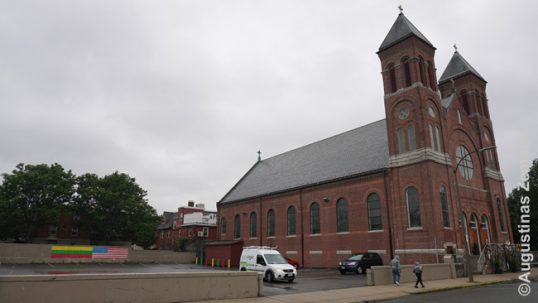

Boston St. Peter Lithuanian church
In 2008, the parish had 1000 member families, 100 of them newly immigrated and 900 descendants of earlier immigration "waves". Lithuanian and English mass are both celebrated.
The church interior is authentic. It has many Lithuanian details, including the stained-glass windows with Lithuanian donators marked on them. Over the time, the Lithuanity of the interior increased as the community sought to mark its roots: for example, Lithuanian names of the saints were inscribed under the frescos of these saints in addition to the English names. The candles that may be lit for donations are painted in the colors of the Lithuanian flag. At the entrance hall, three new Lithuanian stained-glass windows were installed with Lithuanian slogans about Jesus Christ, God the Father and the Holy Spirit, while the paintings of Our Lady of Šiluva (Virgin Mary appearance in Lithuania) and St. Casimir (the only Lithuanian saint) were hanged.


The interior of the Boston Lithuanian church
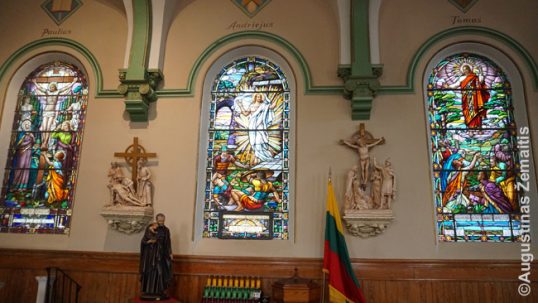

Lithuanian details inside the Boston Lithuanian church (flag, the candle-flag, the sun-crosses, etc.)
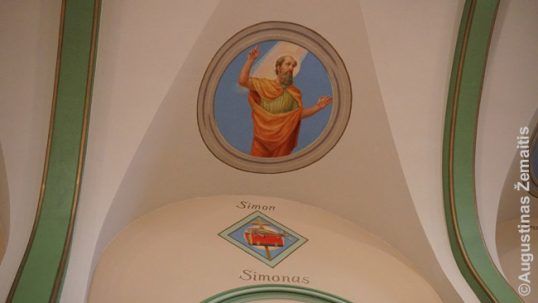

One of the vault saints with both his Lithuanian and English names
Like many historic Lithuanian-American churches, Boston‘s St. Peter‘s „Lithuanian cathedral“ is two floored, with the first floor dedicated to secular affairs and also holding many Lithuanian memorabilia.
The church is locked outside of the mass, but even outside there are many Lithuanian details, such as the Lithuanian-flag colored wall at the parking lot, as well as the improvised Hill of Crosses - a collection of crosses under the church entrance aimed to remind the world-famous Hill of Crosses in Šiauliai, Lithuania. While the original Lithuania's Hill of Crosses received its millions of crosses from people who clandestinely protested against the Russian and Soviet occupations and anti-Catholic regimes, the Boston‘s „Hill of Crosses“ was created as a protest against the planned closure of the Lithuanian church in 2004. The closure ultimately did not happen, likely thanks to massive and public Lithuanian protests. Many of the crosses, ranging in size from very small to ~2-meter height, have traditional Lithuanian designs (sun-cross).
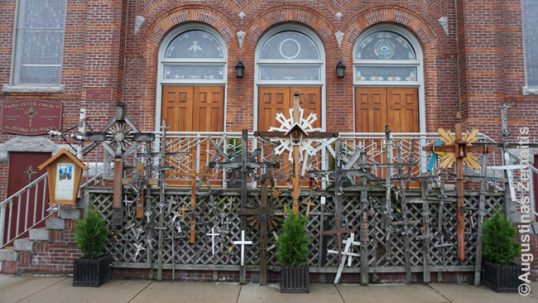

The Hill of Crosses at the Boston St. Peter Lithuanian church entrance
In 2022, a plaque "St. Peter Church, Built by Lithuanian immigrants 1904" was added to the building's facade, making the church's roots even more prominent.
While back in 1900s, the 3000-strong church stood in the middle of Lithuanian-inhabited neighborhood, that all changed in 1941, when this neighborhood was demolished and replaced by housing projects which still surround the church. Not only were the Lithuanian people relocated away from their church, but the district became very dangerous and the church suffered from crime. Back then, Lithuanians floated ideas to close the church down, joining to the other Lithuanian church at East South Boston instead. Ultimately, however, the church survived, and limited gentrification has taken place since. A Lithuanian school that used to stand beside the church was demolished, however, to make way for a parking lot for parishioners who by now lived further away and had to use cars to the Mass.
Lithuanian street names in South Boston
South Boston has numerous streets and intersections named after Lithuanians.
Next to the St. Peter's church is St. Casimir street. Named after the most famous Lithuanian saint, this name was suggested by priest Žukas of the Lithuanian church when the later district was undergoing redevelopment. At that time, in 2003, the municipality has decided to replace two-floored buildings with three-floored buildings. The St. Peter Lithuanian parish objected this, as these buildings diminished the visibility and dominance of the church. As a compromise, the municipality suggested renaming a nearby C street after the church. Using St. Peter name was impossible, however, as South Boston already had Peter street. As such, St. Casimir name was selected, which is related both to Catholic faith and Lithuanian history.
Several surrounding intersections are named after Lithuanian veterans of the US army, including Stanley C. Mosiulis Square, Joseph P. Shliazhas Square, and, most famously, Stephen Darius Square, named after Steponas Darius, who became famous after becoming (together with Stasys Girėnas) the first Lithuanian pilots to cross the Atlantic ocean (before tragically crashing over Poland). Each of these squares is marked by a plaque. Stephen Darius also had a Lithuanian American Legion post named after him which sponsored the square name.


Stephen Darius square
The lost Lithuanian buildings of South Boston
What impressive Lithuanian heritage still survives is but a shadow of the extent of Lithuanian sites that South Boston once boasted. Lithuanian institutions have acquired numerous buildings over the time, however, as they did not construct them themselves, these buildings lacked Lithuanian architecture. All these buildings eventually closed and nothing reminds of Lithuanian history there.
*Lithuanian National Society House (full name National Lithuanian Society of America Boston Chapter House) that was opened in an acquired building in 1951. The acquisition was funded by a Lithuanian-American businessman Jonas Kasmauskas who had immigrated in 1901 but most of the participants were recent Soviet Genocide refugees who had fled Lithuania in 1944. It boasted elaborate patriotic interior with busts and statues of many Lithuanian heroes (Grand Duke Vytautas, president Smetona), as well as national symbols and slogans. This interior was created by a refugee artist Viktoras Andriušis, originally a scenographer of Lithuania's main theater, and built by Lithuanian volunteers who had to start by cleaning up the burned out building interior. However, as the "refugee generation" began passing away, the National Society House closed in 1986 and the interior was destroyed or relocated to museums. Currently, the building serves as apartments.


The former Lithuanian National Society House
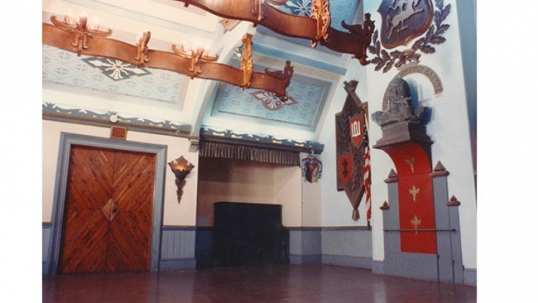

Lithuanian National Society House interior (now destroyed), picture by Romas Šležas
*Lithuanian Alliance of America building, a local branch of a New-York-hubbed Lithuanian-American institution.
*Lithuanian chapel in east South Boston that served as Boston's first Lithuanian church. It was replaced by a new chapel after a fire in 1897. Priest Gricius who founded this church proved to be a divisive personality, however, which became a reason to establish St. Peter church in the 1900s. Ultimately, St. Peter became the primary Lithuanian church and since 1921, this "old church" served as a chapel of St. Peter Lithuanian parish as the Lithuanian district was too large to be served by a single church in a pre-automobile era. The chapel has been sold in 1992 and demolished since. The income from the chapel sale helped fund the refurbishment of St. Peter Lithuanian church.
*Two Lithuanian schools in addition the St. Peter's parish school.
Cambridge Lithuanian sites
Previously, other Boston conurbation areas had their Lithuanian churches as well. Immaculate Conception church of Cambridge (432 Windsor Street) has been built in 1913. Despite still being a major Lithuanian hub, the church was closed in 2004 and transformed into "affordable housing" by the "Just a Start Corporation". This corporation acquired the building in 2007. A municipal commission formed in 2009 deemed it to be of great significance as an example of Mission Style / Arts and Crafts (created by famous Maginnis and Walsh company) and for its possible inspirations in the Gothic architecture of Lithuania. It asked not to alter facades and not to remove religious references where possible (crosses were however removed and frescoes whitened); for complying the building got a Cambridge Historical Commission's „Preservation award 2013“. The owners were, however, given a free hand in the interior which was entirely changed.
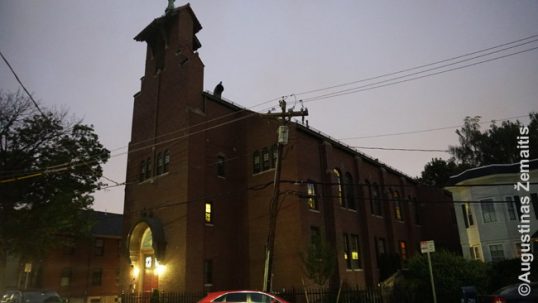

The Immaculate Conception Lithuanian church in Cambridge
The main surviving Lithuanian artwork is the rather impressive Virgin Mary relief over the entrance, that includes prie-modern Lithuanian words „Lietuviu Rymo Kataliku Bažnyčia Nekalto Panos Marijos prasidejimo“ („Lithuanian Roman Catholic Church of Immaculate Conception). The church‘s Lithuanian roots (and its first Lithuanian pastor Krasnickas) are also mentioned in its cornerstone.


Lithuanian hos-relief on the Cambridge church of Immaculate Conception
The small square in front of the Immaculate Conception church is named after a Lithuanian-American Peter D. Sarapas who died fighting for the USA in the World War 2. This renaming was a part of a WW2-era campaign by various parishes that sought to have places near them renamed after the war heroes who were parish members.
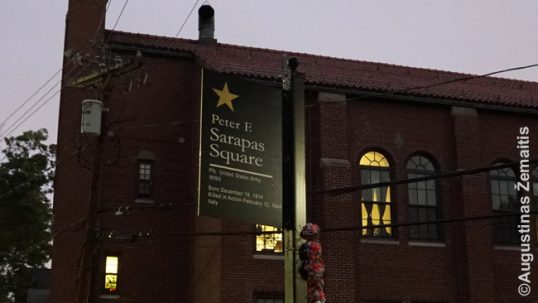

Peter Sarapas Square sign in Cambridge
While the church was not designed by Lithuanians, the nearby rectory was. Built by architects Eugenijus Manomaitis in 1972, it incorporates Lithuanian elements on its roof.
Jewish-Lithuanian (Litvak) heritage in Boston
Lithuania's Jews also moved to Boston before World War 1 forming the community of "Anshei Vilner" (Yiddish for "People of Vilnius"). Their modest synagogue (Vilna Shul, erected 1919) was built near the Boston Commons. It was abandoned in 1985 after the Jews left the district but unlike many other similar buildings, it was saved from demolition. It has since been repurposed as a cultural center, offering various events including ~once-a-month history tours. The plaque mentions that it was founded by "Eastern Europeans".
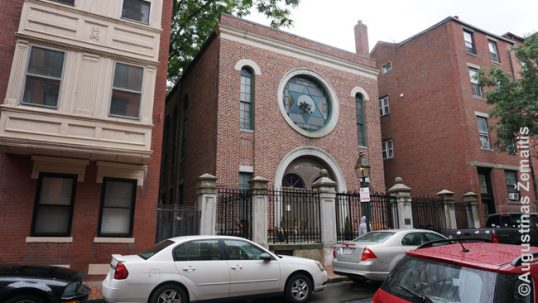

Vilna Shul synagogue in Boston
Another Jewish-Lithuanian site is Meretz Cemetery in Woburn at the northern side of Boston. "Meretz" is a Yiddish name for Merkinė, a town of ~1700 people before World War 2. Incredibly, so many Jews migrated from this town to the Boston area alone that they established this rather large cemetery to bury their dead. On the gate, the dates 1893-1914 are listed.


Meretz Cemetery gate
While elsewhere in the USA Lithuanian-Jewish communities typically quickly integrated into the wider Jewish-American communities (no longer building anything related to their historic homeland of Lithuania), in the Meretz Cemetery, the descendants of Merkinė Jews built a unique memorial for their Merkinė brethren who perished in the Holocaust. Formed like a column, this is the only such memorial in the USA that commemorates Holocaust victims from a Lithuanian town in particular. If you know other such monuments, please write in the comments.
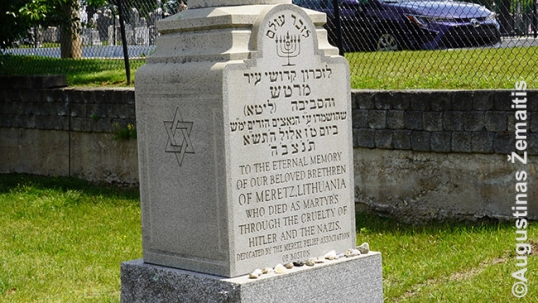

The lower part of the Merkinė (Meretz) Holocaust memorial
Putting these heritage sites together, Boston area arguably has more Jewish-Lithuanain heritage sites than any other city in America.
Lithuanian sites in Boston suburbs
In the suburb of Norwood, the local Lithuanian church was closed during the Massachusetts ethnic-church-closing-spree of 2004. It has been converted into apartments Nothing Lithuanian remains there.
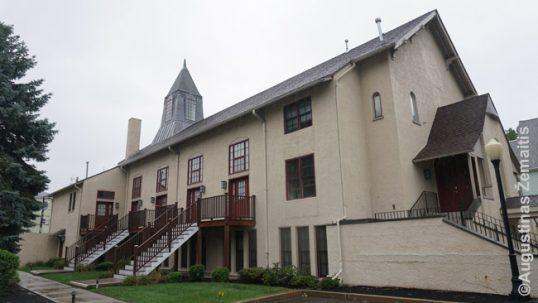

Norwood Lithuanian church
A building next to the church served as the Lithuanian club has no remaining Lithuanian signs either. It had been closed even earlier, in 1978, after the floor partly collapsed in 1970s.
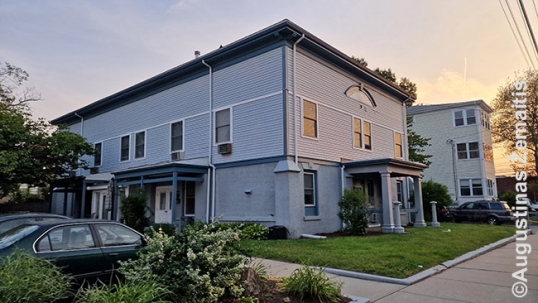

The former Lithuanian club of Norwood
The Monument for Lithuanians who died in World War 2 still survives, however. Originally built back in 1949 in front of the church, it has been relocated to the Highland Cemetery after the church's closure. It includes St. George (the patron saint of the former church and Lithuania). The dedication is to the 152 Lithuanian-American veterans of the St. George Lithuanian church. 8 Lithuanians who were KIA are listed by their names, while the back side includes inscription "In faithful tribute to the Lithuanian veterans of Norwood".
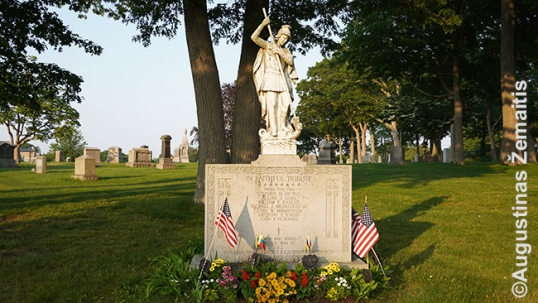

Lithuanian WW2 veterans memorial in Norwood
In the suburb of Danvers there is a Polish Russian Lithuanian American citizens club (PRLACC) that sports all three flags (in addition to the American one) in front of its building. Its slogan "In Unity there is strenght" is inscribed on a nearby plaque. The tri-national club was formed in 1939 when the 1937-established local Polish club started accepting Lithuanian and Russian members. It was just on the eve of World War 2 which divided these nations further in Europe. The building was acquired in 1941 and has 2000 members with some 400 of Lithuanian, Polish, or Russian roots.
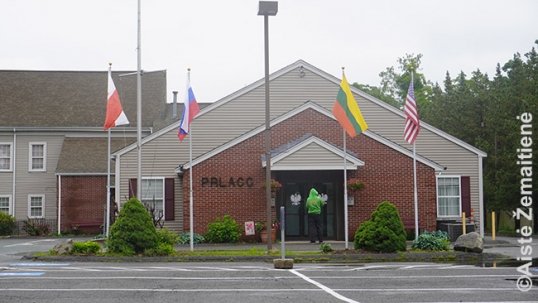

Russian, Polish and Lithuanian club of Danvers
Brokcton may be considered a suburb of Boston, however, due to a huge Lithuanian history there we have covered Brockton Lithuanian heritage sites in a separate article.
Map of Boston Lithuanian sites
All the Lithuanian locations, described in this article, are marked on this interactive map, made by the "Destination - America" expedition (click the link):
Worcester, Massachusetts
Worcester, 64 km westwards from Boston has a population of 180 000, ~2% Lithuanian (~4000). This is the 5th largest number of Lithuanians among all US cities (after Chicago, New York, Los Angeles and Philadelphia).
St. Casimir Lithuanian area
For decades, the massive St. Casimir Lithuanian church (41 Providence Street) was the real hub of Worcester Lithuanian life. It took Lithuanians 13 years to build (1903-1916). It offered regular services from 1916 to 2009, whet it was controversially closed by the diocese. Final mass was held in 2010 for Lithuanian independence day and the building was sold in 2011 to charismatic Christians for 650 000 USD. Altair and other sacred items were removed beforehand, but the St. Casimir‘s bust on the facade remains with the Lithuanian words „St. Casimir, pray for us“. The grand stained glass windows with Lithuanian inscriptions were also fully retained.


St. Casimir church. Its massive size and a hilltop location shows the size of Lithuanian community Worcester once had.


The St. Casimir bust on the St. Casimir church.
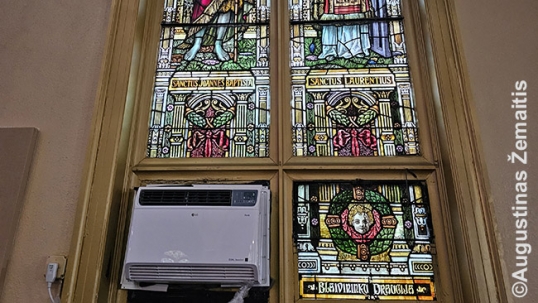

St. Casimir church stained-glass window
Interestingly, one of the priests of St. Casimir drowned with Titanic while arriving in the USA. He is said to have acted especially heroically there, giving up his lifeboat seat and helping the dying passengers.
Not far away from the St. Casimir church stands the former St. Casimir Lithuanian school which has a bas-relief of Lithuanian coat of arms and a Lithuanian inscription with its name on its facade, making it one of the most Lithuanian-styled school buildings in America. The school was built in 1924, replacing the wooden "temporary St. Casimir church" that had been used by the parish in 1895-1916. The school had 505 students in 1927, taught by the Lithuanian Sisters of St. Casimir of Chicago. The numbers declined to 199 in the mid-1940s but then increased back to 350 as the Soviet Genocide refugees arrived. As the USA moved to public schooling, the parish school declined and was closed in 1986. The building is now used as a school for children who are unable to learn at regular schools.


Worcester Lithuanian school.
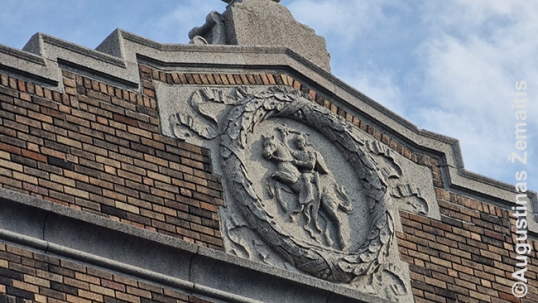

Vytis bas-relief on the school
Lithuanian-named squares of Worcester
Worcester likely has more locations named after Lithuanians than any other US city! That is mostly due to a local tradition to name intersections after World War 2 veterans who gave their life for the USA. With so many Lithuanians living in the area, many of those veterans were Lithuanians. Also, a Lithuanian veteran club worked hard to sponsor these intersection name, most of them located in what was once the Lithuanian district around the St. Casimir church.
There are three Lithuanian-named squares on the Providence St south of St. Casimir: Miglauckas, Kirminas, and Maleskas.
Further on within the once-heavily-Lithuanian-populated area, there are more: Jurgelionis, Kamandulis, Kigas, Banis, Laukaitis, Skerniškis. Krasinskas Square is located in the western outskirts of the city. Every one of them is marked on this map).


Maleskas Sq. sign.


Kirminas Sq. sign.
Our Lady of Vilna Lithuanian area
Worcester was large enough to have a second Lithuanian church, gothic revival Our Lady of Vilna (153 Sterling Street, built ~1925). Today it serves the Vietnamese community indicating that the modern migration to America is mostly non-European, unlike that of the 1900s. Vietnamese-Americans have one thing in common with Lithuanian-Americans however: many of them immigrated after their country has been overrun by a communist invasion.



Our Lady of Vilna church in Worcester. It is the last so-named church in the USA.
Despite the ethnic change, the impressive interior of the church remains staunchly Lithuanian. There are more Lithuanian inscriptions here than in nearly every other Lithuanian-American church (even the saints behind the altar have their Lithuanian names written near their images). Some Lithuanians still pray at the church, although its institutions (school, parish hall) are now mostly used by Vietnamese. Lithuanian visitors are welcome.


Our Lady of Vilna church interior.
Gediminas street still exists in church vicinity (named after Grand Duke Gediminas of Lithuania, 1275-1341, traditionally held to be the founder of Vilnius). In fact, the entire hill the church proudly stands on used to be referred to as Gediminas hill (which is a locality in Vilnius). After all, the church was built in the times of Lithuanian-Polish conflict over Vilnius (1920s-1930s), this likely influencing the prevalence of the Lithuanian language and Vilnius-related symbolism.


Gediminas street sign.
Another testament to that was the memorial for 7 local Lithuanians who died in WW2 in front of the church. Those people died for the USA rather than Lithuania, yet the memorial also had Lithuanian inscriptions and the names of the veterans were written in Lithuanian, with Lithuanian characters and without the changes imposed by the US immigration authorities. However, the memorial was removed ~2022.


Memorial for Lithuanians die din WW2.
Not far away from the Our Lady of Vilnius church is the building of Lithuanian Naturalisation Club, which is adorned by bas-reliefs of both American and Lithuanian coats of arms. Worcester Lithuanians built everything in a way that even after losing their buildings the decor still reminds of the history. While the club itself had been established in 1908, it acquired the current building in 1964 and sold it in 1993.


The former Lithuananian club in Worcester.
Maironis Lithuanian Hall in Shrewsbury
The last remaining operating Lithuanian club of Worcester is Maironis Lithuanian Hall (52 South Quinsigamond Avenue) in Shrewsbury suburb. It is named after the famous Lithuanian patriotic poet of 19th-century national revival. This building rented out for celebrations but it also hosts some 6-8 annual Lithuanian events.
The building has a rather plain exterior as the historic club which stood here burned down in 1973. The interior of its 1974 replacement, is, however, rather grand, as it includes Lithuanian paintings on its walls at the basement floor. These were painted by a Lithuanian-American Rūkštelė who lived within the premises while he worked. The first floor hall, on the other hand, is mostly used for rentals and is thus devoid of Lithuanian symbolism. This Hall used to be known as "Maironis Park" but had its name changed ~2022 to avoid misconception that it is a park rather than a building. Nevertheless, Maironis does indeed include extensive grounds for car parking, as well as a lakeshore, making Maironis convenient for outdoor Lithuanian celebrations such as the midsummer Joninės. This land together with a residential home was acquired by Lithuanians in 1923 and Maironis Park was opened in 1924. That original building was expanded multiple times by adding new halls in 1962 and 1968 and was undergoing yet another expansion at the 1973 moment it burned down.


Lithuanian scenes at one of Rūkštelė paintings (depicting, left-to-right, the Vilnius Cathedral, Kaunas city, and the grave of unknown soldier in Kaunas)
Next to Maironis stands a Memorial for those who died for free Lithuania adorned in patriotic symbols (Columns of Gediminas, Vytis (the coat of arms), two Crosses of Vytis). Built in 1978, this memorial initially stood at the St. Casimir church. However, it was relocated after the church was sold in fear that the new owners would have destroyed it otherwise.


Memorial for those who died for Lithuanian freedom at Maironis park.
Historically, the eastern shore of Lake Quinsigamond hosted numerous additional Lithuanian clubs, often named "Parks". This included a Lithuanian Veteran club, Lithuanian leftist club (Olympia Park), Vytautas Park, and more. All of these clubs closed since, however, and the Lithuanian activities slowly retreated to Maironis, with the historic other club buildings either demolished or no longer visibly Lithuanian. After the closure of their own buildings, various clubs continued operation in Maironis premises.
In 2010 the Worcester municipality recognized its partly Lithuanian roots by twinning with a town of Ukmergė in Lithuania.
>The map
All the Lithuanian locations, described in this article, are marked on this interactive map, made by the "Destination - America" expedition (click the link):
Merrimack Valley, Massachusetts
Lawrence, Lowell and Haverhill are the towns of the Merrimack Valley, especially famous for its textile mills ~1900. The textile mills attracted many Lithuanians, making the area especially rich in historic Lithuanian sites.
Among the most unique Lithuanian sites in the area are the Lithuanian national cemetery (non-Roman-Catholic) and a district of Lithuanian-named streets. There are numerous Lithuanian monuments, Lithuanian churches (all closed) and Lithuanian cemeteries.
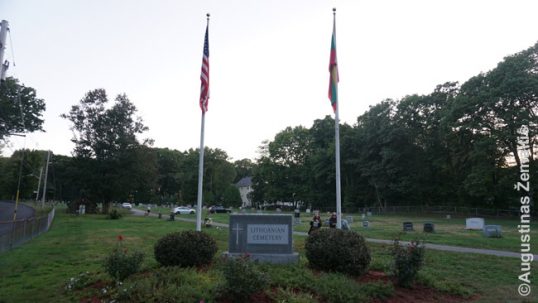

The flags over the Haverhill Lithuanian cemetery, surrounding the memorial to Lithuanian immigrants.
The massive red-brick factories themselves are an impressive sight in many Merrimack valley towns. That's a sight that was unavailable in Lithuania itself of the era: it was precisely the Russian czar‘s decision to leave Lithuania an agricultural hinterland that made the Lithuanians who sought for industrial jobs to migrate away to places such as the Merrimack Valley.


A former textile factory in Lawrence
Lawrence, the Lithuanian heart of Merrimack Valley
At the center of the Merrimack Valley stands its most Lithuanian city Lawrence (pop. 70 000). It is known as the "immigrant city" for the numerous early 20th-century European migrant communities.
Nearly every ethnicity built its own church in Lawrence (giving it an alias of „city of churches“). Lithuanians established two churches (both now closed).
The first one was the Roman Catholic St. Francis (94 Bradford Street), something usual for the Catholic-majority nation. Currently, the building is used as a Christian Bellesini Academy. Nothing outside reminds of its Lithuanian past. One stained-glass window from the church was moved to Central Catholic High School chapel where it is installed together with a plaque describing its Lithuanian history. After the closure of this church, Lithuanian community was joined to Corpus Christi parish in 35 Essex street; there, some Lithuanian activities still takes place and a replica of Our Lady of Vilnius painting hangs proud. That replica is historically important as it used to tour around the camps of Lithuanian refugees who had to flee the Soviet occupation of Lithuania in 1944.
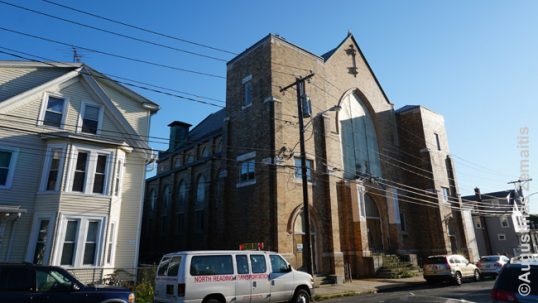

St. Francis Lithuanian church of Lawrence
The second Lithuanian church of Lawrence, constructed in 1855 (Garden Street 150), used to be owned by an independent Lithuanian National Catholic Church of Sacred Heart which had acquired the building in 1917. This is a unique denomination established in the early 20th century by Lithuanians which considered itself Catholic but denounced the authority of Roman Pope (thus they are not Roman Catholics). Lithuanian National Catholics had their cathedral in Scranton, Pennsylvania (still operational) and Lawrence was its only other longer-lasting parish. The former National Catholic church has been sold again in 2001 (to the Haiti Baptists), however, the plaque „Lithuanian National Catholic Church“ still remains near the top of the building‘s front facade (albeit bleached in the sun and barely legible).


Lawrence National Catholic church
Lawrence's Methuen suburb still has a Lithuanian National Catholic Cemetery (est. 1917), the final resting place of the parish. They could have been buried neither in the unsanctified Protestant cemetery ground nor together with the papal followers, that's why they established their own cemetery. Some graves are especially old with pre-modern Lithuanian words, as well as Anglicized or Polonized Lithuanian surnames (such "surname shifts" were common in the early 20th century when the officials would decide upon the orthography of an illiterate immigrant's surname). The National Catholic cemetery has received a nice arch in ~1997 and a memorial to Lithuanians who fought for the USA in 2016 (with both Lithuanian and English inscriptions). ~100 Lithuanian US forces veterans are buried in the cemetery, their graves marked by the small US flags. A free-standing plaque explains the cemetery history, adorned in the Lithuanian flag motif.



Entrance arch of the Lithuanian national cemetery


World War 2 memorial for Lithuanian National Catholics war veterans of Lawrence area
The cemetery is supported and beautified by the money received from selling the church. At the center of the cemetery stands a Lithuanian National Catholic altar at which the National Catholic holy masses used to be held, followed by picnics. The altar consists of Jesus Christ statue; it has no Lithuanian inscriptions. Today, the cemetery also accepts Ukrainian internments and Lithuanians gave them some ground.
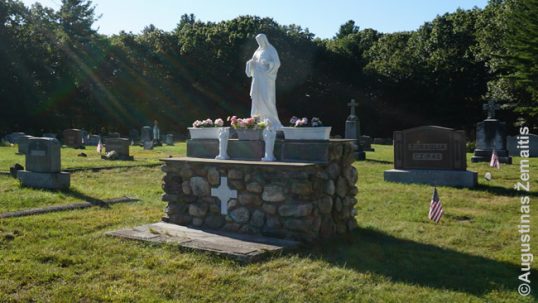

Lithuanian National Catholic altar at the Methuen Lithuanian National Catholic cemetery
Methuen suburb also has a unique area near Forrest lake where the entire district has its streets named in Lithuanian. There are Palanga, Varniai, Kaunas, Luoke streets (all named after Lithuanian cities), as well as Birute street (named after a Duchess of Lithuania) and Vytis street (Vytis being the Lithuanian Coat of Arms). This was the former resort area owned by the St. Francis church, which the Roman Catholic church had swiftly sold for residential construction after disestablishing the parish. Varniai, Palanga, and Birute streets are the largest ones, their names appearing on numerous plaques, postboxes, etc.


Postboxes with Birute and Palanga street names
Lawrence is also famous as the first US city to recognize Lithuanian independence in 1990 04 03. This happened after a lobbying effort by the local Lithuanians and an unanimous vote. A plaque commemorating this has been installed in 2000 inside the pretty Lawrence City Hall in the downtown (first floor; accessible to all visitors during the working hours).


Plaque commemorating the independence recognition in Lawrence city hall
In a park on the other side of the street from the Lawrence City Hall stands the Bread and Roses Strike memorial which commemorates the 1912 strike of Lawrence textile workers that became famous for successfully achieving some of its goals. Among the strikers were Lithuanians; one of their names, Jonas Smolskas, is inscribed on the monument because he was one of three victims of the strike, beaten to death by the strike opponents for wearing a symbol associated with the strikers.


Bread and Roses strike memorial in Lawrence
Both the Lawrence recognition of Lithuanian independence (including the plaque commemorating it) and the memorial for the strikers were inspired or funded by the local Lithuanian historian Jonas Stundžia, famous within the Lithuanian-American community, who has worked much to further the Lithuanian goals in the USA (his name is also engraved on the strikers memorial).


Plaque on the strike memorial with Jonas Smolskas and Jonas Stundžia mentioned
Lowell Lithuanian memorial, church and club
10 km further west from Lawrence along the Merrimack River lies the town of Lowell (pop. 100 000), a kind of Lawrence's twin in terms of its size, number of factories and number of Lithuanians.
In 2012, a commemorative stone to local Lithuanians has been unveiled near the Lowell municipal building. It includes a Lithuanian coat of arms, the Lithuanian word for Lithuania (Lietuva) and the engraving of an ethnic strip. It has joined numerous other such stones erected by other Lowell immigrant communities.
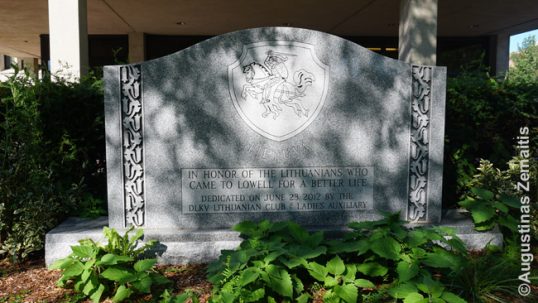

Memorial stone for Lithuanians near Lowell City Hall
Lowell Lithuanians also had their church (dedicated to St. Joseph 151 Rogers Street). Built in 1911, it has been closed in 2003 and transformed into apartments. The cornerstone retains an inscription „St. Joseph‘s Lithuanian R. Cath. Church 1911“.


Lowell Lithuanian church
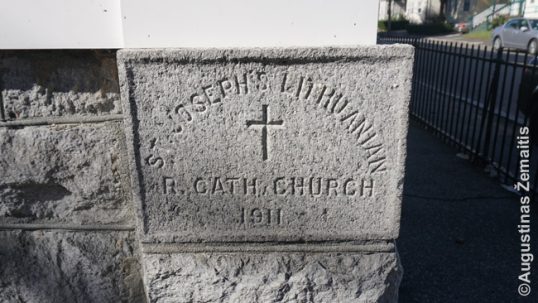

Cornerstone of the Lowell church. Cornerstones like that are often the final reminder of building's original purpose
Until 2017, Lowell had a Grand Duke of Lithuania Vytautas club named after the famous Lithuanian leader under whose rule Lithuania was the largest medieval European state. Opened in 1920, the club moved to its current location at 447 Central Street in 1966 and its entrance used to be adorned by a Lithuanian flag and a pre-modern Lithuanian abbreviation of its name DLKV. The club was established by the leftists as an alternative to the Lithuanian parishes (after all, the parishes themselves were like ethnic clubs to Lithuanians, as they had many secular activities). However, over the time such clubs would start cooperating with parishes, as the Soviet occupation of Lithuania and the Soviet genocide there discredited the Marxist ideas among Lithuanian-Americans. The clubhouse was sold due to high costs (~14000 USD / year) becoming unbearable for a senescent community. The building is now a laundry.
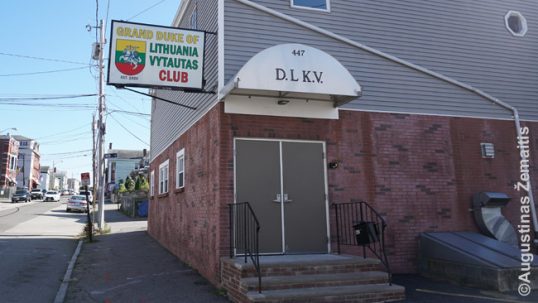

Grand Duke Vytautas Club in Lowell (before the signs were removed)
Haverhill Lithuanian sites
Haverhill east of Lawrence is the smallest of the „Lithuanian“ Merrimack Valley towns.
Its best-surviving Lithuanian site is the Haverhill Lithuanian cemetery (est. 1921).


Old entrance stone to the Haverhill Lithuanian cemetery
A Lithuanian flag perpetually waves above the cemetery together with the US flag. A Memorial for Lithuanian imigrants stands at their feet, erected in 2000 by the Gedymino club („Gedyminas“ being an old spelling of the Lithuanian Grand Duke‘s name today spelled as Gediminas). The cemetery itself is owned by the club and is notable by large land lots next to the graves, due to which there is little land for new burials.


Gedymino club memorial to the Lithuanian immigrants in Haverhill cemetery
Haverhill Lithuanians also had their own Lithuanian church. However, the district where the church stood became a so-called "ghetto" and the church was closed in 1998, then became abandoned and derelict after temporarily serving as a police precinct. It was demolished in 2019. During the "Destination Lithuanian America" mission in 2017 it was still possible to look inside through the broken windows and still see some surviving stained glass windows, but nothing else reminded the church‘s Lithuanian history.


Haverhill Lithuanian church before its demolition


The ravaged interior of the Haverhill Lithuanian church (2017)
The church building was constructed in 1892, however, it was acquired by Lithuanians ~1910.
Other Merrimack valley
A little north Nashua, New Hampshire is also considered a part of the Merrimack valley. That textile town has its own Lithuanian heritage (described at the New Hampshire article).
Map of the Lithuanian sites
All the Lithuanian locations, described in this article, are marked on this interactive map, made by the "Destination - America" expedition:
Baltimore, Maryland
The largest city of Maryland Baltimore is a traditional industrial city and has an old prewar Lithuanian community.
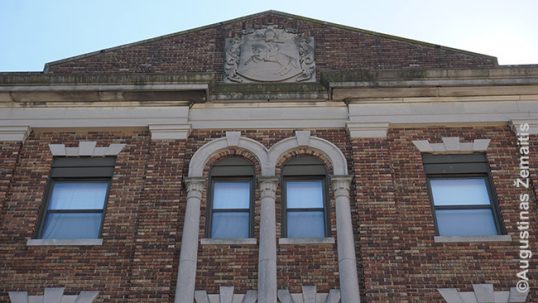

Facade of the Baltimore Lithuanian Hall
Lithuanian churches of Baltimore
Centrally located gothic revival St. Alphonsus Shrine (114 West Saratoga Street) with its three-stage 73 m bell tower is one of the most impressive Lithuanian churches in America (and higher than any church in Vilnius). Built in 1844, it is also the oldest one - predating even most of the US famous stately buildings.
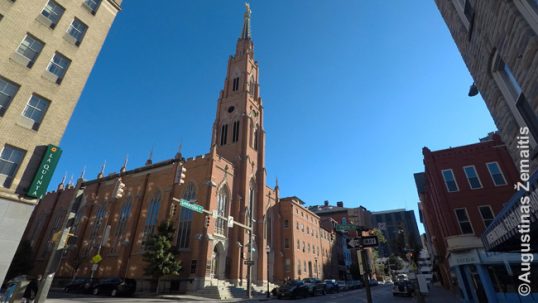

St. Alphonsus Lithuanian church in Baltimore
In the mid-19th century, there were few Lithuanian Americans as serfdom was not yet abolished in the Russian-occupied Lithuania, limiting freedom of migration. So the Shrine has been built by the German community and used to be called "German cathedral" before being sold to burgeoning Lithuanian parish in 1917 when Germans were moving out of the district. The new church expedited Lithuanian settlement and the neighborhood received its "Little Lithuania" nickname.


The interior of St. Alphonsus shrine in Baltimore
In 1973, the St. Alphonsus Church was listed in the National Register of Historic Places. In 1995, it was styled a "Shrine". It is famous far beyond the Lithuanian community as one of the church‘s German-era pastors was St. John Neumann, the first American male saint (his room is recreated at the church). Even during the Lithuanian era, St. Alphonsus shrine has been successful at attracting non-Lithuanians as well, using slogans such as „Baltimore powerhouse of prayer“. English and Latin (Tridentine) mass are celebrated here these days (with Lithuanian mass canceled in 2017). Therefore, it is easy to get in the church nearly every day.
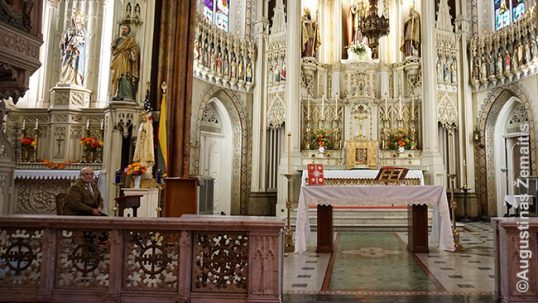

The altar of Baltimore Lithuanian church with the Lithuanian flag on the left
The non-Lithuanian origins of the church, however, means that there are quite a few Lithuanian details in its impressive interior. The church‘s right side-chapel has a „Siberian rosary“ created by Lithuanians who were expelled to Siberia by the Russians in the 1940s out of meager possessions they had left: breadcrumbs and their own hair. There is also one Lithuanian stained-glass window in the sacristy. The World War 2 memorial plaque near the church's entrance has a very long list of Baltimore Lithuanians who served the USA in WW2. At the left of the altar, there is a Lithuanian tricolor and St. Casimir among the statues of the saints.
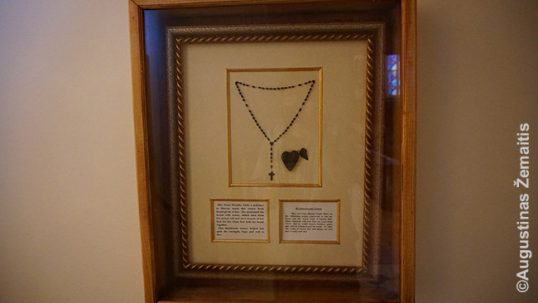

Siberian Rosary at the St. Alphonsus Shrine
Like the other US downtowns, Baltimore has been affected by white flight; most Lithuanians left for suburbs as well. In 1950, Baltimore had a population of 950 000; in 2010, it was 621 000 (63% Blacks, ~2000 Lithuanians), the crime rates are high, so the St. Alphonsus shrine has fewer parishioners although Lithuanians drive from the suburbs. The massive St. Alphonsus school has been closed (the building still stands in front of the church, though nothing Lithuanian remains there). In total, Maryland has 18 000 Lithuanians.
Before they bought the St. Alphonsus shrine Lithuanians had their parish of St. John the Baptist at 308 N. Paca St. (1905-1916). That parish was later Italian and now replaced by St. Judas shrine.
Even earlier, Lithuanians prayed at what is now the Lloyd Street synagogue (1888-1905). They have acquired it from Jews and then sold it back. Currently, a Jewish museum operates there, but its exposition also includes some information about the building‘s Lithuanian history as well as an illegible Lithuanian-era graffiti on a basement column.


Lloyd Street synagogue (former Lithuanian church) in Baltimore
Lithuanian Hall-Museum of Baltimore
After the acquisition of St. Alphonsus shrine, a Lithuanian Hall was opened in the locality for secular events in the year 1921 (until 1968, the building was known solely by its Lithuanian name Lietuvių namai; 851-853 Hollins St.). The Doric design is by Stanislaus Russel and the Lithuanian coat of arms Vytis is proudly hanging above the main entrance and on the top.
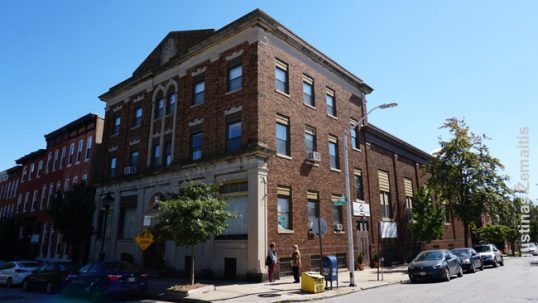

Baltimore Lithuanian Hall
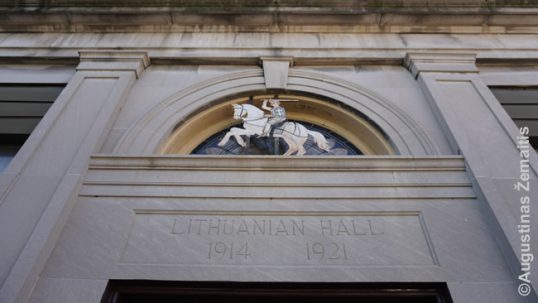

Vytis at the Baltimore Lithuanian Hall (another one is above)
Since 1978, the Hall houses a Lithuanian museum (3rd floor), which is now the most interesting place of the building for visitors. There, one may see a replica of a Lithuanian folk home, learn about the folk traditions and Lithuanian history, as well as about the history and life of Lithuanian-Americans: see the items they used in the protests against Soviet occupation, the straw figures early Lithuanian-Americans created from drinking straws (as the grass straws they used for their folk art back home were not readily available in the US cities) and so on. The museum is open by appointment and it is recommended to go there guided by someone who knows what is exhibited as the written explanations are somewhat limited.


Entrance to the Baltimore Lithuanian museum. The symbol is of Iron Wolf, instrumental in the myth of the foundation of the Lithuania's capital Vilnius
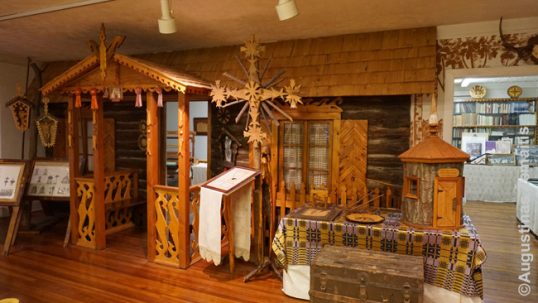

Lithuanian hut at the Baltimore Lithuanian museum
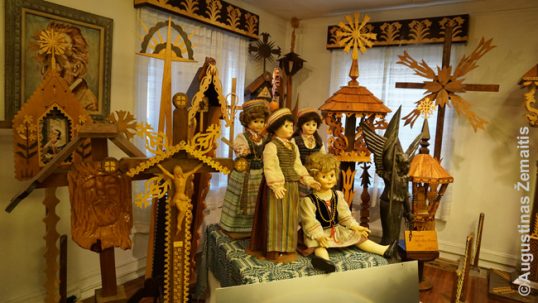

The crosses that used to symbolize the victims of January 13th (1991) massacre when brought at the protests at Washington Capitol


Lithuanian traditional Christmas decorations made of drinking straws in the Lithuanian museum of Baltimore
Additionally, the three-floored building has an art-nouveau-style 1500-seat events hall (2nd floor) decorated in a very Lithuanian way (with the coat of arms of Lithuanian cities, etc.). The basement has an equally Lithuanian-decorated bar and pool room, open on Fridays only.


The main hall of the Baltimore Lithuanian Hall


Side wall of the main hall of the Lithuanian Hall, adorned by Lithuanian ornaments and coats of arms of the Lithuanian cities
Workshops of traditional ethnic arts and crafts (e.g. Easter egg painting) are possible. Lithuanian Hall also houses the Lithuanian National Library. It has been established 1908, merely 4 years after the Lithuanian language was legalized in its Russian-ruled homeland after a 50-year-old ban. This is the oldest ethnic minority library in America. Active entertainment of Baltimore Lithuanians includes an ethnic dance troupe, seniors club, internet radio. Unlike Lithuanian Halls in some other cities which closed down with a decline in attendances, the Baltimore one is successfully attracting non-Lithuanians as well to its hip dancing nights.
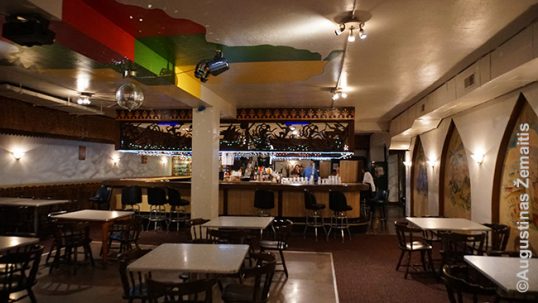

Baltimore Lithuanian Hall basement bar
On the opposite side of the Lithuanian Hall, there is a Little Lithuania Park named so after the alternative name for the entire district. In its center stands an impressive Lithuanian monumental composition of three crosses: two leaning ones on the side and a straight chapel-post in the center (sculptor Algimantas Grintalis, who served as the Lithuanian museum's director). At their feet is a land art stylized Lithuanian coat of arms.
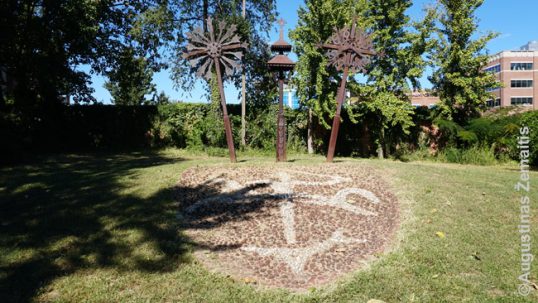

The Lithuanian sculptural composition at the Little Lithuania park
Historically, Lithuanian Halls were typically run by secular Lithuanians who were less active (or not active) in the churches, but for decades there are no such distinctions.
Frank Zappa statue
Baltimore is the birthplace of the famous 20th-century singer Frank Zappa (1940-1993). Interestingly, 2 years after musician's death (1995) his statue was unveiled in downtown Vilnius (capital of Lithuania) by a group of fans. At the time, Lithuania had just restored independence (in 1990) and was eagerly embracing libertarianism, thus such initiative was not opposed by urban planners. The news about the statue became a US media sensation back then and F. Zappa statue became popular among foreign tourists in Vilnius. In 2008, Vilnius municipality decided to gift a copy of the famous statue to Baltimore where it has been erected on the corner of Conkling Street and Eastern Avenue. Among its sponsors were famous Lithuanians such as the singer Vytautas Kernagis, businessman Hubertas Grušnys and more. The sponsors, including the Vilnius city, are listed on the bottom of the monument.
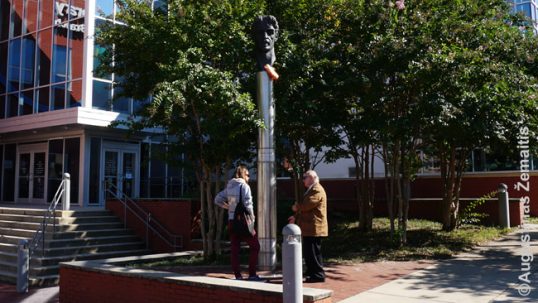

Frank Zappa statue in Baltimore
Johnny Unitas statue
Johnny Unitas (Jonas Jonaitis, 1933-2002) was a Lithuanian-American who is widely considered to have been one the best NFL players ever. A sculpture of him was built near Baltimore stadium, as he represented Baltimore Colts nearly the entire career in 1956-1972.


Johnny Unitas statue in Baltimore
The map
All the Lithuanian locations, described in this article, are marked on this interactive map, made by the "Destination - America" expedition (click the link):
Interactive map of Baltimore Lithuanian sites
Destination America expedition diary
|
In Baltimore, “Destination America” visited the outstanding Lithuanian Hall and Museum, where the museum’s chairman told us incredible stories about the exhibits: a replica of the Kaunas’s freedom statue which Lithuanians used to bring to anti-Soviet protests in Washington, a replica of an entire Lithuanian village hut aimed to teach Americans about Lithuania during the Soviet occupation, and much more. We have also took part in the holy mass at the St. Alphonsus Shrine, which is the oldest Lithuanian church building in the Americas (1845). However, it was constructed by the Germans, although has received Lithuanian detailes since Lithuanians bought it. Compared to places like Pennsylvania, Baltimore may never had that many Lithuanian sites, however, here, what has existed still survives in full glory. By the way, we were led in Baltimore by Aleksandras Radžius, who is a re-enactor of Lithuanian guerilla war of the 1940s-1960s. Augustinas Žemaitis, 2017 10 01. |
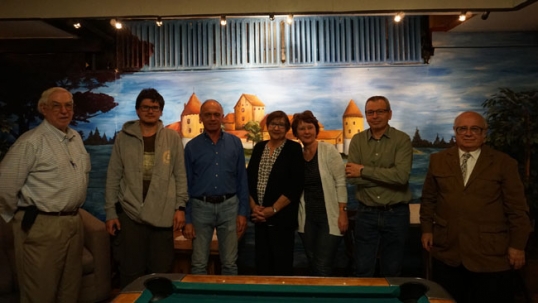

Augustinas Žemaitis of Destination America team with the Baltimore Lithuanians at the basement of Lithuanian hall
Cleveland, Ohio
The 14 000 – strong Cleveland‘s Lithuanian community dates to the 19th century. It has created some of the most impressive Lithuanian heritage sites in America.
Lithuanian Cultural Garden of Cleveland
The most famous Lithuanian site in Cleveland is its Lithuanian garden, created in 1936. The garden is filled with ethnic symbols, nearly every detail there being symbols of Lithuanian pride.


Lithuanian Cultural Garden of Cleveland
The garden has three levels; the upper level consists of a Lithuanian flag and the fountain of duchess Birutė (legendarily a pagan priestess; built 1936) surrounded by busts of 19th century Lithuanian National Revival poets who called for Lithuania to be independent once again and romantically sought inspiration in the last era Lithuanian was truly free (the Grand Duchy era). These poets are priest Maironis (sculpture built 1961) and Vincas Kudirka (built 1938), the author of Lithuanian National Anthem.


Grand Duchess Birutė fountain in Cleveland Lithuanian Gardem


Vincas Kudirka statue in Cleveland Lithuanian garden
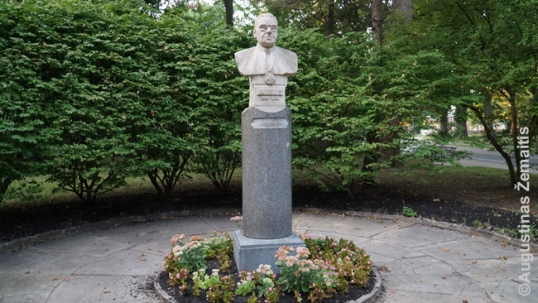

Maironis statue in Cleveland Lithuanian garden
The middle level of the garden includes massive Pillars of Gediminas, a patriotic symbol related to Grand Duke Gediminas, and a bust of Jonas Basanavičius. Known as the "Patriarch of the Nation" this scholar is frequently credited the most for the restoration of Lithuanian statehood in 1918 (bust erected 1936).
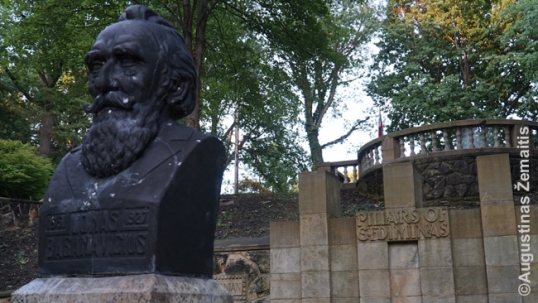

Basanavčius bust at the Lithuanian Cultural Garden, with the columns of Gediminas behind hm
The lower terrace has the garden's name, the second Lithuanian flag as well as the garden's newest addition: a Rūpintojėlis, traditional Lithuanian figure of a worried Jesus built in 1990 after Lithuania has declared independence from the Soviet Union.


Rūpintojėlis at the Lithuanian cultural gardens
The general layout of the park is also meaningful, reminding of a lyre.
Lithuanian cultural garden is one of the older cultural gardens in the city's Rockefeller Park, each of them associated with some particular nation.
The garden has been destroyed during the 1960 race riots but has been renovated by Vincas Apanius and Kęstutis Šukys afterward (they have a bench dedicated to them on the middle terrace now).
Whatever destruction happened, it was very little compared to what took place in Lithuania itself, which was occupied by the Soviet Union 1940-1990. There, nearly all patriotic monuments were demolished, including the ones that inspired the Kaunas statues of the Lithuanian Cultural Garden of Cleveland. As such, this Garden is a unique place to be "transported" back to interwar Lithuania. Interestingly, president of Lithuania Antanas Smetona said a speech here after he was forced to flee by the advancing Soviet armies in 1940.
While it is not particularly marked, some of the garden's trees have been planted by famous Lithuanian-American figures such as Anna Kaskas.
St. George Lithuanian church
The oldest Lithuanian building in Cleveland is the St. George church (1921, 6527 Superior Avenue). Towerless massive edifice has two stories with the main church prayer hall on the upper floor and a former school downstairs. In the basement, the secular parish hall was located where the local Lithuanian community met. The church once stood at the heart of the first Lithuanian district in Cleveland, surrounded by many other Lithuanian institutions and businesses.
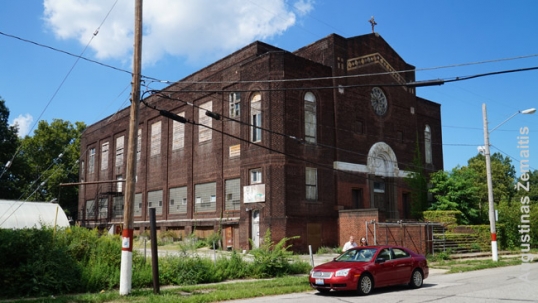

Cleveland St. George Lithuanian church
Unfortunately, there are no more meetings in the building's basement hall, no more pupils in the school's classes and the last Mass in the church itself was celebrated in 2009. Saving money, Cleveland Diocese the closed the church. At that time, it was the oldest Lithuanian parish in the USA (established 1895 when it used a smaller building).
The diocese planned to sell the building and the surrounding lot which also includes a historical 19th-century house for at least 220 000 USD, but it had to reduce the price to merely 11 000 USD. This is the reality of cities like Cleveland where the decayed urban center is unsafe since the 1966 race riots and subsequent white flight. The buildings were acquired by Community Greenhouse Partners which used the area for urban agriculture, a popular endeavor in the declining urban cores. However, apparently, even this use eventually ended, with building standing abandoned, after a brief stint as a location for Hollywood's horror film "Little Evil". While the church once had numerous Lithuanian details and memorials (Lithuanian freedom fighters, Jurgis Matulaitis), none remain inside.


Cleveland St. George Lithuanian church interior
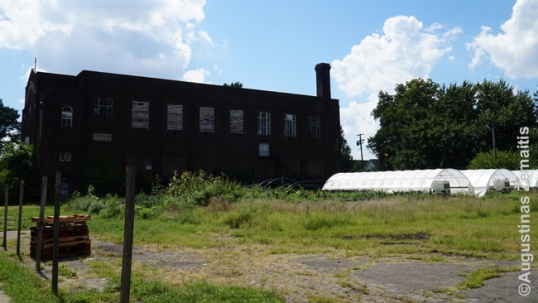

Cleveland St. George Lithuanian church with greenhouses in front
The closure of the Lithuanian church in Cleveland failed to spark protests akin to those in other communities influenced by the church-closure spree. This is because there was another Lithuanian church in Cleveland - in its northeastern part, where most of the Lithuanian life has moved out from the now-Black-majority St. George church area in the 1980s-2000s.
Many of the Lithuanian details of the St. George church have thus been moved to that new church or its warehouses, while one side-altar (without Lithuanian symbols) has been sold to an Anglican church near Seattle (Woodinville).


Image of the final mass in the St. George church. Author Antanas Jucaitis, 2009.
Not far near the St. George Lithuanian church a public artwork has been made to remind of Lithuanians and the area's other ethnic communities. For each ethnicity, there is a flag, covered by people dressed in its folk costumes and playing ethnic musical instruments. In addition to Lithuanians, the Croats, Slovenians, Ethiopians, Sudanese, Nigerians, Chinese, and Puerto Ricans are depicted (the first two ethnic groups hail from the era the district was still dominated by European immigrants and the St. George church was established). The artwork is located on St. Clair street near E. 61th street.


Public artwork reminding of ethnic communities that passed through the district
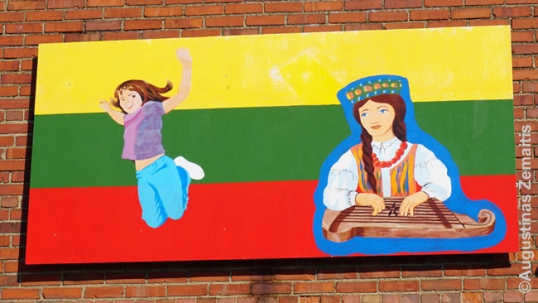

Close-up of the Lithuanian flag within the artwork, showing Lithuanian playing Kanklės
Northeast Cleveland Lithuanian church, school, and monument
Our Lady of Perpetual Help Lithuanian church (18022 Neff Rd) is part of a massive Lithuanian complex, one of the largest in America and created by some of the most famous 20th-century Lithuanian artists.


Our Lady of Pepetual Help Lithuanian church
The church itself may look rather simple and somewhat functionalist at first but, inspecting it closer, one will see many serene Lithuanian ethnic details which enhance but do not obscure the general form-inducted feeling inside that the church is like a ship of faith and Lithuanity sailing through an ocean of trouble.
Among the most prominent Lithuanian details inside are the bas-reliefs of Lithuanian cities and towns that have Virgin Mary-related cults: Žemaičių Kalvarija, Pažaislis, Vilnius, and Šiluva. Because of these bas-reliefs, the church gained a nickname of "The Shrine of Lithuanian Madonnas" (Lietuvos Madonų šventovė).


Our Lady of Perpetual Help church altar with two Madonnas bas-reliefs on the sides
The altar is also a traditional wooden Lithuanian one, featuring two towers crowned by large sun-crosses, a pagan-inspired Lithuanian version of the cross that is repeated many times, for example, on top of every column capital in the interior and on top of the church itself outside.
The Mass is celebrated there in both Lithuanian and English. The church building was constructed in 1950-1952 after the influx of some 4 000 displaced (exiled) persons from Soviet-occupied Lithuania. The architect Stasys Kudokas himself was one of those who left Lithuania due to the Soviet occupation - he would have been targeted by the Soviet regime as he had been a prominent architect of independent Lithuania. The interior was designed by a famous artist Kazys Varnelis, yet another person who left Lithuania due to the occupation. The Virgin Mary bas-reliefs were done by Ramojus Mozoliauskas, of a similar fate, in 1987, when the church interior has been modernized in the wake of Vatican II council. The altar was also installed during the 1987 renovation, created by Eduardas Kersnauskas.
Among the church's stained-glass windows, there is a one dedicated to the "Lith. Displaced persons", while the rose window is dedicated to Kudokas himself.


Dedication of a stained glass window to expelled Lithuanians
The parish itself, established 1928, is older than the Our Lady of Perpetual Help church. Beforehand, it was using a simple house as a church building. The Lithuanian displaced persons, however, continued the (re)building spree long after the church itself has been completed.
A later (1962) addition was the massive Lithuanian school, beautified by a statue of St. Casimir (the most famous Lithuanian saint) on the back facade. In the sculpture, St. Casimir is carrying famous buildings of Vilnius (the Gediminas Castle and the Cathedral). The sculpture was installed in 1984, celebrating 600 years of Christianity in Lithuania. The school operated as a parish school between 1962 and 1988 and as a Lithuanian language school until 2020.
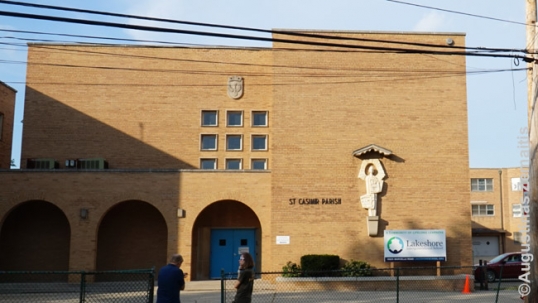

Our Lady of Perpetual Help Lithuanian school (with St. Casimir)
Next, a 1962 Lithuanian convent stands, crowned by Lithuanian cross and ethnic forms. Lithuanian St. Casimir sisters who used to live in the convent were the teachers at the parish school. Both buildings are no longer used for their original purposes, however, and have been rented out with most Lithuanian details inside removed.


Our Lady of Perpetual Help Lithuanian convent
The Lithuanian complex has been completed by the addition of the Memorial of the Centenary of Lithuanians in Cleveland on the front (designed by architect Eduardas Kersnauskas). As Lithuania was occupied by the Soviet Union at the time, the memorial also incorporated details related to the struggle for Lithuania: a Lithuanian partisan's face with a Cross of Vytis and an inscription in three languages: "Give me liberty or give me death" (English), "Dieve, Lietuvą Gink!" (Lithuanian for "God defend Lithuania"), "Redde Quod Debes" (Latin for "Give up what you must"). The composition includes a cross and Rūpintojėlis (the traditional Lithuanian symbol of a worried Jesus) that has been created by sculptor Ramojus Mozoliauskas, as well as three flagpoles, in-use during days of commemoration. Originally built in 1973, the memorial was rebuilt in 1982 and rededicated to those who died of freedom of Lithuania, according to the inscription on its back. Next to the memorial lies a stone for the deceased veterans of St. George post 613 (Lithuanian war veterans from St. George parish), originally created in 1994.


Memorial for the Centenary of Lithuanians in Cleveland


A fragment of the memorial for the Centenary of Lithuanians in Cleveland
After the merger of Our Lady of Perpetual Help Lithuanian parish and St. George Lithuanian parish into a single parish, the new united parish has been named after St. Casimir (not to be confused with the Polish St. Casimir parish of Cleveland).
Lithuanian Community Center in northeast Cleveland
Not far from the new church, a Lithuanian Community Center (877 E 185) houses a Lithuanian restaurant, bar, lounge, and party center. The center is stuffed with Lithuanian memorabilia. It also includes archives and, on the second floor, a hall that is rented out to non-Lithuanians as well and helps pay the bills.
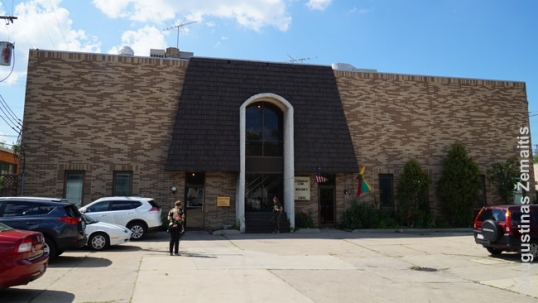

Cleveland Lithuanian club
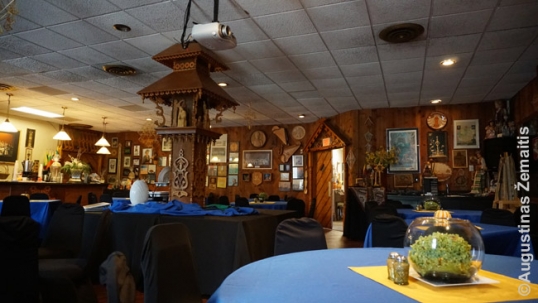

Cleveland Lithuanian club interior with lots of Lithuanian memorabilia
Like Cleveland's new Lithuanian church, the Community Center has been built in 1973 after the refugees moved in and many other Lithuanians resettled east of downtown, where the older Lithuanian club located near St. George's church had burned down.
While the community center looks quite simple from the outside, its exterior includes the stylized Vytis (Lithuanian coat of arms), a version of it that came to symbolize the Lithuanian diaspora.


Sylized Vytis on Cleveland Lithuanian club (the style often used in Lithuanian diaspora)
Antanas Smetona related sites in Cleveland
Cleveland is famous in Lithuania as the final resting place of Antanas Smetona, the first, the longest-reigning (main term 1926-1940) and arguably the most famous president of Lithuania. Because of him, the nearly entire interwar period in Lithuania is often named "Smetonic era". Among the most famous Smetona's policies was the then-unprecedented clampdown on both the Communist and Nazi movements.
The Smetonic era was an era of prosperity followed by the tragedy of World War 2 and Soviet occupation when hundreds of thousands of Lithuanians were murdered, exiled or had to flee Lithuania. Antanas Smetona himself has also fled Lithuania to the USA, where he died in a house fire in Cleveland in 1944. The House where Smetona died still stands. Currently, the district is Black majority.


The house where Antanas Smetona died
Lithuanian Americans had various opinions about Smetona at the time as some disliked him for his authoritarian rule. That is why Smetona was not allowed to live in the Lithuanian embassy in Washington (DC) which is claimed to have had anti-Smetona staff. In Cleveland, however, most of the local Lithuanians were Smetona's supporters. This was one of the reasons why Smetona chose Cleveland as a refuge. Still, the life was not easy there for Smetona: not being allowed to work legally and no longer having a support of now-occupied Lithuania, he had to rely on donations.
That is why the house Smetona lived and died at (actually, he lived in just a part of that house in the attic) is so simple.
The Grave of Antanas Smetona in the All Souls Cemetery (Chardon suburb) is even simpler. Two nearby places of interment in a massive wall inside a mausoleum are dedicated to him and to his wife. They look similar to thousands of graves of American commoners and are not somehow distinctively marked as presidential.


Mausoleum where Antanas Smetona is interred
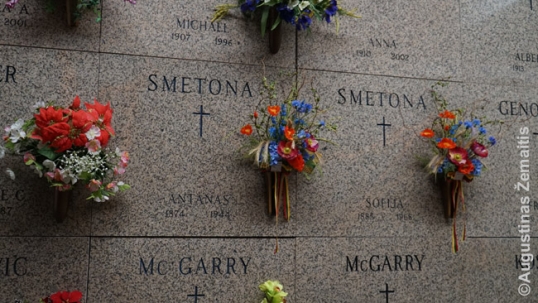

The grave of Antanas Smetona
After Lithuania restored its independence (1990) there were periodic calls to rebury the Smetonas in Lithuania. However, such calls are typically opposed by Cleveland Lithuanians for multiple reasons: the belief that Smetona's grave may be disrespected or vandalized in Lithuania by people with leftist, anti-Lithuanian, or anti-ethnic beliefs; the fact that Smetona's descendants all live in America; as well as a purported saying by Smetona himself that he would not like to ever be buried in Lithuania as even should Lithuania become independent, its culture would be too ravaged by the Soviet rule.
Telshe Yeshiva
Before World War 2, Lithuania also had a significant Jewish population, some of which have also fled the occupations to the USA. While the Jewish and ethnic Lithuanian diasporas had literally no cooperation for decades, interestingly, one of the major Lithuanian-originated Jewish institutions of the USA is also located in the same northeast part of Cleveland as most of the Lithuanian activities are (merely some 3 km away from the Lithuanian Community Center and the church).
That institution is Telshe yeshiva (Jewish religious school, 28400 Euclid Avenue), named after the Lithuanian town of Telšiai. This is a continuation of the original Telšiai yeshiva, opened in 1875 and closed after Lithuania had been occupied by the Soviet Union in 1940 (due to the Soviet atheist policies). As it happened, two of the Telšiai yeshiva's teachers were collecting donations for their yeshiva among the US Jewry at the time. Given the circumstances, they decided not to return to Lithuania but establish Telshe yeshiva in Cleveland instead. It became an important US Haredi institution; in 1960, another Telshe yeshiva was opened in Chicago.


Telshe Yeshiva entrance
Initially, the yeshiva has operated in the downtown but has acquired a farmstead in Euclid (a northeastern suburb of Cleveland) since. At its highest point, the yeshiva had some 700 students but has since declined to 170 due to a competition with many new yeshivas. It still has the buildings built for a much larger congregation of students, however. The most impressive among them is the main hall, with a library on the second floor that has thousands of old books, including some originating in Lithuania.
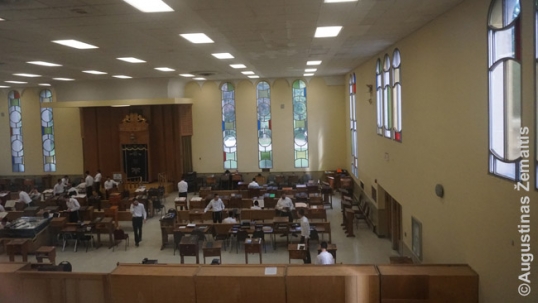

Telshe Yeshiva study hall
Other buildings include a school for children (many of whom stay in the yeshiva afterward), apartments for yeshiva students who have their families, etc. Unlike the Western education, the yeshiva education has no planned graduation: that is, many of the students remain students the whole life, analyzing Torah (Old Testament) by discussing it with fellow other students, initially directed by the more experienced ones. Most of the students never leave the yeshiva area or leave it extremely rarely (e.g. the children leave it for holidays), making yeshiva a small village-within-city.
Access to the Yeshiva may seem to be hit-or-miss for the outsiders. While "Destination Lithuanian America" volunteers were able to access the site and even be shown around by the yeshiva staff and students, some other Lithuanians and Litvaks claimed they were asked to leave. As yeshiva students have explained to us, some of them are more wary of the outsiders than the others as Euclid is not a very safe neighborhood and there have been some threats to Yeshiva as well, so a lot depends on one's own conduct and the first person one would greet.


Telshe Yeshiva students
The yeshiva still has many Litvak-originated students (and the name "Telshe" is prominently written in many places) but no longer has any ties to Lithuania itself nor are there any Lithuanian-born students among those who joined it recently. Most students have been born into Orthodox communities and the Jewish Orthodox lifestyle has all but dissipated in Lithuania itself after the Soviet atheist regime, with the majority of Jews in Lithuania become atheists.
The studies are all conducted in English while the praying is Hebrew; the Yiddish language that used to be the main language of the Litvaks is no longer used.
The map
All the Lithuanian locations, described in this article, are marked on this interactive map, made by the "Destination Lithuanian America" expedition (click the link):

